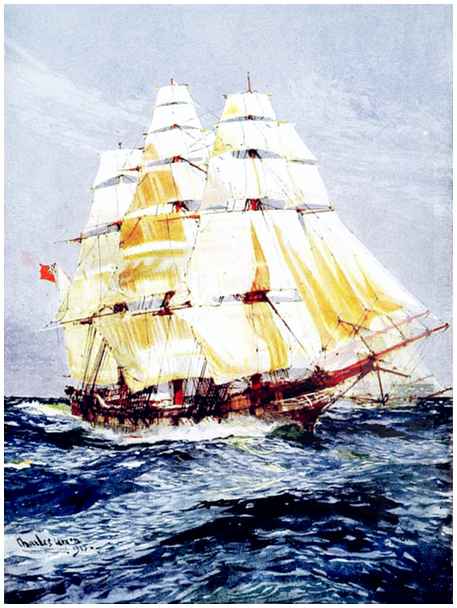
A SHIP OF YESTERDAY
(A Tea-clipper before the Wind)
Transcriber’s Note:
Cover created by Transcriber from pages in the original book. The
result remains in the Public Domain.

A SHIP OF YESTERDAY
(A Tea-clipper before the Wind)
SHIPS & WAYS
OF OTHER DAYS
BY
E. KEBLE CHATTERTON
(Author of “Sailing Ships & Their Story”)
WITH ONE HUNDRED AND
THIRTY ILLUSTRATIONS
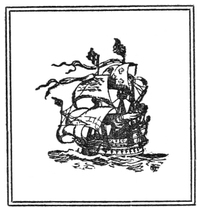
LONDON
SIDGWICK & JACKSON, LTD
3 ADAM STREET, ADELPHI, W.C.
1913
vii
All rights reserved
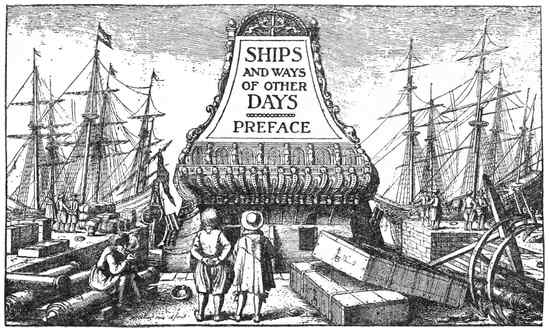
SHIPS AND WAYS OF OTHER DAYS
PREFACE
I desire to acknowledge the courtesy of the Master and Fellows of Magdalene College, Cambridge, for having permitted me to reproduce the three illustrations facing pages 212, 228, and 230. These are from MSS. in the Pepysian Library. The Viking anchor and block tackle are taken from Mr. Gabriel Gustafson’s Norges Oldtid, by permission of Messrs. Alb. Cammermeyer’s, Forlag, Kristiania. The two illustrations on pages 123 and 132 are here reproduced by the kind permission of Commendatore Cesare Agosto Levi from his “Navi Venete.” The Viking rowlock and rivet are taken from Du Chaillu’s “Viking Age,” by the courtesy of Mr. John Murray. To all of the above I would wish to return thanks.
E. Keble Chatterton.
ix
| CHAP. | PAGE | |
| List of Illustrations | xi | |
| I. | Introduction | 1 |
| II. | The Birth of the Nautical Arts | 10 |
| III. | The Development of the Marine Instinct | 18 |
| IV. | Mediterranean Progress | 29 |
| V. | Rome and the Sea | 56 |
| VI. | The Viking Mariners | 85 |
| VII. | Seamanship and Navigation in the Middle Ages | 114 |
| VIII. | The Period of Columbus | 150 |
| IX. | The Early Tudor Period | 169 |
| X. | The Elizabethan Age | 186 |
| XI. | The Seventeenth Century | 221 |
| XII. | The Eighteenth Century | 249 |
| XIII. | The Nineteenth Century | 274 |
| Glossary | 291 | |
| Index | 293 |
xi
| PAGE | |||||||||||||||||||||||
| A Ship of Yesterday (a tea clipper before the wind) To face title-page | |||||||||||||||||||||||
| A Seventeenth-Century Dutch Dockyard Headpiece to Preface | |||||||||||||||||||||||
| Spithead in the Early Nineteenth Century | 2 | ||||||||||||||||||||||
| Old-fashioned Topsail Schooner | 8 | ||||||||||||||||||||||
| “River sailors rather than blue-water seamen” | 13 | ||||||||||||||||||||||
| “Mine be a mattress on the poop” | 34 | ||||||||||||||||||||||
| Cast of a Relief showing Rowers on a Trireme | 38 | ||||||||||||||||||||||
| Vase in the form of a Trireme’s Prow | 42 | ||||||||||||||||||||||
| Portions of Early Mediterranean Anchor | 44 | ||||||||||||||||||||||
| Shield Signalling | 49 | ||||||||||||||||||||||
| Greek Penteconter from an Ancient Vase | 51 | ||||||||||||||||||||||
| The Egyptian Corn-Ship Goddess Isis | 58 | ||||||||||||||||||||||
| The “Korax” or Boarding Bridge in Action | 63 | ||||||||||||||||||||||
| Sketches of Ancient Ships, by Richard Cook, R.A. | 64 | ||||||||||||||||||||||
| Ancient Coins illustrating Types of Rams | 65 | ||||||||||||||||||||||
| Bronze Figurehead of Roman Ship | 66 | ||||||||||||||||||||||
| Sketches of Ancient Ships, by Richard Cook, R.A. | 66 | ||||||||||||||||||||||
| Two Coins depicting Naumachiæ | 68 | ||||||||||||||||||||||
| A Roman Naumachia | 68 | ||||||||||||||||||||||
| Chart to illustrate Cæsar’s crossing the English Channel | 71 | ||||||||||||||||||||||
| Hull of Roman Ship found at Westminster | 78 | ||||||||||||||||||||||
| Details of Roman Ship found at Westminster | 80 | ||||||||||||||||||||||
| Details of Roman Ship found at Westminster | 82xii | ||||||||||||||||||||||
| Primitive Navigation of the Vikings | 89 | ||||||||||||||||||||||
| Details of Viking Ships and Tackle | 99 | ||||||||||||||||||||||
| Vikings boarding an Enemy | 102 | ||||||||||||||||||||||
| Viking Ship with Awning up | 111 | ||||||||||||||||||||||
| Thirteenth-Century Merchant Sailing Ship | 123 | ||||||||||||||||||||||
| Fourteenth-Century Portolano of the Mediterranean | 124 | ||||||||||||||||||||||
| Prince Henry the Navigator | 126 | ||||||||||||||||||||||
| Fifteenth-Century Shipbuilding Yard | 132 | ||||||||||||||||||||||
| A Fifteenth-Century Ship | 134 | ||||||||||||||||||||||
| The Fleet of Richard I setting forth for the Crusades | 139 | ||||||||||||||||||||||
| A Medieval Sea-going Ship | 146 | ||||||||||||||||||||||
| Fifteenth-Century Caravel, after a Delineation by Columbus | 158 | ||||||||||||||||||||||
| “Ordered the crew ... to lay out an anchor astern” | 162 | ||||||||||||||||||||||
| Fifteenth-Century Caravel, after a Delineation by Columbus | 164 | ||||||||||||||||||||||
| Three-masted Caravel | 166 | ||||||||||||||||||||||
| Sixteenth-Century Caravel at Sea | 166 | ||||||||||||||||||||||
| Sixteenth-Century Caravel at Anchor | 170 | ||||||||||||||||||||||
| Sixteenth-Century Astrolabe supposed to have been on board a Ship of the Armada | 172 | ||||||||||||||||||||||
| Astrolabe used by the English Sixteenth-Century Navigators | 173 | ||||||||||||||||||||||
| Sixteenth-Century Navigator using the Cross-staff | 176 | ||||||||||||||||||||||
| Sixteenth-Century Compass Card | 177 | ||||||||||||||||||||||
| An Old Nocturnal | 178 | ||||||||||||||||||||||
| Sixteenth-Century Four-Masted Ship | 186 | ||||||||||||||||||||||
| Elizabethans boarding an Enemy’s Ship | 187 | ||||||||||||||||||||||
| Elizabethan Steering-Gear | 189xiii | ||||||||||||||||||||||
| Sixteenth-Century Ship chasing a Galley | 190 | ||||||||||||||||||||||
| Waist, Quarter-deck, and Poop of the Revenge | 192 | ||||||||||||||||||||||
| Sixteenth-Century Three-masted Ship | 192 | ||||||||||||||||||||||
| Riding Bitts on the Gun Deck of the Revenge | 195 | ||||||||||||||||||||||
| Plan of Early Seventeenth-Century Ship | 197 | ||||||||||||||||||||||
| Sixteenth-Century Warship at Anchor | 198 | ||||||||||||||||||||||
| Drake’s Revenge at Sea | 201 | ||||||||||||||||||||||
| Sixteenth-Century Mariners learning Navigation | 206 | ||||||||||||||||||||||
| Chart of A.D. 1589 | 211 | ||||||||||||||||||||||
| Ship Designer with his Assistant | 212 | ||||||||||||||||||||||
| Chart of the Thames from the First Published Atlas | 214 | ||||||||||||||||||||||
| Diagram illustrating the use of the “Geometricall Square” | 215 | ||||||||||||||||||||||
| Sixteenth-Century Ship before the wind | 216 | ||||||||||||||||||||||
| Early Seventeenth-Century Warship | 218 | ||||||||||||||||||||||
| Early Seventeenth-Century Harbour | 222 | ||||||||||||||||||||||
| Early Seventeenth-Century Dutch East Indiamen | 226 | ||||||||||||||||||||||
| “The Perspective Appearance of a Ship’s Body” | 228 | ||||||||||||||||||||||
| “The Orthographick Simmetrye” of a Seventeenth-Century Ship | 230 | ||||||||||||||||||||||
| Early Seventeenth-Century Dutch West Indiamen | 232 | ||||||||||||||||||||||
| Fitting out a Seventeenth-Century Dutch West Indiaman | 236 | ||||||||||||||||||||||
| Seventeenth-Century Dutch Shipbuilding Yard | 240 | ||||||||||||||||||||||
| Seventeenth-Century First-Rate Ship | 244 | ||||||||||||||||||||||
| Section of a Three-Decker | 246 | ||||||||||||||||||||||
| Nocturnal | 247 | ||||||||||||||||||||||
| Building and launching Ships in the Eighteenth Century | 248xiv | ||||||||||||||||||||||
| Collier Brig | 250 | ||||||||||||||||||||||
| Boxhauling | 252 | ||||||||||||||||||||||
| Eighteenth-Century “Bittacle” | 253 | ||||||||||||||||||||||
| Interiors of Eighteenth-Century Men-of-War | 254 | ||||||||||||||||||||||
| Quarter-deck of an Eighteenth-Century Frigate | 255 | ||||||||||||||||||||||
| Collier Brig discharging Cargo | 256 | ||||||||||||||||||||||
| Eighteenth-Century Man-of-War | 258 | ||||||||||||||||||||||
| Collier Brigs beating up the Swin | 259 | ||||||||||||||||||||||
| Model of H.M.S. Triumph | 260 | ||||||||||||||||||||||
| “Compelled to let the ship lie almost on her beam ends” | 261 | ||||||||||||||||||||||
| An interesting bit of Seamanship | 262 | ||||||||||||||||||||||
| An ingenious Sail-Spread | 264 | ||||||||||||||||||||||
| Eighteenth-Century Three-Decker | 266 | ||||||||||||||||||||||
| Sterns of the Invincible and Glorioso | 268 | ||||||||||||||||||||||
| Model of an English Frigate, 1750 | 270 | ||||||||||||||||||||||
| A 32-gun Frigate ready for Launching | 272 | ||||||||||||||||||||||
| Launching a Man-of-War in the year 1805 | 274 | ||||||||||||||||||||||
| Sheer-Hulk | 276 | ||||||||||||||||||||||
| H.M.S. Prince | 278 | ||||||||||||||||||||||
| An Early Nineteenth-Century Design for a Man-of-War’s Stern | 280 | ||||||||||||||||||||||
| Course, Topsail, and Topgallant Sail of an Early Nineteenth-Century Ship | 281 | ||||||||||||||||||||||
| Stern of H.M.S. Asia | 282 | ||||||||||||||||||||||
| A Brig of War’s 12-pounder Carronade | 283 | ||||||||||||||||||||||
| A West Indiaman in Course of Construction | 284xv | ||||||||||||||||||||||
| A Three-Decker on a Wind | 285 | ||||||||||||||||||||||
| The Brig Wolf | 286 | ||||||||||||||||||||||
| A Frigate under all Sail | 287 | ||||||||||||||||||||||
| Man in the Chains heaving the Lead | 287 | ||||||||||||||||||||||
| H.M.S. Cleopatra endeavouring to save the Crew of the Brig Fisher | 288 | ||||||||||||||||||||||
| H.M.S. Hastings | 289 | ||||||||||||||||||||||
| Model of the Carmarthenshire | 290 | ||||||||||||||||||||||
| PLANS | |||||||||||||||||||||||
| (At End of Volume) | |||||||||||||||||||||||
| |||||||||||||||||||||||
xvi
“The sea language is not soon learned, much less understood, being only proper to him that has served his apprenticeship: besides that, a boisterous sea and stormy weather will make a man not bred on it so sick, that it bereaves him of legs and stomach and courage, so much as to fight with his meat. And in such weather, when he hears the seamen cry starboard, or port, or to bide alooff, or flat a sheet, or haul home a cluling, he thinks he hears a barbarous speech, which he conceives not the meaning of.”
(Sir William Monson’s Naval Tracts.)
1
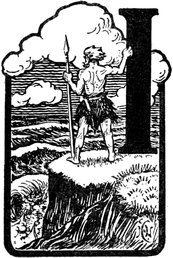
In “Sailing Ships and their Story” I endeavoured to trace the evolution of the ship from the very earliest times of which we possess any historical data at all down to the canvas-setting craft of to-day. In “Fore and Aft” I confined myself exclusively to vessels which are rigged fore-and-aftwise, and attempted to show the causes and modifications of that rig which has served coasters, pilots, fishermen, and yachtsmen for so many generations.
But, now that we have watched so closely the progress of the sailing ship herself, noting the different stages which exist between the first dug-out and the present-day full-rigged ship or the superb racing yacht, we can turn aside to consider chronologically what is perhaps the most fascinating aspect of all. On the assumption that activity is for the most part more interesting as a study than repose, that human activity is the most of all deserving in its ability to attract, and that from our modern standpoint of knowledge and attainment we are able to look with sympathetic eyes on the efforts and even the mistakes of our forefathers on the sea, we shall be afforded in the following pages a study of singular charm.
2 For, if you will, we are to consider not why the dug-out became in time an ocean carrier, but rather how men managed to build, launch, equip, and fit out different craft in all ages. We shall see the vessels on the shipyards rising higher and higher as they approach completion, until the day comes for them to be sent down into the water. We shall see royalty visiting the yards and the anxious look on the shipwright’s face lest the launching should prove a failure, lest all his carefully wrought plans should after months of work prove of naught. We shall see the ships, at last afloat, having their masts stepped and their rigging set-up, their inventory completed, and then finally, we shall watch them for the first time spread sail, bid farewell to the harbour, and set forth on their long voyages to wage war or to discover, to open up trade routes or to fight a Crusade. And then, when once they have cleared from the shelter of the haven we are free to watch not merely the ship, but the ways of ship and men. We are anxious to note carefully how they handled these various craft in the centuries of history; how they steered them, how they furled and set sail, how these ships behaved in a storm, how they fought the ships of other nations and pirates, how they made their landfalls with such surprising accuracy. As, for instance, seeing that the Norsemen had neither compass nor sextant, by what means were they able in their open ships to sail across the Atlantic and make America? In short, we shall apply ourselves to watching the evolution of seamanship, navigation, and naval strategy down the ages of time.
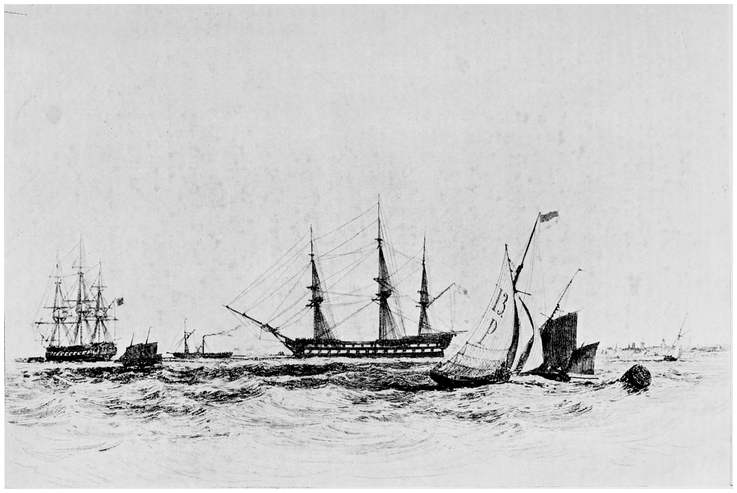
Frigate.
A 74-Gun Ship.
Portsmouth Pilot Cutter
Spithead in the Early Nineteenth Century.
But we shall not stop at that; for we want to obtain an intimate picture of the life lived on board these many ships. We would, so to speak, walk their decks, fraternise with the officers and men, adventure into their cabins, go aloft with them, join their mess, keep sea3 and watch in their company in fine sunny days and the dark stormy nights of winter. We are minded to watch them prepare for battle, and even accompany them into the fight, noting the activities, the perils, and the hardships of the seamen, the clever tactics, the moves and counter-moves, the customs of the sea and of the ship especially. Over boundless, deep-furrowed oceans not sighting land for weeks; or in short coasting voyages hurrying from headland to headland before impending tempest; or pursued by an all-conquering enemy, we shall follow these ships and men in order to be able to live their lives again, to realise something of the fears and hopes, the disappointments, and the glories of the seaman’s career in the past.
I can promise the reader that if he loves ships, if he has a sympathetic interest in that curious composite creature the seaman—who throughout history has been compelled to endure the greatest hardships and deprivations for the benefit of those whose happy fortune it is to live on shore—he will find in the ensuing pages much that will both surprise him and entertain him. I have drawn on every possible source of information in order to present a full and accurate picture, and wherever possible have given the actual account of an eye-witness. How much would we not give to-day to be allowed to go on board the crack ship of the second century, for instance, and see her as she appeared to an onlooker? Well, Lucian has happily left us in dialogue form exactly the information that we want about the “monster vessel of extraordinary dimensions” which had just put in at the Piræus. On a later page the reader will accompany the visitor up the gangway and go round the ship, and be able to listen to the conversation of these eager enthusiasts, just as he would listen attentively to a party of friends who had just been shown over the latest mammoth steamship.4 What the captain said of his ship, his yarns about gales o’ wind, how great were her dimensions, how much water she drew, what was the average return to the owner from the ship’s cargo—it is all here for those who care to read it. A thousand years hence, how interested the world would be to read the first impressions of one who had been allowed to see over the Mauretania, or Olympic, or their successors! In the same way to-day, how amazingly delightful it is still to possess an intimate picture of a second-century Egyptian corn-ship!
We are less concerned with the evolution of design and build of ships in this present book than with the manner of using these craft. How, for example, on those Viking ships which were scarcely decked at all, did the crew manage to eat and sleep? Did the ancients understand the use of the sounding lead? how did they lay their ships up for the winter? what was the division of labour on board?—and a thousand questions of this sort are answered here, for this is just the kind of information that the reader so often asks for, and so rarely gets, frequently being disappointed at the gaps left in historical works. Believing firmly that a knowledge of the working and fighting of the ships in history is worthy of every consideration, I have for years been collecting data which have taken shape in the following narrative. Seamanship, like the biggest sailing craft, cannot have much longer to live if we are able to read the signs of the times. Steamanship rather than seamanship is what is demanded nowadays; so that before long the latter will become quite a lost art. It is therefore time that we should collect and set forth the ways and customs of a fast-dying race. Seamanship is, of course, a changing quality, but at heart it is less different than one might at first imagine. I venture to suggest that if by any wonderful means you could transfer the men5 of a modern crack 19-metre racing cutter to the more clumsy type of Charles II’s Mary, she would be handled very little differently from the manner in which those Caroline seamen were wont to sail her. Similarly, a crew taken from one of the old clippers of about 1870, and transferred—if it were possible—to one of the Elizabethan galleons, would very soon be able to manage her in just the same manner as Drake and his colleagues. It is largely a matter of sea-bias, of instinct, of a sympathy and adaptability for the work. And in such vastly different craft as the Greek and Roman galley, the Spanish carack, the Viking ship of the north, the bean-shaped craft of medieval England, and so on down to the ships of the present day, you find—quite regardless of country or century—men doing the same things under such vastly different conditions.
The way Cæsar worked his tides crossing the English Channel when about to invade Britain in 55 B.C., or the way William the Conqueror a thousand years later wrestled with the same problem but in different ships—these and like matters cannot but appeal to anyone who is gifted with imagination and a keen desire for knowledge. And then—perhaps some will find it the most interesting of all—there comes that wonderful story of the dawn and rise of the navigational science which to-day enables our biggest ships to make passages across the ocean with the regularity of the train, and to make a landfall with an exactness that is nothing short of marvellous considering that the last land was left weeks ago. It is a story that is irresistible in its appeal for our consideration, firstly because of its ultimate value to the progress of nations, and secondly because no finer example could be afforded us of the persistency of human endeavour to overcome very considerable obstacles. It is a little difficult just at first to place6 oneself in the position of those navigators of the early centuries. To-day we are so accustomed to modern navigational methods, we have been wont so long to rely on them for finding our way across the sea, that it requires a great effort of the imagination to conceive of men crossing the Atlantic and other oceans—not to speak of long coasting voyages—without chart or compass, sextant or log-line. There are many names in history which very rightly have won the unstinted applause of humanity irrespective of national boundaries. These names are held in the highest honour for the wonderful inventions and benefits which have been brought about. But there are two among others which, as it seems to me, the world has not yet honoured in an adequate manner. These two—Pytheas and Prince Henry the Navigator—are separated by thirteen or fourteen hundred years, but their inestimable help consisted in making the ocean less a trackless expanse than a limited space whereon the mariner was not permanently lost, but could find his position along its surface even though the land was not sighted for many a day. Think of the indirect results of this new ability. Think of the subsequent effects on the history of the world—the establishment of new trade routes consequent on the discovery of new continents, the impetus to enterprise, the peopling of new lands, the rise of young nations, the growth of sea-power, the spread of Christianity, the accumulation of fortunes and the consequent encouragement given to the arts and sciences. It is indeed a surprising but unhappy fact that humanity, because normally it has its habitation on land, forgets how much it owes to the sea for almost everything that it possesses. Perhaps this statement may be less applicable to the European continent, but it is in every sense true of all the other parts of the world.
7 Among the decisive battles of the world, among the discoveries of new lands, among the vast trade routes, how many of these do not come under the category of maritime? And yet in many an able-bodied, vigorous man, who owes most of his happiness and prosperity to the sea in some way or another, you find a spirit of antagonism to the sea, a positive hatred of ships, an utter indifference to the progress of maritime affairs. Hence, too, consistently following the same principle, the world always treats the seafaring man of all ranks in the worst possible manner. It matters not that the sailorman pursues a life of hardship in all climes and all weathers away from the comforts of the shore and the enjoyment of his own family. He brings the merchant’s goods through storm and stress of weather across dangerous tracts of sea, but he gets the lowest remuneration and the vilest treatment. He goes off whaling or fishing, perhaps never to come home again, performing work that brings out the finest qualities of manhood, pluck, daring, patience, unselfishness, and cool, quick decision at critical moments. Physically, too, he sacrifices much; but what does he get in return? And then think also of the men on the warships. But it is no new grievance.
Throughout history the world has had but scant consideration for the sons of the sea, whether fighters, adventurers, or freight-carriers. You have only to read the complaints of seamen in bygone times to note this. One may indeed wonder sometimes that throughout the world, and in fact throughout history, men have ever been found knowingly to undertake the seafaring life with all its hardships and all its privations. To people whose ideas are shaped only by the possibilities of loss and gain, who are lacking in imaginative endowment, in romance and the joy of adventure, it is certainly incredible that any man should seriously8 choose the sea as his profession in preference to a life of comfort and financial success on shore. Indeed, the gulf between the two temperaments is so great that it were almost useless to hazard an explanation. The plainest and best answer is to assert that there are two classes of humanity, neither more nor less. Of these the one class is born with the sea-sense; the other does not possess that faculty, never has and never could, no matter what the opportunities and training that might be available. Therefore the former, in spite of his lack of experience, is attracted by the sea-life notwithstanding its essential drawbacks; the latter would not be tempted to that avocation even by the possibility of capturing Spanish treasure-ships, or of discovering an unknown island rich with minerals and precious stones.
From a close study of those records which have been handed down to us of maritime incidents and affairs, I am convinced that the seaman-character has always been much the same. It makes but little difference whether its possessor commanded a Viking ship or a Spanish galleon. To-day in any foreign port, granted that both parties have a working knowledge of each other’s language, you will find that there is a closer bond between shipmen of different nationalities than there is between, say, a British seaman and a British landsman. For seamen, so to speak, belong to a nation of their own, which is ruled not by kings or governments, but by the great forces of nature which have to be respected emphatically. Therefore the crews of every ship are fellow-subjects of the same nationality, no matter whether they be composed of a mingled assemblage of Britishers, Dagoes, “Dutchmen,” and niggers.

Old-fashioned Topsail Schooner.
After E. W. Cooke.
So, as we proceed with our study, we shall look at the doings of different ships and sailors with less regard for the land in which they happened to be born9 than for that amazing republic which never dies, which exists regardless of the rise and fall of governments, which for extent is altogether unrivalled by any nationality that has ever been seen. We shall look into the characteristics, the customs, and the manifold activities of this maritime commonwealth, which is so totally different from any of our land institutions and which has always had to face and wrestle with problems of a kind so totally different from those prevailing on shore.
10
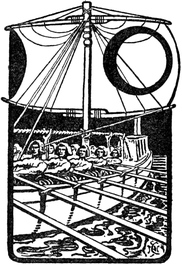
Of all the activities of human nature few are so interesting and so insistent on our sympathy as the eternal combat which goes on between man on the one side and the forces of Nature on the other. Conscious of his own limitations and his own littleness, man has nevertheless throughout the ages striven hard to overcome these forces and to exercise his own freedom. But he has done this not so much by direct opposition as by employing Nature to overcome Nature; and there can be no better instance of this than is found in the art of tacking, whereby the mariner harnesses the wind in order to enable him to go against the wind.
Winds and tides and waves are mightier than all the strength of humanity put together. The statement was as true in pre-Dynastic times as it is to-day. For a long time man was appalled by their superhuman strength and capabilities; he preferred to have nothing to do with them. Those nations which had their habitation inland naturally feared them most. But as familiarity with danger engenders a certain contempt, so those who dwelt by the sea began to lose something of their awe and to venture to wrestle with the great11 trio of wind, wave, and tide. Had they not exercised such courage and independence the history and development of the world would have been entirely different.
It is obvious that the growth of the arts of the sea—by which is meant ship designing and building, seamanship and navigation—can only occur among seafaring people. You cannot expect to find these arts prospering in the centre of a continent, but only along the fringe where land meets sea. And, similarly, where you find very little coast, or a very dangerous coast, or a more convenient land route than the sea, you will not find the people of that country taking to the awe-inspiring sea without absolute necessity. This statement is so obvious in itself, so well borne out by history and so well supported by facts, that it would scarcely seem to need much elucidation. Even to-day, even in an age which has so much to be thankful for in respect of conveniences, we actually hear of landsmen looking forward with positive horror to an hour’s crossing the Channel in a fast and able steamship, with its turbines, its comfortable cabins, and the rest. If it were possible to reach the Continent by land rather than water they would do so and rejoice. So it was in the olden times thousands of years ago; so, no doubt, it will ever be.
Strictly speaking, notwithstanding that the Egyptians did an enormous amount of sailing; notwithstanding that they were great shipbuilders and that their influence is still felt in every full-rigged ship, yet it is an indisputable fact, as Professor Maspero, the distinguished Egyptologist, remarks, that they were not acquainted with the sea even if they did not utterly dislike it. For their country had but little coast, and was for the most part bordered by sand-hills and marshes which made it uninhabitable for those who might otherwise have dwelt by the shore and become seafarers. On the contrary, the Egyptians preferred the land routes to12 the sea. It is true that they had the Mediterranean on their north and the Red Sea on their east, both of which they alluded to as the “very-green.” True, also, it is that there was at least one great sea expedition to the Land of Punt, but this was an exception to their usual mode of life.
At the same time, though they were primarily river sailors rather than blue-water seamen, yet they had used the Nile so thoroughly and so persistently, both for rowing and for sailing, that on the occasions when they took to the sea itself they were bound to come out of the ordeal fairly well, just as a Thames waterman, accustomed all his life to frail craft and smooth waters, would be likely to make a moderately good seaman if his work were suddenly changed from the river to the ocean. From childhood and through generations they had worked their square-sailed craft on the Nile and acquired a thorough knowledge of watermanship, and when the crews of Thebes manned those ships which carried Queen Hatsopsitu’s expedition to Punt and returned in safety back to their homes, they were able to put their lessons learned on the Nile to the best of use on the Red Sea.
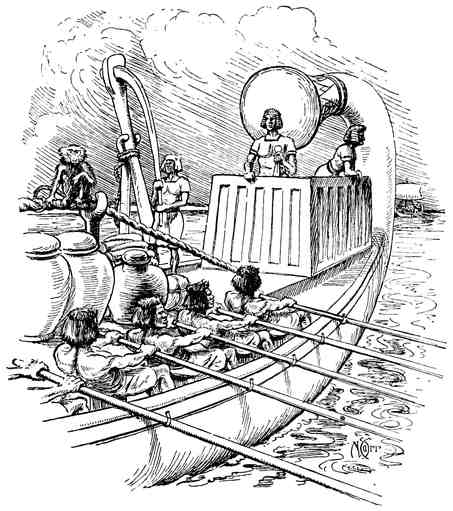
So also on the Mediterranean the Egyptian ships were seen. We know that the galleys of Rameses II plied regularly between Tanis and Tyre. This was no smooth-water passage, for the Syrian sea could be very rough, and on a later page we shall give the actual experience of an Egyptian skipper who had a pretty bad time hereabouts in his ship. Even those skilful seamen, the Phœnicians, found it required a good deal of care to avoid the current which flowed along their coasts and brought to them the mud from the mouths of the Nile. Now it was but natural that when the Egyptians took to the sea they should use, for their trading voyages to Syria or their expedition to Punt,13 craft very similar to those which they were wont to sail on the Nile. In fact, it was possible for one and the same ship to be used for river and sea. In my “Sailing Ships and their Story,” the appearance of the Egyptian ships has been so thoroughly discussed that it is hardly necessary to go further into that matter at present. It is enough to state that they were decked both at bow and stern, that short, narrow benches were placed close to the bulwarks, leaving an empty space in the centre14 where the cargo could be stowed, and that there were fifteen rowers a side. There was one mast about 24 feet high setting one squaresail which was about 45 feet along its foot, and in addition to the oarsmen there were four topmen, a couple of helmsmen, and one pilot at the bow, who gave the necessary instructions to the helmsmen as to the course to be taken. Finally, there was an overseer to see that the rowers were kept up to their work and not allowed to slack.
On the whole the Egyptians were a peace-loving nation and not great fighters; but there were times when they had to engage in naval warfare, and on such occasions the ship’s bulwarks were raised by a long mantlet which shielded the bodies of the oarsmen, leaving only their heads exposed. And there were soldiers, too, placed on board these Egyptian ships in time of warfare. Two were stationed on the forecastle, one was in the fighting-top high on the mast, whilst the remainder were disposed on the bridge and quarter-deck, ready to shoot their arrows into the approaching enemy.
The navigation of the Egyptian seamen was but elementary. They coasted for the most part, rarely venturing out of sight of land, fixing their positions by familiar landmarks. This was by day; but at night they lay-to until the dawn returned, when they were enabled to resume their journey. Such methods, of course, demanded a longer time than more able seamen would have required, but the Egyptians were in no hurry, so it mattered not. It is patent enough, from the many representations which we find of craft on the Egyptian monuments which have been unearthed, that ships and boats played a highly important part in the life and habits of the Egyptians; but beyond the funereal customs and the connection which these craft had with their religious ideas, we know but little, if we15 except those models and those representations of their bigger ships seen with sail and mast. It is unquestionable that the shipbuilding industry was one of the most important activities which these Nile-dwellers engaged in; and illustrations still exist which show a shipwright’s yard of the Sixth Dynasty. We can see the men busily at work, whilst the dockyard manager or superintendent is carried in a kind of Sedan-chair to see how the work is progressing. Some are engaged hammering and chipping away at the wood that is to become a boat; some are fixing the different sections in place; whilst others are setting up the truss which was employed for preventing the ship from “hogging.”
But already by the close of the Third Dynasty, Professor Flinders Petrie says, the Egyptian shipbuilders were using quite large supplies of wood for their craft. In one year alone, Senofern constructed sixty ships and imported forty ships of cedar. When we consider that the Nile was the great national highway of Egypt, it was but natural that shipbuilding should be one of the most important trades. There were, first, the light skiffs which could be easily carried from place to place. There were also the larger freight-carriers which sailed the Nile and the open sea; and lastly, there were the houseboats, a kind of modern dahabeeah. The small skiffs were made of reeds for lightness, and coated with pitch. They were punted along the shallows with a pole, or paddled. They could carry only a couple of people, and were practically ferry-boats or dinghies. But the larger boats were built of wood, and probably sometimes of acacia. The masts were of fir which was imported from Syria, the sails being occasionally of papyrus, but probably also of linen.
The lotus plant played a conspicuous part in Egyptian shipbuilding. We see the smaller craft being strengthened16 by the stalks of this plant, bundles of which are depicted being carried down to the yard on the backs of the shipwright’s men. The tail-piece, even of the biggest sea-going craft, is shown to be in the shape of a lotus bud or flower. That they knew how to build ships of great tonnage at these dockyards is evident from the fact that Sesostris had a sacred barge constructed that was 280 cubits long. And it was doubtless owing to the great length of the Nile sailing ships, and their consequent inability to turn quickly, that we find it unusual for the Egyptian ships to have only a single steering oar; very frequently there was one each side at the quarter.
More than this it is difficult to state regarding the manner in which they employed their ships. There is indeed very much that we should like to know, and we cannot be too thankful that modern exploration has actually revealed so many pictorial representations. The Egyptians were not instinctively seamen as the Phœnicians and the Vikings, and if there had been no Nile it is probable that the sea and its coast might have meant even less to them than was actually the case. Nor was it any different with the Assyrians, whose kings feared the sea for a long time. They never ventured on its surface without being absolutely compelled. At a later stage, when their victories brought them to the shores of the Mediterranean, they were constrained to admire its beauty, and presently even took a certain amount of pleasure in sailing on its bosom, but nothing would tempt them far from land or to make a voyage.
But then there came a new precedent when Sennacherib embarked his army on board a fleet and went in search of the exiles of Bit-Iakin. The only ships that were at his disposal were those belonging to the Chaldean States. These craft were in every way unsuitable;17 they were obsolete, clumsy, heavy, bad sea-boats, and slow. During his wars, however, he had seen the famous sailors of Sidon, and noted alike the progress which these seafarers had made in actual shipbuilding, and in the handling of their craft at sea. These were of course Phœnicians, and among his prisoners Sennacherib found a sufficient number of Phœnicians to build for him a fleet, establishing one shipbuilding yard on the Euphrates and another on the Tigris. The result was that they turned out a number of craft of the galley type with a double row of oarsmen. These two divisions of newly built craft met on the Euphrates not far from the sea, the Euphrates being always navigable. The contingent from the Tigris, however, had to come by the canal which united the two rivers. And then, manned with crews from Tyre and Sidon, and Cypriot Greeks, the fleet went forth to its destination; Sennacherib then disembarked his men and rendered his expedition victorious.
Here, then, is just another instance of a non-seafaring people taking to the sea not from choice, not from instinct, but from compulsion—because there was no other alternative; and all the time employing seafaring mercenaries to perform a work that was strange to landsmen, just as in later days at different periods (until they themselves had grown in knowledge and experience), the English had to import sailors from Friesland in the time of Alfred, or Italians in the early Tudor period. The sea was still hardly more than a half-opened book, and few there were who dared to look into its pages.
18
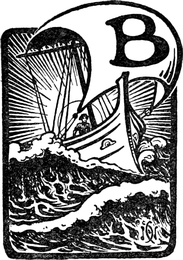
But when we come to the Phœnicians we are in touch with a veritable race of seamen who to the south are in just the same relation as the Vikings are to the north. Whether they took to the sea because they longed to become great merchants, or whether they were seamen first and employed their daring to commercial benefit needs no discussion. They had the true vocation for the sea, and it was inevitable that sooner or later they must become mighty explorers and traders.
They had the real ship-love, which is the foundation of all true seamanship; they were in sympathy with the life and work, and they knew how to build a ship well. They furnished themselves with the finest timber from Lebanon and surpassed the Egyptian inland sailors by making their craft stronger, longer, more seaworthy, and more able to endure the long, daring voyages which it delighted the Phœnicians to undertake. Similarly, their crews were better trained to sea-work, were more daring and skilful than the Nile-dwellers. They minded not to sail out of sight of land, nor lay-to for the darkness to pass away. They were wont to sail the open sea fearlessly direct from19 Tyre or Sidon to Cyprus, and thence to the promontories of Lycia and Rhodes, and so from island to island to the lands of the Acheans, the Daneans, and further yet to Hesperia. How did they do it? What were their means and methods for navigation?
The answer is simply made. They observed the position of the sun by day. They would watch when the sun rose, when it became south, when it set, and then by night there was the Great Bear by which to steer. Their ships they designated “sea-horses,” and the expression is significant as denoting strength, speed, and reliability. By their distant voyages the Phœnicians began to open out the world, and they contributed to geographical knowledge more than all the Egyptian dynasties put together had ever yielded under this category. Their earliest craft were little more than mere open boats which were partially decked. Made of fir or cedar cut into planks, which were fashioned into craft all too soon before the wood had sufficient time to become seasoned, they were caulked probably with bitumen, a poor substitute for vegetable tar. We know from existing illustrations that the Egyptian influence as to design was obvious in their ships. We know also that the thirty or more oarsmen sat not paddling, but rowing facing aft, and that they used the boomless squaresail and shortened sail by means of brails.
“The first considerable improvement in shipbuilding which can be confidently ascribed to the Phœnicians,” says Professor Rawlinson,1 “is the construction of biremes. Phœnician biremes are represented in the Assyrian sculptures as early as the time of Sennacherib (700 B.C.), and had probably then been in use for some considerable period. They were at first comparatively short vessels, but seem to have been decked,20 the rowers working in the hold. They sat at two elevations, one above the other, and worked their oars through holes in the vessel’s side. It was in frail barks of this description, not much better than open boats in the earlier period, that the mariners of Phœnicia, and especially those of Sidon, as far back as the thirteenth or fourteenth century before our era, affronted the perils of the Mediterranean.”
At first the Phœnicians confined their voyages to the limits of the western end of the Mediterranean, but even then, notwithstanding their superiority in seamanship and navigation, they suffered many a disaster at sea. Three hundred ships were lost in a storm off Mt. Athos when they first attempted to invade Greece. And on their second attempt six hundred more ships were lost off Magnesia and Eubœa. In addition to this, it must be presumed that the rocks and shoals of the Ægean Sea, the cruel coasts of Greece, Spain, Italy, Crete, and Asia Minor would account for a good many more losses of ships and men. In those days, too, when one ship on meeting another used to ask in perfect candour if the latter were a pirate, and received an equally candid answer, there was thus a further risk to be undergone by all who used the sea for their living. If the ship were in fact piratical and her commander considered himself the stronger of the two, his crew would waste little time, but promptly board the other ship, confiscate her cargo, bind the seamen and sell them off at the nearest slave market. And be it remembered that a Phœnician ship, inasmuch as she was usually full of goods recently purchased or about to be sold, was something worth capturing. Her cargo of rich merchandise was deserving of a keen struggle and the loss of a number of men.
Nor were the Phœnicians averse from reckoning slaves among their commodities for barter; indeed,21 this was a great and important feature of their trade. Away they went roaming the untracked seas with their powerful oarsmen and single squaresail and their hulls well filled with valuable commodities, “freighting their vessels,” as Herodotus relates, “with the wares of Egypt and Assyria” for the Greek consumer. Year after year the ships sailed forth from Tyre to traverse the whole length of the Mediterranean and out into the Atlantic northwards to the British Isles, through storm and tempest, to embark the cargoes of tin. To be able to perform such a voyage not once but time after time is sufficient proof of the seamanship and navigation of the crews no less than of the seaworthiness of the Phœnician craft. Even that most wonderful circumnavigation of Africa by the Phœnicians as given by Herodotus is regarded by Grote, Rawlinson, and other authorities as having actually occurred and being not a mere figment of imagination. The story may be briefly summed up thus. Neco, King of Egypt, was anxious to have a means of connecting the Red Sea and Mediterranean by water, but had failed in his efforts to make a canal between the Nile and the Gulf of Suez, so he resolved that the circumnavigation of Africa should be attempted. For this he needed the world’s finest seamen and navigators with the best ocean-going ships available. Accordingly he chose the Phœnicians, who, departing from a Red Sea port, coasted round Africa, and after nearly three years arrived safely back in Egypt. The obvious question which the reader will ask is how could such craft possibly carry enough food for three years. The answer is that they did not even attempt such a feat. Instead, they used to make some harbour after part of their voyage was accomplished, land, sow their grain, wait till harvest-time, and then sail off with their food on board all ready for a further instalment of the journey. And22 there is really nothing too wonderful in this long voyage when we remember that in Africa what is to-day called Indian corn can be reaped six weeks after being sown; and that three years is not such an excessively long time for a well-manned craft fitted with mast and squaresail to coast from headland to headland, across all the bays and bights of the African continent. A great achievement it certainly was, not to be attempted (unless history is woefully silent) again until towards the close of the fifteenth century, when Vasco da Gama doubled the Cape of Good Hope.
They had for years been wont in the Mediterranean to make voyages by night. They had steered their course by aid of the Polar star. “They undoubtedly,” remarks Professor Rawlinson, “from an ancient date made themselves charts of the seas which they frequented, calculated distances, and laid down the relative position of place to place. Strabo says that the Sidonians especially cultivated the arts of astronomy and arithmetic as being necessary for reckoning a ship’s course, and particularly needed in sailing by night.” Later on we shall again call attention to the great surprise which confronted the dwellers by the Mediterranean when they voyaged into other seas. The Phœnicians, so long as they cruised only in the former, had no tide to contend with; but when they set forth into the Red Sea, the Indian Ocean, the Atlantic, and the English Channel, they found a factor which, hitherto, they had not been compelled to encounter. But by such a seafaring race it was not long before even this new consideration was dealt with and utilised in the proper manner. “They noted,” says Rawlinson, “the occurrence of spring and neap tides, and were aware of the connection with the position of the sun and moon relatively to the earth, but they made the mistake of supposing that the spring tides were highest23 at the summer solstice, whereas they are really highest in December.”
If we omit the Egyptians from our category as being almost exclusively inland navigators, we must regard these Phœnicians as historically the first great seamen of the world, and it is nothing short of remarkable that in an age such as theirs, when there were so few accessories to encourage and develop the marine instinct, they should have essayed so much and succeeded so magnificently in their projects. Remember, too, that they had something of the instinct of the engineer as well as of the seaman in their nature. It was the Phœnicians whom Xerxes employed in 485 B.C. for the purpose of cutting a ship canal through the isthmus which joins Mt. Athos to the mainland. It was they, also, who constructed a double bridge of boats across the Hellespont to form the basis of a solid causeway, and in each of these undertakings they covered themselves with distinction.
They were no amateurs, no mere experimenters. It is certain that, in their own time, they were, even with their primitive ships, very far from primitive in their ideas of seamanship. Read the following exceedingly interesting account of one who went aboard a Phœnician vessel and has left to posterity his impressions of his visit. The descriptive narrative reads so true and seems so perfectly spontaneous and natural that we almost forget the many centuries which have elapsed since it was set down. Here, then, you have the record of no less a person than Xenophon, a man who was far too discriminating to allow any flow of careless words, far too observant, also, to allow anything worth noting to escape his watchful eye. In “The Economist” he makes one of his characters refer to a Phœnician trireme, and he is speaking of that nation’s ships when the Phœnicians were under the Persian system:—
24 “Or2 picture a trireme, crammed choke-ful of mariners; for what reason is she so terror-striking an object to her enemies, and a sight so gladsome to the eyes of friends? Is it not that the gallant ship sails so swiftly? And why is it that, for all their crowding, the ship’s company cause each other no distress? Simply that there, as you see them, they sit in order; in order bend to the oar; in order recover the stroke; in order step on board; in order disembark.”
And again:—
“I must tell you, Socrates, what strikes me as the finest and most accurate arrangement of goods and furniture it was ever my fortune to set eyes on, when I went as a sightseer on board the great Phœnician merchantman and beheld an endless quantity of goods and gear of all sorts, all separately packed and stowed away within the smallest compass. I need scarce remind you (he said, continuing his narrative) what a vast amount of wooden spars and cables a ship depends on in order to get to moorings; or again, in putting out to sea: you know the host of sails and cordage, rigging as they call it, she requires for sailing; the quantity of engines and machinery of all sorts she is armed with in case she should encounter any hostile craft; the infinitude of arms she carries, with her crew of fighting men aboard. Then all the vessels and utensils, such as people use at home on land, required for the different messes, form a portion of the freight; and besides all this, the hold is heavy laden with a mass of merchandise, the cargo proper, which the master carries with him for the sake of traffic. Well, all these different things that I have named lay packed there in a space but little larger than a fair-sized dining-room.25 The several sorts, moreover, as I noticed, lay so well arranged, there could be no entanglement of one with other, nor were searchers needed; and if all were snugly stowed, all were alike get-at-able, much to the avoidance of delay if anything were wanted on the instant. Then the pilot’s mate—the look-out man at the prow, to give him his proper title—was, I found, so well acquainted with the place for everything that, even off the ship, he could tell you where each set of things was laid and how many there were of each, just as well as anyone who knows his alphabet could tell you how many letters there are in Socrates, and the order in which they stand. I saw this same man (continued Ischomachus) examining at leisure everything which could possibly be needful for the service of the ship. His inspection caused me such surprise, I asked him what he was doing, whereupon he answered, ‘I am looking to see, stranger, in case anything should happen, how everything is arranged in the ship, and whether anything is wanting or not lying handy and shipshape. There is no time left, you know, when God makes a tempest in the great deep, to set about searching for what you want or to be giving out anything which is not snug and shipshape in its place.’”
There was something, then, so excellent in arrangement in these Phœnician ships which seemed to Xenophon so superior to the vessels of his own countrymen; and the sailor-like neatness and systematic order were to him so striking that even to his disciplined and orderly mind they were most remarkable. It requires but little imagination to picture from this scant reference the ship’s company doing everything according to drill. The seaman-like care for the running gear on the part of the ship’s husband ready for any emergency is, indeed, highly suggestive.
26 The importance of the Phœnicians is considerable, not merely for their own sake, but because of their permanent influence on the Greeks. But the latter were rather fighters than explorers as compared with the Phœnicians. At a very early date there was the sea communication between the Mediterranean and the North, and we may date this certainly as far back as the year 2000 B.C., suggests Dr. Nansen, himself an explorer and student of the early voyagers. The only places, excluding China, whence tin-ore was known to be procurable in ancient times, he asserts, were North-West Spain, Cornwall, and probably Brittany. It is significant that in the oldest pyramid-graves of Egypt tin is found, and the inference is that the inhabitants of the Mediterranean from at least this epoch voyaged north to fetch this commodity from Western Europe. And with the tin came also supplies of amber as well. Archæological finds, affirms the same authority, prove that as far back as the Scandinavian Bronze Age, or prior to this, there must have been some sort of communication between the Mediterranean and northern lands. One of the earliest trade routes connecting the Mediterranean and the Baltic was from the Black Sea up the Dneiper, then along its tributary the Bug to the Vistula, and down the latter to the coast. By their sea-voyages to distant lands the Phœnicians contributed for the first time a great deal of geographical knowledge of the world, and in many ways influenced Greek geography. Up till then the learned men who applied themselves to such subjects had but the vaguest idea of the North. But just as in subsequent centuries the Spanish kept their explored regions to themselves and continued most cautious lest other nationalities should learn their sources of wealth, so the Phœnicians did their best to keep their trade routes secret lest their rivals, the Greeks, should step in and enrich themselves.27 In the absence, therefore, of anything sufficiently definite, there was for a long period a good deal of wild and inaccurate speculation.
But it is when we come to Pytheas of Massilia that we reach the border-line which separates fact from fable. This eminent astronomer and geographer of Marseilles brought together a knowledge of northern countries which was based not on premonition, not on speculation, not on hearsay, but on actual experience. So original, so accurate, and so far-reaching was his work, that for the next fifteen hundred years he dominated all geographical knowledge. We can fix his time if we remember that he flourished probably about the year 330 B.C. He was the first person in history to introduce astronomical measurements for ascertaining the geographical situation of a place, and thus became the founder of the science of navigation—the science which has enabled seas to be crossed in safety and continents to be discovered; which has given to the ship of all species a freedom to employ her speed without sacrificing safety. Indirectly arising from these may be traced the development and civilising and peopling of the world which have so entirely modified history.
By means of a great gnomon, Pytheas determined “with surprising accuracy” the latitude of Marseilles, and in relation to this laid down the latitude of more northerly places. He observed that the Pole of the heavens did not coincide, as the earlier astronomer Eudoxus had supposed, with any star. What Pytheas did find was that it made an almost regular rectangle with three stars lying near it. (At that time the Pole was some distance from the present Pole-star.) And since Pytheas steered by the stars, the Pole of the heavens was obviously of the highest importance to him. A gnomon, it may be explained, was the pillar of projection which cast the shadow on the various Greek28 forms of dial. In the case under discussion the gnomon was a vertical column raised on a plane.
As to the species of ship in which Pytheas sailed we can but speculate. Most probably it was somewhat similar to the Phœnician type, with oarsmen and one mast with squaresail. But what is known is that he sailed out through the Pillars of Hercules. At that date Cape St. Vincent—then known as the Sacred Promontory—was the furthest of the world’s limit in the minds of the Greeks. He was the first to sail along the coasts of Northern Gaul and Germany. He was the discoverer of at least most of Great Britain, the Shetlands, and Norway as far as the Arctic Circle. And as he voyaged he studied the phenomena of the sea—collected invaluable data as to tides and their origin. Himself a Greek and unaccustomed to tidal movements, he was the first of his race to connect this systematic flowing and ebbing of the sea with the moon. Dr. Nansen, himself the greatest explorer of our times, has not hesitated to describe Pytheas as “one of the most capable and undaunted explorers the world has ever seen.” But as so often happens in the case of a pioneer, Pytheas was ahead of his time, and the description which he brought back of his travels, of the strange lands and unheard-of phenomena, was not believed by his contemporaries. There followed, therefore, a gulf of incredulity for about three hundred years till we come to the time of Julius Cæsar, and from that point we shall, in due course, continue to trace the development of navigational science.
29
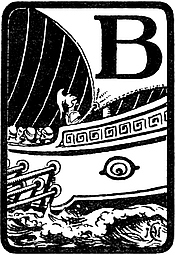
But before we proceed further, it is essential that we look carefully into the building, administration, and handling of those fleets of vessels which made history as they scudded across the blue waters of the south of Europe. We want to know, also, something of the composition of their crews, their officers, and the divisions of control, of the tactics employed in naval warfare, of the limitations in manœuvring, the methods of working the oars, of rigging the ships, of steering, and so on.
Greece had accepted the ship as it had evolved in the hands of the Phœnicians with certain modifications. We are no longer anxious to trace that development, but rather to see, in the first place, how the Greeks availed themselves of their inheritance. In the building of their ships the Greeks gave neither sternpost nor stempost. The timbers of the ships were held together by means of wooden pegs (or treenails, as we should call them), and also by metal nails, bronze being chosen in preference to iron nails for the most obvious of reasons. But in those days, as any student of Greek history is aware, not infrequently craft had to be transported. Therefore the fastenings were so30 placed as to allow of the ship being divided into sections for carrying across land to some distant water. The outer framework of the hull was found in the keel and ribs. The ship’s planking, which varied from the somewhat ample 2¼ inches to 5¼ inches thick, was fastened through the ribs to the beams.
The warships had most necessarily to be built of the utmost strength to sustain the terrible shocks in ramming. To prevent the damage incurred being disastrous, cables—called hypozomata—undergirded the ship. The Greek word signifies the diaphragm or midriff in anatomy, but in the plural it is used to designate the braces which were passed either underneath or horizontally around the ship’s hull. The reader may remember that in “Sailing Ships and their Story” I called attention to the Egyptian ships, which used to be strengthened by stretching similar cables not girth-wise, but direct from stem to stern across the deck over wooden forks amidships. Primarily, then, these braces on the Greek ships were to counteract the effects of ramming; incidentally they kept the ship’s hull from “working” when she pounded in heavy seas.
And then when the shipwright had finished his construction of the ship she was coloured with a composition consisting of paint and wax, the latter serving to give these speedy ships the minimum of skin-friction. The colours chosen were purple, two whites, violet, yellow, and blue. Green, for the sake of invisibility, was used for scouts and pirates. The primitive Grecian ships had only patches of colour at the bows, the rest of the hull being covered black with tar. Occasionally neither wax nor tar was employed, but the hull was sheathed with lead outside the planking, layers of tarred sailcloth being placed in between the two materials. They made their sails either of linen, or, sometimes, of papyrus fibre or flax, and there were31 two kinds of sailcloth which the Athenian Navy utilised. The bolt-ropes of the sails were of hide, the skins of the hyena and seal being especially employed. The ropes used for the different purposes of the ship were of two kinds. Some were of strips of hide; more frequently they were from the fibre of papyrus or from flax or hemp. The sails were often coloured—black for mourning, purple or vermilion for an admiral or monarch. Topsails were sometimes coloured, the lower sail remaining uncoloured. The green-hulled scouts also had their sails and ropes dyed to match the colour of the Mediterranean. And sometimes the interesting sight would be seen of sails with inscriptions and devices woven in golden thread into the fabric.
There is a Greek word askos, which signifies a leathern bag or wine-skin, from which the word askoma is derived. The latter was the word given to a leathern bag which was attached to the oar so as to prevent the water from penetrating through into the ship, and yet allowed, with only slight friction, the oar to be brought backward and forward. There is something slightly similar to-day in the leather flap which is found on the Bristol Channel pilot cutters, covering the discharge from the watertight cockpits, the motion of the ship through the water causing the flap to be pressed tightly against the hull, and thus preventing any water from entering. But in the instance of the Grecian craft the flap was much bigger. There were no rowlocks, but the oar was fastened by a leathern loop to a thole-pin against which the rower pulled his oar.
Bear in mind that, whereas the Greek merchant-ship mostly relied on sails, the warship was essentially oar-propelled. And because she must needs carry a large number of rowers they needed supervision. Hence a gangway was placed on either side of the ship, both for that purpose and also for the placing of32 the fighting men. Illustrations on ancient Greek vases clearly show that some warships were fitted with a hurricane-deck above, and this extended down the length of the ship, but not from one side to the other. This hurricane-deck, if we are to give any credence to contemporary illustrations, was a fairly light affair raised on vertical supports of sufficient strength. In addition to the human ballast of the oarsmen, gravel, sand, and stone were used for trimming the ship. For instance, it might be necessary to get the bows deeper into the water so that the ram came into operation; or, after ramming and receiving damage, it might be found advisable to trim the ship by the stern so as to get the bows well out of water. To what extent these craft leaked one cannot say; but one can reasonably suppose that as they were built of unseasoned wood, as the shocks from ramming were very injurious, and as they had to suffer a good deal of wear and tear through frequent beaching, they made a fair amount of water. At any rate, it is certain that they provided against this in arranging an Archimedean screw, worked by a treadmill, or buckets for getting rid of the bilge-water. It is probable, also, that the drinking-water in cisterns or skins would be deposited as low in the hull as possible.
The Greeks, in addition to their technical ability, had inherited a similar sea-instinct to that of the Phœnicians, and this keenness is by no means absent from Greek literature. What, for instance, could be more enthusiastic than the following exquisitely poetic extract from Antipater of Sidon:—
“Now is the season for a ship to run through the gurgling water, and no longer does the sea gloom, fretted with gusty squalls; and now the swallow plasters her globed houses under the rafters, and the soft leafage laughs in the meadows. Therefore wind up your soaked cables, O sailors, and weigh your sunken33 anchors from the harbours, and stretch the forestays to carry your well-woven sails. This I, the son of Bromius, bid you, Priapus of the anchorage.”3
It is an exhortation, at the return of spring, to refit the ships which had been laid up since the winter, tethered to the “soaked cables.” It is an invitation to get the ships properly afloat, to step the masts and set up the forestay in all readiness for getting under way for the sailing season.
Or again, listen to Leonidas of Tarentum in a similar theme.
“Now is the season of sailing,” he says, “for already the chattering swallow is come and the pleasant west wind; the meadows flower, and the sea, tossed up with waves and rough blasts, has sunk to silence. Weigh thine anchors and unloose thine hawsers, O mariner, and sail with all thy canvas set: this I, Priapus of the harbour, bid thee, O man, that thou mayest sail forth to all thy trafficking.”4
“Mine be a mattress on the poop,” sings5 Antiphilus with no less ecstasy of the life on board a Grecian ship, “mine be a mattress on the poop, and the awnings over it sounding with the blows of the spray, and the fire forcing its way out of the hearth-stones, and a pot upon them with empty turmoil of bubbles; and let me see the boy dressing the meat, and my table be a ship’s plank covered with a cloth; and a game of pitch-and-toss, and the boatswain’s whistle: the other day I had such fortune, for I love common life.”
Three thousand years, indeed, before the birth of our Lord there were ships sailing the Ægean Sea, but it was only the progress of time and experience which made these craft and their crews’ ability anything more than primitive. As you look through the poems of34 Homer you find various significant references to craft, and he speaks of the “red-cheeked” ships, referring to the vermilion-coloured bows, where a face was frequently painted, red being the conventional colour in those early times for flesh. The same idea is still seen in the Chinese junks and the Portuguese fishing craft.
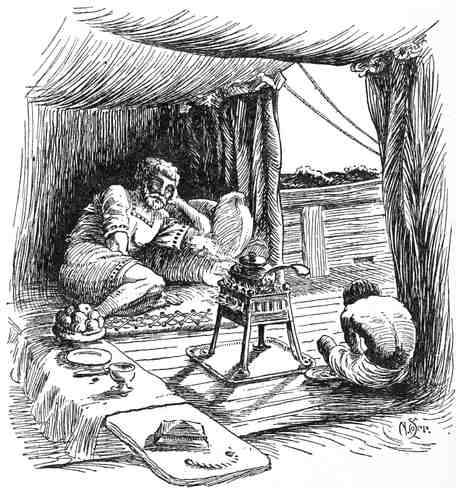
The earliest Grecian ships were crescent-shaped, and the stern so resembled the horn of a cow that it was called the korumba or point. There is a reference in35 the Iliad to the high-pointed sterns of ships. From Homer, too, we know that the timber employed in shipbuilding consisted of oak, pine, fir, alder, poplar, and white poplar; that the masts and oars were of fir, that the woodwork of the hull was erected on shipbuilders’ stocks. The word used for the latter was druochoi—meaning the props on which the keel (tropis) was laid. The hull was secured by treenails and dowel-joints, the planking being laid over the ribs. Further, we know also that the ship of Homer had either twenty or fifty oarsmen.
The pre-Homeric Greeks did not use thole-pins, but the oars were fastened to the gunwale by means of leathered hoops. It was not till a later date that the pins already mentioned came into use. It is noticeable, too, that Homer uses the word kleides in referring to the thwarts on which the rowers sat. For the singular of this word means a hook or clasp, and is used in this sense for the thwart or rowing bench which locked the sides of the ship together. Zuga is also used in the Odyssey to signify the same thing. In attempting to piece together these fragmentary details of the Homeric ship, we must bear in mind that below the zuga or rowing thwarts the hold was undecked, but that fore and aft there ran the half-decks—ikria, Homer calls them. The forecastle formed at once a cabin and a look-out post, and helped to keep the forward end protected when butting into a sea. Right aft, of course, sat the helmsman, or kubernetes, and it is supposed that a bench here stretched across the poop on which, as he sat on deck, he could rest his feet and work the oieion or handle of the rudder. A Greek ship usually had two pedalia or steering oars, one being placed on either quarter. These were joined together across the ship by means of cross-bars (zeuglai), to which the tiller or handle was attached. Finally, over36 the poop rose the tail-piece which is so noticeable in some of the vase-illustrations of Grecian ships, and had its counterpart in the lotus-bud seen in the ships of the Egyptians.
Homer speaks of “stepping the mast” (histos), and apparently the step was affixed as low as possible, its heel being supported by a prop and capable of being easily lowered before the galley went into battle under oar-propulsion alone. The forestays, which just now we saw Antipater urging the sailors to stretch, were two in number. The Homeric word for these is protonoi, though the word was used by Euripides in speaking of the braces which controlled the yards. On the yard which stretched at right angles across the mast both merchantmen and warships set the squaresail, and the use by Homer of the word meruomai for drawing up or furling sails is sufficiently indicative that the ancient Greek sailors stowed sail not by lowering it on deck as in a modern fore-and-after, but after the fashion of a modern full-rigged ship.
We find mention also of the halyards—one on each side of the mast is shown in the Greek vase designs—which supported the yard to the top of the mast, the sail being reefed by means of brailing lines. The same word that we have just mentioned, for “drawing up” or “furling” sails, was also employed for drawing up the cables. And here again there is a further connection. The plural kaloi is used to mean (1) cables, (2) reefing ropes (i.e. brails), or even reefs as opposed to the sheets (podes) and braces (huperai). Euripides employs the expression kalōs exienai, meaning to “let out the reefs.” And (3) kaloi also means not merely generally a rope, but also a sounding line, which again is evidence that these ancient seamen found the depth of water as the modern sailor feels his way through shoal seas. The word just given for sheets was applied to the lower37 corners of the sail—clews as we nowadays call them—and thus naturally the ropes attached to the foot (or lowest part) were also called podes. The braces were called huperai, obviously because they were in fact the upper ropes.
As we have just seen from Antipater and Leonidas, the mariner used cables and hawsers for securing his ship, these being sent out from both bow and stern. Instead of anchors the early Greeks used heavy stones for the bow cables, whilst other hawsers were run out from the stern to the shore and hitched on to a big boulder or rock. If the former, then there was a hole therein. An endless rope was rove through this perforated stone, so that thus the ship could be hauled ashore for disembarking, or when wishing to go aboard again, sufficient slack of course having been left at the bow cables. A long pole was used for shoving off, while a ladder, which is seen more than once in Greek vase illustrations, was carried at the stern for convenience in descending to the land from the high-pointed sterns.
There were two sailing seasons. The first was after the rising of the Pleiads, in spring; the second was between midsummer and autumn. When, after the setting of the Pleiads, the ship was hauled up into winter quarters on land, she was supported by props to keep her upright, and then a stone fence was put round her. This afforded her protection against wind and weather. The cheimaros, or plug, was then taken out from the bottom so as to let out all the bilge-water. The ship’s gear, the sails, steering oars, and tiller were then stored at home till the time came once more for the sailors to “stretch” their forestays.
About the year 700 B.C. the Greek warships were manned by fifty rowers; hence these craft were called pentekontoroi. With the existence of a forecastle and a38 raised horned poop, one can understand perfectly well how easy was the transition which caused an upper deck to be added about this century. This gave to the ship greater power, because it allowed two banks of oarsmen, one on each deck. As far as possible these rowers were covered in to avoid the attacks of the enemy. Such shallow-draught vessels as the war-galleys could not possibly be good as sailing craft. They must be looked upon as essentially rowing vessels which occasionally set canvas when cruising and a fair wind was blowing.
The pentekontoroi were single-banked, and for a long time the Greek fleets consisted solely of this type. But then came the additional deck just spoken of which gave two banks, and subsequently the trireme succeeded the bireme. The trireme was very popular till after the close of the Peloponnesian War, when the quadrireme was introduced from Carthage. Dr. Oskar Seyffert6 asserts that before the close of the fourth century B.C. quinquiremes and even six-banked craft, and (later still) even sixteen-banked vessels are supposed by some writers to have been in vogue. But as to the latter this seems highly improbable.
And before we proceed any further, let us endeavour to get a clear idea as to the nature of a trireme. This species of ship had been invented by those great seamen who hailed from the port of Sidon. About the year 700 B.C. this type was adopted by the Greeks, and then began to supersede all other existing types of war-vessels. Themistocles in 483 B.C. inaugurated the excellent practice of maintaining a large permanent navy. As a commencement he built a hundred triremes, and these were used at the battle of Salamis. In the Greek word trieres there is nothing to signify that it was necessarily three-banked, and it is well to realise39 this fact from the start. The word just means “triple-arranged,” neither more nor less. It is when we come to the question as to the details of this triple arrangement that we find a divergence of theory. It will, therefore, be best if we state first the prevailing theory of the trireme’s arrangement, and then pass on to give what is the more modern and the more plausible interpretation.
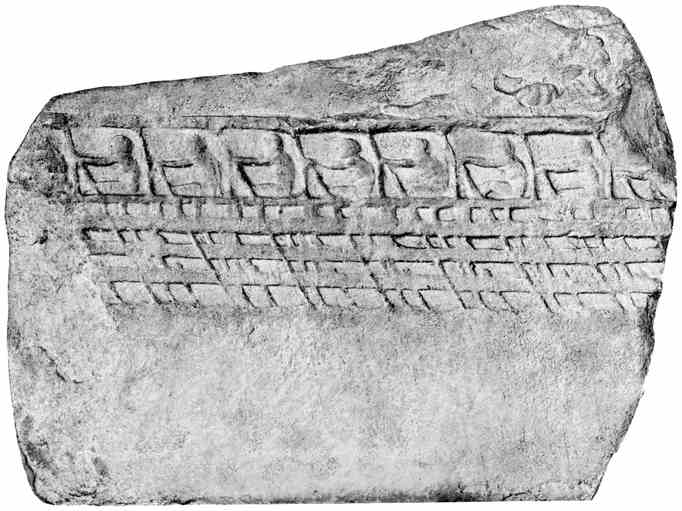
Cast of a Relief in Athens.
Showing the disposition of rowers in a trireme.
The most general idea, then, is that the trireme was fitted with three tiers of oarsmen. In this case the thalamitai were those who sat and worked on the lowest tier; the zugitai, those who sat on the beams; whilst the thranitai were the men who sat on the highest tier. (Homer refers to the seven-foot bench, or thrēnus, which was the seat of the helmsman or the rowers). Each oarsman, it is thought, sat below and slightly to the rear of the oarsman above him, so that these three sections of men formed an oblique line. This economised space and facilitated their movements. A variation of this same theory suggests that the thalamitai sat close to the vessel’s side, the zugitai who were higher up being distant from the side the breadth of one thwart, whilst the thranitai, higher still, were the breadth of two thwarts away. The oar of each rower would pass over the head of the rower below.
But a better theory of the arrangement of the trireme may be presented as follows, and it has the advantage of satisfying all the evidence found in ancient literature and pictorial representation. Banish, then, from your mind all thought of three superimposed tiers, and instead consider a galley so arranged that the rowers work side by side. Each of the triple set of oarsmen sits pulling his own separate oar. But all three oars emerge through one porthole. In front of each bench was a stretcher, and the rower stood up grasping his oar and pulled back, letting the full weight of his body40 fall on to the stroke till at its end he found himself sitting on the bench. On either side of him, at the same bench, was another rower doing the same exertion. In each porthole there would thus be three thole-pins to fit three oars. In this case, then, the thalamitēs would be he who rowed nearest the porthole. Because he worked the shortest oar and thus had the least exertion he received the least pay. Next to him sat the zugitēs, and next to the latter came the thranitēs, who worked the longest oar, and therefore did the most work, having to stand on a stool (thranos) in order to get greater exertion on to his oar at the beginning of the stroke. It is supposed that the rowers’ benches were not all in the same plane, but that the second would be higher than the first, and the third higher than the second.
The number of oars in an ancient trireme was as many as 170. These oars were necessarily very long, and time was kept sometimes by the music of a flute, or by the stroke set by the keleustes, who was on board for that purpose. This he did either with a hammer of some sort, or his voice. And there is at least one illustration showing such a man using a hammer in an oar-propelled boat for that purpose.7 The inscriptions which were unearthed some years ago, containing the inventories of the Athenian dockyards, belonging to the years between 373 B.C. and 323 B.C., have been collected and published. And it is from them that we obtain such valuable information as the number of oarsmen which the biremes carried. This number was usually 200, and was disposed in the ship as follows: There were 54 thalamitai, 54 zugitai, 62 thranitai, and 30 perineo. The exact meaning of the latter word is supercargoes or passengers, but they were carried perhaps as spare oarsmen in case any became disabled.
41 All oars were worked together against the tholes, and as we know from the old depictions there was a space left both at bow and stern beyond the oarsmen, this space being called the parexeiresia. The number of oarsmen just mentioned may seem very large, but having regard to the speed required for manœuvring and for ramming effectively it is not excessive. But when a war-vessel was employed on transport duty so great a host of men was not essential. In the case of a vessel engaged, for instance, in carrying horses in her hold only sixty oarsmen were needed. Had you found yourself alongside one of the war-galleys you would have been struck by its length and leanness more than by anything else. As you passed round by the bows you would have observed the two great eyes, one on either side of the hull, through which in all probability the hawsers passed. Behind these two eyes were very substantial catheads which projected like great ears from the ship, and were used primarily for slinging the anchors just as in the old-fashioned sailing ships of Nelson and after; but, secondly, for convenience when ramming. Thus, when the terrible shock came, the catheads would protect the oars of the ship from damage and allow the utmost speed to be maintained till the last minute—a factor that was naturally of the highest importance. But also they were sometimes strengthened with supports so that they might catch in the topsides of the enemy and do him considerable damage.
As to the ram, which was the pivot of all the ancient naval tactics, there was one projecting spur below, but above it was another ram to catch the attacked ship at a second place. These rams were made of bronze and had three teeth; or if not made of bronze they were of wood sheathed with that metal. The stempost in these craft rose high in the air, and each ship had a distinguishing sign consisting either of a figurehead or some42 relief or painting at the bows. Of the two kinds of sails which these vessels carried, the larger was put ashore prior to battle, and only the smaller one retained. And as there were two sizes of sails, so there were two sizes of masts to correspond. Besides the halyards, brailing ropes, cables, braces, sheets, and forestay already alluded to, there were also backstays to support the masts. This was up to about the year 400 B.C., but, at any rate, by 330 B.C. triremes had simply mast, yard, sail, ropes, and the loops of brailing ropes, a simplified form of the earlier brails.
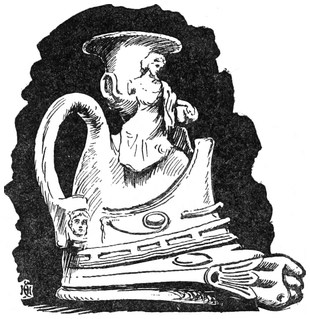
Terra-cotta Vase in the form of a Trireme’s Prow.
Showing eye and both upper and lower ram, each with triple teeth.
But additional to the triremes which had been first built at Corinth, were the quadriremes which first appeared in the year 398 B.C. As to their nature, their complement, and other details we know nothing. But it is legitimate to suppose that if the triremes rowed three men to a bench these were manned by four men43 on each bench rowing four oars in a similar manner. In the same year that first saw the quadriremes were built also quinquiremes. As to their size and complement we know just this much—that at the battle of Ecnomus the Roman and Carthaginian quinquiremes carried about 300 rowers and 120 combatants each. Probably, like the medieval quinquiremes, they rowed five men to each oar; or, alternatively, the five men each pulled an oar through the same porthole.
Some of the later developments of the marine instinct in the Mediterranean and adjacent seas became grotesque. Personal pride and a keen sense of rivalry caused the King of Sicily and his brother sovereigns of Macedonia, Asia, and Alexandria during the fourth and third centuries B.C. to construct men-of-war on a huge scale. A temple in Cyprus commemorates the builder of a twenty- and a thirty-fold vessel. But there was even a forty-fold vessel constructed by Ptolemy Philopator about the year 220 B.C., which was the size of one of our big liners of to-day. Two hundred and eighty cubits she measured in length, thirty-eight she was wide. Her stem rose 48 cubits above the water with only a 4-cubit draught, while the stern-ornament was 53 cubits high in the air. Fitted with a double prow which had seven rams, a double stern with four steering paddles 30 cubits each in length, the largest of her oars measured 38 cubits in length, but they were nicely balanced by weighting them with an equipoise of lead near the handles. Twelve strong cables 600 cubits long girded her together, and her complement was far greater than any vessel of modern times, four thousand oarsmen, 400 sailors, 2850 soldiers, to say nothing of the retinue of servants and the stores which she carried besides. There was also an enormous Nile barge 280 cubits long, built by Sesostris, but such craft as the fore-mentioned must be looked upon less as an44 opportunity for practising the seaman’s art than as a vulgar display of wealth.
The true war-vessel was made in the proportions of length seven or eight times her width, and drew about 3 feet of water. Light, shallow, and flat, not particularly seaworthy, they were utterly different from the round, heavy, strong, decked merchantman. The war-galley’s triple-spiked ram had come into use as far back as 556 B.C. The galley was most certainly fast and built of fir with a keel of oak. Competent modern authorities agree in estimating the speed of the galley and merchantman in those days as about 7½ to 4 (or 5) knots respectively.
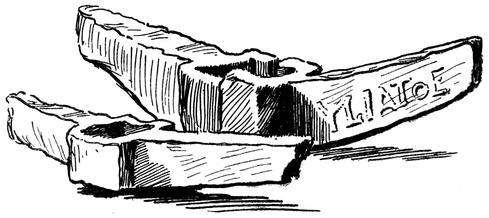
Portions of Early Mediterranean Anchor in Lead found off the Coast of Cyrene.
(In the British Museum.)
When stone was discarded and metal anchors began to be adopted about the year 600 B.C., they were made first of iron. Some idea of the weight of the holding tackle in vogue may be gathered from the statement that an anchor weighing less than 56 lbs. was used in the Athenian navy. (For the sake of comparison, it may be added that this is about the weight of a modern 10-ton yacht’s bower anchor.) Stone and lead were affixed to these anchors by iron clamps near the bottom of the shank. The ships of the Athenian navy carried45 each a couple of anchors, while large merchant ships carried several, as we know from the voyages of St. Paul. Cork floats were employed for buoying the anchors, as to-day, and also served the purpose of lifebuoys. Usually the ships rode to rope cables, but sometimes to chain ones. It can readily be imagined that when these light ships pitched fore and aft into a sea the two large steering oars at the high stern would be frequently out of the water, and thus quite easily the vessel would not be under command. In such instances another pair was placed at the bows. Like the modern Arabs, the early seamen of the Mediterranean had to go aloft as best they could by climbing the sail, the mast, or hanging their weight on any rope they could find.
“Curiously,” says Mr. Torr in his invaluable little book “Ancient Ships,” to which I am considerably indebted, “the practice was always to brail up half the sail when the ship was put on either tack, the other half being thereby transformed into a triangle with base extending from the middle of the yard to the leeward end of it, and apex terminating in the sheet below.” Apparently, when the yard was braced round the sail was furled on the arm that came aft, but left unfurled on the arm that went forward.
It is quite certain that the ancient Mediterranean seamen did perform voyages at night when they had attained to experience and confidence, and there is at least one plain reference in Greek literature to a lighthouse, as in the following passage: “No longer dreading the rayless night-mist, sail towards me confidently, O seafarers; for all wanderers I light my far-shining torch, memorial of the labours of the Asclepiadæ.”8
Some of the early vase paintings show the war-galley not with a ram as developed subsequently, but a46 pig’s snout, and the korumba or poop extremity, shaped like a cow’s horn, could be lopped off by the victor and retained as a trophy. And in looking at these ancient galleys one must not forget that they were built not as the English shipbuilders of, say, the seventeenth and eighteenth centuries laid down ships. Galleys were built far more quickly and easily—whole fleets of them—when the first rumour of war arrived. Capable as they were of being put together with greater dispatch, launched with far greater ease, and needing many tons less material than one of the famous wooden walls which in later years were to sail the seas, it required not quite so much enterprise if the ancients desired ships, and consequently there was no small inducement for men to become expert in the things of the sea. How important was the shipbuilding industry regarded by the Mediterraneans may be seen from the careful arrangements made a long time ahead for obtaining adequate supplies of timber. About the year 380 B.C. a treaty was made between Amyntas III and the Chalkidians regulating the export and import of shipbuilding materials; for it must not be forgotten that southern Makedon, the Chalkidic peninsula, and Amphipolis were the chief sources whence Athens derived its xula naupegesima—ship-timber—for her dockyards. This record is found in a marble which was discovered at Olynthos, and is now at Vienna.
At Corinth and other places there were all the accessories of a shipbuilding yard on a big scale, including proper slips, and even ship-tramways running down to the sea for hauling ships ashore. At such yards long, narrow rowing galleys and round, broad sailing merchant ships were put together with all the skill which the Greeks possessed. Here hulls were built out of pine, cedar, and cypress, while the interiors were constructed of pine, lime, plane, elm, ash, acacia, or mulberry. Here47 we could have watched the masts and yards being fashioned out of fir or pine, whilst others were busy caulking seams with tow, or heating the wax and tar over the cauldrons.
But the picture of the ancient Greek shipbuilding activity is far from complete owing to the comparatively scant material which exists. In 1834, when the workmen were digging the foundations for a building at the Piræus, they came upon a Roman or Byzantine drain, and discovered it to be lined with slabs of marble which were covered with inscriptions. These were some of the inventories of the Athenian dockyards of the fourth century B.C., and will be found published in August Böckh’s “Corpus Inscriptionum Atticarum,” Vol. II, Part II, p. 158.
In any consideration of the Greek seamen we must think of them as existing almost exclusively for one purpose—not for trading or exploring or fishing, but for fighting. Into the latter was poured practically all their seafaring energy. Their general naval strategy consisted of two kinds. The first consisted in reproducing afloat the principles of fighting on shore. To this end the galleys were massed with troops as many as they could hold, and so soon as the engaging combatants could get close enough they attacked each other with spears and shot arrows from their bows. The victory therefore came to that floating army which had the most numerous and ablest soldiers. Brute force rather than tactics: energy rather than skill won the day.
And thus it continued until about the end of the fifth century B.C., when another method of fighting was introduced and developed by the Athenians to its most perfect state. This consisted as follows: The well-manned, quickly-darting galley shot out against the enemy, pecked deeply—viciously—with its beak, and then hurried out of the danger sphere as quickly48 as it had entered. Connected with the general strategy of ramming there were two distinct schemes of tactics employed. The first was called diekplous, or sailing through. This consisted of breaking the enemy’s line. A single line of galleys would pass between the enemy’s line, make a sharp turn, and then swoop down on to them from astern, doing the utmost damage with their rams. The other was technically known as periplous, or sailing around, and consisted in outflanking the enemy’s ships so as to charge them with the beak against their broadside. Thus it will be seen that neither of these manœuvres involved a direct prow-to-prow attack, for the reason that the Athenian ships were too light as to the bows. Prior to a fight protective awnings of sailcloth or horsehair were spread over the open spaces on these galleys, and every protection that could be afforded the essential oarsmen was provided. Everything points to the fact that the Greek fleets were properly organised and drilled. An admiral’s ship was distinguished by a flag as well as any purple or vermilion sail which she might carry so as most easily to be discernible across the waters. When the fleet was at sea doing a passage before a fair wind bound for the battle area, the admiral’s sail would in itself be sufficient for a sign. But, as already emphasised, sails were lowered before the battle commenced, and it is probable that either the flag was displayed somewhere about the ship in that case, or that some other method, such as the colour of the hull, was employed to cause the discrimination. It is probable that the Greek admiral’s ship at night, like that of the Roman admiral, carried three lights, the other warships having one light each, except the transports, which were distinguished by two.
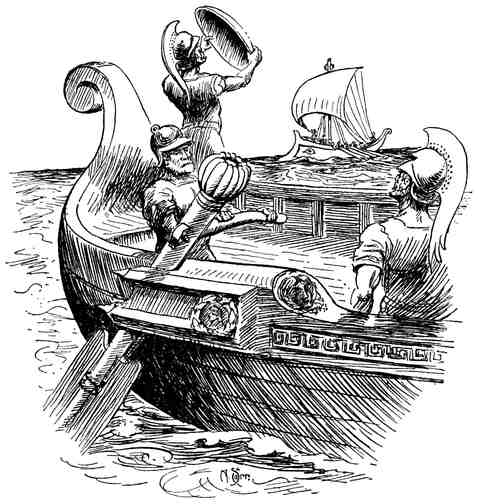
In battle a national flag was used so as to facilitate recognition of one’s own vessels from those of the49 enemy. And, as illustrative of the development of the early naval tactics, it is well to notice that there existed a signalling code—the displaying of a purple flag, for instance, being the signal for going into action. Mr. Torr mentions the interesting fact that attempts were made at semaphoring with a single flag, and further at signalling by flashing the sunlight from a shield. In addition to the above, signals were made for getting50 under way, for altering the formation of the fleet, for bringing-to, as well as for disembarking troops.
Their seamanship was necessarily simple, because their ships had no complicated gear and were primarily rowing craft. We know that they used the sounding lead armed with grease, and the numerous landmarks of the Ægean Sea and the neighbouring waters would be more than well known to those in command of the ships sailing. When one thinks of the bare simplicity of the Mediterranean galley, the fighting ship of Tudor times with all its sails and rigging and running gear points to a far more elaborate species of seamanship with a corresponding increase of anxiety. As to the division in supervising the ship’s work, the officers consisted as follows: The captain of the trireme—called trierarchos—was in supreme command of his ship. Under him came the kubernetes or helmsman. Then forward stood the officer in command of the bow—the proreus or look-out man. Under these three officers the ship was manœuvred in such a manner that either the enemy’s hull might be pierced or, at any rate, his protruding lines of oars smashed into splinters, thus rendering him an easy prey.
For the most part the representations of ancient classical ships have been so carefully made that they have every appearance of accuracy, taking into consideration the possibilities of wind, sails, and sea, but occasionally mistakes are made which show that the artist certainly was not a seaman. In the accompanying illustration9 we have an instructive picture of a penteconter. She sets two sails with a bowline shown on the mizzen, but interesting as the picture is in many ways, yet the sails are clearly not set in accordance with the wind. The steering oar at the side and the51 flag on the staff at the bows will be immediately noticed.

Greek Penteconter from an Ancient Vase.
That the artist was not a seaman is obvious from the ludicrous way in which the sails are depicted.
To sum up, then, the Greek seamen evolved their ships as follows: Like the Egyptians and Phœnicians before them, they began with a penteconter, which means that each man pulled an oar and that there was but one tier of twenty-five on either side of the ship. Next, inasmuch as they wanted increased power and speed—possibly because the ships were being built more strongly and thus needed more vehemently to be rammed—so they had to increase the number of their oarsmen and to lengthen their ship. This involved a risk of hogging, so the hull was engirdled; or when that was dispensed with a deck was added to join forecastle and poop, and gave facilities for a second tier of rowers. In the next step we get the introduction of triremes, quadriremes, and quinquiremes, which multiplied the number of men rowing from each bench, but placed all the men on one bench pulling their oars through the same porthole. After this come the monstrosities of the powerful Egyptian, Sicilian, and other kings, in whose ships each oar was probably pulled by any number of men from six to forty. But luxury certainly came afloat at no late date. Professor Flinders Petrie calls attention10 to the extraordinary analogy between the work of the Mykenæans and that of the Egyptians in the grandly52 embroidered squaresails painted in the frescoes at Mykenæ. Certainly as far back as 232 B.C. there were mosaics to be seen on the magnificent ship of Hiero II of Syracuse.11
Not less interesting were the ships and ways of ancient Rhodes, which in like manner had its dieres, trieres, tetreres, penteres, even up to seven- and nine-fold ships. In addition to these they had a swift type of their own invention, having one bank of oars, called celoces. They were wont, also, to use another fast type of craft called triemioliæ, which had no fighting deck stretching from end to end. The usual Rhodian naval tactics consisted in endeavouring to run through the enemy’s line and break the oars of his ships as they passed. Afterwards the Rhodians would then turn and ram them at the stern or else on the beam, always carrying away something that was essential for working the ship unless they could sink her forthwith.
They were very fond of one device in particular. When they were positively compelled to ram stem to stem they used to make provision by depressing their own bows as deep as possible in the water, so that while the enemy’s ram struck them high above the water-line, the Rhodian teeth holed the other ship well below the water. After the impact was over and the two ships fell apart the enemy was in a sinking condition, whereas the Rhodian could, by removing his ballast and some of his men aft, elevate his bows well above the water-line. But just as was discovered in modern ironclads fitted with rams, it was found that the rammer often came off as grievously as the rammed. At the battle of Chios in 201 B.C. one galley left her ram in the enemy’s ship, promptly filled and sank. At the battle of Myonnesos in 190 B.C., when a Rhodian ship was ramming an enemy the anchor of the former caught in the latter.53 The Rhodian ship endeavoured to go astern to clear herself, but as she did so the cable got foul of her oars so that she was incapacitated and captured. During this same battle the Rhodians affixed braziers of fire which hung over the bows. In trying to avoid these, the Syrian ships exposed their broadsides to the Rhodian rams, so that it became a choice of two evils.
The Rhodians were fine, able seamen, and well they needed to be. But even with the smart handling of their fast little craft they had all their work cut out to keep off the embarrassing attentions of the Cretan pirates during the second century B.C. On the biggest of their galleys the Rhodians erected deckhouses with portholes for their powerful catapults and archers. The custom of employing fireships, which remained in vogue for many centuries down to the time of the Armada and after, was already being employed by about the year 300 B.C. The Rhodians, too, had their proper organisation in naval matters as distinct from any desultory measures. In the port of Rhodes they had their dockyards, which were kept up at a great cost. And there is something curiously modern in the stringent regulations kept for preserving the dockyard secrets. Any unauthorised person who intruded into certain parts thereof was punished with death. And this strict rule was not peculiar to Rhodes, but obtained at Carthage and elsewhere. In order to protect their harbours against the assaults of the enemy, booms were laid across the entrances, and engines were mounted on merchant ships moored near the harbour-mouth.
The Rhodians were great shipbuilders, and in their sheds was kept many a craft ready to put to sea. But as Britain to-day builds warships for nations other than herself, so it was with Rhodes, and to this end54 she used to have brought to her immense quantities of timber, iron, lead, pitch, tar, resin, hemp, hair (for caulking), and sailcloth. Even human hair was employed in the service of the ship, and at the time of need the ladies of Rhodes, Carthage, and Massilia cut off their tresses and yielded it up for the making of ropes. The Rhodian squadrons were usually of three ships or multiples of three, and every year a squadron went forth for its sea experiences. The trieres, which carried as many as two hundred men, each voyaged as far as the Atlantic. Fine swimmers, fine seamen, their sea prowess was the cause of the greatest admiration on the part of the Greeks. “It was a proverb,” says Mr. Torr in his “Rhodes in Ancient Times,”12 “that ten Rhodians were worth ten ships,” and we must attribute their natural instinct and acquired skill for marine matters to that fortunate accident of being an island nation—a circumstance which has always, in all parts of the globe, meant so much to the progress and independence of a nation. Furthermore, the port of Rhodes was an important point on the line of commerce, and this fact also must be taken into account in reckoning up the influences at work for encouraging the marine arts, especially in inculcating an interest and admiration for the things of the sea. For those great merchant ships which used to sail to Egypt and come back to Greece laden with corn were accustomed to make Rhodes their port of call, and we cannot doubt that the sojourn of these big vessels with their impressive bulk and remarkable spars would make a powerful appeal to the imagination of the local sailormen and shipwrights always on the look-out for new ideas. Then, too, they had their own overseas trade, for large quantities of wine were exported from Rhodes to both Egypt and Sicily. Even by the third century B.C. the Rhodians55 were strong both as a naval and commercial nation. Their maritime laws were so excellent that they were afterwards adopted by Rome, and even to-day much of the world’s best sea law can be traced back to the people of that Mediterranean island.
56
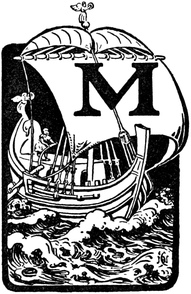
Marine development under the Romans was largely influenced by Greek precedent and practice, but there were points of difference.
The transportation of goods across the seas was conducted by shipowners, who formed themselves into corporations under the style of navicularii marini, but from the middle of November to the middle of March navigation was suspended until the finer weather returned. Under the Republic these shipmen worked for the companies of publicani, but Augustus abolished these financial companies, appointing in their stead superintendents who dealt direct with the owners of ships. The latter were regarded as anything but unimportant. On them the victualling of the capital largely depended, and the early emperors granted them, as owners of important merchant vessels, special privileges; but this was conditional on their ships possessing a capacity of 10,000 modii, and on their carrying corn to Rome for the period of six years. Though they were not in the permanent employ of the State, yet they were liberally rewarded for their services. In the corporations of the navicularii marini there was no clear distinction between the shipowner who worked “on his own” and those engaged in working for the State.
57 From the time of Diocletian, however, the navicularii were all servants of the State, and it was their duty to transport cargoes of corn, oil, wood, and bullion from the provinces to Rome or Constantinople. In their ships the Imperial post was carried. They received a fixed percentage and were responsible to the State for the goods placed in their holds. Membership of these corporations was handed down from father to son. They were allowed to engage in private trade and enjoyed the additional privilege of passing their cargoes duty free through the Customs. Similarly, additional to the overseas traffic, the internal navigation was organised by corporations of merchants and barge-owners. For example, the State employed them to handle the consignments of corn from Egypt on the Nile, Tiber, and the rivers and lakes of Northern Italy, Spain, Gaul, and Germany. So, too, the Rhone and Saône were navigated by them.
The reader is aware that we have had necessity to refer more than once to the corn-ships from Egypt, and in an age that was given up rather to the development of the fighting galley than to the exploiting of the cargo ship these trans-Mediterranean grain-carriers stand out prominently as a class by themselves. It is most unlikely that they altered much during a space of several hundred years, when even that much-petted craft, the galley, remained so little modified. Therefore the following account which has been left to us by Lucian may be regarded not merely as representative of the corn-ship in his immediate period, but as characteristic of the ship for probably five hundred years at least. Lucian lived in the second century, and was born probably about A.D. 120. In the dialogue from which the following extract is taken he taunts his friend Timolaus with being ever fond of a fine spectacle; to which the latter replies that he had had nothing58 to do, and being told of “this monster vessel of extraordinary proportions putting in at the Piræus,” he goes on to explain that “she is one of the Egyptian corn-ships and bound for Italy.”
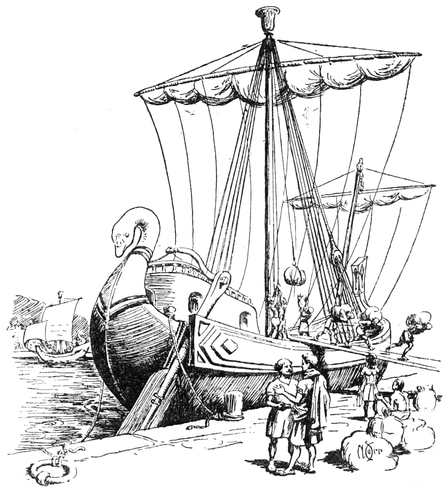
Keenly interested, they went on board her by the gangway, and he goes on to refer to the ship’s cabins, which he examined, to the shipwright who conducted them round the ship, calls attention to the lofty mast, stares in amazement at the sailors “as they mounted by the ropes, and then with perfect safety ran along59 the yards holding on to the halyards.” A hundred and thirty feet long she measured, with 30-feet beam, whilst from deck to bottom of hold she was 29 feet at her deepest part.
“What a mast she has!” exclaims Samippus, one of the friends; “and how huge a yard she carries, and what a stay it requires to hold it up in its place! With what a gentle curve her stern rises, finished with a goose-neck all of gold! At the other end, in just proportion, the prow stands up, lengthening itself out as it gets forward, and showing the ship’s name, the Goddess Isis, on either side.... The decorations and the flame-coloured foresail, and beyond these the anchor with the windlass and capstan, and I must not omit the stern cabins. Then the number of souls would make one think it was a camp. We were told it carried enough corn to feed all the people of Athens for a year. And all we saw had so far been carried safe and sound by a little old man, using a slight tiller to turn that huge rudder. They showed him to me—a bald-pated fellow with a fringe of curly hair. Hero, I think, by name.”
Then Timolaus still further enriches the narrative:
“The passenger told me of his marvellous seamanship; in all seafaring matters he out-Proteused Proteus in skill. Did you hear how he brought his ship home, and all they went through on the voyage, or how the star guided them to safety?” Lucian answers that he has not heard, so Timolaus goes on to inform him.
“The captain told it me all himself—an honest fellow, and good company. Seven days after leaving the Pharos they sighted Cape Acamas without meeting with any very severe weather. Then the west wind proving contrary, they were swept across as far as Sidon; and after Sidon they fell in with a heavy gale; and on the tenth day came to the Chelidonian Islands, passing through the channel, where they had a narrow escape60 of going down, every man of them. I know what that is, for I once passed the Chelidonians myself, and remember how high the sea runs there, especially when the wind is in the south-west and backing south. For the result of this is that the Pamphylian Gulf is cut in two by the Lycian Sea, and the wave is split up by endless cross currents at the promontory, the rocks there being sheer and worn sharp by the wash of water, so that the surf becomes really formidable and the roar overpowering, and, indeed, the wave (not infrequently) is full as large as the rock it strikes. This, the captain said, was what they were surprised by in the midst of night and literal darkness; but, he added, the gods were moved with pity at their cries, and revealed to them from the Lycian coast the light of a fire, so that they knew where they were; and at the same time a bright star, one of the Twins, took his place at the masthead, guiding the ship to the left towards the open sea, just as it was bearing down on the rock. After that, having once fallen off from their true course, they at length succeeded in crossing the Ægean, and beating up in the teeth of the Etesian winds, only yesterday, seventy days out from Egypt, put in at the Piræus. They had so long been off their course in the lower seas that they missed doing what they should have done, keeping Crete on the right and steering past Malea. Otherwise they would have been in Italy by this time.”
Further on in the course of the conversation, Adeimantus, one of the friends, mentions that after stopping to measure the thickness of the anchor, “though I had seen everything, I must needs stop to ask one of the sailors what was the average return to the owner from the ship’s cargo.” “Twelve Attic talents,” he replied, “is the lowest figure, if you like to reckon it that way.”13
61 I make no apology for giving so full a quotation, for there is in the narrative something so sincere and yet so curiously modern: the whole picture is so full of sparkling bits of colour that it is most pleasing, and we can almost see this mammoth ship with her hefty spars and beautiful curves and “flame-coloured” sails. The intervening space of nearly two thousand years seems to have made but little difference in the type of skippers. I am sure that to many a sailing man to-day the delightful little sketch of the captain of the Goddess Isis corn-carrier as “the little old man,” “a bald-pated fellow with a fringe of curly hair” sitting at his tiller, will at once suggest the very counterpart in the style and appearance of the skipper of a corn-barge—“an honest fellow, and good company.” And the account of the bad weather encountered successfully, the use of stellar navigation, the good seamanship employed, and the proof of the corn-ship’s seaworthiness are all too interesting to be lightly dispensed with. In the present days of accurate charts, ingenious nautical instruments, and big, sound ships, one is a little too apt to imagine that the ships and the ability of their crews in ancient times were scarcely worthy of serious consideration—deserving of little more than ridicule. So many ill-informed artists, who have drawn on their imagination in the past to depict what they believed to be the ships of olden times, have been shown to be wrong and misleading, that there has been such a reaction as to make it difficult to obtain any definite legitimate picture in one’s mind. It is just such accounts written by contemporaries as that of the Goddess Isis that enable us once more to see the ships of the past in their true likeness and proportions.
But we must return to the warships. Prior to the time of Augustus there was no fleet in being. Ships were built or fitted out at the approach of war—a principle62 that the whole maritime history of the world has always shown to be the most unmitigated naval heresy. But by the year 337 B.C. there were certainly docks at Rome—the word used is navalia—so at least there was some provision made for the accommodation of ships. Knowing what we do of the Romans as magnificent organisers and soldiers ashore, we are not surprised to find that the same spirit was manifested in arranging the commands afloat. The general command at sea was vested in the two consuls. Later on there were appointed two fleet-masters under the designation, “duoviri navales classis ornandæ reficiendæque causa.” There was thus a double squadron consisting usually of twenty ships, ten being under each duumvir. The coming of the Punic War had this effect, however, that it caused Rome to think more seriously of her ships and to become in fact a great naval power. In 260 B.C. there were built 100 quinquiremes and 20 triremes; with these the Romans defeated the Carthaginian fleet of 130 at Mylæ. The method employed was that which thereafter was to be practised for so many centuries down the history of naval fights; that is to say, the device consisted in boarding each other and engaging in hand-to-hand encounter. In the present instance a boarding bridge was held up against the mast by means of ropes and pulleys and let down promptly on to the enemy’s deck for the troops of the Roman ships to rush furiously across. The Greek word for this boarding bridge was korax, the derivative meaning of which was a raven-like beak for grappling. The Latin word was corvus. So powerful had the Romans become at sea that they also defeated with 330 ships the Carthaginian fleet of 350 at Ecnomus. Did a violent storm engulf two or three hundred Roman ships? Then they set to work forthwith to build as many and more by the aid of voluntary effort. She had such extensive resources63 to fall back on that she was destined to win not exclusively by good seamanship and tactics, but by weight of numbers. The boarding bridges just mentioned had been found of the greatest value, and yet prior to their invention boarding tactics had yet been employed. As far back as 413 B.C. (when they used them against the Syracusans) grapnels had been in use for hitching on to the enemy and then pouring slaughter and death into him.
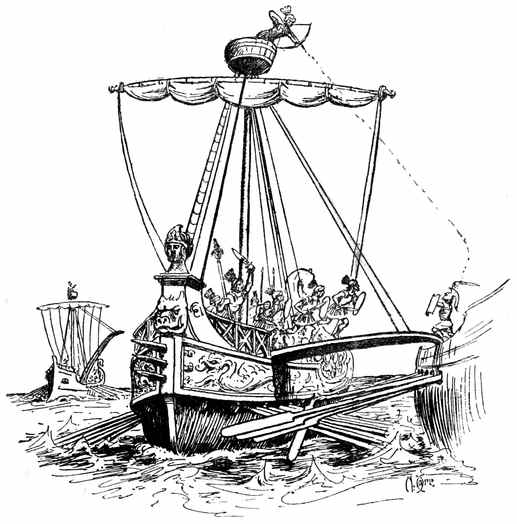
64 During the second Punic War, Rome had appreciated the value of retaining permanent squadrons with the same commanders. Thus one squadron was based on Tarraco, another—that of Sicily—on Lilybæum. The Adriatic squadron was based on Brundisium. These three squadrons provided a fleet of about two hundred ships. But when war was threatening, new quinquiremes were built and the old ones were refitted. But this excellent system of having a standing navy was subsequently abolished and Rome’s general sea-command disappeared.
During the first Punic War the fleet was commanded by one or both consuls in person. Then the separate squadrons were commanded by prætors or proprætors, though later on by proconsuls or consuls who sometimes deputed the command to a præfectus. The crews consisted of three sections—the oarsmen, the sailors, and the marines, designated respectively remiges, nautæ, and milites classici. It is important to bear in mind that no Roman ever handled an oar, but that the rowers and sailors were supplied from the allies and maritime colonies. This is evidence of the fact that, unlike the Phœnicians or the Vikings, the Romans were not instinctively seamen, but only took to the ocean because it was essential for their safety on shore.
The expression socii navales became the stereotyped phrase for the crew of oarsmen and sailors. Later on—in the third century B.C.—libertini were to a great extent employed in the crews. Slaves were used during the Hannibalian War as oarsmen, and sometimes the ships were manned by prisoners. When it was necessary, the crews were sometimes armed and used as soldiers. But the Roman naval service was never popular, and consequently there were many desertions. The captain of each galley was designated magister navis. He and the steersman (gubernator) were ingenui, the65 steersman ranking with a centurion. The marines were drawn usually from the Roman proletariat, and there was an arrangement of some sort for the distribution of prize-money. Additional to the triremes, quadriremes, and quinquiremes, there were also scouts—lembi, which were but light craft—and pentekontors.
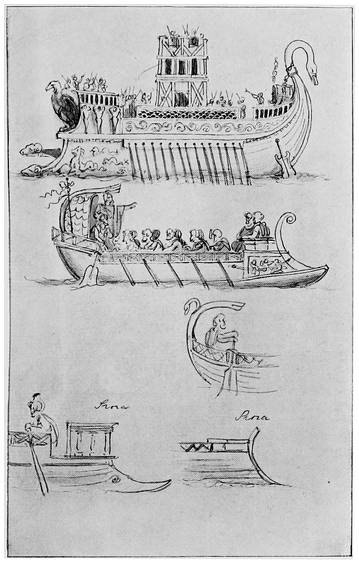
Sketches of Ancient Ships.
By Richard Cook, R.A., from Montfarreon’s “Antiquities,” showing warships with marines and fighting-platform amidships; the lower sketches show clearly the types of bow and stern.
Great importance was clearly attached to the quinquiremes, for in such craft envoys, commissioners, or messengers of victory were carried. They fought together with the triremes and quadriremes as the capital ships of the Roman navy, and whilst the State depended on the treaty towns and allies for their lighter craft, yet the all-important quinquiremes were kept under immediate control. The description and arrangement of the different kinds of Greek warships is generally applicable to those of the Romans. On the deck of the galley the troops fought, while below them were the oarsmen. These propugnatores were protected by means of bulwarks (propugnacula) as well as by two wooden towers (turres), carried on supports which could be taken down from the ship whenever required.

Among the Greeks it was customary to divide ships into kataphraktoi and aphraktoi, according as to whether they were decked in or otherwise. The corresponding Latin expressions were navis tecta or navis aperta66 respectively. The quinquireme, however, was always cataphract; that is to say, the planking did not end at the gunwale, but was continued to the upper deck so as to afford protection to the rowers from missiles. As to the dimensions and tonnage of the quinquireme it is impossible to make any statement, but they were of such a size that, with some difficulty, they could be hauled up on shore at night.
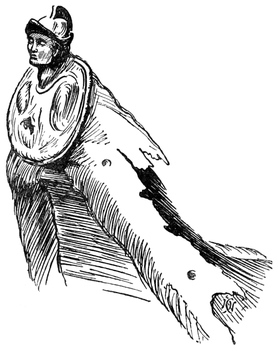
Bronze Figurehead of Minerva from a Roman Ship found in the sea off Actium.
(Probably belonging to one of the ships which fought in the battle of Actium, B.C. 31.)
Augustus realised that a Roman fleet in being was essential to police the seas and keep down piracy so as to ensure the safe passage of Rome’s corn supply from Egypt. The two fleets which he based permanently on Misenum and Ravenna respectively to guard the Western and Eastern seas were of the utmost utility. He even went so far as to connect Ravenna with the Po by means of a canal. Manned with crews and captains who were either slaves or freedmen, the ships were unfortunately allowed to rot and the service to fall into desuetude, and about A.D. 6 piracy was again rampant, so that it required once more to be checked.
During the first century B.C. two new types of warships appeared in the bireme and the liburnian. The latter was really a lightly built trireme, and originally was a swift lembos with a ram attached. The Romans built liburnians also as biremes, which they employed for scouting and fighting. The name was derived from the Liburnians of Dalmatia, from whom the shape of67 the hull was borrowed; but later on the expression came to denote simply a ship of war. Just before the dawn of the Christian era the Romans began to build those bigger and stouter ships, mounting heavy catapults, which were probably not very different from the tall ships which the Crusaders had to contend with some hundreds of years later.
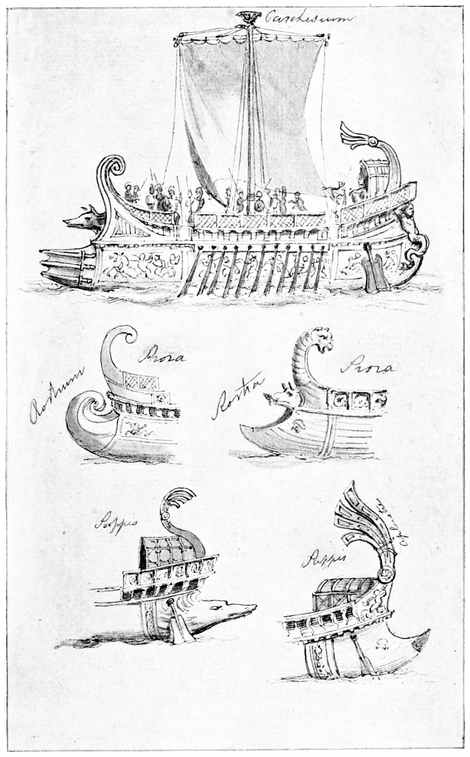
Sketches of Ancient Ships.
By Richard Cook, R.A., from Montfarreon’s “Antiquities,” showing Roman Warship under sail; the lower sketches well illustrate species of stems and sterns.
Before the close of the second century A.D. there were afloat not only the Italian fleets, but also those of the Roman provinces. There was the Egyptian fleet based on Alexandria, the Syrian fleet, the Libyan fleet, the Euxine fleet, besides two fleets on the Danube and the Rhine. Furthermore, there must not be omitted the Romano-British fleet—the Classis Britannica—which was based on Boulogne (Gesoriacum), with stations at Dover, Lympne, and Gloucester. This dated from the invasion by Claudius and assisted Agricola in his Scottish expedition in A.D. 83. It circumnavigated Britain, discovered for the Romans the Orkneys, and saw the long line of the outer Hebrides. The classiarii also on shore helped to build Hadrian’s wall. But as to the exact nature of such ships we shall speak in greater detail presently.
Each of the fleets just mentioned was commanded by a præfectus and had also a sub-præfectus. The Egyptian fleet-præfect was sometimes also præfect of the Nile revenue boats. Each ship was commanded by a trierarch, the classiarii being organised as a century under a centurio-classicus, or fleet-centurion. Thus whenever the men had to be put on shore for duty their organisation went with them. The term of service for the classiarii was twenty-five or twenty-six years. The Roman fleets illustrated at an early date in the world’s history what every nation has since been compelled to realise: that a standing navy cannot be dispensed with among the essential attributes of peace and self-defence.68 Rome’s fleets kept off Carthage and Philip and enabled Rome to be mistress of the sea route between Hannibal and Spain; and, as is usually the case, the decadence of the Government was promptly followed by the decadence of the fleet.
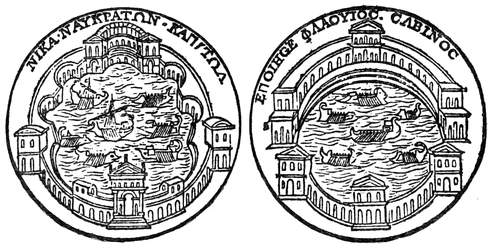
Two Coins depicting “Naumachiæ.”
(From Scheffer’s “De Militia Navali.”)
The influence of the Roman navy on land was seen in a manner similar to that in which the Roman army influenced gladiatorial combats. In Rome there were various “naumachiæ,” which were great reservoirs surrounded by seats like an amphitheatre and were specially constructed for holding naval fights. There was one, for instance,14 built by Augustus on the trans-tiberine side of the river, and traces of this naumachia were discovered not many years ago. A naumachia consisted of an enormous tank or lake excavated in the ground, and measured 1800 feet long by 1200 feet wide. Within this ample area naval battles containing thirty beaked ships with three or four tiers of oars, together with many other smaller ships were engaged, and no fewer than three thousand fighting men, to say nothing of the rowers, were engaged. It is interesting to add69 that naval fights were also held in a gigantic reservoir on the site now occupied by the Colosseum.
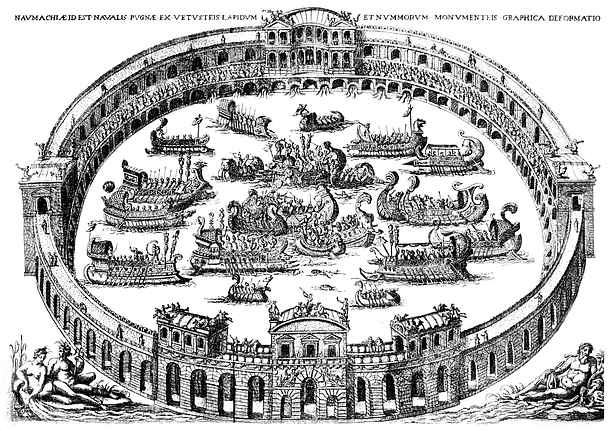
Representation of a Roman Naumachia.
(See text.)
No consideration of the relation of Rome to the sea can be complete without taking into consideration those important and daring adventures which Julius Cæsar attempted. Adventures they certainly were, for here was a land general trying experiments which belonged rightly to sailormen; and, as was the inevitable result, he made terrible mistakes as he blundered through towards victory. His expedition against the Veneti, “the stoutest and the most skilful seamen in Gaul,” taught him much: taught him that he was matched to play a game whose tricks he did not understand. But the praise belongs to him, a landsman, for his ingenuity and resource in toiling with such signal success against very heavy odds. He recognised quickly that the ships of the Veneti and their allies were so heavy that no Roman galley with its cruel rams could have any appreciable effect on them. They were too high out of the water, too, to enable the legionaries to hurl their missiles with any telling effect. It has been suggested that the design of these powerful Biscayan craft had originally been borrowed from the great Carthaginian merchantmen, “whose commerce in British waters they had inherited, and their prosperity depended upon the carrying trade with Britain, of which they possessed the monopoly.”15
It was Cæsar’s opportunity to rise to the occasion, and he availed himself of the chance. Sending instructions to his officers to have a fleet built in the ports at the mouth of the Loire, he also raised oarsmen from the province and collected as many local pilots and seamen as possible. Thus, when the time came, the Roman fleet included ships impressed from the maritime tribes between the Loire and Garonne. The Roman70 engineers also came to the rescue, and, taking long poles, they armed them at one end with sharp-edged hooks. There was just one feature in which the galleys surpassed the stout ships of the enemy: they were far more mobile. So, when the rival fleets approached, two or more galleys ran alongside the Biscayan craft, thrust out the sharp hooks, caught the halyards, rowed hard away, with the result that the ropes snapped, the yard and sail came tumbling down on to the deck below and enveloped the crew. Springing smartly from the galleys on to this confused crowd, the enemy was soon slaughtered and the ship captured. In principle, though not in detail, the tactic was similar to that used in comparatively modern times when sailing men-of-war aimed to blow away the enemy’s rigging, leaving him so much out of control that complete annihilation was a matter only of time.
But far more interesting than his expedition against the Veneti was Cæsar’s invasion of England. Regarded merely as a naval exploit, it is deserving of great attention; but to those who have had any experience of winds, waves, and tides it is most instructive. Picture Cæsar, therefore, in the summer of 55 B.C. at Gesoriacum, better known to the reader under its modern name of Boulogne. Here was a port that was important in even those early days. From this spot the merchants of Gaul were wont to embark their cargoes and carry them across the Channel to the shores of Kent, and later on it was destined to become one of the naval stations for the Classis Britannica. Think of it in the year we are speaking of as a busy place, lined with shipyards along its banks and many craft in its haven. From the forest above could be hewn and floated down the trees for the making of ships. Every mariner to-day knows that when the heavy north-east gales make it impossible for the cross-Channel packet-steamers to7172 enter Calais, Boulogne can be entered with safety by even sailing craft.
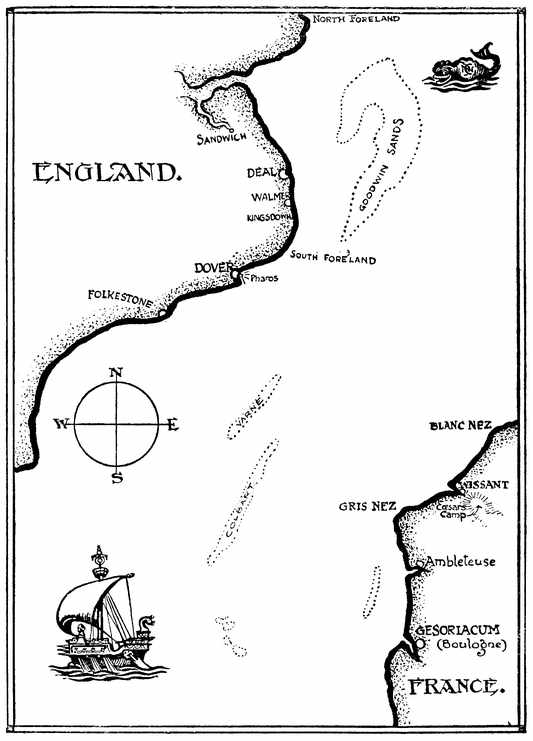
But inasmuch as the prevailing wind along the English Channel is from the south-west, the reader will observe on consulting a chart that the position of Boulogne for the Gallic traders bound for Dover or the Thames was singularly well placed, inasmuch as it gave the mariner a fair wind outward-bound on most occasions. That fact was doubtless appreciated by Cæsar when he elected to use this port as his starting-place for Britain. He therefore gave orders that his fleet was here to be got in readiness, and then sent forth Volusenus in a galley to reconnoitre the British coast. The ship was a Roman galley manned by oarsmen who had been trained by years of work for the task, and with such a craft as this Volusenus could be independent of wind and accomplish his task with the utmost dispatch. He was away cruising about the English Channel for a period of three days, during which time he had doubtless been able to locate a suitable place where his master’s troops could be disembarked. He had had the opportunity of taking soundings, and—perhaps most important of all to one accustomed almost exclusively to the Mediterranean—of noticing both the range of tide and the force and direction of the strong tidal streams. Similarly, he was able to make a note of the cliffs of Dover and other landmarks. With this knowledge he returned to place himself at Cæsar’s disposal.
On August 25, then, the transports came out from Boulogne. The time was midnight, it wanted five days to full moon, and high water that evening was at 6 p.m., so that the tides were neaps, or at their weakest. We can be quite sure that, acting on the experience of Volusenus in the Channel, it was deliberately intended to avoid spring tides. (It is high water at Boulogne at new and full moon at 11.28.) The transports thus73 came out of the haven with the last drain of the ebb. But in the offing the tide that night did not make to the eastward till 4 a.m., so there would be the Channel ebb to contend against for some time.
So far all had been splendidly arranged, so that by the time the flood or east-going tide had begun the fleet would all have got clear of the harbour and the oarsmen have been getting into their stride for the passage. Gris Nez and the French cliffs were left behind as the hulls ploughed their way through the heaving sea and sped onwards. But it was not to be a quick passage. The tide, of course, turned against them before they were across, and those transports would not easily be impelled through the waves; but at nine the next morning the oar-propelled galleys which had got ahead during the night approached the cliffs of Dover. Far behind followed the sail-driven transports, so Cæsar let go anchor in Dover Bay, summoned a council of his generals and tribunes, gave them instructions as to the landing-place, told them how to handle both ships and men in disembarking, and then between three and four o’clock that same afternoon the bulky transports wallowed up to join the galleys. Between four and five p.m. the Channel stream off Dover turned to the eastward, and as the wind was favourable Cæsar gave the signal to weigh anchor. Presently the galleys, transports, and the smaller craft were stretched out running past the Foreland with wind and tide to help them. It did not take them long to skirt past St. Margaret’s Bay, and at some point between Walmer and Deal the transports were beached and the journey accomplished. Thus, with careful foresight, Cæsar had got safely across the Channel with his troops and fleet.
These transports had carried his infantry; now the cavalry were starting not from Boulogne, but from Ambleteuse, which is about midway between Boulogne74 and Cape Gris Nez, and slightly nearer to Dover. Not till August 30 were these descried approaching the British coast. A gale from the north-east sprang up and prevented them from keeping their course, so that some were carried back to Ambleteuse, while others were swept to the westward down Channel. Some anchored for a time, but the north-east wind gave them a lee shore, and they had to put out to sea and make for the Continent. Some scudded past the gale beyond the South Foreland and the high cliffs of Dover, risking disaster every minute. Those which had hauled with the wind abeam over to the Gallic coast managed to heave-to on the port tack, and drifting past Cape Gris Nez, were in fairly sheltered water, so that they could carry on and make port. This they did, and re-entered Ambleteuse without the loss of either a ship or a man. Such a fact proves at once that Cæsar had been able to get together from somewhere a number of men who were not novices, but very fine seamen. We must concede that the Gallic sailors knew their business, at any rate.
Cæsar and his men had already landed near Deal. They had left their galleys and the infantry transports, and gone inland before this had happened. The galleys, as was the Mediterranean custom for centuries, had been hauled up above the mark for ordinary high water; the transports, because of their weight and size, had been left at anchor. Now Cæsar, in spite of what he had gathered regarding tides, had evidently omitted to bear in mind the fact that at full moon or new moon—“springs”—the rise of the tide is greater than at neaps. Neither he nor his officers knew the connection between tides and moon, and there is a difference of several feet on that coast between high-water springs and high-water neaps. It was full moon, and every seafaring man knows that when a gale does occur75 at that time it is worse than when the moon is not at full or change. High water was somewhere about 11 p.m. Wind and tide rose in great strength on to this lee shore, so that the galleys which had been hauled up were dashed to pieces, while transports broke from their anchors and drove on to the beach.
We have no concern with any operations on land; it is enough for our purpose to add that after spending some time in making repairs to those ships which remained, Cæsar took his ships and men back to Boulogne. The expedition had proved a failure. But in the following year Cæsar again invaded Britain. This time he set forth neither from Boulogne nor Ambleteuse, but from Wissant, which is about midway between the chalk cliffs of Cape Blanc Nez and the sandstone cliffs of Cape Gris Nez, and on the charts of to-day you will still find “Cæsar’s Camp” marked. Wissant was much nearer to the British coast than either of the other two ports, and the Roman evidently was not anxious to make the cross-Channel passage any longer than need be this time. The fleet at Boulogne had been weather-bound for three weeks with a series of north-west winds. Anyone who has sailed along this portion of the French coast knows what a nasty sea a wind from that direction sets up, blowing as it does directly on shore. A north-west wind would have sent a strong swell into Boulogne harbour; but apart from that, even had the ships been at Wissant ready to start it would not have been of much avail, for the course from there to the nearest British shore was about north-west—a dead “nose-ender.” June, therefore, came and went.
But about July 6, Cæsar set sail from Wissant about sunset. As the wind was light from the south-west he had a favourable air. There was no moon, but the nights are warm and not very dark at the beginning of July. The tide probably set him down some distance in the76 vicinity of Gris Nez, for it did not begin to flow to the north-east till 10 p.m. Good progress was made this time, and by midnight the leading division was getting well up to the South Foreland. The wind, as it so often does on a July night, began to fail and finally dropped utterly, so that the fleet had barely steerage way. The strong Channel flood took hold of them, and about 3.15 a.m. Cæsar was abreast of Kingsdown (a little to the south of Walmer). Eventually he arrived at Sandwich about noon, having no doubt anchored for six hours, since the Channel tide was just about to run to the south-west when he had got to Kingsdown. This time he left his 600 ships not hauled up on the beach, but at anchor, having disembarked his troops. Yet once more a storm rose which caused some of the vessels to part their anchors, others to collide with each other, and others still to be dashed ashore and damaged. Forty were totally destroyed, but the remainder he managed to patch well enough. They were hauled ashore, probably by means of windlasses or capstans, greased rollers being inserted under the keels. They were then surrounded by earthworks so as to be protected efficiently. About the middle of September and about nine o’clock at night, Cæsar and his fleet once more returned from Britain and arrived at Boulogne about daybreak.
He took back with him a great deal of invaluable information on the subject of tides, but the cost of obtaining such knowledge had been by no means small. It is possible that a critical reader may feel disposed to remark that the Channel tides in Cæsar’s time were not identical in direction and force with those of to-day. It is impossible to settle the point with accuracy. Certain it is that for some centuries the coast between Sandgate and Dover has altered a good deal, but, speaking generally, this has not been of much consequence, though a good deal of alteration has taken77 place between Hythe and Dungeness, which may or may not have affected the tidal stream. Similarly, it is a matter for dispute whether the Channel stream in the neighbourhood of the Dover Straits began to ebb and flow at precisely the same time as to-day. It is more than possible that the changes in the configuration of the coast and of the Goodwin Sands may, during the centuries, have modified the Channel tides hereabouts. Some say that in Cæsar’s time Thanet was an island, that Dungeness did not exist, that Romney Marsh was covered at high water by an estuary 50,000 acres in extent, and that the estuary of the Thames was far wider than to-day. But even when all these points have been taken into consideration, two facts remain true: that the tide ebbed and flowed backwards and forwards along the English Channel, and that because of the narrow neck through which this huge volume of water has to rush by the Straits of Dover there must have been not much difference in strength from that which is experienced to-day.
The geographical information which Cæsar brought back concerning Gaul and Britain after his campaigns cannot be lightly regarded. It was the knowledge which an explorer bestows on a wondering community. Such items as prevailing winds, tides, currents, the influence of moon and the nature of harbours along the coast, the depths of water, and so on, might have been appreciated still more had the Romans been as eager for scientific knowledge as they were for organisation and conquest.
But if the Romans were not great navigators nor even a race of seamen, at any rate they were very fine shipwrights. Expert opinion of to-day, arguing from the evidence of the only Roman craft which are still in existence, gives the highest praise to the art of the Roman shipbuilder. The relics of the craft found in78 Lake Nemi were discussed by me in another volume,16 and need be referred to now only slightly. But the other craft which was recently unearthed whilst excavations were being made in 1910 at Westminster, on the site for the new London County Council Hall, is far more instructive, because being above ground it is get-at-able and capable of intimate study. It now lies among the collection of the London Museum in Kensington Gardens. This craft was probably one of the fleet of Carausius, who for a time was admiral under Maximilian and Diocletian, but subsequently rebelled against the Imperial authority and proclaimed himself emperor of Britain in A.D. 287.
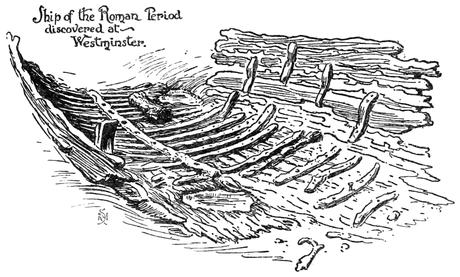
Ship of the Roman Period discovered at Westminster.
Sketch showing the Interior of Hull.
This boat was found lying on a shell sand which indicated the original bed of the Thames. The date is approximately fixed by the three coins which were found with the boat: one of Tetricus the Elder in Gaul (A.D. 268–273), the second of Carausius in Britain (A.D. 286–293), and the third of Alectus in Britain (A.D.79 293–296). It is possible that there was some ceremony in placing coins in a Roman boat, just as to-day coin of the realm is placed at the laying of a foundation-stone.
She was probably a single-decked war-galley, built in Gaul, but had been dismantled before being abandoned to sink in the waters of the Thames. One expert naval architect, who made a careful inspection of this relic when first discovered, has gone so far as to state that not only is the craftsmanship excellent, that probably nothing built in our own time would look so well after seventeen hundred years’ immersion, but that finer fitting could not be expected to-day. It shows, further, not merely good workmanship, but good design.
It is more than likely that this ship was built at Boulogne on one of the Roman shipyards there, and formed originally a unit in the Classis Britannica. There is a votive tablet preserved in the Boulogne Museum, and found in that neighbourhood, depicting two triremes with the stern steering oar, the beak at the bows, and the banks of oars, which shows how similar these Romano-British ships were to the Mediterranean model. The votive offering in question had been made by the crew of a trireme named the Radians. Possibly the Westminster ship was the flagship of Carausius.
Her timbers were found to have been cut with the grain, and every other one ran to the gunwale. A rubbing strake ran along outside the hull which took the thwart ends, the recesses for the same being still visible. It would appear as if the frames above turned outwards and formed a support for that gangway along which the soldiers were wont to fight. Some think there is evidence to show that the ship had a false keel, and that she carried a mast. As to the dimensions of the vessel, one authority, judging by the8081 run of the stringer, suggests that when she was whole she measured about 90 feet long by 18 feet beam. The material was oak; the treenails, which were perfectly made and fitted, measured 1¼ inches in diameter.17
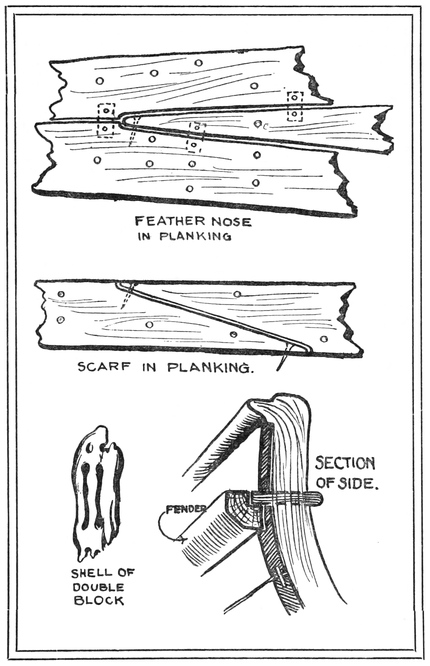
The two vessels buried at the bottom of Lake Nemi—from the fragments which have been brought to the surface—belong to the time of Caligula (A.D. 37), and equally demonstrate the first-class workmanship of the Romans. Of these two pleasure craft one measured 208 feet long by 65 feet beam, whilst the other was 227 feet by 80 feet. The planking was of white fir, and the frames were probably of oak. All the metal fastenings below the water-line were of bronze, but above water they were iron. The nail heads were cemented over and the planking canvased, and finally a lead sheathing was laid on with copper nails. It has been ascertained that the builders had been careful to cut out any faulty timber, and to fill up the space with sound material. The metal fastenings connecting the timbers and planking were put through, the points being laid over and turned back into the wood. The planking in the first of the Nemi wrecks was of two thicknesses of 1½-inch stuff. In the larger of the two, three thicknesses of planking were found to exist, the beams for the decks being found to be attached to the gunwale as in the method seen on the Westminster ship.
Even if we allow a great deal for the knowledge in shipbuilding which the Romans acquired from the Veneti and from Gallic shipbuilders, yet everything points to the fact that Italy knew how to build and how to fight ships to such perfection that we cannot but feel for them the keenest admiration. If they were not great explorers such as the Phœnicians, they accomplished82 a great deal in other spheres of the maritime art, and sometimes in the teeth of great obstacles.

Here and there Virgil gives us delightful little sea-cameos which show how keenly the ancients exulted in their ships, and raced them against each other past rock and cliff, through wind and spume. What, for example, could be more interesting than the account of the race of the four galleys in the fifth book of the Æneid? He gives you the names of the swift Pristis, the huge Chimæra, which with her triple arrangement of oars was so big that she seemed like a floating town, the Centaur, and the dark blue Scylla. He draws for you the picture of the captains standing at the sterns, the crew taking their seats at the oars and waiting in eager breathlessness for the trumpet to83 start them on their race. Almost you can see the strong arms being drawn up to the breast and thrust smartly away again. The blue Scylla wins, but it is a splendid struggle. The little touches of the ship which was “swifter than wind or flying arrow speeds towards land,” and of the disabled galley which moves slowly (like to a snake which has been run over), yet hoists her canvas and enters the harbour’s mouth “with full sails,” are pencilled in by a man who must have often watched a galley doing her work. He speaks of the lofty sterns which these galleys possessed, of Palinurus the pilot bidding his men to reef the sails at the gathering of a “dark storm of rain, bringing with it gloom and foul weather,” and gives orders to “labour at their strong oars, and sidewards turn the sails to meet the wind.” Evidently with the squall came a shift of wind, so that instead of being able to run with the breeze free, under sail power alone, they were now compelled to come on a wind, shorten canvas, and get out oars to prevent such shallow-draught vessels from drifting to leeward.
And in a later passage Æneas, after the sea has calmed down, “bids all the masts quickly to be raised, and on the sailyards the sails to be stretched. All at once veered the sheet, and loosened the bellying canvas to right, to left; at once they all turn up and down the tall ends of the sailyards; favouring breezes bear the fleet along. Foremost before them all, Palinurus led the close line; with an eye to him the rest were bid to direct their course. And now damp night had just reached the centre of its course in the heavens; the sailors, stretched on their hard seats beneath the oars, had relaxed their limbs in quiet repose.”
There is some indication in the Georgics of the manner in which the ancient seamen made use of stars and weatherology. “As carefully must the star of Arcturus,84 and the days of the Kids, and the bright Dragon be observed by us on land, as by those who, homewards bound across the stormy seas, venture to the Euxine and the straits of oyster-breeding Abydos.” ... “Hence we can learn coming changes of weather in the dubious sky, hence the days of harvest and the season of sowing, and when ’tis meet with oars to cut the faithless sea, when to launch our rigged fleets, and when at the proper time to fell the pine tree in the woods: nor will you be disappointed, if you watch the setting and rising of the heavenly signs, and observe the year fairly divided by four distinct seasons.” ... “Straightway, when winds arise, either the straits of the sea begin to swell with agitation, and a dry crash is heard on the high hills, or far in the distance the shores are filled with confused echoes, and the murmur of the woods thickens on the ear. The wave can but ill forbear to do a mischief to the crooked keels, even when gulls fly swiftly back from the high sea, sending their screams before them.... Oft too, when wind impends, you will see stars shoot headlong from the sky.... But when it lightens from the quarter of grim Boreas, and when the home of Eurus and Zephyrus thunders, then are the dykes filled and all the country is flooded, and every mariner out at sea furls his dripping sails.... The sun also, both when rising and when he hides himself beneath the waves, will give you signs; infallible signs attend the sun ... a blue colour announces rain, or fiery winds; but if the spots begin to be mixed with glowing red, then you will see all nature rage with wind and stormy rain together. On such a night let no one advise me to venture on the deep, or pluck my cable from its mooring on the shore.”
85
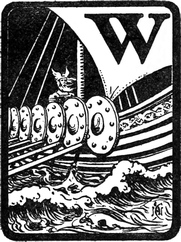
War has always been a great incentive to shipbuilding. But this statement requires modification by excluding both civil war and the merchant ship. Of the former, no better instance could be found than the disastrous Wars of the Roses. Of the latter, the manner in which the Romans and others developed the war-galley at the neglect of the merchant ship is a clear example.
The Vikings, too, were great warriors; hence the wonderful development of their ships was for hostile purposes. But, unlike the Romans, they were equally distinguished as maritime explorers. And it is with their methods on the sea that we are now about to deal. They were so vigorous in their activities, so dauntless and daring, such genuinely strenuous shipmen that they were bound to do great things, or fail where none could have succeeded. “They had neither compass nor astronomical instruments,” as Dr. Nansen reminds us, “nor any of the appliances of our time for finding their position at sea; they could only sail by the sun, moon, and stars, and it seems incomprehensible how for days and weeks, when these were invisible, they were able to find their course through fog and bad86 weather. But they found it, and the open craft of the Norwegian Vikings, with their square sails, fared north and west over the whole ocean, from Novaya Zemlya and Spitzbergen to Greenland, Baffin’s Bay, Newfoundland, and North America, and over these lands and seas the Norsemen extended their dominion. It was not till five hundred years later that the ships of other nations were to make their way to the same regions.”18
That being so, how did these men succeed in making such long passages? The lodestone or compass did not reach Norway until the thirteenth century. I think that before we attempt a more definite answer we should make a great allowance for that sea-sense which is partly inborn and partly obtained by the experience of long years. I remember once asking a man who had been skipper of a coaster, whose family had lived their lives on the sea or by it, whose brothers had gone down with their ships to the port whence there is no returning—how the captains of such craft managed. Had they any real knowledge of navigation? “No, sir,” my friend answered, “they’re all mostly self-reliant.” In other words, they have a rough knowledge of the problems, and the rest is instinct. Only the other day I was talking to yet another plain, seafaring man. I asked him how he and his mates managed to find their way in by night through a certain very tricky and unlighted channel that was full of dangers and scoured by a strong tide. It was the same answer. “They managed as best they could,” relied on their instinct, sometimes made mistakes and got picked up, but on the whole succeeded in getting through.
I suppose it was much the same with the Vikings. But with this exception: that, being unfettered by87 book-learning, they possessed the instinctive faculty more thoroughly. They knew the Scandinavian coast-line thoroughly well; and long coasting voyages had taught them the configuration of other nations’ shores. The rising and setting of the sun would assist them in clear weather, and the Pole-star at night. They were wont to carry in their ships a number of ravens, and when they were expecting soon to make a landfall and it was useless to climb the mast, they released these birds, which, flying high, spotted the distant shore and flew towards it. The Viking mariner could thus set his course to follow their direction of flight.
Of course, with such rough-and-ready methods they made egregious mistakes and sometimes found themselves sailing in exactly the opposite direction to that desired, like some amateur yachtsmen who have sailed through the night by the wind and not known that the wind had veered several points. Dr. Nansen gives as an instance of a Viking’s mistake that of Thorstein Ericson, who in starting from Greenland arrived off Iceland instead of America. And, be it added, there are plenty of well-found ships to-day, both sail and steam, which, in spite of all their sextants, their patent logs, and deep-sea sounding leads, have made landfalls miles off their course.
Their sense of time, too, was another instinct which few of us possess to-day. “Several accounts show,” says the same Scandinavian authority, “that on land the Scandinavians knew how to observe the sun accurately, in what quarter and at what time it set, how long the day or the night lasted at the summer or winter solstice, etc. From this they formed an idea of their northern latitude.” It is just possible that they may even have understood how to take primitive measurements of the sun’s altitude at noon with a88 species of quadrant. But it is not likely that during those long, early voyages they could have been able to take observations of this kind from their ships. Nor can they have understood how to reckon the latitude from such measurements except at the equinoxes and solstices.
From the narrative of a voyage north of Baffin’s Bay, about the year 1267, it appears that they endeavoured at sea to get an idea of the sun’s altitude by observing where the shadow of the gunwale, on the side nearest the sun, fell on a man lying athwartships when the sun was in the south. This shows, at any rate, that the Norsemen did at least observe the sun’s altitude. Even in thick weather they could get along satisfactorily provided that the wind did not shift and send them off their course. But if the breeze veered or backed a few points they would be heading unconsciously in the wrong direction.
The observations of birds were of no little assistance. If the haze hid the land off whose coasts they imagined themselves to be, they could observe the kind of bird which was flying around them. A flight of wild-fowl, a particular breed of sea-bird, the difference in the fauna, and so on, when off such coasts as Scotland, Ireland, Iceland, and Norway, could not fail to assist them greatly. It is true, also, that in their sailing directions they took notice of the whale. Thus, when sailing from Norway to Greenland one should keep at such a distance to the southward of Iceland as to have birds and whales from thence. Similarly, the drift-ice, icebergs, driftwood, floating seaweed, the colour of the sea were all separate units in the whole method which enabled them to perform what they did. The Gulf Stream water, being of a purer blue than the greenish-brown water of the coastal current, must also have assisted them in their long voyages. Like the ancient seamen of89 the Mediterranean, they relied largely on the sounding lead, and there is a record that Ingolf and Hjorleif found Iceland “by probing the waves with the lead.”
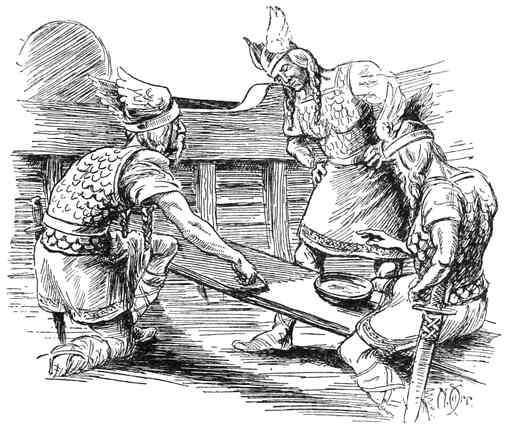
Primitive Navigation of the Vikings.
Finding the ship’s latitude by the shadow of the gunwale.
As to the primitive method, referred to above, for finding the ship’s latitude by observing the shadow of the gunwale, it has been suggested that they might have measured the length of the shadow of the gunwale by marks on the thwart, and determined when the boat lay on an even keel by means of a bowl of water. They could thus obtain a fairly trustworthy measurement of the sun’s altitude. It has been thought possible that the Norwegians might have become acquainted with90 the hour-glass either from their voyages to Southern Europe, or else by plundering the monasteries. This would enable them to measure the length of day approximately, and so, taken in conjunction with the sun, be able to tell fairly correctly the direction of the cardinal points of the compass.
There are some who scoff at the idea that the Vikings discovered North America. But there are first-rate authorities, among whom may be reckoned Dr. Nansen himself, who are quite convinced that these men did sail across the sea and land there. Certain incredulous people would have us believe that an open craft such as the Viking type would never last out a voyage like that across the Atlantic. But this supposition is immediately refuted by the Norse craft which was built on the lines and to the exact dimensions of the Gogstad Viking ship discovered in 1880. Rigged with a squaresail, with a jib added and without any other ship as convoy, this replica was sailed from Bergen to Newport, Rhode Island, in the year 1893. The voyage began on May 1, and the United States were reached on June 13. She was commanded by Captain Magnus Andersen, who had already, in 1886, crossed the Atlantic in an open boat. Although bad weather was encountered, yet Captain Andersen and his crew of eleven men reached Newport in safety. His ship proved that the Viking type made a very fine seaboat, and furthermore that she was fast even in the deep furrows of the ocean; for she did an average of nine knots easily, but when the seas fitted her exactly she could reel off her eleven knots.
For these old Vikings, intrepid mariners and pioneers of the sea, had by their skill and experience been able to develop an improved type of ship which combined the advantages of speed and seaworthiness. In such craft they voyaged to places as far apart as Palestine91 and Greenland. By their travels they completely changed the existing ideas of geography. When they ceased to make merely coasting voyages and took to the blue water, they were doing more than perhaps they realised. They crossed the North Sea to the Shetlands and Orkneys, to Britain and Ireland, to the Faroe Isles, to Iceland, to Greenland, and finally to America. Just exactly when first the Northmen crossed the North Sea cannot be determined; but some authorities believe that it was undertaken before the Viking age. As early as the third century of the Christian era, the Eruli sailed from Scandinavia over the seas of Western Europe and ravaged Gaul and Spain, and even penetrated during the fifth century to the Mediterranean as far as Italy. During the sixth century the Vikings voyaged from Denmark to the land of the Franks, but the first Viking expedition began in A.D. 793. In the year 999, Leif, the son of Eric the Red, sailed from Greenland via the Hebrides to Norway. This is the first recorded time that such a lengthy sea voyage was attempted, for prior to this the journey had been made via Iceland. But it is also clear, from the sailing directions which have come down to us for navigating the northern waters, that voyages were made direct from Norway to Greenland. It was this same Leif who, in the year A.D. 1000, discovered America.
The question must necessarily occur (as in the case of the circumnavigation of Africa by the Phœnicians) as to the means of provisioning these Viking ships for such lengthy cruises. If Captain Andersen and his men in 1893 were able to last out, there is no reason why the ancient Norsemen should not, even if we make some allowance for the modern advantages of preserved foods. We know very little as to the methods adopted to ensure adequate food-supplies, but we do know that92 bronze cooking vessels have been found which belonged to these craft. They used salt meat and salt fish, and these they could obtain by hunting and fishing in the neighbourhood of Iceland, Scotland, Greenland, and so on. Nansen asserts that they certainly took cattle with them on some voyages; and they could also catch seals to keep the pot from running empty. In sheltered waters, such as the Norwegian fjords, when at anchor, the crew erected a triangular awning over the ship and turned-in in leather sleeping bags.
But it is by making a careful study of the Sagas that we are able to get a true idea of the life and methods of these magnificent seamen, and from this source I propose to extract the following interesting data. In these heroic narratives there is much to interest the lover of the sea and ships. There is a continual clashing of shield and sword, a slatting of canvas and a splashing of oars, as the long-ships leap over the cold, silvery seas. The air is full of the deep-throated shouts of the sea-kings; the horizon is bright with the coloured sails and the gilded prows. Every man is a picked fighter and seaman; every craft a thing of beauty and of strength. There are the dark, cruel rocks, and the crimson blood of the vanquished, the sound of the waterfalls coming down from the cliffs, the fluttering of pennants, the hammering of the shipwrights’ men ashore, the cries of the women-folk as they behold the distant battles. There is nothing subtle in the picture; the colours are laid thickly, and the tones are crude as a modern poster. But there is bravery and seamanship, and above all the sweet sea smell which pervades these accounts and stirs the enthusiasm of the reader to its full extent. You feel as you read them that ships and men both seem to have been of the right stuff, that in those days there was a grandeur about the sea which not easily can be forgotten.
93 The Scandinavians to this day remain, perhaps, the hardiest race of sailors to be found anywhere. They have penetrated to the neighbourhood of both poles, and they put to sea in such leaky, ill-found merchant ships year after year, that it makes you nervous to think of them battling against a breeze of wind in craft which have been condemned by most other nationalities. Even in the Viking days they were great seamen, without fear, unfaltering. But, like the South Europeans, they used to leave the sea alone during the winter, hauling their ships by rollers up the beach in the autumn, and then make them snug in their shed till the spring tempted them again to fit out. But Harald Hairfair is recorded as having set the example of remaining all winter afloat in his warships, a proceeding which was quite contrary to the prevailing custom.
But there were other times when it was fortunate that this type of ship could be moved about so easily. For example, when King Harald had learnt that King Svein “was come before the mouth of the firth with a great host of ships,” the former rowed his vessels in the evening to a narrow slip, and when it became dark he had the vessels unloaded and dragged them over the low land-neck before daybreak, and had “arrayed” the ships again, so that he was able to sail away to the nor’ard past Jutland, and thus escape out of the Danes’ hands. And there are occasions on record when the Vikings dragged their ships for two miles over ice. They loved their ships, these men of the biting north, and even in the time of personal peril dreaded that their craft should fall into the hands of the enemy. When Sigurd was being pursued by King Ingi he was careful to scuttle his ship before abandoning her. He “hewed off stem and stern of his ship, and sheared rifts therein and sank it in the innermost Ægis-firth.”94 So, too, they would treat an enemy’s ship. Thus Erling Askew “fared away from the land,” “arrayed them for a Jerusalem-faring and fared west over sea to Orkney,” and so to the Mediterranean, where they lighted upon a dromon and attacked her by cutting rifts in her side below, as well as above, the water-mark—“hewed windows” in her, as the old Saga realistically has it.
They were masters of cunning, too. Harek of Thiotta was coming along one evening with his fleet “with the wind blowing a breeze. Then he let strike sail and mast, and take down the vane, and wrap all the ship above the water in grey hangings, and let men row on a few benches fore and aft, but let most of the men sit low in the ship.” This somewhat puzzled King Knut’s men, who wondered what ship it could be, for they saw only few men and little rowing. Moreover, she seemed to be grey and untarred, “like a ship bleached by the sun, and withal they saw that the ship was much low in the water. But when Harek came forth into the sound past the host, he let raise the mast and hoist sail, and let set up gilded vanes, and the sail was white as snowdrift, and done with red and blue bands.”
And here is another instance where the ships kept afloat during the winter. The passage is interesting as showing that they shortened sail by taking in a reef: “On Thomas-mass [December 21], before Yule, the King put out of the haven, there being a right good fair wind somewhat sharp. So then they sailed north coasting Jadar; the weather was wet, and some fog driving about.” But Erling Skialgson sailed after him, and because his long-ships went faster than the others, “he let reef the sail and waited for his host.” But Olaf’s ships “were very water-logged and soaked.” “He let call from ship to ship that men should lower95 the sails and somewhat slowly, and take one reef out of them.” They slacked away the halyards, then tucked in a reef, and then doubtless sweated up the yard again.
In reading these Sagas, it is necessary to understand the different species of craft which the Norsemen employed. Firstly, there were the warships or dragons. Secondly, there were the long serpent or snake class, which also were men-of-war. Thirdly, there were ships of burden, ocean-going merchantmen, fishing boats, and small fry. The long-ship, which was a man-of-war, was not suitable for freight-carrying on those trading voyages to Ireland and elsewhere. But the kaupskip, broad of beam and with ample freeboard, was built for service on the island-sheltered waters of Norway and the Baltic. So also the knörr, which was used for both ocean trading and overseas warfare, was wont to sail as far away as to the Orkneys. Such a type was so big that she could carry 150 men. It should be borne in mind that this was essentially a sailing ship, while the long-ship was more for rowing. The smallest of the long-ships were of twenty-five benches, i.e. for a crew of fifty oarsmen; in other words, about the same as a Roman penteconter. Some, however, were fitted with only twenty benches for forty oars. The skuta type of warship rowed from fifteen to twenty oars aside, but the snekkja, or long serpent class, carried from twenty to thirty aside, and the skeid from thirty to thirty-five aside. The word “skeid” signifies originally that it was a craft built of split wood, or strake-built. This expression was used doubtless in contradistinction to the craft which were merely hollowed out from the tree. Sigurd, after scuttling his ships, caused Finns to build him two cutters sinew-bound, which had no nails therein but had withies for knees. These craft could each row a dozen men a side. They were so96 fast that no ship could overtake them. The dragon type was so called from the dragon’s head at the stem-head, and the animal’s tail which ended the ship as the lotus-bud was wont on the ancient Egyptian craft. The earliest mention of the dragon type dates from A.D. 868.
There was a craft named the Crane, which was a long-ship of the snekkja type. She was high in the stem, not beamy, carried thirty benches for her rowers, and had been constructed for the use of King Olaf Tryggvison during the autumn of 998. But the ship which became a prototype and was the envy of all that beheld her, was a vessel presently to be named the Long Worm. Let me tell the story thus: One winter King Olaf gave the order for her to be constructed, and there, under the Ladir cliffs in the cold, bracing air, the shipmen set to work. “Much greater it was than other ships,” records the Saga, “that were then in the land, and yet are the slips whereon it was built left there for a token19; seventy-and-four ells of grass-lying keel was it.20 Thorberg Shavehewer was the master-smith of that ship, but there were many others at work: some to join, some to chip, some to smite rivets, some to fit timbers.... Long was that ship, and broad of beam, high of bulwark, and great in the scantling. But now when they were gotten to the freeboard Thorberg had some needful errand that took him home to his house, and he tarried there very long, and when he came back the bulwark was all done. Now the king went in the eventide, and Thorberg with him to look on the ship, and see how the ship showed, and every man said that never yet had they seen a long-ship so great or so goodly: and so the king went back to the town.”
97 But early next morning, when the king and Thorberg returned to the ship, and the smiths were already there, the latter stood doing nothing. They exclaimed that the ship was spoilt, for some man had evidently gone round from stem to stern cutting notches with an axe along the gunwale. The king was exceedingly angry, and promised punishment if the offender should be found out. Thereupon, to the surprise of all, Thorberg instantly owned up as being himself the culprit, and he set about planing all the notches out of the gunwale. He went round the side which had been notched with his pattern, but when he had done so, it was generally agreed that the notching, far from being a disfigurement, was in fact an ornament. The king decided that Thorberg’s pattern was an improvement, so his anger ceased, and he bade him to do the same ornamentation along the other side.
This dragon-ship, built after the manner of the Worm which the king had got from Halogaland, was a far more excellent and larger ship than the model; so he named one the Long Worm and the other the Short Worm. On this great vessel were thirty-four benches for the oarsmen. She was most beautifully finished off with all the affectionate care and pride which only a Viking could bestow on a ship. Done all over with gold, with bulwarks as high as on a ship built for sailing the “main sea,” this Long Worm was the marvel of her age. “The best wrought and the most costly was that ship of any that have been in Norway.” Wolf the Red was the man who had the honoured post of bearing King Olaf’s banner in the prow of that ship. Around this valiant standard-bearer were four men to fight for that flag. And the crew were as notable as their ship. As she excelled all other craft, so they excelled all other men. They were picked men, every one of them, reputed to be famous for “godliness and98 might and stout heart.” With their gleaming shields and fine stature they took up their allotted positions. Looking down the ship from bow to stern, there were the standard-bearer and his company in the prow. Then abaft of them were a dozen forecastle men ready to resist any enemy who thought he might board the Norse ship at that critical part. Next came the thirty forehold men, astern of whom were another company in the mainhold. “Eight men there to a half-berth in the Worm, all chosen man by man.” At the poop was the commander, and immediately below him was the ship’s arsenal, where the arms were kept ready for immediate service.
But the coming of the Long Worm was not to be taken lightly. There was some other whom she had moved to jealousy. “King Harald sat that winter in Nidoyce,” says the Saga. “He let build a ship that winter out at Eres that was a buss-ship. This craft was fashioned after the waxing of the Long Worm, and done most heedfully in all wise. There was a drake-head forward, and a crooked tail aft, and the bows of her were all adorned with gold. It was of thirty-five benches, and big thereto, and the bravest of keels it was. All the outfit of the ship the king let be made at the heedfullest, both sails and running-tackle, anchors, and cables.”
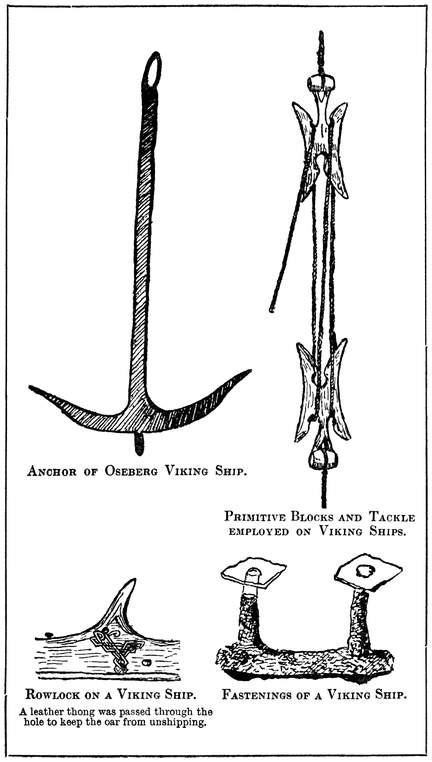
Anchor of Oseberg Viking Ship.
Primitive Blocks and Tackle
employed on Viking Ships.
Rowlock on a Viking Ship.
A leather thong was passed through the
hole to keep the oar from unshipping.
Fastenings of a Viking Ship.
And there were others whose ships were a source of wonder and of admiration. King Knut “himself had that dragon, which was so mickle that it told up sixty benches, and on it were heads gold-bedight. Earl Hakon had another dragon that had a tale of forty benches. Thereon also were gilt heads; but the sails of both were banded of blues and red and green. These ships were all stained above the water-line.” Very keen were these North-men in using the sea as well for pleasure as for service. “Now on a fair day of spring99100 tide was Harek at home, and few men with him at the stead, and the time hung heavy on his hands. So Sigurd spake to him, saying that if he will, they will go a-rowing somewhither for their disport. That liked Harek well: so they go down to the strand, and launch a six-oarer, and Sigurd took from the boathouse sail and gear that went with the craft; for such-wise oft they fared to take the sail with them when they rowed for their disport. Then Harek went aboard the boat and shipped the rudder.... Now before they went aboard the craft they cast into her a butter-keg and bread basket, and bare between them a beer-cask down to the boat. Then they rowed away from land; but when they were come a little way from the isle, then the brethren hoisted sail and Harek steered, and they speedily made way from the isle.”
Both ships and gear were frequently stored in sheds. There is an account of a man who “went down to the water and took the ship of burden which he owned, and King Olaf had given him, and ran out the craft; but all the gear appertaining to it was there in the ship-house.” And again, one of the North-men remarks: “The ship of burden which I have had this while, and here stands in her shed, methinks it is now become so ancient that she rots under her tar.” They hauled these great ships ashore to the sheds by means of rollers:
so sings one of the Sagas. “After Easter,” runs another of these narratives, “the king let run out his ships, and bear thereto rigging and oars. He let deck the ships, and tilt them and bedight them: he let ships float thus arrayed by the gangways.” For it was the101 fitting-out season, you will realise. The word tilt signifies tent. “He let deck” does not mean quite what it would convey to modern minds; all that it indicates is that he replaced the floor-boards, which had been removed at the end of the previous season so that the air could get down below to the ship. Nor does gangway convey the exact definition. It means nothing more than the pier or jetty alongside which the ships were moored after fitting out.
The naval tactics of these men consisted in laying their craft alongside the enemy, boarding him, and then slashing away at the latter and hewing off the figurehead or the tail of his ship as trophies. As they approached, they threw grappling anchors into the other vessel, just as they were wont to fight in the Mediterranean. Thus there is a reference to the incident when “the forecastle men of the Long Worm and the Short Worm and the Crane cast anchors and grapplings on to the ships of King Svein.” And this method survived in Northern Europe right through the Middle Ages. When they boarded a ship they did their best to “clear” the ship by cutting down the defenders, or driving them overboard or else into other ships. That was their main objective—to get the ship to themselves. “Now in those days,” says one of the Sagas, “the wont was when men fought a-shipboard, to bind the ships together and fight from the forecastle.” “Now the most defence on the Worm, and the most murderous to men was of those of the forehold and the forecastle, for in either place was the most chosen folk and the bulwark highest.” And again—“Erling Askew set upon the ship of King Hakon, and shoved his prow in betwixt it and Sigurd’s ship, and then befell the battle. But the ship of Gregory was swept aground, and heeled over much, so at first they gat them not into the onset.”
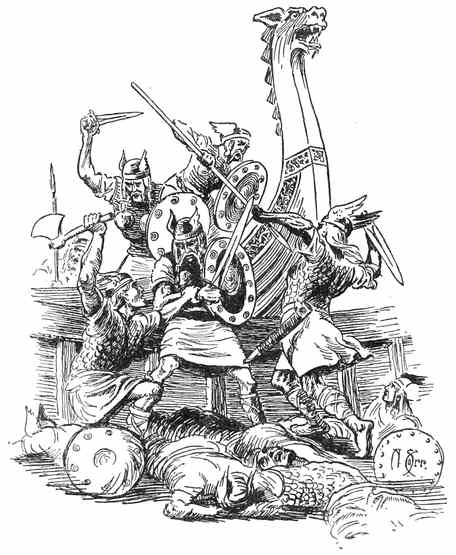
The flagship of King Olaf at the battle of Nesiar,102 in the year 1016, had on the stem a carved head of the king which he himself had fashioned. “That head was long sithence in Norway used on ships which chieftains steered.” At this battle the king had a crew of a hundred in his ship, and most of them carried white shields “with the holy cross laid thereon in gold,103 while some were drawn with red stone or blue; a cross withal he had let draw in white on the brow of all helms. He had a white banner, and that was a worm. Thereafter he let blow the war-blast, and they set off out of the harbour, rowing in search of the earl.” ... “The king’s men caught the beaks of the [enemy’s] ships with grapnels, and thus held them fast. Then the earl cried out that the forecastlemen should hew off the beaks, and even so they did.”
Ten years later this same Olaf was the owner of a vessel named the Bison, which was “the greatest of all ships,” “which he had let make the winter before.” On her prow “was a bison-head dight in gold.” Aft there was a tail, and the head, the tail, and both beaks were all laid with gold. She was a big craft, for she rowed more than sixty men. Arrows and swords were the weapons with which the Norsemen fought, and the chests or lockers were kept well filled for the fray. “King Olaf Tryggvison stood on the poop of the Worm, and shot full oft that day, whiles with the bow and whiles with javelins, and ever twain at once.... Then went the king down into the forehold, and unlocked the chest of the high-seat; and took thence many sharp swords and gave them to his men.” For the poop consisted of a section of the ship with a floor above the ordinary deck, and commanded a view over the whole of the ship. Valiant were the fights often enough, but there were occasions when the contest was so unequal that there was no alternative but to flee. They would then throw overboard rafts with clothes and precious articles heaped on the top in hopes that, by attracting the cupidity of their pursuers, they themselves would succeed in getting away scot-free.
The capture of the ship Worm—this was the Little Worm, and not her bigger sister—happened on this wise: King Olaf stood to the northward sailing with104 the land abroad. Wherever he went ashore he christened the unbaptised. The time came when he turned his ships to the southward, but it came to pass that then he was harassed by “a driving storm with brine spray down the firth.” Finally, he spoke to Bishop Sigurd, and asked him if he knew of any remedy. The bishop answered that he would do what he could, provided God would strengthen his hands to overcome the might of these weather fiends. The picture which the Saga suggests is one that I believe has never yet been attempted by any artist, but there is a fine subject for anyone who could depict the northern blue mists, the high rocks, the sea, the great assembly of Viking ships and men, the bright colours contrasted with the sombre hues of atmosphere, the bishop in his vestments surrounded by these stalwart storm warriors. “So took Bishop Sigurd all his mass-array and went forth on to the prow of the king’s ship, and let kindle the candles, and bore incense. Then he set up the rood in the prow of the ship, and read out the gospel and many prayers, and sprinkled holy water over all the ship. Then he bade unship the tilt and row in up the firth.” Thereupon all the other ships followed the lead, and lo, as soon as the men in the Crane began to row, the crew felt no wind whatever. The driving storm was gone. In that sudden calm the fleet rowed quietly the one ship astern of the other, and so they arrived at God Isles. There they came upon Raud the Unchristened, and he was put to death with little enough mercy. His dragon-ship was captured, and Olaf called her the Worm—the Little Worm—“because when the sail was aloft then should that be as the wings of the dragon. The fairest of all Norway was that ship.”
The Viking ships had no use for head winds. “But when they sought east into the Wick,” runs the narrative elsewhere, “they got foul winds and big, and lay-to105 in havens wide about, both in the out-isles and in up the firths.” Dr. Eirikr Magnusson21 believes that the Halogalanders were in the art of navigation far ahead of the more southerly Norwegians about the year A.D. 1000; and interprets the following to indicate this much. For myself, I have a vague suspicion that it may signify not so much navigation as seamanship, and that it means that Raud understood the art of beating to windward. No doubt these squaresail craft would not haul any nearer to the wind than seven points, but these ships were in no great hurry to make quick passages. They could go about on the other tack and so have—to quote the Saga’s expression—the wind “at will.” This is the statement under discussion: “Raud rowed out to sea with his dragon, and so let hoist sail; for ever had he wind at will whithersoever he would sail, which thing came from his wizardry.” It seems to me that this is exactly explained by beating to windward when the breeze headed them.
The squaresail was hoisted by the halyard, and the yard was kept to the mast by means of parrals (rakki). The sail when hoisted was said to be “topped,” while its straining at the halyard was poetically alluded to as “wrangling with the tackle.” “Topped sails with tackle wrangled,” is a sentence found among the Heimskringla. There is more than one illuminating reference to the sails of the Norsemen which can claim our attention. “But as they hauled up the sail the halliard broke asunder, and down came the sail athwart the ship, and a long while Thorir and his must needs tarry there, or ever they got up their sail a second106 time.” It is true that the Vikings relied considerably on their oars, but for long passages it is unquestionable that their large squaresail was their main means of propulsion. Thus, for example, a fleet might sail to the fjord under sail-power to meet their enemies, but the sail would be lowered before the fight. The oar was kept in position against the thole-pin, and prevented from slipping along the gunwale by means of a strap, and the sixty odd rowers, with their fine physical strength and healthy endurance, could make these easy-lined craft leap across the waves with a speed fully equal to that which their coloured sails could give to them. There is more than one reference, too, to the different hues of these sails then prevailing in Northern Europe, the “English king Knut” having blue sails on the yard of each of his ships.
When they voyaged there was nothing of the modern hurry of seafaring life. They were not compelled to perform a certain passage within a specified number of days, and they could wait as long as their commanders wished for a fair wind to spring up. “After that King Sigurd fared to his ships, and made ready to leave Jerusalem-land. They sailed north to that island which hight Cyprus, and there King Sigurd dwelt somewhile and fared sithence to Greekland, and laid-to all his host off Angelness, and lay there for half a month. And every day was a fair breeze north along the main; but he willed to bide such a wind as should be a right side-wind, so that sails might be set end-long of the ship, for all his sails were set with pall, both fore and aft: for this reason, that both they who were forward, as well as they who were aft, would not to look on the unfair sails.” The meaning of this expression is quite obvious to a seaman. Sigurd clearly wanted to make his voyage with the wind in such a direction that it was abeam rather than dead aft. The107 logical inference from this extract is that his ships sailed best on a broad reach rather than when running free. And if we may judge from the lines and dimensions of those Viking ships which have been unearthed in Scandinavia in such wonderful preservation, it is quite certain that these long, straight-keeled craft would be very fast on a wind.
And how were they steered? The rudder was placed on the starboard side, the round top of it being secured to the gunwale by means of a loop which one may call the rudder-strap. At a proper distance down, says Dr. Magnusson, a cone-shaped piece of wood was nailed to the side of the boat, the top of the cone being plumb with the outside of the gunwale. Through the rudder, where it took the form of a broad oar-blade, a hole was made corresponding to one through the cone-shaped piece of wood which went right through the side of the boat. A cord drawn through the hole in the rudder and the conic piece of wood, and made fast within board, gave to the rudder a fixed position. By loosening the cord the rudder could be lifted at will and taken inboard. Through the neck of the rudder a square hole was made, into which fitted the end of the tiller, by means of which the helmsman moving it towards him starboarded the rudder, and ported it by performing the exact opposite.
There was a plank at the back of the seat of the helmsman against which he could steady himself in handling the helm, just as many a steersman on small craft to-day get support for controlling the tiller in a seaway. This was known as the “staying board.” Thus “Einar shot at Earl Eric, and the arrow smote the tiller-head above the head of the earl, and went in up to the shaft binding. The earl looked thereon, and asked if they wist who shot; and even therewith came another arrow so nigh that it flew betwixt the earl’s108 side and his arm, and so on to the staying-board of the steersman, and the point stood far beyond.”
We must picture in our minds the Norse steersman sitting with his face to the starboard side, his hand on the tiller. The stjornbordi—or steering side—was the starboard. The bakbordi was the port side. Why bakbordi? Because it was the board at the back of the helmsman when he sat looking to starboard or steering side. And so to this day, although no longer a ship has her rudder at the side, yet the right-hand side of a ship is always the starboard.
Notwithstanding the curious fact that in certain parts of Europe, at an extraordinarily early date, chain cables were actually in use, yet it is quite clear that those of the Viking ships were of rope. These cables were twisted round the beaks of the ships, the beaks consisting of pieces of timber placed upright in and about the prow of the ship. They were similar to the bitts such as you see in a modern lifeboat or yacht. So, whenever the Viking vessel was at anchor, or she was lashed alongside her enemy in pitched battle, the cable of the anchor or the grapnel was made fast to these timbers. In the account of the flight of Earl Svein, it is recorded that “when the earl saw to how hopeless a pass things were come, he called upon his forecastle men to cut the cables and let loose the ships, and even so they did. Then the king’s men caught the beaks of the ships with grapnels, and thus held them fast. Then the earl cried out that the forecastlemen should hew off the beaks, and even so they did.” And again: “Einar Thambarskelfir had laid his ship on the other board of that of the earl, and his men threw an anchor into the prow of the earl’s ship, and thus they all drifted together into the firth; and after that the whole host of the earl took to flight, and rowed out into the firth.”
109 Ships might not bring-up where they liked. There was decided precedence among the Norsemen, as will be observed from the following incident: “On a summer Earl Hakon had out his fleet, and Thorleif the Sage was master of a ship therein. Of that company also was Eric, the earl’s son, who was as then ten or eleven winters old. So, whenever they brought-to in havens at night-tide, nought seemed good to Eric but to moor his ship next to the earl’s ship. But when they were come south to Mere, thither came Skopti, the earl’s brother-in-law, with a long-ship all manned; but as they rowed up to the fleet, Skopti called out to Thorleif to clear the haven for him, and shift his berth. Eric answered speedily, bidding Skopti take another berth. That heard Earl Hakon, how Eric his son now deemed himself so mighty that he would not give place to Skopti. So the earl called out straightway, and bade them leave their berth, saying that somewhat worser lay in store for them else, to wit, to be beaten. So when Thorleif heard that, he cried out to his men to slip their cables; and even so was it done. And Skopti lay in the berth whereas he was wont, next to the earl’s ship to wit.”
There were a number of small row-boats employed by the Vikings, the size of which did not allow of more than six oarsmen. No doubt these were employed for going ashore when the big ships lay some distance from the shore. But often the Viking craft lay alongside piers. “Gunnstein said that now was the turn of the tide, and it was time to sail. Therewith they drew in their cables.... In this they fared on until they came to Geirsver, the first place where, coming from the north, one may lie at a pier. Thither they came both one day at eve, and lay in haven there off the pier.” The mention is also made of gangways for getting on board from the shore.
110 But sometimes they lay moored stem and stern in much the same fashion as the ancient Greeks were wont. They let go their bow anchors in deep water, veered out cable, took a line ashore from the stern, and then, each ship having done this, the whole fleet were lashed up together side by side just as to-day you often see a whole fleet of fishermen tethered in a small harbour. There are several passages in the Sagas which call attention to the manner in which their ships were moored. “Forthwith when Karli, and his, got aboard their ship, they swept off the tilts, and cast off the moorings; then they drew up sail, and the ship soon sped off into the main.” Or again ... “said they had seen King Hakon’s host, and all the arrayal thereof; said that they were lying up by the stakes and had moored their sterns to the stakes; they have two east-faring keels, and have laid them outermost of all the ships; on these keels are masthead castles, and castles withal in the prow of them both.”
This last quotation, belonging to the twelfth century, has reference to the mode of fighting which was in vogue during the Middle Ages, when the fighting tops, the castellated structures at both bow and stern, were such significant features on these long, narrow ships. The word “keel” is used not, of course, in reference to any particular portion of the ship’s structure, but to the ship as a whole. The word is still in active use to-day on the Humber as applied to a species of craft which, with its large squaresail as its only canvas, bears some similarity to the old Norse ceols or keels.
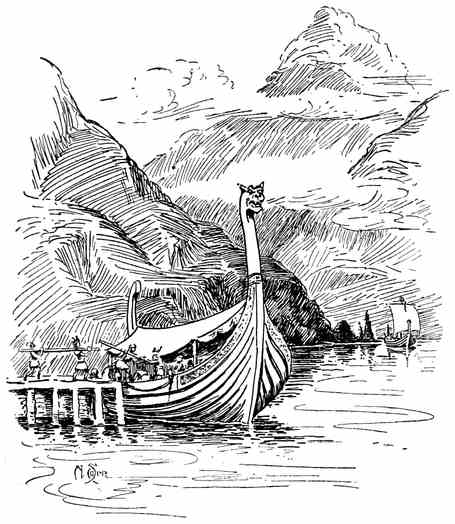
The crews of these ships slept under those “tilts” or awnings which were spread across the ship in an inverted V-shape. In harbour the tilts were spread over the entire vessel. But in less sheltered anchorages, and when at sea, tilts were rigged over only portions of the ship to afford sufficient protection to the men.111 But in all cases these tilts or tjalds were struck before the ship went into action, for the obvious reason that it was desirable to have the entire ship clear for fighting. The food-supplies, both solid and fluid, were carried in casks, and the mess system is well described in one of the Sagas entitled “The Story of the Ere-Dwellers.” “In those days,” runs the narrative, “was it the wont of chapmen to have no cooks, but the messmates chose112 by lot amongst themselves who should have the ward of the mess day by day. Then, too, was it the wont of all the midshipmen to have their drink in common, and a cask should stand by the mast with the drink therein, and a locked lid was over it. But some of the drink was in tuns, and was added to the cask thence as soon as it was drunk out.”
We know nothing as to whether these Norse ships possessed bilge pumps. The probability is that they did not, but a bailing butt was certainly part of their inventory. Evidently there was a well some distance aft, into which any water shipped was allowed to drain and thence bailed out, as the reader shall presently see from the following quotation. The description refers to the time when King Harald manned his new dragon-galley. “The said dragon he manned with his court-guard and bareserks,” runs the Saga. “The stem men were the men most tried, because they had with them the king’s banner; aft from the stem to the bailing place was the forecastle, and that was manned by the bareserks. Those only could get court-service with King Harald who were men peerless both of strength and good heart and all prowess; with such only was his ship manned.”
Each oarsman had about three and a half feet to work in. There is more than one reference in these Sagas to the beds and berths on the Viking ships. “When the ship of Magnus was much ridded, and he was lying in his berth,” etc. In the ships of war the rowing benches did not stretch right across the vessel, as this would interfere with the mobility of the fighting men, who must needs be left free to rush forward or aft as the case might be during the battle. The oarsmen therefore had each a bench just roomy enough to sit down and do their work whilst pulling at the oar. Little enough is told us of the commander, but we113 know that in the ship’s inventory was included his mess-table or “meat-board.”
They were strong of body, these Norsemen, like their ships, brave and valiant fighters, and they were not altogether bereft of wit, as for instance when, wishing to convey an insult, someone fashioned an anchor from a piece of cheese, and said that “such would hold the ships of Norway’s king.” They were adaptable, too, as in such cases when they readily took their anchors ashore, bound them to long staves, and employed them for razing an enemy’s wall to the ground. But, most of all, they were seamen of the very finest type which the world has ever seen.
114
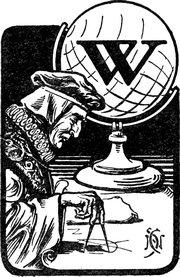
When we consider all the wondrous achievements on the part of the Ancients, when we consider how many centuries they were engaged in maritime matters, it is a matter for some surprise that, with the exception of what was done by the Phœnicians, there was practically no maritime discovery made by them. They were content with the limitations of the Mediterranean, and beyond the Gaditan Straits they did not venture.
At first sight it certainly is a little strange. But the reason is quite obvious. Their seamanship was good enough, but their navigation was of an inferior order. The Romans, for example, were not geographers, and without some knowledge of geography even the crudest navigational methods lose their value. Among the Greeks and Romans there existed curious and uncertain ideas concerning the earth. Some thought that it floated on the water like a bowl. Some believed that it was like to a column or stone pillar; others that it was hollow as a dish. Some said it was as flat as a table; some that its shape was similar to a drum. So with all these conflicting ideas there was no accurate knowledge of the world.
115 Further, though there were astronomers, yet they were incompetent and of little value from a practical point of view. Lastly, the ancients had yet to learn the essential value of the loadstone. Hence their mariners were not fitted for such long voyages as were to be made later on by the Portuguese. The early Mediterranean mariners were efficient so long as they kept within the confines of their own enormous lake, for their voyaging was practically coastal. Even when they had to sail North and South they had such places as Rhodes to enable them to break their journey and make a good departure from. They could never lose themselves for long, for they knew the aspect of the various promontories and bays. They could “smell” their way through most channels even when the light failed them. And remember, too, that theirs were not big ships if compared with the caravels which were to come later. There were plenty of oarsmen in the warships if it became necessary to claw off a lee shore, and these shallow-draught vessels could float in the most shallow channels.
But if they had been called upon to cross the Atlantic or, rounding the South of Africa, traverse the Indian Ocean, they would have soon lost themselves when out of sight of land for many days; so they kept to their own sea and left the discovering of the world to others who should come centuries later. Hipparchus had been the first to make a catalogue of the stars about the year 150 B.C. Pass over a somewhat barren interval till you come to the year A.D. 150 and you find Ptolemy correcting the tables of Hipparchus. In Ptolemy we have the summit of classical knowledge as reached during the times of the ancients. His account of the universe and the movements of the heavenly bodies had a great influence on the seafarers in the Middle Ages, and so on the world’s discoveries.116 Now Ptolemy’s geography was based for the most part on “itineraries.” These, in modern parlance, were simply guide-books for travellers: that is to say, they consisted of tables and routes showing the stopping-places. Such data as these afforded had been obtained for the most part from military campaigns—especially Roman—and from the voyages made by sailors, but also from merchants.
Ptolemy made a wonderful improvement in cartographical representation by introducing correction with converging meridians, this method having been commenced by Hipparchus. But Ptolemy was singularly fortunate to have been living at the time when the Roman Empire was at its height, and so enabled to obtain a mass of geographical details through the extensive administration of this far-reaching dominion.
In Northern Europe the mists had not yet cleared. It was a long time before they did. It is not till the eighth century of our era that there is any certain mention in literature concerning the voyaging to the Arctic Circle. This was when the good monks from Ireland discovered the Faroe Isles and Iceland after setting forth across the sea, and settled down there, baptising the inhabitants and teaching them Christianity. Indirectly, they were doing more than this: they were linking up one portion of world that was unknown to or by the other. Already King Arthur, by his conquest of Scandinavia, Ireland, Gothland, Denmark, and other northern territories, had caused an addition to geographical knowledge by intercommunication. “Now at length,” to quote Hakluyt, “they are incorporated with us by the receiving of our religion and sacraments, and by taking wives of our nation, and by affinitie, and mariages.”
Add to these the northern voyages of Octher, King Edgar, together with the frequent raids of the Norsemen117 and the increasing number of missionaries, and it is easy to see the world’s geographical knowledge accumulating. But these, again, were mostly coasting voyages; or, at any rate, the voyagers were not out of sight of land for many days. The Norse discoveries are, in fact, the first great achievement of the western maritime world between the time of Constantine and the first Crusade. We have already alluded so fully to their seamanship that it remains only to remind the reader that as early as A.D. 787 they had landed in our country; in 874 had begun to colonise Iceland; in 877 had sighted Greenland; and in 888, or thereabouts, had reached the White Sea. In Southern Europe there was nothing comparable to this. Notwithstanding that the workmanship of the Italian shipbuilders was as good as, if not better than, the work of the Norsemen; notwithstanding, also, that the latter were further away from civilisation and scientific knowledge, yet for all that the Vikings were peering into the Unknown World, while the Southerners were content to leave the curtain to hide a little longer the wonders of the universe from the eyes of mankind.
As we look at the manner in which the world has been opened out, discovered, revealed, linked up, we shall find that this was brought about as follows: The Southerners, then, were too content with their Mediterranean to leave it in quest of other seas, while the Vikings were exactly the reverse in their own sphere. Then comes the influence of Christian devotion. Not merely the missionaries, but the bands of pilgrims begin for the first time in their lives to travel long distances. The Crusades astound the Crusaders themselves. They marvel at the possibilities of the world. A permanent link is forged between the North and the near East. The Bay of Biscay and the Mediterranean are accomplished in safety. Why should they not118 come back again, after their vows have been filled, to trade? They have fought, they have said their prayers. Why might they not buy and sell? Thus there is formed a connection between the Levant and England which time was to develop.
We see, then, the merchants of the world getting restless for greater wealth: anxious for new markets for their wares, new places whence to gather fresh imports. Owing to the natural dread of the sea the land routes were frequently patronised in preference to the sea lanes, though this was not always. Now the great treasure-house of the world in men’s estimation lay in India. There was to be found a rich store of commodities, so thither merchants repaired by the long overland routes. But there was a growing feeling among the Genoese, the Venetians, and the Spanish that there ought to be a sea path to India just as there was to Northern Europe. There was a great risk attached to the present method of bringing goods across from India by land. There was the risk of pilfering or of bandits, besides the great cost of transportation. Furthermore, these sons of the Catholic Church longed to crush the power of Islam, longed to place the ruling of the world in the hands of a Christian Empire. It is necessary to bear in mind this potent desire to find a sea route to India, because by this desire was given an impetus which not only revealed India to seamen, but unfolded the New World in the Western Hemisphere. As far back as the year A.D. 1281, Vivaldi set forth from Genoa in his fruitless endeavour to reach the Indies via the west coast of Africa; so also Malocello had sailed as far as the Canary Isles about the year 1270; and there were numbers of other gallant adventurers who had started forth optimistically. But the sea route to India had not yet been ploughed by the ships of men.
119 Meanwhile there arrived on the scene the best friend mariner ever had. Up till now the compass had not been used. It is possible and extremely probable that from very early times the Chinese understood the communicating of the magnetic fluid to iron, and the marvellous and mysterious power which that iron possesses when thus magnetised. One may take it that the Chinese introduced this notion to the famous Arabian seamen sailing between the Far East and the east coast of Africa. Thus, via the Red Sea, this information of the utility of the magnetised needle for the use of seamen was brought into Europe. Prior to the tenth century the invention had gone no further than placing a bar of magnetised iron in the arms of a wooden figure on a pivot. In China the South took the place of North, and the former was indicated by the outstretched hand of the little man erected on the prow of the vessel, or by the bar of pulverised iron which the image held like a spear in its hands. With such magnetic indications the Chinese from the third century A.D. voyaged from Canton to Malabar and the Persian Gulf.
By the second decade of the twelfth century the Chinese were using the water-compass. It was not seen in Europe till about the year 1190; or rather it is not mentioned till about that date. What is most probable is the suggestion that the sailors of Northern Europe first saw it at the time of the Crusades, and took back to their own ports the idea which the Arabian dhow skippers had employed for so many years in navigating the Indian Ocean. There is a clear reference in an old French ballad of the late twelfth century to the Pole-star and magnet:—
120
This ballad was afterwards known as “The Song of the Compass.” Doubtless this crude compass was used only when the sailors could not see the sun in cloudy weather, or it may have been also used when making night passages. It certainly cannot have been more than a frail aid in stormy weather, when these clumsy ships were pitching and rolling in the trough of the sea. Still, excepting this innovation, there is not between the time of the ancient Greeks and that of the fourteenth century more than the slightest advance in the seaman’s art. Frankly, they hardly needed the compass in their coasting voyages, and when its utility was demonstrated they declined, for a long time, to put to sea in any ship having such an infernal and superstitious article on board. Although the date 1190 has just been given as the approximate period when the lodestone was employed in European navigation, yet it was not till the beginning of the fourteenth century that a Neapolitan pilot suspended the needle on a fixed pivot in a box, though some authorities deny that this man accomplished so much. The origin of the fleur-de-lys, which the reader still sees on every compass card to this day—flower-de-luce, as the rude Elizabethan sailors used to call it—is variously attributed to the fact that this pilot was a subject of the121 King of Naples, who was of the junior branch of the Bourbon family. Or it is possibly a conventional representation of the dart which the Arabians called the needle.
Let us then sum up. Thanks to the Vikings and Crusaders, the warriors and the traders, there was a greater knowledge of the world’s geography. And now also men had the instrument which would enable them to find their way across trackless oceans and reach home again in safety. Concerning those places which they had never seen, they had much hopeful curiosity, but there was little actual information. All the time the East was calling in its magical way to the European adventurers. The land travellers of the twelfth, thirteenth, and fourteenth centuries had drawn back the veil hiding the golden harvest of the East. Those who had been and seen related such wondrous yarns that men of action and ambition longed to be away thither at once. The effect of the Crusades had not yet passed away. The desire for travel which has spread so enormously till it has reached the present-day obsession was growing rapidly.
Understand, that since the time when those Phœnicians circumnavigated the Continent there had been no repetition of this achievement, and in fact no serious attempts. In 1270 Malocello had found the Canaries. Ten or twenty years later the Genoese had made some sort of effort to find a sea route to India, but they only reached Gozora in Barbary. Various other explorers also found their way to the islands of the Atlantic adjacent to the West African coast. In the history of exploration there are plenty of instances where one man in a certain century has discovered a new region. Many years later, after this has been forgotten, some other explorer lands on this territory and claims to have been there first. In other instances122 the secret of the first adventurer has been well kept and well utilised by those who lived long after the first man had died.
Take Madeira as a case in point. This was discovered not by a Genoese, a Venetian, or a Portuguese, but by an Englishman of the name of Macham. He eloped from England with a certain lady, went on board his ship, reached Spain, and then arrived “by tempest” in Madeira, “and did cast anker in that haven or bay, which now is called Machico after the name of Macham. And because his lover was sea-sicke, he went on land with some of his company, and the shippe with a good winde made saile away, and the woman died for thought.” This was about the year 1344. For years after, Madeira remained unknown to men’s minds. But Prince Henry the Navigator knew of the Macham incident, and he put it to good use.
It is true that before the close of the Middle Ages the tendency of the Italian seamen-traders was to emerge from the limits of their Mediterranean Sea. The voyages to the Canaries and to Barbary are instances of this growing enterprise. They had for years established an overseas trade also with Northern Europe, and every year the Venetians made a voyage to Flanders and back. We have not space to deal in detail with the voyage of the two Venetian brothers Zeno to Greenland in the fourteenth century, though the record is still in existence for those who wish to read.
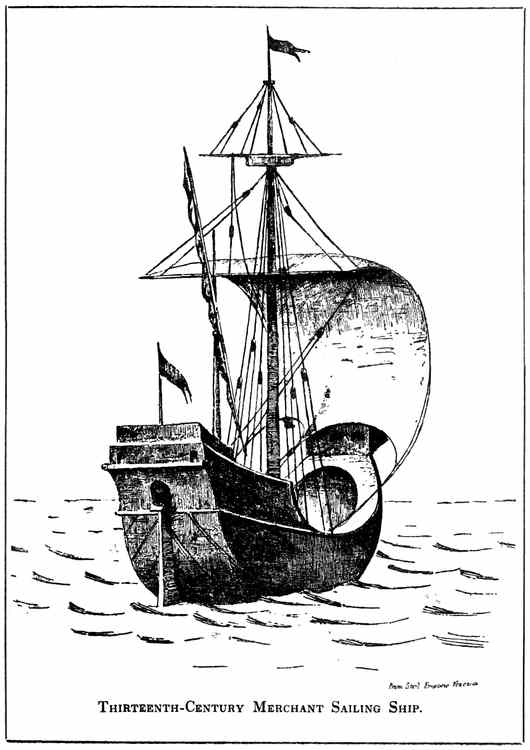
But still, in spite of the voyages of Viking and Venetian, the Crusading expeditions, and the enterprising travels which had been undertaken, yet the real progress in navigation, as a science and an art, was made not by the sailors of Christendom, but by the Arabians. The latter had calculated their tables of latitude and longitude by astronomical observations. They had produced rough coast-charts; and what was123124 more, they had been using the compass and other nautical instruments for some time. But thanks to the travel craze which had set in, the Christian ships which were seen in the Mediterranean about the beginning of the fifteenth century were supplied with the compass, an astrolabe, a timepiece, and charts just as you would have found on board an Arabian trading to the Indian Ocean. At length the Christian seamen overcame their prejudice, and were glad to avail themselves of the magnetised needle; but its use was by no means universal.
Bear in mind, also, the wave of the New Learning that was spreading over Europe. Mathematics and astronomy had already begun to be studied in Portugal at the beginning of the fourteenth century. And with regard to cartography, or map-making, something new was happening. Already by 1306 a Venetian map had been made which put into form the ideas which inspired the first Italian voyages in the Atlantic. These charts were made for the purpose of recording the discoveries of the great contemporary seamen. It is indeed surprising to note how accurate these charts really are. The Italians with all their artistic ability were now the great map-makers, and they managed to produce a number of portolani which were of the greatest use to the mariners and merchants of the Mediterranean. These were made by means of the knowledge and assistance of seamen, and were intended to be of service to the latter in their navigation.
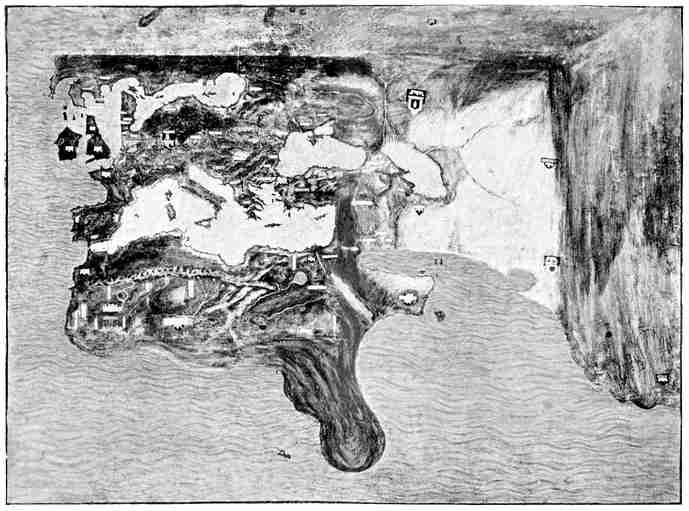
Fourteenth-Century Portolano of the Mediterranean.
Showing vague idea of the shape of Africa
A portolano was nothing more or less than a plan or map-sketch. That which is here given is from a reproduction in the Map Room of the British Museum. When we consider that this was made as far back as the year 1351, or one hundred and thirty-five years before the Cape of Good Hope was rounded, it is wonderfully accurate, and the shape given to Southern Africa125 is a curiously clever guess. But it should be remembered that though the continent had never been rounded (except in Phœnician times), yet there was a vague idea of the probable shape of the west coast from those who had been to Barbary; and it is most probable that by the information received from the Arabs, who knew the East African coast intimately, this side of the continent would be described to them. Thus a not wholly incorrect idea was conveyed of the shape of the whole of Africa’s coast-line.
But if we examine the configuration of the portions depicted as being in Europe, notably the northern shores of the Mediterranean, this portolano is most pleasing and accurate, and cannot have failed to have saved the skippers of that time many an anxious moment. That which is here reproduced dates from the year 1351, but portolani were in use as far back as the twelfth century as practical guides to seamen. The next improvement occurred when the compass began to be used in the Mediterranean, and so the portolani began to be drawn with this aid. Gradually, with practice, they were beautifully finished, and contained practically no large error or any wrong proportion, while the mariner had very full details given him regarding the coastlines, rivers, mouths, headlands, bays, and so on.
But everything that we have written in this chapter has been leading up to a consideration of the most important epoch in the whole history of seamanship or navigation. It is necessary to have in mind that south-west extremity of Portugal which is now so well known to students of naval history as Cape St. Vincent. On this strip of territory were to dwell a community that would, so to speak, dictate the maritime policy of the world. Here was to be the finest naval college which ever existed even to this day. Here were brought126 together the pick of the world’s seamen and navigators of that time. From here were to issue both great explorers and the influence which caused all those other navigators to open up the world as a man opens a closed book. To this day civilisation has not realised one tithe of what it and the seafaring nations especially owe in respect of shipbuilding, navigation, and overseas commerce to that small stretch situated at the end of the Spanish peninsula. The success which followed was the result of a wonderful personality. It was the triumph of a man who possessed in one combination the gifts of a far-seeing imagination, a scholarly mind, and a genius for organisation allied to a passion for the sea and the finding of new lands.
This man was Prince Henry, the third son of King John I of Portugal and nephew of Henry IV of England. His life is the old story of a man who wishes to do good work, and in order to bring out the best which is in him, finds it essential to retire from the world. Just as the monastic finds it desirable to withdraw from the hurly-burly of his age; just as the scientist in search of some new invention applies himself to no other study and lets every other consideration slide, so Prince Henry the Navigator, as he came to be called, thrust aside the attractions of Court life and wedded himself to a work which has benefited humanity to an extent that it does not yet and perhaps never will appreciate. It is not too much to say that it is entirely owing to Prince Henry’s influence that ships now sail backwards and forwards to India, South Africa, America, Australia, and elsewhere. If only people understood half they owed to this man they would commemorate his name in every important seaport of the world.
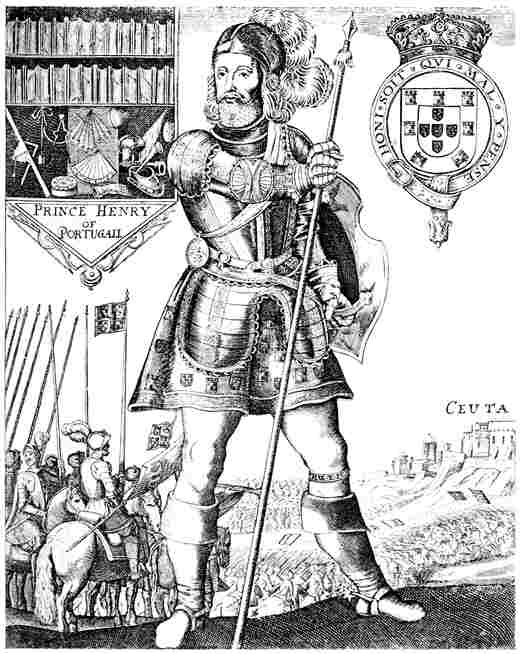
Prince Henry the Navigator.
After a print by Simon de Passe.
By nature a student and seaman, he retired (as his biographer, Mr. Raymond Beazley, appositely remarks) “more and more from the known world that he might127 open up the unknown.” That exactly sums up his life. In olden times, what is now called Cape St. Vincent was known as the Holy Promontory. Just to the right of this comes Sagres, and a little further east is Lagos. In the year 1415 Prince Henry settles at Sagres, a cold, barren, dreary, inhospitable promontory, but one singularly suitable for quiet study and research, with the whole extent of the Atlantic to look out upon, and the fresh sea breezes to invigorate the mind away from the insincerities of civilised life. The fifteenth century has always been regarded as the last of the “Dark Ages,” but few more wonderful things happened either then or after than the activities which emanated from the Sagres community. For here the Prince had brought and sifted all the geographical knowledge inherited from the ancients. Here were studied the subjects of mathematics, navigation, cartography in a manner and on such a scale as had never before been attempted. From Italy and Spain were sent the practical men—the boldest and most experienced seamen and navigators that could be found.
Sagres was a kind of international bureau created for the future development of the world, but especially and primarily it had for its object the reaching of India. Henry’s countrymen who had been about over the continent of Europe had encountered in the markets of Bruges and London travellers and merchants from other parts of the world, and in course of conversation managed to pick up a good deal of information regarding the overland trade to India and the Far East. Henry’s chief-of-staff was his own brother Pedro, who also had travelled extensively and had visited all the countries in the west of Europe. He, too, had come back not empty-handed, but with maps and plans, books and much verbal information regarding the places visited. All this information went to swell the general geographical128 knowledge which Henry was accumulating and systematising.
Close to Sagres was the naval arsenal of Lagos, over which the Prince was governor. Here he built those caravels which were to carry out the theories that he had worked out for his captains. On their return he set to work to sift the data which his ships and men had brought back with them, to correct the maps according to this new information, to readjust the instruments, to compare the accounts of travellers ancient and modern, and then to hand the conclusions of all these to the captains of the next ships that went forth to explore. Thus the Sagres naval college was at once highly theoretical and highly practical. It was also founded on a strong religious basis. Besides the palace, observatory, and study which he built for himself, Henry had erected a chapel, a village for his helpers, and among the instructions to those whom he sent out to explore was the admonition to bring Christianity into all new territory. Here were men engaged in teaching navigation to seamen; here were others instructing pupils how to draw maps and nautical instruments. Even Arabians and Jews were imported to give the Portuguese the benefit of their learning in astronomical and mathematical subjects. It was indeed a cosmopolitan crowd which collected at this Atlantic village. Orientals and Portuguese, veteran pilots from Italy, shipbuilders, seamen, and students of all kinds, cartographers and instrument-makers. But they were assembled there for one purpose. Led by the example and patience and single-hearted enthusiasm of their governor, who guided their labours with prudence and forethought, this little band was to be the nucleus which should form that magnificent race of Portuguese seamen who were to achieve so much during the fifteenth and sixteenth centuries.
129 We cannot but admire Prince Henry for his admirable enthusiasm, for his patience, his wisdom, and his solid hard work. Nevertheless we respect him possibly even more for having begun at the right end. Instead of sending out his fleets to blunder their way along, they set forth more adequately fitted both as to ships and men than any which had ever put to sea since the beginning of the world. In the schools of Sagres, the shipyards of Lagos, and the voyages of Prince Henry’s ships, we have one of the finest combinations of theory and practice which the mind of man could ever devise. It must indeed have been a most fascinating institution. From this school graduated a fearless race of sailors, who for their daring and enterprise have never been surpassed either in Elizabethan or Nelsonian times when we consider the limitations of their equipment.
Here at last, then, the seaman’s art, for the first time in the history of the world, had a chance of being taught properly. From 1415 to 1460, with the exception of brief intervals, Prince Henry remained here doing this splendid work till death released him from his labours. What then was the aim of his life’s labour? What, in fact, were the results which accrued? Let us see first of all his aims.
He wished to find a way round Africa to India partly for the love of the new knowledge itself, just as any scientist shares the world’s delight in having discovered some invaluable invention. But also it would mean greater dominion, and Portugal would add to her distinctive position among the nations of the world. Already at least a century before his time it had been suggested by Raymond Lulli, a famous Majorcan alchemist, who lived from 1235 to 1315, that India might probably be reached by rounding Africa on the west and east, and it is curious how that idea persisted130 without any apparent reason or justification before it was actually proved to be correct. Secondly, Henry wanted to find out what was the shape of the world, and to put an end to the rival theories which existed. Marco Polo had done something for the southern coast-line of Asia, and the shape of Africa had been fairly guessed by the portolano, as already seen. On the east coast of Africa there were the Arab settlements, and there was a vague sort of knowledge concerning the west coast so far south as Guinea. This information had been obtained through the Sahara caravan trade.
But there was a third reason for Henry’s enterprise. The research work, the education of his seamen, the making of maps, the providing of instruments, the building and fitting out of ships and so forth could not possibly go on without some sort of financial basis. Such a project, however philanthropic, could not be allowed to continue without some means of sustenance. Henry’s idea was to make the overseas trade pay for all of this. There were riches enough in India and elsewhere to cover handsomely the cost of making Portugal a race of sailors, the leader of the world in maritime exploration. The land route across Asia along which were brought such rich commodities of eastern goods alone proved that India was worth aiming at. If only these goods could be brought by water, then not only would delay, pillage, and money be saved, but Portugal would become the owners of the Indian carrying trade, and the richest of the eastern merchants. One cannot emphasise too strongly the fact that in the minds of the people of the Middle Ages India was the prize of the world, the depository of the greatest wealth. India, then, was the inspiration, Sagres the medium by which the countries of the globe outside Europe have been discovered and developed.
And there was another reason. The political power131 of the Catholic Church was very considerable. A Portuguese seaman was a true son of the Church, whether skipper or deck-hand. Wherever he colonised, wherever he discovered or traded, he was anxious to spread the Catholic religion. He hated Islam, he wanted to add the territory of the world to the great Christian empire. In no heart did such aspirations flourish so strongly as in Prince Henry the Navigator. India was to become not merely the means of encouraging seafaring, but an invaluable possession.
But what were the results of Henry’s great organisation and activities? Indirectly he was the cause of Columbus finding the New World when looking for India in 1492; of Da Gama reaching India in 1498; of Magellan encircling the globe in 1520–2: less directly still to him may be traced the round-the-world voyages of Drake and Anson. To Prince Henry the Navigator may be ascribed at least half the honour in conquering the islands of the Atlantic and the western coast of Africa, the doubling of the Cape of Good Hope, the founding of transoceanic empires and magnificent cities. To his genius may be traced the opening up of the Western Hemisphere, and the sea path to India and the Far East, the discovery of Australia, and other voyages embraced within the limits of a century. In fact, but for Henry the Navigator we should have remained for a much longer period ignorant of one-half of the world. The fifteenth and sixteenth centuries are essentially a sea epoch more than any age in history, and their influence was felt in all subsequent periods even down to the present day. Sagres focussed all the world’s knowledge of the nautical arts, and shed a powerful searchlight which revealed to nations the wonderful possibilities that lay by way of the sea. It led to India and America, to gold mines and rich plantations, to wealth, to prosperity, to power. The132 seamanship, the navigation, and the shipbuilding in that narrow strip of Portugal were the best which existed anywhere.
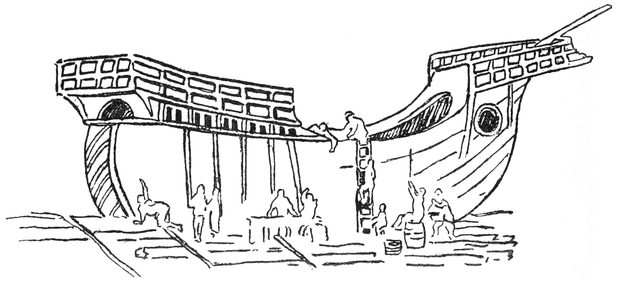
Hence Prince Henry’s pupils, even at such a late date in the world’s history, were the first to break through all the superstitious ideas, the ignorance, the myths, and even terror with which the African unknown was regarded. If his own men did not actually reach India, at any rate they prepared the way thither by sailing for two thousand miles to the southward where no other ships and sailors had been before, with the sole exception of the Phœnicians. Thus they went half the way to the Indian peninsula; in fact, we may add, the most important half. For when at last Vasco da Gama had got round the south of Africa from west to east he was in an ocean that had been regularly traversed by Arabian seamen for centuries. But it is not so much the exploits of Henry’s direct pupils which really matter; it is the influence which he began to exert in the fifteenth century and continued to exert even after133 his death. He created a new school of nautical thought and practice. All maritime progress prior to the fifteenth century leads up to Henry the Navigator: from him radiate all the wondrous improvements which followed after the date when his Sagres school was inaugurated. There is not a man or woman to-day who ought not to feel grateful to this illustrious and able man. The expansion of Christendom, the increase of national wealth, the development of the colonial idea—these are but a few of the achievements which belong to him. From Portugal to Spain the excellent idea spread of carefully instructing the nation’s seamen. It was Charles V who founded a lectureship at Seville on the Art of Navigation. Such authoritative men as Alonso de Chavez, Hieronymo de Chavez, and Roderigo Zamorano are referred to by Hakluyt as among those who, by word of mouth no less than by published treatise, were wont to instruct the Spanish mariners. Not only did Charles V establish a lectureship, but owing to “the rawnesse of his Seamen, and the manifolde shipwracks which they susteyned in passing and repassing betweene Spaine and the West Indies, with an high reach and great foresight, established ... a Pilote Major, for the examination of such as sought to take charge of ships in that voyage.”
Similarly, owing doubtless to this influence, Henry VIII, recognising something of the importance of the naval side of a nation, founded three seamen’s guilds or brotherhoods on apparently somewhat similar lines at Deptford-on-Thames, Kingston-on-Hull, and Newcastle-on-Tyne. The object was that English seamen might become more apt in seamanship and navigation both in peace and war. And following up the same idea, we find his successor, Edward VI, promoting Sebastian Cabot to be Grand Pilot of England.
134 Before we pass on, it may be advisable to run briefly through the different stages which led to the final opening up of the sea route to India from European ports. The whole project is so intimately bound up with the development of seamanship and navigation, that we cannot well afford to omit this sketch from our purview. It was not by one single effort, but by a series of attempts that the task was performed. The doubling of the Cape of Good Hope by Vasco da Gama in 1497 was notable not merely in itself—not merely because of the long voyage and the attainment of Africa’s southern cape—but because it showed that that ancient instinct was right: there was a sea route to India for those who had the daring to venture.
In the year 1415 the furthest south reached was Cape Nun, which is at the south-west extremity of Morocco. Three years later, thanks to the secret which Henry possessed of Macham’s early voyage, two of the Prince’s courtiers were able to rediscover Madeira. In 1433 Cape Bojador, which is on the west coast of the Sahara to the south-east of the Canaries, was doubled by Gillianez. Thus these voyagers were gradually getting nearer to the Equator. The doubling of the last-mentioned headland made such an impression on Pope Martin V that His Holiness bestowed on the King of Portugal all that might thereafter be discovered in Africa and India. This concession led to international disputes in later years.
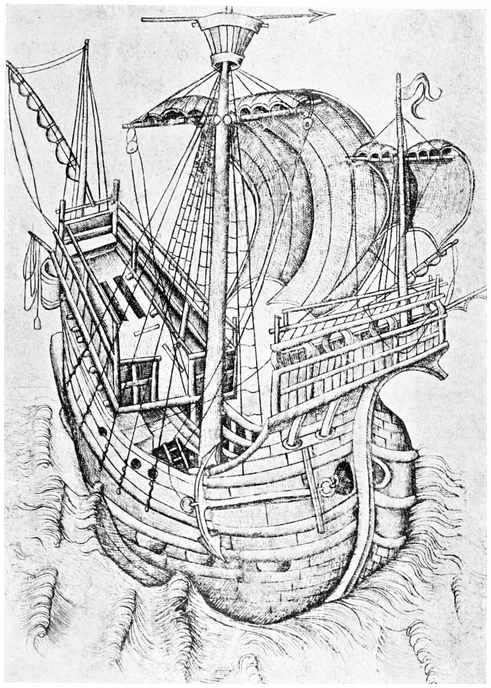
In the year 1441 still more southing was achieved when Gonzales and Tristan reached Cape Blanco on the same West African coast. Three years later and the River Gambia was discovered, and in 1446 the Cape Verde Islands were visited. All this shows the considerable amount of activity which went on during those years when the Prince was at the head of his naval school. We can see, by referring to a map, how135 steady and persistent was the advance along the west coast of this unknown continent. But then there comes Henry’s death, and there follows a gap in this chain of discoveries. Still, before long this series of southerly voyages was resumed. The aim was ever in the same direction, but the cause of failure is unknown; whether they feared to go too far, whether their provisions ran out, whether their crews were diminished by sickness and death, whether they were not too sure of the condition of their ships one cannot say. Their intention seems to have been to proceed with caution, and possibly they aimed at a more detailed exploration than some of their successors. Perhaps this was owing to the instructions of the Prince.
At any rate, with the invaluable data which they brought back, each expedition made it easier for the next, so that by the year 1470 the Portuguese were able to reach as far south as almost to the Equator, and fourteen years later the Congo River was attained. But, with so much successfully accomplished, the impetus to do very much more became strong, and in 1486 the King of Portugal sent forth two expeditions, having for their object the discovery of an eastern route to India, and also to find if possible the whereabouts of a mysterious personality, Prester John. The latter was not discovered. One of these two expeditions proceeded through Egypt, then down the Red Sea, and so across the Arabian Sea. Its members encountered many a hardship, but they did succeed in making Calicut in the south-west of India. The other expedition was under the leadership of Bartholomew Diaz. It was of no great size, consisting merely of a couple of caravels and one store-ship. This little squadron did not reach India, but made a wonderful advance on all those previous voyages which had never got further south than the Equator and the Congo. Diaz sailed south beyond the136 latitude of the Cape of Good Hope, and doubled it without knowing it. He coasted for a thousand miles along African shores which had never been seen by European sailors hitherto. And although he was not lucky enough to reach across to India, yet, when he returned, he had the great happiness of realising that he had passed at last that cape which is the southern African extremity. Probably you know the story: how that Diaz, mindful of the bad weather for which this region is famous, had called it the Cape of Torments, and how that the Portuguese king would not suffer this to be the name, but rather that it should be called the Cape of Good Hope, since the discovery was so promising.
And then we come to that ever memorable year of 1497, when all these preliminary voyages sink into insignificance before that of Vasco da Gama, who doubled the cape on November 20, then sailed to the northward, discovered Mozambique, Sofala, and Melinda; and finally, with the help of an Indian pilot, crossed the ocean from Melinda to Calicut in twenty-three days, so that this Vasco da Gama had the supreme honour of being the first seaman in the world’s history, so far as any record has been preserved to us, to make the entire lengthy voyage from Western Europe to the land of the Indian treasure.
With the seamanship and navigation of Columbus we shall proceed to deal presently. Although he comes within the fifteenth century, and his famous voyage was really concerned with a desire to find India, yet it will be more convenient to be able to watch his methods with greater detail in the following chapter. He is the connecting link between the fifteenth-century Henry the Navigator and that wonderful epoch of sixteenth-century seamen. It would not be inaccurate to describe him as the last of the medieval sailors and137 the first of the moderns. But our present aim is, now that we have seen the wonderful improvement in navigation which had set in, to obtain some idea of the contemporary seamanship in the Middle Ages.
From the coming of the Viking type of craft to the universal adoption of the caravel class of vessel there was but little variation in the kind of seamanship. In the Mediterranean the lateen sail involved a knowledge of fore-and-aft seamanship, but while this was used chiefly on the smaller craft, yet the bigger ships carried a squaresail forward and the lateen aft. This was the beginning of the caravel, which was to develop into a three- and even four-masted ship, with always a lateen at the stern. But in Northern Europe, where the single (square) sail type of ship and the Viking-like hull had continued without intermission and with only slight alterations such as the addition of stern- and fore-castles, the seamanship was practically identical with that of the Norsemen.
In what did this seamanship consist? It was exceedingly simple, and may be summed up briefly thus: The ships were made fast by big anchors and thick cables. This is evident from the pictures of the Bayeux tapestry. They quanted themselves off into deep water by pushing from the stern with a pole. The men then rowed with their oars, and as soon as clear of the shallows up went the mast and sail, the latter with its yard being fixed permanently to the former. A number of the crew would haul on to the backstays aft as the mast and sail were brought into position, the mast being inserted in its step and tabernacle. Apparently there were no braces, but the sail was controlled with a sheet from each clew. Similarly when making land and about to bring up or beach the vessel, sail and mast were bodily lowered and allowed to come forward, part of the crew remaining aft to steady the138 mast and sail as they came down to the deck. The steering was done by a single paddle or side-rudder placed on the starboard side. As a protection for the oarsmen a line of shields—doubtless those which they actually wore in battle—ran round the gunwale overlapping each other. A small jolly-boat was sometimes towed astern for landing from the bigger type of craft, while for greater convenience a look-out man was sent to the top of the mast. This is distinctly shown in the Bayeux tapestry.
It is more than likely that North European seamanship had not reached a very high stage of perfection, excepting among the Norsemen, at this time. Otherwise William the Conqueror would probably not have lost part of his fleet in a summer’s gale off the French coast when preparing for his invasion of England. Nor, some years later, would the Blanche Nef have been handled so negligently among the rocks round Cape Barfleur as to founder. It is pretty clear that there were too much drink and frivolity on board; but a careful skipper would scarcely have allowed such a dereliction of duty if he realised fully what sort of a task it was to take a ship through such tricky waters as the Race of Catteville. But the finest and, in fact, the only way to make good seamen is to take them for long voyages. And so, in spite of the fact that less than a century and a half later the type of ships had scarcely changed, yet there is an evident improvement in the seaman’s skill. For everyone must concede that to take a fleet of over a hundred twelfth-century ships on such a long voyage as from Dartmouth to the Holy Land was in itself a very fine feat of endurance and skill. Considering the nature of these craft, the absence of navigational facilities, the crowded condition of their hulls, the bad weather they had to encounter, the sufferings of their crews, and a host of minor difficulties which139 had to be borne, one can only wonder that they ever reached their destination and returned to their native country. Richard I was certainly a seaman. You will remember that on that terrible night of Easter Eve, April 13, 1190, his fleet were in the Mediterranean and caught in a heavy gale. His mariners were prostrate with sea-sickness, some of his ships were ungovernable, the horses in the holds of others would be causing the crews endless anxiety in addition to the troubles of the wind and wave. But not a ship was lost. They all came through the ordeal. All night long Richard kept a light burning at his masthead and hove-to, waiting for his chickens to gather round the mother hen.
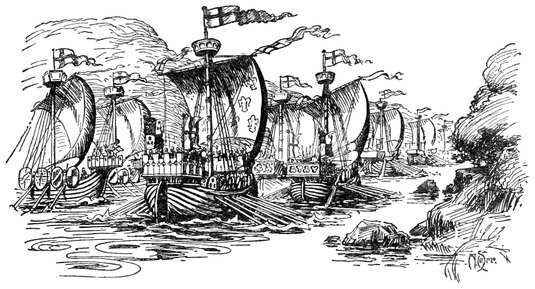
If ever a fleet of ships was tried it was this expedition from the Devonshire village. They were not many days out and had not yet said farewell to the Bay of Biscay before they were caught in bad weather and the fleet scattered. But it is certain that this fleet140 accomplished what it did partly owing to the fact that every day at sea gave them greater experience, and partly because they were well found, or as well found as ever ships of that period could be. We can note the mind of a far-seeing man in the care with which these craft were fitted out. Thus, for example, in bad weather there was every chance of the steering oar being carried away or being broken into half. To guard against such an awkward possibility each ship went forth from the cliffs of Dartmouth with a number of spare steering oars. Another very likely article to carry away on a long voyage, involving bringing-up in all sorts of places, was the anchor. Each principal ship, therefore, carried no less than thirteen of such, though it should be added that of these some consisted of grapnels used in getting alongside the enemy and fighting hand to hand. There were spare oars also, two spare sails, three sets of halyards, stays, and other ropes—everything, in fact, except the mast and the ship’s boat was carried in duplicate. There were knights in armour, infantry, horses, and victuals for a whole year to be stowed away in these ships, so a great deal of thought had to be expended.
If we had been able to look down on to the harbour of one of the Cinque Ports of the thirteenth century and watched some of the contemporary ships getting under way, we should have been struck with the extreme simplicity of their seamanship. And in the fewest words I propose now to sketch very roughly the manner in which such craft would put to sea. I am assuming nothing which cannot be verified by actually existing historical data. Picture, then, a modified Viking type of ship with good freeboard, high stem- and stern-posts, with a castellated structure at each end, and a mast stepped about midships and supported by shrouds and backstays. The crews go on board. These consist of the141 masters or “rectores.” Under them come the steersmen or “sturmanni,” who were responsible for the piloting of the ship. They would possess more knowledge than anyone else of their own waters and adjacent havens.
The crew consisted of three classes. First of all were the “galiotæ” or galley-men. These I understand to be the men who did the rowing as in the Viking ships. The second class consisted of “marinelli,” who may have been the fighting men of the ship; and the third division was found in the “nautæ” or sailors, who were obviously the men that went aloft, got up anchor, set and furled sail, worked the sheets, and did the deck work. On these ships there were usually about forty hands carried; but there are instances of seventy being the full complement. In such cases as the last-mentioned there was a superior officer carried in addition to the usual officers and crew. Life on board these ships was certainly very different from that which the modern seaman finds on the sail-less steamship. But these rude, virile seamen were well paid for their work; they had plenty of excitement to keep up their spirits, they were given their food and wine, even though their clothes were scanty and probably had to be found by themselves. But when they were wounded they had the satisfaction of being pensioned off.
Having repaired on board, then, we see the “rector” at the helm, while some of the crew are forward hauling up the ship’s cable by the bows. This cable leads aft, where it passes round a windlass that is turned by other members of the crew with handspikes. Meanwhile one of the crew by the aid of his hands and knees climbs up the backstays to let loose the lashing which keeps the squaresail furled to the yard. Note that the sail is not lowered or raised to or from deck, but kept permanently142 aloft. Before he has allowed the canvas to be unfurled, and before the anchor has been broken out from the ground, a couple of trumpeters mount the top of the stern-castle and blow their notes to warn any incoming craft that they are emerging. It is exactly analogous to the blowing of a modern steamship’s syren when the big liner is clearing from her port.
The thirteenth-century ship, then, puts to sea. She has both oars and a sail, she has an able crew, she has a good, strong hull of a healthy seaworthy type. She is ready for anything that comes along. If the wind fails, then she can send a man aloft to furl the sail and her crew can get out their oars. If it comes on to blow very hard indeed, she can take in one, two, or three reefs by means of reef-points as to-day. And then when the enemy is espied and the time comes for battle, the fighting men can prepare swords, axes, bows and arrows, lances, and engines for throwing heavy stones, while some of the men go aloft and climb into the fighting top, from which they are ready to hurl down those heavy stones which crashed through an enemy’s decks. For it is certain from contemporary illustrations that these ships were now no longer mere open craft.
In their fighting methods brute force was chiefly relied upon; but not always. That deadly mixture known as Greek fire, which was some sort of mixture containing principally pitch and sulphur, was a very efficacious method of routing the enemy when the methods of grapnels, swords, arrows, and stones were not all-availing. As soon as this Greek fire was exposed to the air it became ignited, and there flowed a stream of fire over ships and sea creating wholesale panic. It could not be extinguished by water; only vinegar or sand or earth could put it out. Wherever it went it143 burnt up hulls, spars, and sails, suffocating the terrified crews in a very short time. Ramming, as a naval manœuvre, was far from obsolete in the Middle Ages, as we know from actual incidents in literature and pictorial representation.
It would not be correct to assert that there was a total disregard of tactics in medieval times. When Richard was cruising with his fleet in the Mediterranean at the time of the Crusades, he caused his ships to sail in eight separate lines, each line being within trumpet call of the other. Richard himself was in the eighth line as commander-in-chief. Treatises on naval tactics had been written by Mediterranean experts, but I do not think that there is any evidence for supposing that the English seamen ever learnt such a thing until Richard’s ships went to the Mediterranean. So much happened for improving maritime matters subsequent to that Crusade that we need not be surprised to find, less than thirty years later, the English seamen for the first time in northern waters exhibiting an appreciation of all that tactics meant in battle. We have not space here to go into the battles, but you will find the first instance of this new knowledge in that naval encounter which took place in August of 1217 off the South Foreland. Notwithstanding that the fleet of Eustace the Monk was numerically far stronger than ours, yet by clever tactical manœuvres our ships and men not only prevented his from landing, but inflicted a heavy slaughter and defeat upon the invaders. The English commander was Hubert de Burgh, and to his cleverness the success was due. Sixteen large, well-armed craft were his ships, with twenty smaller ships; or a total of thirty-six. Eustace had eighty, or more than twice as many. The key to the victory was simply this. When the enemy’s ships were seen to be sailing with a fresh southerly breeze from the French coast, the144 English fleet put to sea, stood on till they were well to windward, and then easing their sheets bore down on to the invaders with a fair wind, hooked on to them with grapnels, shot at them with arrows and threw unslaked lime at the Frenchmen, with the result that the breeze carried both arrows and lime exactly where the English had wanted—to leeward. With this confusion the English boarded them and hacked away at the halyards so that mast and sail came down, burying many on the confused deck. After that the victory was easy.
Now such a well-thought-out plan of fighting shows that naval warfare had in England already reached the scientific stage. If the reader will take his chart of the Straits of Dover and work out the manœuvres which I have given in greater detail elsewhere,22 he will see that the English admiral displayed a perfect knowledge of the Channel tides, seamanship, and naval tactics in thus outwitting a force twice his own strength. And again, at the battle of Sluys, the victory was won by the superior tactics of the English, which showed excellent seamanship, perfect knowledge of the Flemish tides, and sound judgment in the problems of the sea. The English in 1340 played the same game as they had in 1217. They confused the enemy, who wondered why the English fleet were apparently going away from them. They wondered still more when, after standing out to sea, the English went about and came down on them like a pack of sea-monsters eager to devour them and successful in the attempt. So also exactly ten years later, in that very interesting battle of Les Espagnols sur Mer, which is unknown to many a modern layman, when Edward II commanded in person, we find everything being done by system and plan. He comes down with his Court to lodge near the sea. He himself goes145 afloat, spends a long time in training manœuvres, keeps a look-out man at the masthead who suddenly spies the enemy coming down Channel, when, to quote the words of Froissart, he ordered the trumpets to be sounded and the ships “to form a line of battle.” The rest is merely a narrative of collisions between ship and ship, with masts and sails falling, chains and grapnels straining, the hurling of stones and iron bars from the castle at the masthead, the felling of one another’s masts, the cutting adrift of the enemy’s halyards and shrouds, the heaving overboard (a favourite and regular habit in war) of every man and boy of the enemy they could lay their hands on, and finally victory to the English.
Even coasting voyages during the Middle Ages were risky proceedings, with no charts of the English coast—at any rate, none that were of much good—and with no regular lighthouses to warn the mariner off outlying dangers: only through the charity of the monastic establishments, such as that on St. Albans Head, were lights kept burning at night on a few promontories. It may be that it was out of gratitude for such kindness that the mariner lowered sail when he passed a monastery on the shore. As to the ships themselves of this time, we know that the planking was fastened not by iron and copper nails, but by wooden pegs called treenails. The hulls were painted with pitch, tar, oil, and resin. In these early accounts there is a reference to the “seilyerdes,” and the sail itself consisted of twenty-six cloths. The latter was painted red, possibly tanned something like the modern sailing trawlers, and the canvas was fitted with “liche-ropes,” “bolt-ropes,” and “rif-ropes.” From Viking times bonnets were laced to the foot of the sail to give increased canvas for use in fine weather.
When it was that the word reef was first employed cannot be ascertained, but it is found in literature146 (“Confessio Amantis”) in the year 1193, or three years after Richard’s fleet set out to the Mediterranean. Here the word “ref” or “rif” clearly denotes something that could be slacked off. But there seems to be some possibility of confusion between the device by which sail can be shortened and that “bonnet” by which the sail’s area can be increased. During the early part of the fourteenth century the rudder began to disappear from the quarter where it had been since the times of the Egyptians, and to be placed astern in the position it occupies to-day. This necessitated the use of chains, the iron for which, as also for the anchors, was fetched from Spain. But there is reference concerning these medieval ships to such items as “steyes” and “baksteyes,” “hempen cordage,” “cranelines” for securing the forestay at its foot, “hauceres” (hawsers), “peyntours” (painters, derived from the French word signifying a noose), “boyeropes,” for the cables, “seysynges,” “botropes,” “schetes” for the clews of the sail, “boweline,” “saundynglyne” for the use of the pilot-leadsman, “shives” and “polives,” tallow, hooks, and so on.
The anchors of the king’s galleys were 7 feet long, and his great ship carried five cables. Under the “rectores” were the “sturmanni” or steersmen, who were responsible for the supervision of the seamanship on board. Next in order came the “galiotæ” or galley-men, and finally the “marinelli” or mariners and the “nautæ” or common sailors. Later on the “rector” became “magister,” a constable was chosen to look after the arms, and there were added also a carpenter, a clerk who presently became purser, and a boatswain.
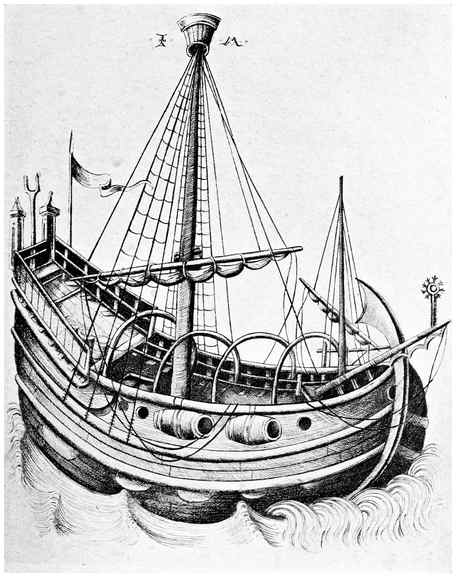
But if we would wish to get an insight into the life and conditions on board an English sailing ship of the Middle Ages, we can find no more illuminating information than is contained in a MS. now in the possession147 of Trinity College, Cambridge. This depicts the troubles and tribulations on board a pilgrim ship of the time of Edward III, written by a contemporary. In explanation of this poem given below, it should be added that the carrying of pilgrims to the shrine of St. James was a regular branch of the shipping trade. In those days no less than in the present century the miseries of sea-sickness and general discomfort associated with sea-travel were a nightmare to the landsman. But this quaint poem, which is the earliest sea-song in existence, so well portrays the life of the seafaring man that it is most probably the composition of a sailor accustomed to pursue his calling on one of these merchant ships. Alternatively the author was a landsman who had kept his eyes and ears open during the voyaging and noted accurately the work on shipboard. The poem begins gloomily enough and describes the getting under way, the hoisting of the ship’s boat, the setting sail, trimming sheets, and the accommodating of the passenger-pilgrims. In spite of the archaic spelling and phraseology it is surprising how modernly this sea-song reads and how truly it seems to depict contemporary ship life.
150
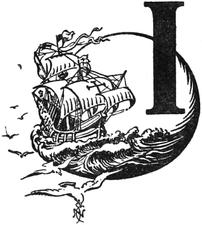
It is curious to observe, as one reads history, that many an invention, or a practical idea belonging to modern times, has really existed for century and century, though in an undeveloped condition. The modern liquid compass is an excellent instance.
But inasmuch as the ship is at the mercy of the sea, and since the sea is a continually undulating entity, a compass which does not have a corresponding adaptability is inadequate. This fact, as one might naturally suppose, was appreciated by the early navigators. Ford43 quotes Bailak Kibdjaki, an Arabian writer of A.D. 1242, and shows that at least a crude kind of liquid compass was in use by the Oriental navigators. “The captains navigating the Syrian Sea,” says Kibdjaki, “when the night is so dark as to conceal from view the stars, which might direct their course according to the position of the four cardinal points, take a basin full of water; they then drive a needle into a wooden peg or cornstick, so as to form the shape151 of a cross, and throw it into the basin of water, on the surface of which it floats. They afterwards take a loadstone of sufficient size to fill the palm of the hand, or even smaller, bring it to the surface of the water, give the hand a rotary motion towards the right, so that the needle turns on the water’s surface. They then suddenly and quickly withdraw the hand, when the two points of the needle face north and south. They have given me ocular demonstration of this process during our sea voyage from Syria to Alexandria in the year 640 of the Hegira.”
By the thirteenth century the people dwelling along the Mediterranean littoral had long since become skilled seamen if not consummate navigators. There is in the British Museum a volume by Francesco da Barberino, entitled “Documenti d’Amore.” The author was born in 1264, and in the ninth lection of this volume has so much to say about nautical service that this forms what is really the first work on seamanship that was ever written. Space will not allow more than a cursory reference to this, but it contains evidence of the system into which the Mediterranean sea-service had developed. The old custom which was in vogue during classical times of limiting the sailing season to certain months was retained. Thus Barberino remarks that the time for navigation was from April to the end of September. Furthermore it was not custom merely, but actual law. For maritime legislation had originated during the twelfth century, and was continued in the “Loi de Trani,” the “Code Navale des Rhodiens,” the “Code de la Mer,” and the famous Laws of Oleron. In fact only the lawless, avaricious merchant captains ventured to put to sea in the other six months of the year; none but these cared to venture forth sailing through the long dark nights, and the fogs, storms, and snow.
152 Before the Iberian peninsula became so intimate with the problems of navigation, Venice was, of course, the great medieval home of the southern sailor, and those in authority saw that the marine affairs were properly looked after. The captains of all commercial ships sailing under the Venetian flag were, in 1569, forbidden to leave Alexandria, Syria, or Constantinople any time between November 15 and January 12. Such was the motherly care displayed for the State’s shipping; but it is only fair to add that before very long such restrictions on navigation were removed.
Very interesting, too, is the advice which Barberino gives to pilots. Remember, if you please, that the Mediterranean was the happy hunting ground of professional pirates, and never a merchant ship put to sea on a long voyage but she ran the risk of encountering these corsairs. Therefore all pilots of trading craft were advised to make their ships as little visible as possible. It is well for them to lower the white sail when clear of the land and to hoist a small black one. Especially at break of day is it unsafe to lower sail until out of sight of the shore. “Then,” suggests Barberino, “send the top-man aloft to see if an enemy be in sight.” Many another useful “wrinkle” is given, as, for instance, how to act when the rudders carry away. Apparently the old classical custom of a rudder affixed to each quarter, and both a small and large mast and sail, was still retained. That smaller black sail just mentioned was known among the Venetian seamen by the nickname of “wolf,” from its colour and cunning. The mainmast being carried away, then the smaller one, usually employed for the “wolf,” was stepped and used. And if, in turn, that also went by the board, then the lateen yard was to be used until dawn returned. There are directions, also, to make a jury-rudder by towing a spar astern.
153 During the night, as these ships sailed along over the heaving Mediterranean and Adriatic with a great belly of canvas reaching down from the massive lateen yard, strict silence was maintained on board. After dark not even the boatswain was allowed to use his whistle, nor were bells to be sounded—not an avoidable noise of any kind was to be suffered lest the presence of the richly laden trading ship should be suddenly revealed to some pirate hovering in the vicinity. The earliest Venetian statutes affecting ships belong to the year 1172, and these, after being considerably amplified in the thirteenth century, were again added to in the fifteenth, after the conquest of Constantinople. Every possible detail seems to have been regulated in connection with these merchant ships. The general supervision was attended to with the most meticulous care. The construction of these merchant ships themselves, the quantity and quality of their cargo, the number of their crew, their anchors, ropes, and gear generally, all came under this control.
Additional to the crew there were carried a couple of scribes on each of these trading ships, for the purpose of keeping an exact account of the freights. The skipper, or padrone, was compelled to be on board his ship by the hour of departure, and was not allowed to quit his ship till she reached her port. The accommodation for passengers and crew was probably but primitive, and they apparently catered for themselves; for each man, whether one of the crew or the passengers, was suggestively permitted to bring with him a mattress and cushion, a trunk for his belongings, a flask of wine, a flask of water, together with flour and biscuit. Even in the early seventeenth century the men on the Spanish warships used to cook each for himself, in contradistinction to the English seamen, who had their meals prepared by the ship’s cook. Though154 the Venetian ships up till the fifteenth century did not dare to venture out into the “Green Sea of Darkness,” as the Arabs termed the Atlantic, yet we cannot afford to despise ships and men who regularly traded between the Adriatic and the Levant. Even a modern sailing ship would have some difficulty in beating the passage which one of these craft made in the year 1408, when she sailed from Venice to Jaffa in thirty-three days, calling at various ports on the way.
Venice might have continued to hold the supreme position on the sea had not Portugal and Spain taken to the ocean, and studied the problems of navigation on a much grander and more scientific scale. The discovery of America, and the doubling of the Cape of Good Hope, the opening up of a sea route to India, all combined to take away from Venice her commercial prestige, at any rate afloat. Relying partly on the newly adopted magnetised needle, partly on their crude astronomical instruments and tables of the movements of sun and moon; trusting also to the most careful observations of weather, colour of the sea, seaweed, tree branches and other objects found floating on the surface of the ocean; noting carefully by night, as mariners for centuries before them had been careful to notice, the north star and other stellar bodies; but at the same time lacking reliable knowledge of ocean currents and trade winds—the Portuguese discoverers were able to keep the sea for months, independent of and out of sight of land, an achievement which had not been brought about since the days when the Phœnicians circumnavigated Africa. Venice had had her day; just as Egypt, Phœnicia, Greece, and Rome before her, just as Spain, England, Holland, and France later on were to become great maritime Powers.
And so we come to that prince of navigators, that155 consummate seaman, that greatest of all maritime discoverers, Columbus, and we shall proceed to learn from contemporary accounts the kind of seamanship and navigation which he employed on his memorable voyages, the life which he and his companions lived in those historic cruises into the unknown. Happily Columbus’s log is still preserved to us. Even though it is somewhat mutilated, yet it is full of illuminating information, and must be regarded as “the most important document in the whole range of the history of geographical discovery.” The methods, the instruments, even the ships employed by Columbus were merely typical of the best which then were used. Emphatically they were not otherwise. Therefore if we note carefully the ways of the Santa Maria, the Pinta, and Nina, we are really focussing the most expert seamanship and navigation of the fifteenth century. There were certainly ships afloat as good as, if not better than the Santa Maria; but what is to be remembered is that those illustrious explorers of the fifteenth and sixteenth centuries were really expert navigators, and not merely daring seamen, astute traders, or courageous soldiers. Columbus, Drake, Davis, and so on were, according to their times, really scientific men. I wish to emphasise this because the world is wont to admire their valour and enterprise while forgetting their mental abilities and achievements. As we shall see presently, Columbus’s navigation was always better than that of the skippers of the Nina and Pinta. Drake was an excellent navigator, especially in regard to astronomical navigation. Davis, as anyone who cares to read his works may see for himself, was most learned in the theory of finding one’s way across the trackless sea.
In the light of modern knowledge, modern practice, and modern nautical instruments, some of the errors in156 navigation of those days may seem to us ridiculous, until we recollect that these men were really fumbling in the darkness with nothing to guide them except moderate knowledge, inefficient aids, and their own natural instincts. Long before Christopher Columbus set out to the westward he had studied cosmography and astrology at the University of Pavia. He had also visited Lisbon, whither the fame of the achievements of Prince Henry the Navigator’s illustrious captains had attracted other capable seamen, among whom were such men as Da Gama, and his own elder brother Bartolomeo. At this time Lisbon was still the centre of all nautical and geographical enterprise. Here Bartolomeo was working as the head of a school of cartography, and here Christopher had every opportunity for studying the charts and logs of the greatest living sea captains after Bartolomeo had returned home. He had the dual advantage of learning all that both Genoa and Lisbon could teach him. Furthermore, he was a practical seaman, and had already sailed as far to the north as Iceland.
We need not stop to inquire whether Columbus was aware that already many years before his time the Vikings had discovered North America. It is at least most improbable that he was aware of this fact. What is certain is that, fortified with all the nautical lore obtainable from the greatest living Peninsular sea captains, he set out with a firm conviction that the world was a sphere, and he was hoping to prove that conviction. Himself a gifted cartographer, he would make his charts as he went along. From Palos, then the most flourishing port of Andalusia, a village that contained little else among its inhabitants than some of the finest seamen-explorers in the world, he set sail with a fair wind on August 3—a Friday—1492, in the Santa Maria. Accompanying her were the two smaller157 craft Nina and Pinta. “Carabela” was not then applied to a particular species of ship, but only to certain vessels of medium tonnage suitable for the diverse purposes of fishing, coasting, and exploring.44 In the Columbine Library at Seville there is a map of Española drawn with a pen. In two places are seen outline sketches of three sailing craft. Competent critics affirm that these sketches were made by Columbus, and depict his squadron of three during his first voyage to the West in 1492. If this opinion be correct, then it is certain that the first ship was three-masted, so was the second—doubtless the Santa Maria, the biggest of the three—but the third ship is only two-masted. The first and second ships have a small square foresail on the foremast; square mainsail and topsail on the main, with a lateen on the mizzen. But the third ship has a lateen on both masts.
The Santa Maria carried a crew of seventy, together with artillery and stores enough for one year. In addition she had a large amount of merchandise, which she could barter with the natives. Her displacement has been estimated as about 200 tons, and some modern writers have suggested that this was all too small a ship to cross the Atlantic. Columbus, however, thought otherwise; for on his second voyage he had demanded smaller vessels, his reason being that those of his first expedition, on account of their size and draught, had caused him so much anxiety. As to the canvas which the Santa Maria carried, this matter is instantly settled by reference to Columbus’s own log. If we refer to his entry dated Wednesday, October 24, we find that: “I remained thus with little wind until the afternoon, when it began to blow fresh.158 I set all the sails in the ship, the mainsail with two bonnets, the foresail, spritsail, mizzen, maintopsail, and the boat’s sail on the poop.” (The bonnets were additional pieces of canvas laced on to the foot of the sail)45.
The time on board was evidently kept by hour-glasses of half or a whole hour. Thus under date of Tuesday, January 22, when homeward bound, his log reads: “They made 8 miles an hour during five glasses ... afterwards they went N.E. by N. for six glasses.... Then during four glasses of the second watch N.E. at six miles an hour.” But the reader must be cautious not to accept the speed given as conclusive. One of the greatest drawbacks to navigation in those days was the absence of any instrument which would record the speed through the water. The log had yet to be invented, and the mariner could only make a conjectural estimate of the ship’s speed by looking over the side and noting the time it took the bubbles to come aft from the bow, or by throwing a piece of wood overboard from the bows and noticing how long it took for the stern to be abreast of that object. Many a steamship traveller gambling on the ship’s speed does the same thing to-day; many a fore-and-aft sailorman with no patent log still employs a similar method.
Columbus’s journal shows the kind of helmsman which he had to put up with. On September 9, when the ship’s course was west, the narrator on board wrote: “The sailors steered badly, letting the ship fall off to N.E., and even more; respecting which the Admiral complained many times.” On September 13 Columbus observed a variation in the compass. “On this day,159 at the commencement of the night, the needles turned a half point to N.W., and in the morning they turned somewhat more N.W.” For up till then no one had observed the variation of the needle.
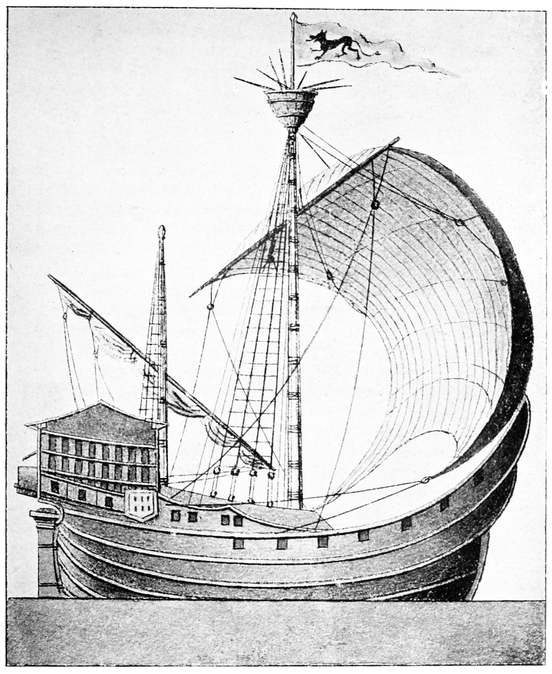
Fifteenth-Century Caravel.
Drawn from a woodcut after a delineation by Columbus in the Latin translation of his letter dated March 1, 1493, to Don Raphael de Sanxis (Treasurer of the King of Spain), in the Library at Milano.
(See next plate.)
No navigator could have been more careful than Columbus. Ever on the alert, he was far too anxious about the safety of his fleet to neglect one single precaution. As they voyaged, the difference in the saltness of the sea was noted; and though for eleven days the wind blew steadily from aft so that the sails required no trimming, yet all the while Columbus was busy with astrolabe and sounding lead endeavouring to fix his position in regard to the land which they had long since left. From Wednesday, February 13, till the following Saturday, he never slept a wink, being far too anxious to leave the navigation to others. The pilots of the Nina and Pinta on the voyage out used to work out their positions for themselves. On September 19 the Nina made the Canaries to be 440 leagues astern, the Pinta estimated the distance as 420, but on board Columbus’s ship the reckoning was 400 leagues, and this was the most correct of the three. (It should be added that Columbus used Italian miles, reckoning four Italian miles to one league.) He compared notes with the pilots under him, and manœuvred his ship so that the captain of the Pinta was able to pass his chart on board the Santa Maria at the end of a line. Columbus, after conferring with his own pilots and mariners, plotted on the chart the position of the ship. Here and there all the way through Columbus’s journal, both in those lines written by his own hand and in those in another handwriting, there rises up, quite clearly, evidence of the knowledge which this man had been collecting before setting out. “The admiral was aware,” says the Journal, “that most of the islands held by the Portuguese were discovered by160 the flight of birds.” Just as the Viking seamen had discovered land in exactly the reverse manner—by letting loose birds from the ship.
Nor are there lacking plenty of references to the seamanship of these times—the kind of seamanship, we may not unjustly assume, that was employed alike by the Spanish traders who crossed the Bay of Biscay, and sailed up the English Channel to Flanders, and those who went exploring to the southward. No one better than these medieval and Elizabethan sailormen appreciated the importance of having a ship that would heave-to in bad weather or at night. You will remember that dramatic incident at the end of Columbus’s first voyage across the Atlantic, when the distant light, as of a candle going up and down in the hand of someone proceeding from one house to another, indicated that at last the new land had been found. “At two hours after midnight,” says the log, “the land was sighted.” Then (continues the narrative), “they shortened sail, and lay by under mainsail without the bonnets. The vessels were hove-to waiting for daylight.”
And again, when on the homeward voyage after the loss of the Santa Maria the Nina was caught in a heavy gale of wind, we find from her log that she stowed canvas, but “carried the mainsail very closely reefed, so as just to give her steerage-way, and proceeded thus for three hours, making 20 miles.” During that same dreadful night, when they all but foundered, Columbus kept showing lanterns to the Pinta, which answered back by the same method. “The want of ballast increased the danger of the ship, which had become light owing to the consumption of provisions and water,” so they filled with sea water the barrels which had contained wine and drinking water, and employed these to steady the vessel. “Afterwards,”161 continues the same narrative, “in the showers and squalls, the wind veered to the west, and they went before it, with only the foresail, in a very confused sea for five hours. They made 2½ leagues N.E. They had taken in the reefed mainsail, for fear some wave of the sea should carry all away.” And when the weather presently moderated, Columbus “added the bonnet to the mainsail.”
The Santa Maria, with her high poop and forecastle, was not a particularly dry ship. On September 8, when outward bound, her log admits that near Teneriffe she “took in much sea over the bows.” But whether that was through bad seamanship or bad luck one cannot say. It is certain that, at any rate, the crew were very far from perfect in their art; otherwise the Santa Maria would never have been wrecked in that totally inexcusable manner. It was not the fault of Columbus. He had not had any rest for two days and a night, and those of us who have been ceaselessly on watch for that time, know how great a strain it puts on a man’s eyes and nerves and physical endurance. So, as the wind was very light, Columbus went below at eleven o’clock that night. It was so beautifully fine, and the sea was so calm, that the steersman also was tempted to sleep; and, giving the tiller in charge of a boy, he shut his eyes and dozed off. This was distinctly contrary to Columbus’s orders, for the boys were forbidden ever to touch the helm. At midnight, you will remember, there was a flat calm, but still imperceptibly the poor Santa Maria was being carried on to a sandbank by the current. Very gently she took the ground, but when the boy noticed that the helm refused to move, but that the tide was rushing by the ship and tumbling over the shoal, he became alarmed and cried out. Up came Columbus from his cabin under the poop, who, taking in the situation at a162 glance, began to give his orders in a cool and seaman-like manner. The first command showed that he knew his business, when he had ordered a boat on the poop to be lowered, and the crew to “lay out an anchor astern,” as the log states, to haul her off. But the men in the boat, being less anxious for the safety of the ship than for their own bodies, paid no regard to the kedging of the Santa Maria, but rowed off to the next ship. Then, finally, Columbus was compelled to order the masts to be cut away, and the ship to be lightened; but it was of no avail. The water rose inside, and her timbers opened. But right to the end Columbus the discoverer showed that he was every bit as fine a seaman as he was a clever navigator.
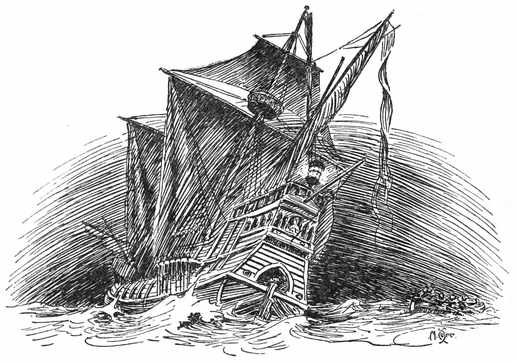
If we would endeavour to fill in the details to our163 mental picture of the Santa Maria, we can find much that is interesting. We have already been thinking of her as a three-masted caravel. Let us step on board and tread her single deck at the waist between the foremast and main. As we examine the gear we shall find it rough but strong. The cordage is of hemp, the masts are serviceable, but only rudely finished. The mainmast measures 2½ feet in diameter, whilst the yards—like the yard of the lateen-rigged craft—follow the historic custom of the Mediterranean of being made of two pieces lashed together at the centre. Aloft flies the admiral’s flag of Columbus, and this he always carried in his hand when going ashore to take possession of newly discovered territory.
The hull seems to have been constructed somewhat roughly, and iron nails are already showing their rusty contact with the sea water. There is precious little ornamentation, too, for there was not much decoration expended on ships in those days, and certainly not on a Flemish merchantman. The hull was painted with tar, whilst below the water-line it was greased so as to minimise the friction through the water. To do this it was customary to beach the ship, and on two occasions during his voyage Columbus saw that this was done. On deck a couple of hatchways led to the hold. The quarter-deck extended from about midships to the stern, and above this rose the poop-deck. On the latter were the quarters of the admiral. We know from this journal that Columbus’s bed was draped in red, and that there was certainly room for several persons to be seated in this cabin. There was a press for his clothes, a stool, a couple of chairs, and a dining-table for two persons, the furniture being all fashioned in the Gothic style which was then prevalent. Add to this inventory charts and books, as well as an astrolabe, and you have the picture of his cabin complete.
164 When getting under way, the Santa Maria shipped her anchor by means of the fore yard-arm. In those days there was of course no steering wheel, but the tiller came right in under the quarter-deck, and a bar was attached to the forward end of the tiller. There is and has been for so many centuries such a close relation between ships and hammocks that it is interesting to observe that hammocks were introduced by Columbus and his companions after contact with the West Indians, who were accustomed to use them. We cannot, indeed, envy the life of the seamen on these Columbine ships. There was certainly a galley made of brick with an iron cross-piece, but the food, which consisted of bacon, beans, salt fish, cheese, and bread, was, thanks to the heat and damp of the hold, in a very bad condition.
We shall speak in greater detail on a later page concerning the astrolabe, but whilst we are considering these fifteenth-century ships and the surprisingly good landfalls which Columbus made, it is worth while to remember that observations were frequently made only with great difficulty. “The North Star,” says the log, “appeared very high, as it does off Cape St. Vincent. The Admiral was unable to take the altitude either with the astrolabe or with the quadrant, because the rolling caused by the waves prevented it.” We cannot be positively sure of all the crew which sailed on board the Santa Maria, for some of the papers which could have helped the historian are missing. But, in addition to Columbus, she carried one master, two pilots, a surgeon, a quartermaster, a clerk, an interpreter, a carpenter, a caulker, a cooper, a steward, a gunner, and a bugler, as well as the gentlemen adventurers, their servants, and the seamen.

Fifteenth-Century Caravel.
This is the same ship as in the preceding plate, but shows mizzen set.
There was a never-failing fear of fire on these ships, and stringent rules forbade lights after dark, except one165 for the helmsman and one below deck when carefully protected by a lantern. Columbus’s ship carried a lantern at the stern, mica being used at first and subsequently glass. There was a strong religious atmosphere that must not be lost sight of in considering the ship life as exhibited on board Columbus’s fleet. Dominating the whole expedition was the intention to glorify God, to spread His kingdom on earth. As you read through this log you find the crew mustering to sing the “Salve” before the statue of Our Lady—“Stella Maris.” On her festivals, and on such historic occasions as when he made land, Columbus was wont to dress ship. So, too, before the expedition left the mother-land for the Indies, every man made his will and went to confession and communion, so that he might come on board in a state of grace. And there were stringent rules on board to prevent blasphemy, excessive gambling, or doing anything to the dishonour of the king.
Equally illustrative of the ways and methods of the seamen at the end of the fifteenth and the beginning of the sixteenth centuries are Columbus’s letters dealing with his subsequent voyages. One of these letters he concludes thus: “Done on board the caravel off the Canary Islands,” and signs himself “The Admiral.” Some idea of the speed of his ship during his second voyage to the West Indies may be seen from the letter addressed to the Chapter of Seville by Dr. Chanca, physician to the fleet, in which he states that in two days, with fair wind and weather, they made fifty leagues. But the Capitana was such a slow sailer that many times the others had to shorten sail. On the first voyage the Nina similarly had to wait for the Pinta to catch her up, and this lack of homogeneity in the fleet certainly lost them much time.
In order to ensure a careful look-out being kept, a handsome reward had been promised to the first man166 sighting land. This was claimed “on the first Sunday after All Saints, namely, the third of November, about dawn,” when a pilot of the Capitana cried out: “The reward! I see the land.” Of all the ship’s company, Columbus himself excepted, the pilots were the smartest and most skilful men, who “could navigate to or from Spain” “by their knowledge of the stars.” We see Columbus on his third voyage displaying all those characteristics of the cautious manner which had distinguished him already. There was little enough that he left to chance. When he was entering a strange haven, he used to send a boat out ahead in order to take soundings. (His ship the Santa Maria had a large boat about 30 feet long which was usually towed astern, and a smaller boat about 10 feet long which was hoisted on deck.) “I passed thirty-three days without natural rest,” he writes in connection with his second voyage.
Speaking of his navigation during the third voyage, he tells us that “at the end of these eight days it pleased our Lord to give me a favourable east wind, and I steered to the west, but did not venture to move lower down towards the south, because I discovered a very great change in the sky and stars.... I resolved, therefore, to keep on the direct westward course in a line from Sierra Leone, and not to change it until I reached the point where I had thought I should find land.” On the return journey he writes: “As to the Polar Star, I watched it with great wonder, and devoted many nights to a careful examination of it with the quadrant, and I always found that the lead and line fell to the same point!” And as he sailed he wondered in his mind. Where never a ship, never a man had voyaged before Columbus had gone. What, after all, was the shape of this earth? “I have always read,” he says, “that the world comprising the land167 and water was spherical, and the recorded experiences of Ptolemy and all others have proved this by the eclipses of the moon, and other observations made from east to west, as well as by the elevation of the pole from north to south. But ... I have come to another conclusion ... namely, that it is not round as they describe, but of the form of a pear.”
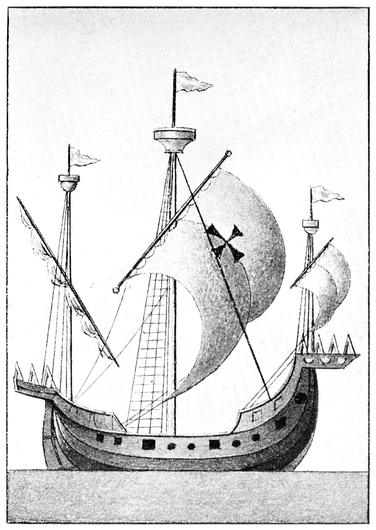
Three-Masted Fifteenth-Century Caravel.
Drawn from a woodcut after a delineation by Columbus in the Latin translation of his letter dated March 1, 1493, to Don Raphael de Sanxis (Treasurer of the King of Spain), in the Library at Milano.
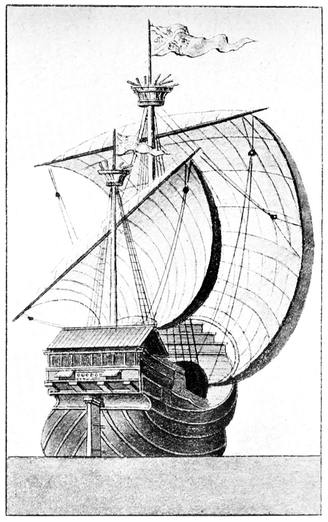
Sixteenth-Century Caravel at Sea.
After the woodcut of Hansen Burgmair, in the History of Emperor Maximilian the First, compiled by Marx Freithsauerwein in the year 1514.
For his fourth voyage he had most favourable weather. He got from Cadiz to the Canaries in four days, and thence to the West Indies in sixteen days. But then a great storm came down and lasted eighty-eight days, during which “my ships lay exposed, with sails torn, and anchors, rigging, cables, boats, and a great quantity of provisions lost.” Finally, on January 24, his ship broke both her cables and her bollards. “I departed in the name of the Holy Trinity, on Easter night, with the ships rotten, worm-eaten, and full of holes” ... “and in this condition I had to cross 7000 miles of sea.” “My ships were pierced with worm-holes, like a bee-hive.” “With three pumps, and the use of pots and kettles, we could scarcely with all hands clear the water that came into the ship, there being no remedy but this for the mischief done by the ship worm ... the other ship was half under water.” But Columbus never lost heart, never failed to believe in scientific navigation. Where had he got to; whither had his ship attained? “I ascertained, however, by the compass and by observation, that I moved parallel with the coast of terra firma.” “There is a mode of reckoning,” he observes, “derived from astronomy which is sure and safe, and a sufficient guide to anyone who understands it.”
And there are two very interesting comments which he makes as a seaman rather than a navigator that ought certainly to be noticed. The first occurs in his initial voyage across the Atlantic; the second in a168 letter dealing with this last cruise. “Many times the caravel Nina had to wait for the Pinta,” runs the narrative, “because she sailed badly when on a bowline,46 the mizzen being of little use owing to the weakness of the mast.” ... “The India vessels do not sail except with the wind abaft, but this is not because they are badly built or clumsy, but because the strong currents in those parts, together with the wind, render it impossible to sail with the bowline, for in one day they would lose as much way as they might have made in seven; for the same reason I could make no use of caravels, even though they were Portuguese lateens.”
It will be remembered that the Nina had started out originally as a lateener, but this triangular-shaped sail was changed at Grand Canary to a squaresail before crossing the Atlantic. To “sail on a bowline” was to sail on a wind. In those days, when the cut of the squaresail was very bad, bowlines were really necessary for stretching the sails so that they set a flat surface without too much belly. The Pinta was apparently all right when running before the wind, but not much good close-hauled, owing to the fact that the mizzen-mast could not endure the strain. And similarly with reference to the second statement, Columbus makes it perfectly clear that these vessels had to be sailed “ramping full,” as we should say nowadays; it was useless to try to “pinch” them.
169
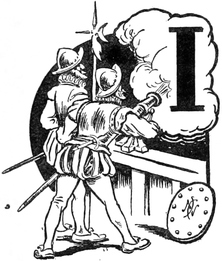
I make no apology to the reader for having taken up so much of his time in a consideration of the methods which obtained during the time of Christopher Columbus, not merely because by his splendid seamanship and navigation a new world was revealed to the old, but because of the two arts in question at the time when the Middle Ages were beginning to ebb into obscurity, he was one of the finest if not the very best exponent. Not that he was very amply rewarded for his wondrous achievements. Although it is true he did receive other remuneration, yet his pay was only at the rate of 1600 francs per annum, and that of his two captains was but 960 francs. The crew’s wages were from 12 to 25 francs a month in addition to their mess allowance.
But now we find ourselves in the sixteenth century. Thanks to the new interest in nautical matters which had been aroused by Prince Henry the Navigator, thanks to the marvellous and true yarns which ocean-going skippers brought back of their discoveries, there170 began a new sort of profession for men who were at all attracted to the sea. It was a profession which, obviously, could not exist for many, nor last for many centuries. But for those who were wearied of shore monotony, who had ambition and dash and loved adventure, there was a keen fascination in becoming one of that great band of “new land seekers.” Charles V, you will remember, became King of Spain in the year 1517, while the period of 1485 to 1547 was covered by the reigns of Henry VII and Henry VIII of England. Not till the year 1555 did Charles V retire into the monastery of Yuste. Besides the influence of these three remarkable men at a critical time of the world’s history, there was also roaming over Europe that Renaissance movement which, checked here and there, could not be utterly constrained when it spread itself over shipping. Or, to change altogether the metaphor, spring was in the air: the buds were about to burst forth into the glorious flowers of new colonies.
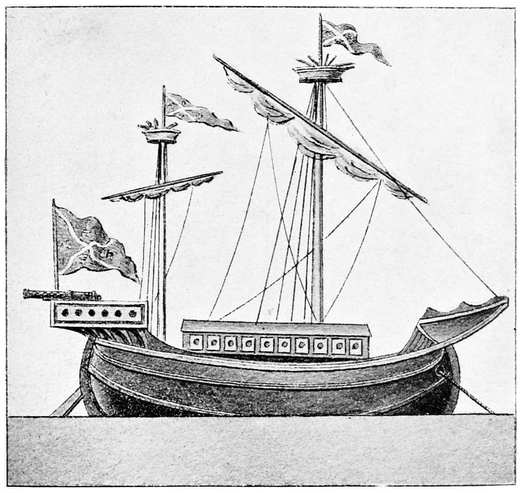
Sixteenth-Century Caravel at Anchor.
After the Woodcut of Hansen Burgmair.
And since it was obvious that discovery had to be made by traversing long expanses of ocean, and that this could only be done by a sound knowledge of navigation, those in authority were not slow to realise that lectures and instruction on this subject at home meant presently an increase of territory and wealth across the seas. Prince Henry on his promontory had been the first to grasp this. Now also Charles V not only established a Pilot Major for the examination of those who sought to take ships to the West Indies, but also founded a lecture on the art of navigation which was given in the Contractation House at Seville. Those anxious to qualify as pilots had to learn thoroughly the use of the astrolabe and quadrant, and obtain a thorough grasp of the theory and practice of sailing a ship from one port to another out of sight of land. For this instruction they had to pay fees, but171 it more than repaid them many times over when they were able to bring back such valuable commodities. Furthermore, as experience gains knowledge, so every voyage taught them something of their art which hitherto they had not known—the direction of a current, the state of the moon when high tide occurred at such and such an hour, the depth of those new harbours they had entered, the position of the outlying shoals, the landmarks on shore, the temper of the natives, the kind of commodities which could be obtained in the districts, and so on. The pilots brought all these details home at the end of every voyage, made the necessary corrections in the charts (and this not by choice, but by compulsion), so that always there was being compiled a set of sailing directions and an ever improving bundle of charts which were simply invaluable to State and seamen alike.
Thus also there came to be published treatises and manuals on the seaman’s art, for the instruction of a community that numbered very few sailors in proportion to its landsmen. Such authors as Martin Cortes, Alonso de Chavez, Hieronymo de Chavez, Roderigo Zamorano in time wrote these works, and their influence not merely on Spain, but upon England, was considerable, until the English seamen of the time of Elizabeth had produced such nautical experts of their own that they were able to write better books themselves. But even prior to that time England had begun to see the wisdom of Spain; and Henry VIII, following the example of Charles V, “for the increase of knowledge in his Seamen, with princely liberalities erected three severall Guilds or brotherhoods, the one at Deptford here upon the Thames, the other at Kingston upon Hull, and the third at Newcastle upon Tine.” So, indeed, states Hakluyt. That at Deptford was licensed in 1513, “in honour of the Holy Trinity and St. Clement in the172 Church of Deptford Stronde for reformation of the Navy lately much decayed by admission of young men without experience, and of Scots, Flemings, and Frenchmen as loadsmen.” Navy is used here in its literal sense, meaning shipping as a whole. The word “loadsmen”—otherwise “leadsmen”—was the customary expression in the North of Europe for pilot. To this day the Dutch word for pilot is “loods,” “lood” being the Dutch for lead. What does this signify? It shows—does it not?—that until, thanks to Spain, the astrolabe began to be used in Northern Europe, the pilot was not so much he who found his way by fixing his position from the heavenly bodies, but he who felt his way by the sounding of the lead. In a sentence, then, whilst of course the lead and line are essential even to modern navigation, yet historically they belong to the Middle Ages and right back to Greece and even earlier; while the astrolabe and the finding of a ship’s latitude are essentially the beginning of that new order of things which we have already noted. So long as ships were content to do little more than coasting they had no need of an astrolabe; but as a lead and line are not much good to one who navigates the Atlantic to the West Indies, so the new species of voyaging coincided with the new instrument for ascertaining a ship’s position.

A Sixteenth-Century Astrolabe.
This instrument, in the S. Kensington Museum, is supposed actually to have been on board one of the ships of the Spanish Armada.
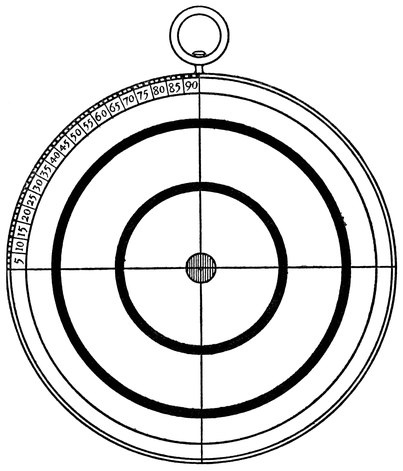
What, then, was the astrolabe? It was an instrument used for taking the altitude of the sun and stars. For two hundred years before it was used by the Christian seamen of the Mediterranean, it had been employed by the Arabian pilots in the eastern seas. The derivation of such a curious word is not without interest. The Arabic is “asthar-lab,” and this in turn came from the two Greek words, ἀστήρ and λαμβανω, meaning “to take a star.” It consisted of a flat brass ring, some 15 inches in diameter, of which an excellent173 illustration can here be seen. It was graduated along the rim in degrees and minutes, fitted with two sights. There was a movable index which turned on the centre and marked the angle of elevation. When the mariner wished to take the height of the sun with this instrument he proceeded as follows: The sun being near the meridian or south, the pilot observed the same until it reached its greatest height. Then, holding the ring on one of his fingers, he turned the alhidada up174 and down until he saw the shadow of the sun pass through both the sights thereof, being sure that the astrolabe hung upright. The astrolabe was best for taking the height of the sun when the sun was very high at 60, 70, or 80 degrees; for the sun, coming near “unto your zenith,” has great power of light for piercing the two sights of the alhidada of the astrolabe, and then it was not good to use the cross-staff (reference to which will be made below), because the sun hurt a man’s eyes and was also too high for the cross-staff. Furthermore the astrolabe, was a more correct method than that of the cross-staff.
It was thanks to the aid of Martin Behaim, a distinguished cosmographer who came to Lisbon to co-operate with the learned men there assembled, that an improved sea astrolabe was adapted for the purpose of determining the distance from the Equator, by means of the altitude of the sun or stars at sea. There had, indeed, been in use for some time a land astrolabe for finding the latitude of a place, and it was but a natural advance that this instrument should be adapted for use on board ship, so that the mariner might be able to ascertain his position on the vast expanse of trackless ocean. We are all most ready to admire and extol the men and the ships which made such daring voyages and discoveries in the past; but I submit that nothing like adequate recognition has been paid to the essential value of the astrolabe and cross-staff, or their successor, the modern sextant. Even if in those days which marked the close of the Middle Ages there had suddenly been invented and built a whole fleet of turbine steamships with capable crews, yet still without the instrument of finding latitude they could have had only vague ideas as to their position and would only have been able to produce unsatisfactory charts. Indeed, as a modern writer has remarked, it was this improved sea astrolabe175 which “removed the last doubt in Columbus’s mind as to the possibility of carrying out his plans of discovery.”
Thus it came about that the man who could work an astrolabe was a person of some importance. He was held in high honour by the crew, since he alone was able to state the ship’s position and her course thence to her nearest port. Naturally, therefore, those Arabian pilots and Oriental astronomers who had been brought to the Iberian peninsula would go swaggering along the streets of Lisbon wearing these sea-rings conspicuously both as their badge of office and as indicative of their dignity. It was Behaim’s astrolabe which was used by Columbus, by Vasco da Gama, by Diaz, and others in their stupendous voyages: and still more valuable was it with the addition of the tables of the sun’s declination, first reduced by Behaim also. Nevertheless, we must not omit to bear in mind that as far back as the eighth century Messahala, a learned Rabbi, had already written a treatise on the astrolabe, and that even earlier still—in the sixth century B.C.—the astrolabe for use on shore had been invented by Hipparchus. But had the achievements of the ancients much influence, do you ask, on the cosmographers and astronomers of the fifteenth and sixteenth centuries? The answer is most certainly in the affirmative; and the greatest experts of this period had a very complete knowledge of the work of their predecessors.
But for the same purpose of taking the height of the sun there was employed an instrument called the cross-staff; of which the Spanish word (adapted from the Greek) was the “balla stella.” The drawback to the astrolabe was that it was difficult to use it with accuracy owing to the rolling and pitching of the ship. Therefore the cross-staff, being more steadily held in the hand, began to supersede the astrolabe. Bourne, the famous Elizabethan navigational expert, insisted176 that because the sea “causeth the shippe to heave” the best way to take the sun’s height was with the cross-staff: furthermore, the degrees on this instrument were marked larger than on the astrolabe. Also in a larger instrument an error was seen sooner. The method of use in taking the height of the sun, he explained, was as follows: Note with your compass the sun when the latter approaches the meridian. When it has arrived at S. by E. then begin to take the sun’s height thus: Put the “transitorie” (or cross-piece) on the long staff, set the end of the long staff close to the eye, “winking with your other eye,” and then move the transitory forwards or backwards until you see the lower end of it (“being just with the horizon”) and the upper end of it (“being just with the middle of the sun”), “both to agree with the sunne and the horizon at one time.” Observe the same until you see the sun at the highest and beginning to descend. You have then finished.
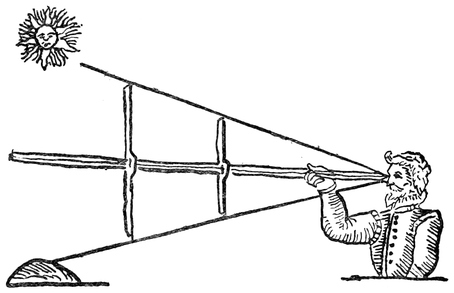
177
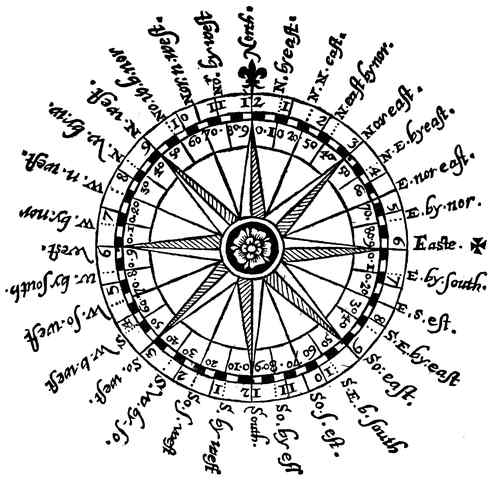
It is not my intention to digress from the path of historical continuity, but let the reader bear in mind how very little the navigator of this period had to help him. He had the compass for indicating the direction of the ship’s head, and he had the astrolabe and cross-staff for showing him his altitude. But two intensely important data he could not yet obtain accurately: (1) his longitude, and (2) the distance run by the ship in any given time. Very great errors were made in both178 of these. It was not until the introduction of the log-line in the seventeenth century that a ship could tell with even approximate accuracy her daily run. For many a long year all the cunning Jews and Arabs, all the philosophers, the astronomers and physicians, all the cleverest men out of Portugal, Spain, Genoa, Venice, and the Balearic Isles had tried but failed to solve this proposition. And the coming of the perfect chronometer for finding the longitude was delayed even longer still.
Every modern deep-sea navigator is familiar with what is known as Great Circle Sailing. For the landsman it may be sufficient to explain that this principle seems to contradict Euclid’s assertion that the shortest distance between any two points is a straight line. In the case of a globe this statement of Euclid does not apply. Every steamer between Liverpool and New York to-day sails on a great circle for the most part of her passage. “Great circles” are those whose plane passes through the centre of the earth: for example, the Equator is a “great circle.” Now as far back as the year 1497 Pedro Nunez made the startling but true announcement that in sailing from one port to another the shortest course was along an arc of a great circle of the terrestrial sphere. And this fact was appreciated by such Elizabethan navigators as John Davis in his voyaging across the North Atlantic.
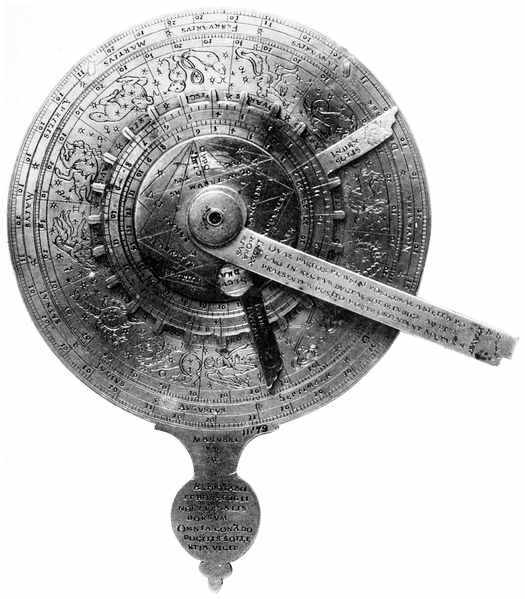
An Old Nocturnal.
In the S. Kensington Museum.
The training of a navigator such as went on in Seville was very thorough, so that it formed an excellent precedent for all who had at heart the education of the complete navigator. The training in the year 1636 was a three-year course, and the following curriculum is given for that year by Sir Clements Markham in his “Sea Fathers”:—
First Year: (1) The sphere of Sacrobosco. (2) The four rules of Arithmetic: Rule of three, extraction of179 square root, cube root, and fractions. (3) The theory of Purbach, or planets and eclipses. (4) The spherical trigonometry of Regiomontanus. (5) The Almagest of Ptolemy.
Second Year: (1) The first six books of Euclid. (2) Arcs and chords, right sines, tangents and secants. (3) To complete Regiomontanus and Ptolemy.
Third Year: (1) Cosmography and navigation. (2) Use of astrolabe. (3) The methods of observing the movements of heavenly bodies. (4) The use of the globe and of mathematical instruments. (5) The construction of a watch.
It must not be forgotten that the life on board a Tudor ship was, even for rough, rude, untutored seamen, full of hardships, even if full of adventure. Anyone who cares to look through the records of the voyages can see this for himself. We are accustomed to regard that as a romantic age; but the romance is only visible through the avenue of distance which now separates us from those times. The victualling was disgracefully mismanaged at the beginning of the sixteenth century. The crews of ships were actually allowed to fight in the English Channel for their country in a condition that was almost sheer starvation. Actually the commissariat department was so bad that ships had to return home from the region of battle to fetch supplies. There was nothing very romantic, either, in having to serve on ships which exuded a terrible stench from their holds. A horrible mixture of bilge-water and decayed food, coupled with the heat of the galley, helped to make the health of the Tudor sailorman anything but good.
Henry VII had done his best to encourage enterprising shipbuilders by giving them a bounty on the tonnage built, and there is a record of at least one ship’s smith being given an annuity for his services to the180 king’s ships. This, like many other customs, had been derived from Spain. Still, for all that, the warships put to sea with so many leaks that “the water cam in as it wer in a seve.” And there was no dry dock until Henry VII built the first at Portsmouth with timber gates and “one ingyn to draw water owte of the seid dokke.” When they went forth to the naval wars of this period they fought with bows, arrows, spears and demi-lances, morris-pikes, halberds, bills, guns (including falcons and harquebuses). There were rammers and powder for the guns, and shot of iron, stone, and lead, artillery having been recently introduced. Portholes had also been introduced in the reign of Henry VII, and the passing of the Viking type of ship to that of a bigger, more seaworthy type, with high-charged stern and bow, was the beginning of a new order of things. Gradually the merchantman became separated from the pure warship, and cannon took the place of the hand-to-hand encounter. But these changes came only by slow stages.
In the time of Henry VIII England was still leaning on the work of the foreign shipwright. Spain, Genoa, Venice, and the Hanseatic League all helped. The arsenal at Venice at this time was a wonderful depôt for shipping—wonderful in its completeness and systematisation. There was everything always ready here for the ship to be used at a moment’s notice. Over a hundred ship-houses were there, containing all the component parts of craft. Armouries, foundries, rope-works, workshops, stores of timber, provisions, and munitions of war—it was all done on a big scale. Such was the perfection of organisation that the master-carpenters and their men actually demonstrated their ability to put together all the detached parts of a galley—rigging included—in less than a couple of hours.
Spain supplied a good deal of the iron for the anchors181 and guns of England until our forefathers quarried for themselves. Thanks to Continental influence, a knowledge of artillery was growing up in England and employed usefully on board our ships of war. Had you met any of these craft at sea you would have been struck by the painted sails, bearing the picture of a saint or whatever device the admiral preferred. Those high forecastles and poops were also most splendidly decorated, so likewise the shields round the upper part of the castles were emblazoned with the arms and devices of the admiral. There were flags bravely flying on the forecastle, on the poop, and amidships; from the main-top a broad swallow-tailed standard flew bearing the admiral’s devices and reaching down to the water. Every mast had its bunting, and for celebrating a triumph the ship was still further draped with rich cloth. Thus she looked, with her many flags fluttering in the wind, more like a fair-ground than an instrument of war.
Such a ship as the famous Great Harry (1500 tons) carried quite a big company—400 soldiers, 260 sailors, and 40 gunners. Admirals and captains were still rather military officers and courtiers than sailors, though the masters were responsible for the handling of the ship. On this same vessel there were below the rank of master the following ratings: master’s mate, four pilots, four quartermasters, quartermasters’ mates, boatswain and boatswain’s mate, cockswain and his mate, master-carpenter and his mate, under-carpenter, two caulkers, purser, three stewards, three cooks, cooks’ mates, two yeomen of the stryks (ropes) and their mates, and two yeomen of the ports with their mates. Some sort of uniform was worn by the officers, consisting of green and white coats—the Tudor colours.
In Henry VIII’s time dockyards were established at Woolwich, Erith, and Deptford, as well as at Portsmouth.182 Originally the custom was to lay up the ships in the autumn and fit out in the spring; but at this time the excellent practice of keeping some ships cruising the Channel in the winter months was developed. The rate of pay in Henry VIII’s navy allowed the admiral ten shillings a day and a captain one and sixpence a day, while the wages of each soldier, mariner, and gunner were five shillings a month plus five shillings a month for victuals. Conduct money for those who had to travel long distances to join their ships was at the rate of sixpence a day, twelve miles being reckoned as one day’s journey.
Copper and gilt ornamentations were added to the end of the bowsprit on Henry VIII’s ships, says Mr. Oppenheim, whilst gilt crowns for the mastheads had been the practice for centuries. Before going into action a ship would sometimes coil her cable round the deck breast high and hang thereon mattresses and blankets as a kind of protection. And here we must say a word concerning the development of naval tactics. As in other maritime departments, so in regard to this England owed a great deal to Spanish influence. Naval warfare in the Mediterranean was already a science, and learned treatises had been written thereon. If the Spaniards were not a race of seamen by nature, at least they had developed the scientific side of the sailor’s life in advance of the English. The awakening from medievalism in marine matters which had spread to our own shores not unnaturally aroused an interest in the proper manner of controlling a fleet. The earliest set of fleet orders in English was that which appeared about the year 1530, written by Thomas Audley, and still preserved in a Harleian MS. This Thomas Audley wrote “A Book of Orders for the War both by Land and Sea,” at the command of Henry VIII. In effect these orders are the final expression of English183 medieval ideas before the introduction of artillery and the practice of broadside fire had started a new school of modern tactics. Audley’s fleet orders, based on the practice of previous centuries, insisted on the importance of getting the weather-gage of the enemy, laid down how to board an enemy—boarding in those days meaning, of course, engaging him in combat alongside—and denoted the sphere of an admiral’s action.
In 1543 appeared the “Book of War by Sea and Land,” written by Jehan Bytharne, Gunner in Ordinary to the King. This contained a number of regulations for governing the fleet, for ornamenting and painting the ships, and for the use of flags both for celebrating a triumph and—this is important—for the purpose of signalling, as, for example, informing the flagship when the enemy had been espied. Bear in mind that in the Spanish Navy flag signalling had, following the Spanish advance towards science, become already a fine art. It is true that even in England this had been in vogue for centuries, and the earliest code is to be found in the “Black Book of the Admiralty,” and dates from about 1340. But the Spanish system was less crude and elementary.
By the middle of the sixteenth century naval tactics in England had advanced even further still, as the instructions issued in connection with the Battle of Shoreham indicate. They are too long to detail here, but it is noticeable that they show both a knowledge of the handling of ships and a mind that has escaped from medieval muddle. The arranging of the fleet in proper divisions, each with its own work to perform, the exact position which was to be maintained, and so on, are well worth consideration. And each division was to wear the St. George’s ensign at a different place for purposes of recognition. Those in the first rank were to fly it from the fore-topmast, those in the second rank to wear it on the mainmast, and so on.
184 During the latter half of the sixteenth century, when the autumn came round each year and most of the royal ships had ended their cruising till the following spring, it was customary to take these vessels round to the Medway. Even ships from Portsmouth were hither brought, and they lay moored in Gillingham Reach. This made a convenient and sheltered anchorage, and yet was not too far from the Tower of London. When the time arrived again for fitting out, the ammunition was put on board barges at the Tower and these, taking the ebb down the Thames and the flood up the Medway, discharged their load when tied up alongside the warships at Chatham.
The great achievements of the Elizabethan seamen could not have occurred unless the English had been engaged in the seafaring life for years, since it is impossible to make a landsman a sailor except after much training. The Armada would never have been defeated except for the superior seamanship and gunnery of our forefathers. Slowly, but surely, since the history of our country began, there had been growing up a nucleus of professional seamen. In Tudor times had there been no race of freight-carriers and fishermen, there would have been no virile body of men to fall back on in the hour of danger on the sea, for the merchant sailor often enough had an exciting passage before he landed his cargo safely in port. Both he and the simple fisherman were liable to be assaulted on the sea by hordes of pirates. In the North Sea, the English Channel (especially in the vicinity of the Scilly Isles, where they swarmed), and off the Irish coast these sea-rovers were a terror to the peaceful, honest seaman.
In addition to this, however, there sprang up what is nothing better than a legalised piracy. By a proclamation of 1557, any Englishman could fit out a squadron of ships against the enemies of the Crown, and when he185 had located these enemies on the high seas, could attack them and confiscate their ships and contents. Now this afforded a fine outlet for those imaginative seafarers who yearned for something more adventurous than catching fish. It was just the kind of life for those who gloried in adventure and wanted it on sea. It helped to turn the fisherman into a fighting man; it was a training school for those who were presently to become the great sea captains and admirals, the gunners and able seamen of the great Elizabethan age.
186
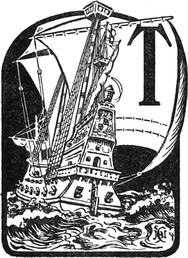
The seamanship, the navigation, and the gunnery of the Elizabethan age will ever be memorable, not merely because they attained such excellence after centuries of imperfection, but because by a combination of these three arts the whole future of England was mapped out, her supremacy assured, and her colonial expansion begun.
A four-masted warship of her reign was not a handy creature to control. She could fight and she could ride out an Atlantic gale, but she was clumsy; she was—even the best of her class—much addicted to rolling, owing to the fact that she possessed such immense weights above the water-line. She was certainly an improvement on the ships of Henry VII and VIII, but she was too cumbrous to be considered in any degree satisfactory. Before we proceed to discuss the way they were handled, let us briefly survey the principal types of vessels on board which the men of this reign had to serve.
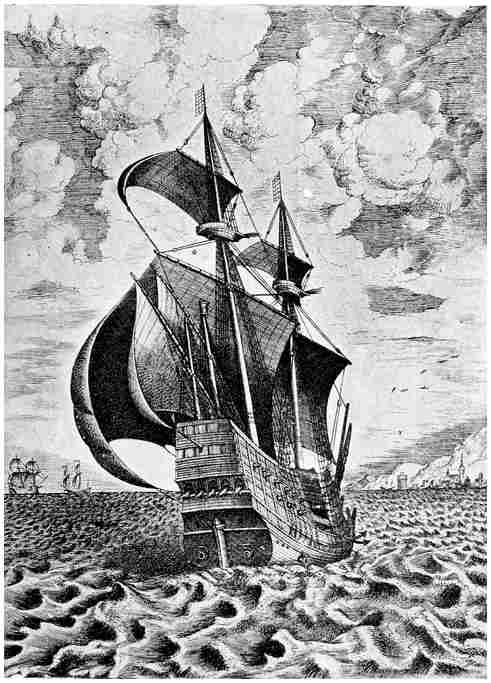
Sixteenth-Century Four-Masted Ship.
By a Contemporary Artist.
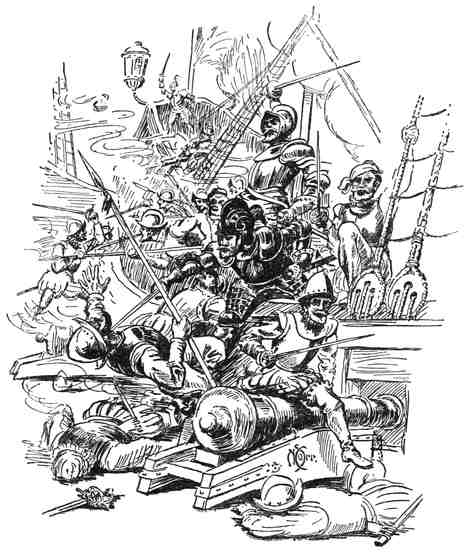
There was, firstly, the “high-charged” man-of-war with her lofty poop and forecastle. A contemporary illustration shows such a vessel with guns protruding187 from the stern and two tiers of guns running along either side of the ship. There were light guns in the forecastle as well. That portion on the main deck between the break of the poop and forecastle was the waist, where the crew moved about and the ship’s boats were stowed. In those days, when so much of188 the fighting was done at close quarters, and the enemy endeavoured so to manœuvre his ship as to come alongside and pour his men on the other’s deck, dealing out slaughter to all who should bar his way, it was the aim of the attacked ship to catch the invaders between two fires. The poop and forecastle being so well guarded and, by reason of their height, so difficult to assault, the enemy might possibly board the ship at the waist. But inasmuch as the after bulkhead of the forecastle and the forward bulkhead of the poop were pierced for quick-firing guns, the boarding party was likely to meet with a warm reception. As an additional obstacle to boarding, it was customary before a fight to stretch long red cloths over the waist. These cloths were edged on each side with calico, says an Elizabethan writer, and were allowed to hang several feet over the side all round the ship, being sometimes ornamented with devices or painted in various colours. Wooden barriers, called “close-fights,” were also built across the ship’s deck for repelling boarders, and were loopholed like the bulkheads. Furthermore, nettings were stretched across the ship to prevent any falling spars from dealing death to the crew.
The tumble-home on these ships was excessive, but since they carried so many decks it was essential that the topmost should be as light as possible. But just as on a modern steamship the master can survey everything forward from the eminence of his bridge, so the Elizabethan captain, standing on the poop, was able to command the whole ship, to see ahead and to keep an eye on his men. There was no uniform colour for painting the Elizabethan hulls, Mr. Oppenheim says. Black and white, the Tudor colours green and white, red, and timber colour were all used. Sometimes a dragon or a lion gilded was at the beak-head, with the royal arms at the stern. On either side of the stern189 was a short gallery, on to which the captain could emerge from his cabin under the poop. The long tiller from the rudder came in under the poop, and was controlled by a bar or whipstaff attached to this same tiller. “The roul,” says James Lightbody in his “Mariner’s Jewel,” published in 1695, “is that through190 which the whipstaff goeth, which is a piece of wood the steersman holdeth in his hand to steer withal.” The man received his orders, as a rule, from the master of the ship, but when entering port the pilot would instruct him how to steer.
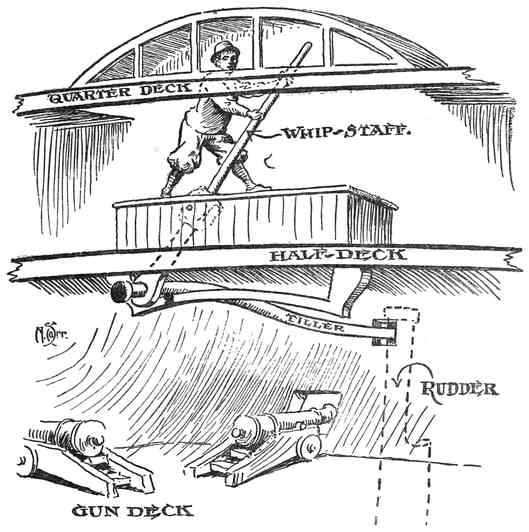
Illustration to show an Elizabethan Helmsman Steering a Ship by means of Whipstaff.
(Sketched on board the replica of the Revenge at Earl’s Court.)
There was not very much room in the fo’k’sle—just enough to sleep a few of the crew and for stowing coils of rope and the like. The galley was erected at the bottom of the hold on a brick floor. Below the upper deck came the main deck. Here were disposed the heavier guns, and here the crew were berthed. Between this and the hold was a false orlop, where the bread-room and the cabins of the petty officers were placed. But what was perhaps especially noticeable about these ships was the extent to which the poop and the beak projected away from the hull. Consequently, not only did these craft roll, but they pitched considerably as well. The interiors of the cabins were painted green, and there was a certain amount of carving externally both at beak and stern. So much for the “high-charged” type of ship.
But there was also the pinnesse or flush-decked species, such a craft as brought home to England the body of Sir Philip Sidney, and such a craft as often formed a unit in those long, perilous transatlantic voyages of discovery. These craft had no raised forecastle other than a small platform, and only a short quarter-deck. There was no such thing as triangular sails on the full-rigged ships of those days. There was, indeed, a spritsail, which was a squaresail set on a yard depending from the long, steeved bowsprit, and this was the only headsail. The foremast and mainmast each set a course and topsail, while the mizzen and bonaventure each carried a lateen fore-and-aft sail. The fore-topmast and main-topmast could be struck if necessary. Elizabethan prints show, situated just above191 the lower yard on the bigger ships, a round top or platform from which quick-firing guns and arrows could be fired. At the yard-arms were sometimes fitted hooks, which, catching the enemy’s rigging and sails, would do him considerable damage.

Sixteenth-Century Ship Chasing a Galley.
By a Contemporary Artist. The lead of the ropes, the parrals round the masts, the rigging and other details are here most instructively shown.
The following represent the different types of “great ordinance” carried by a ship of war at this period:—
Armament of an Elizabethan Ship
| Ordnance. | Weight in lbs. |
Shot in lbs. |
| Cannon | 8000 | 63 |
| Demi-cannon | 6000 | 32 |
| Culverin | 5500 | 18 |
| Demi-culverin | 4500 | 9 |
| Saker | 3500 | 5¼ |
| Minion | 1500 | 4 |
| Falcon | 1100 | 2¼ |
| Falconet | 500 | 1¼ |
But it was seldom that any ordnance greater than a demi-cannon was used on board ship.
The guns were made of brass or iron, and were mounted on wooden carriages which had four wheels. They could be run in and out by means of tackles. In his interesting little book, “The Arte of Shooting in Great Ordnance,” by William Bourne, published in 1587, the author significantly speaks of “this barbarous and rude thing called the Art of Shooting in great Ordnaunce.” This was the period, you will remember, when arrows, bills, and pikes had not yet lost their admirers. He tells you in his preface that he has written this book because “we English men haue not beene counted but of late daies to become good Gunners, and the principall point that hath caused English men to be counted good Gunners hath been for that they192 are hardie or without fear about their ordnaunce: but for the knowledg in it other nations and countries haue tasted better therof, as the Italians, French, and Spaniardes, for that the English men haue had but little instruction but that they haue learned of the Doutchmen, or Flemings in the time of King Henry the eight.”
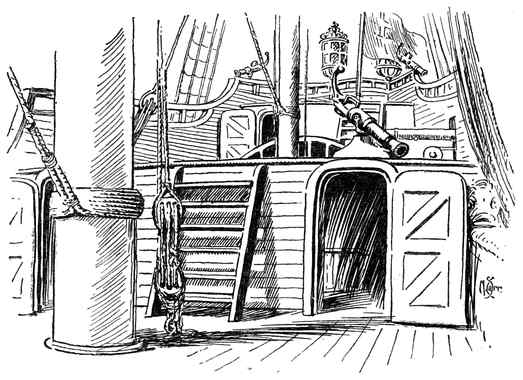
Waist, Quarter-deck, and Poop of the “Revenge.”
(Elizabethan period.)
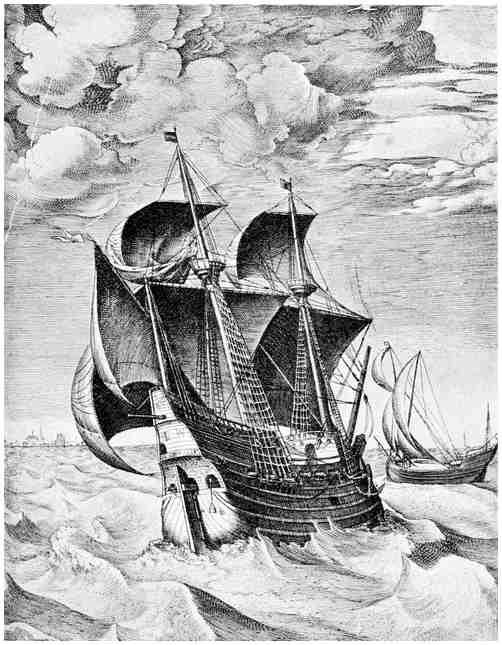
Sixteenth-Century Three-Masted Ship.
By a Contemporary Artist. The date on the stern is 1564. Notice the man in the maintop dowsing maintopsail.
He goes into the subject with great thoroughness and points out that allowance must be made for the wind, and how to secure good aim. The cannon are to be placed so as to be right in the middle of the ports of the ship, and care is to be taken that the wheels of the gun-carriage are not made too high. He advises that when shooting from one ship at another, if there is any sea193 on it is essential to have a good helmsman “that can stirre steadie.” The best time to fire at the other vessel is when the latter is “alofte on the toppe of the sea,” for then “you have a bigger marke than when she is in the trough.” If the ship rolls, “then the best place of the ship for to make a shotte is out of the head or sterne.” The shorter ordnance is to be placed at the side of the ship because they are lighter, and if the ship should heave “wyth the bearyng of a Sayle that you must shutte the portes,” then you can easily take the guns in.
“In lyke manner,” he proceeds, “the shorter that the peece lyeth oute of the shyppes syde, the lesse it shall annoy them in the tacklyng of the Shippes Sayles, for if that the piece doe lye verye farre oute of the Shyppes syde, then the Sheetes and Tackes, or the Bolynes wyll alwayes bee foule of the Ordnaunce, whereby it maye muche annoy them in foule weather.” Therefore the long guns are best placed so that they are fired from the stern. But a gun so placed must be “verye farre oute of the porte, or else in the shooting it may blowe up the Counter of the Shyppes sterne.”
In another equally delightful volume entitled “Inventions or Devises,” the same author tells his reader how to “arme” (i.e. protect) a “ship of warre.” You are to keep your men as close as you may, and have the bonnet off the sail or other canvas stretched along the waist and decks, as I have shown on an earlier page. The forecastle and poop, Bourne says, you may “arm” with “manlets or gownes” “to shaddow your men”; so also the tops, “but now in these daies,” he adds, “the topfight is unto little effect, since the use of Calivers or Muskets in Ships,” for the latter could do so much damage. He therefore advises against having many men in the tops. After alluding to the netting, which I explained just now, Bourne suggests194 that the captain must send the carpenter “into the holde of the Ship” “to stop any leake if any chance. And also to send downe the Surgion into his Cabin, which ought and must be in the holde of the ship.”
The supreme head of the ship was the captain, who was not necessarily a navigator nor even a seaman; but he was the wielder of authority and discipline. He it was who had to keep under control a crew that was prone to swearing, blasphemy, violence, mutiny, and other sins. Sir William Monson has left behind in his most interesting “Naval Tracts” many an entertaining detail of sea life during the Elizabethan period, and tells that a captain might punish a man by putting him in the “billbows during pleasure,” ducking him at the yard-arm, hauling him from yard-arm to yard-arm under the ship’s keel (otherwise known as keel-hauling), fastening him to the capstan and flogging him there, or else fastening him at the capstan or mainmast with weights hanging about his neck till his poor heart and back were ready to break. Another brutal punishment was to “gagg or scrape their tongues for blasphemy or swearing.”
Elizabethan captains, says Monson, “were gentlemen of worth and means, maintaining their diet at their own charge.” In a fight the lieutenant had charge of the forecastle. It was not till the latter part of Elizabeth’s reign that the rank of lieutenant was created for the training of young gentlemen destined ultimately for command. He came aboard quite “green” in order to learn what seamanship he could, and to assist the captain in the discipline of the ship; but he was not allowed to interfere with the navigation, which was entirely the work of the master. Not unnaturally there was a good deal of friction between the lieutenant and the master. Even the common seaman had an ineradicable contempt for this landlubber, more especially195 in the seventeenth century during the Anglo-Dutch wars.
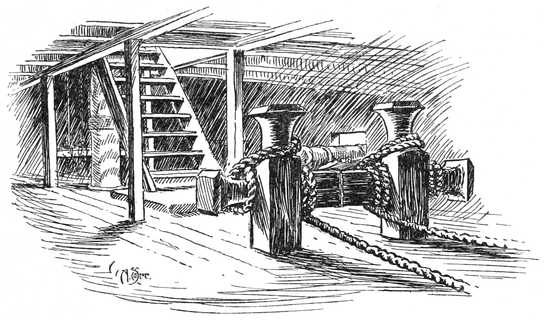
Riding Bitts on the Gun Deck of the “Revenge.”
(Elizabethan period.)
In his “Accidence, or The Path-way to Experience necessary for all Young Seamen,” written by Captain John Smith, the first Governor of Virginia, we have a great deal of information which tells us just what we should wish to know. Of the captain and master we have already spoken. The latter and his mates are to “commaund all the Saylors, for steering, trimming, and sayling the Ship.” The pilot takes the ship into harbour, the Cape-merchant and purser have charge of the cargo, the master-gunner was responsible for all the munitions, while the carpenter and his mate looked after the nails, pintles, saws, and any caulking of seams as well as the splicing of masts and yards. The boatswain had charge of the cordage, marlinespikes, and sails, etc., while his mate had command of the longboat for laying196 out kedge anchors and warping or mooring. The surgeon had to have a certificate from the “Barber-surgeons Hall” “of his sufficiency,” and his medicine-chest must be properly filled. The marshal was to punish offenders, and the corporal was to see to the setting and relieving of the watch. Every Monday the boatswain was to hear the boys box the compass, after which they were to have a quarter can of beer and a basket of bread.
The men messed in fours, fives, or sixes, and the steward’s duty was “to deliuer out the victuall.” The quartermasters had charge of the stowage, while a cooper was carried to look after the casks for wine and beer, etc. The large ships had three boats, viz. (1) the boat, (2) the cock, and (3) the skiff. These were respectively put in charge of (1) the boatswain, (2) the cockswain, and (3) the skiffswain. Hence the origin of these designations. A cook was carried, and he had his store of “quarter cans, small cannes, platters, spoones, lanthornes,” etc. The swabbers’ duties were to wash and keep clean the ship. But the first man that was found telling a lie every Monday was indicted of the offence at the mainmast and placed under the swabber to keep the beak-head and chains clean. The sailors were the experienced mariners who hoisted the sails, got the tacks aboard, hauled the bowlines, and steered the ship; while the younkers were the young men called “foremast men,” whose duty it was to take in topsails, furl and sling the mainsail, and take their trick at the helm.
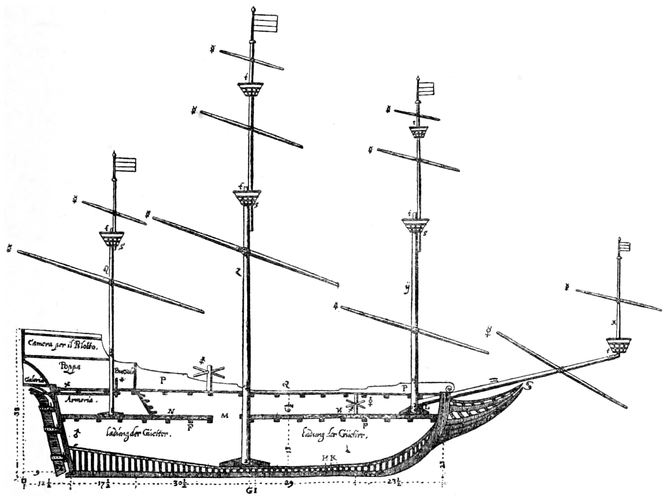
Longitudinal Plan of an Early Seventeenth-Century Ship.
This contemporary design conveys an excellent idea of the interior of an ocean-going vessel. Notice the pilot’s place at the stern; the tiller and whip-staff; the capstan; the lower deck; the holds, etc.
In those days the custom of dividing a ship’s company into watches was already in vogue. “When you set sayle and put to sea, the Captaine is to call up the company; and the one halfe is to goe to the Starreboord, the other to the Larboord, as they are chosen: the Maister chusing first one, then his Mate another,197 and so forward till they bee diuided in two parts.” In those days the reckoning by tonnage was far from reliable as indicating the true size of a ship. Columbus, after his second voyage across the Atlantic, writes to Captain Antonio de Torres of the ship Marigalante, and refers to the freighting of ships by the ton “as the Flemish merchants do,” and this, he suggests, would be a better and less expensive method than any other mode. But when after the capture of a prize the division of shares was made, it was to the advantage of198 the crew to make the tonnage as big as possible. The custom was to allot the share in proportions. The ship took a third, the victualler took another third, and the remaining third was divided up among the crew. Of this latter third the captain received nine shares, the master seven, and so on down to the boys who had one share, and there was a reward given to the man who first descried the sails of the ship ultimately captured. A reward was also paid to the first man who rushed on board the enemy.
According to Monson, every man and boy was allowed 1 lb. of bread a day and a gallon of beer a day, viz. a quart in the morning, a quart at dinner, a quart in the afternoon, and a quart at supper. On flesh-days each man could have 1 lb. of beef or else 1 lb. of “pork with pease.” Flesh-days were Sundays, Mondays, Tuesdays, and Thursdays. The other days were fish-days, and on these every mess of four men was allowed a side of salt fish, “either haberdine, ling, or cod,” 7 oz. of butter, and 14 oz. of cheese. Fridays were excepted, for on these days they had but half allowance. Monson was naturally prejudiced against the Spanish ships, which he accused of being badly kept—“like hog-sties and sheep-coats”—and of giving an allowance of diet far too small. Every man cooked for himself and there was no discipline, although they carried more officers than the English ships. In the latter the captain inspected his ship twice a day to see that she was kept sweet and clean “for avoiding sickness,” but the holds were so badly ventilated, dark, and smelly, the beer was so frequently bad, the food so often putrid, and the crew themselves so lacking in habits of cleanliness, that scurvy, dysentery, and other diseases frequently broke out and men died in large numbers. One has only to look through the logs of some of the Elizabethan voyages of discovery to see this for oneself.
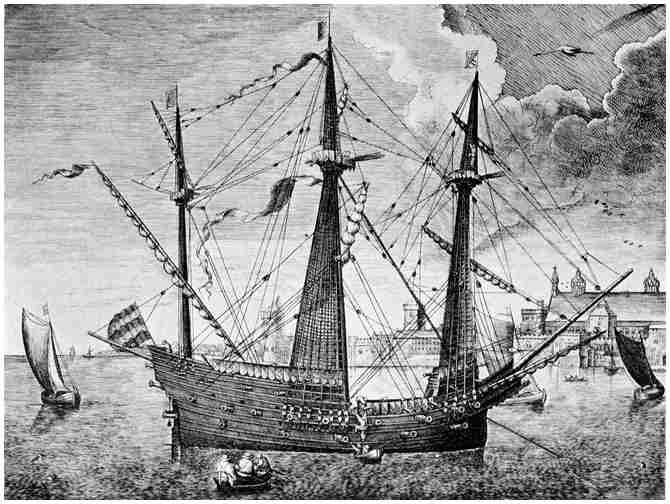
A Sixteenth-Century Warship at Anchor.
By a Contemporary Artist. Showing method of embarkation and many fascinating details.
199 In addition to the officers already mentioned must be given two more. These were first the ship’s chaplain, who celebrated the Holy Communion on Sundays, read prayers two or three times on week-days, preached, and visited the sick and wounded. And secondly a trumpeter, who blew on his silver instrument when the ship went into action, at the changing of the watches, and at the coming and going of a distinguished guest. His place was on the poop, and it was customary for “himself and his noise to have banners of silk of the admiral’s colours.” The watch was set at eight, and so on through the night and day. When on these occasions the trumpeter sounded his blast he was to “have a can of beer allowed for the same.”
And now that we have got some idea in our minds of the details of the seaman’s life on board an Elizabethan ship, let us be rowed off from the shore in one of her three boats which is bringing water and wood and provisions. The good ship is lying to her anchor in the roadstead about to get underway. Transport yourself, then, in imagination to that epoch when England’s seamen made such wonderful history, and endeavour to believe that the cock-boat actually bumps up alongside the English galleon. You clamber up the ship’s side and find yourself on her deck, where the crew are standing about ready to hear the commands of the master. And now let us watch them get under way. I shall quote not from fiction of to-day, but from an account written by an Elizabethan, this same Captain John Smith, as he wrote it for the edification of young seamen.
“Bend your passerado to the mayne-sayle, git the sailes to the yeards, about your geare on all hands, hoyse your sayles halfe mast high, make ready to set sayle, crosse your yeards, bring your Cable to the Capsterne. Boatswaine, heave a head, men into the tops,200 men upon the yeards. Come, is the anchor a pike? Heave out your topsayles, hawle your sheates. What’s the Anchor away? Yea, yea. Let fall your fore sayle. Who’s at the helme there? Coyle your cable in small slakes. Hawle the cat, a bitter, belay, loufe (= luff), fast your Anchor with your shanke painter, stow the boate. Let falle your maine saile, on with your bonnets and drablers, steare study before the wind.
“The wind veares, git your star-boord tacks aboord, hawle off your ley sheats ouerhawle the ley bowlin, ease your mayne brases, out with your spret-saile, flat the fore sheat, pike up the misen or brade (= brail) it. The ship will not wayer, loure the maine top saile, veare a fadome of your sheat. A flown sheate, a faire winde and a boune voyage! The wind shrinks. Get your tacks close aboord, make ready your loufe howks (= luff hooks) and lay fagnes, to take off your bonnets and drablers, hawle close your maine bowline.
“It ouervasts. We shall have wind. Sattle your top sailes, take in the spret sayle. In with your topsayles. Lower your main sayles, tallow under the parrels, in with your maine sayle, lower the fore sayle. The sayle is split, brade up close all your sayles, lash sure the Ordinances, strike your top masts to the cap, make them sure with your sheepes feete. A storme, hull,47 lash sure the helme a ley, lye to try out drift.48 How capes the ship? Cun the ship, spoune before the winde. She lusts, she lyes under the Sea. Trie her with a crose jacke, bowse it up with the outlooker. She will founder in the Sea, runne on shore, split or billage on a Rocke, a wracke. Put out a goose-winge, or a hullocke of a sayle.
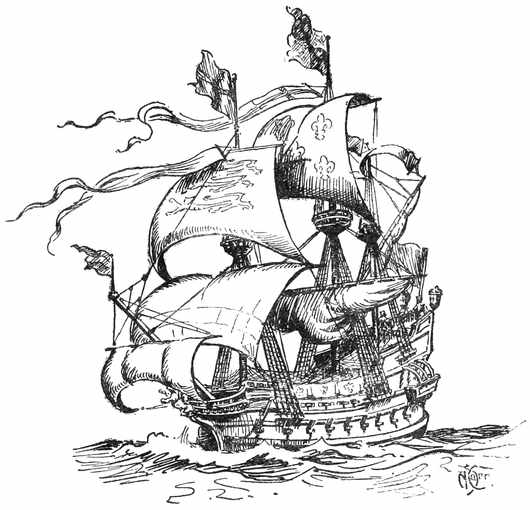
“Faire weather! Set your fore sayle. Out with all your sailes. Get your Larboard tackes aboord, hawle201 off your Starboord sheats, goe large, laske, ware yawning. The ship’s at stayes, at backe-stayes. Ouer-set the ship, flat about, handle your Sayles, or trim your sayles. Let rise your tacks, hawle of your sheats. Rock-weede, adrift, or flotes! One to the top to looke out for Land. A ship’s wake, the water way, the weather bow, weather coyle. Lay the ship by the Ley, and heave the lead, try the dipsie (= deep-sea) line.202 Bring the ship to rights, fetch the log-line to try what way shee makes. Turne up the minute glasse, observe the hight. Land, to make land, how beares it. Set it by the Compasse. Cleare your leach-lines, beare in, beare off, or stand off, or sheare off, beare up.
“Outward bound, homeward bound, shorten your Sailes, take in your Sailes, come to an Anchor under the Ley of the weather shore, the Ley shore, nealed too, looke to your stoppers. Your anchor comes home, the ship’s a drift, vere out more Cable. Let fall your sheat Anchor, land locked, mo(o)re the ship. A good Voyage, Armes, arme a skiffe, a frigot, a pinnace, a ship, a squadron, a fleete. When you ride amongst many ships, pike your yards.
“To the boat or skiffe belongs oares, a mast, a saile, a stay, a halyard, sheats, a boat-hook, thoughts (= thwarts), thoules (thole-pins), rudder, irons, bailes, a trar-pawling or yawning, carlings, carling-knees, for the David (davit), the boates-wayles, a dridge. To row a spell, hold-water, trim the boate, vea, vea, vea, vea, vea, who saies Amen, one and all, for a dram of the bottle?”
Impressionist-writing you describe all this? Yes, certainly. But it has the effect, has it not, of conveying just what we are attempting, a general idea of the life of Elizabethan sailors at sea? “Many supposeth,” writes this same author, “any thing is good enough to serve men at sea, and yet nothing sufficient for them a shore, either for their healthes, for their ease, or estates, or state.” ... “Some it may bee will say I would have men rather to feast than fight. But I say the want of those necessaries occasions the losse of more men than in any English fleet hath bin slaine in any fight since (15)88: for when a man is ill sicke, or at the poynt of death, I would know whether a dish of buttered Rice, with a little Cinamon and Sugar, a little203 minced meate, or roast beefe, a few stewed Prunes, a race of greene-ginger, a flap Jacke, a can of fresh water brued with a little Cinamon, Ginger and Sugar, be not better than a little poore John, or salt fish, with oyle and mustard, or bisket, butter, cheese or oatemeale pottage on fish dayes, salt beefe, porke and pease. This is your ordinary ship’s allowance, and good for them are well, if well-conditioned, which is not alwayes, as seamen can too well witnesse: and after a storme, when poore men are all wet, and some not so much a cloth to shift him, shaking with cold, few of those but will tell you a little Sacke or Aquvitæ is much better to keepe them in health, then a little small beere or cold water, although it be sweete.”
The sea literature of the Elizabethan period is rich in illustrations of the ways employed. Shakespeare, whom some critics verily believe to have been a sailor—so unfailingly accurate are his numerous sea terms—here and there, and especially in “The Tempest,” reflects a good deal of the life on board ship. In such logs as the voyages of the great Arctic explorer John Davis, there is many a nautical expression that cannot fail to arrest our attention. And in order to complete the impressionistic sketch of Captain John Smith, permit me here to bring to the reader’s notice some of the phrases which I have collected from other sources of this period.
There were various expressions used to mean heaving-to: thus “strake suddenly ahull” to signify “suddenly hove-to.” So also “tried under our maine course, sometimes with a haddock of our sail,” as Davis has it, or “a hullocke of a sayle,” as Smith expresses it. Perhaps it was thus that the synonym “try-sail” originated, signifying a small handkerchief of canvas with which to lie comfortably hove-to. “The third day being calme, at noone we strooke saile, and let204 fall a cadge anker.” “Cadge” is spelt “kedge” nowadays. They used to “let slippe” their cables—made of hemp—from the “halse” or hawse-pipe. But sometimes “the cable of our shut (= sheet) anker brake.” “For the straines (= strands) of one of our cables were broken, we only road by an olde junke!” (Junk is still sailor’s slang for worn-out rope.) In those days when there was no such thing as telegraph or post, when ships traversing the ocean were so few as unlikely to meet except rarely, months and years went by without news of mariners. But sometimes when an outward-bound English ship met a fellow-countryman homeward-bound, an effort was made to send letters back. There was an instance of this during Davis’s third voyage when two days out from Dartmouth. They met the Red Lion of London sailing home from Spain. So they hailed the latter and asked her master to carry letters back to London. “And after we had heaved them a lead and a line, whereunto wee had made fast our letters, before they could get them into the ship, they fell into the sea, and so all our labour and theirs was also lost.”
Happily there still exists the “Traverse-Booke,” which Davis made during his third voyage, when he set out to discover that north-west passage which was only found in the present decade by Captain Roald Amundsen, who also was the first to reach the South Pole. And I cannot believe that even a brief extract of Davis’s sailing will fail to be of the greatest interest to modern seamen, whether amateur or professional. I have therefore thought fit to append the following, which covers the first nine days beginning from the time when his little fleet of three, consisting of the “barke” Elizabeth, the “barke” Sunneshine, and the “Clincher” Helene, weighed their anchors and set sail from Dartmouth.
205
A Traverse-Booke made by M. John Davis in his third voyage for the discoverie of the North-West passage, Anno 1587.
| Moneth. May. |
Dayes. | Houres. | Course. | Leagues. | Elevation of the Pole. |
The Winde. | The Discourse. | |
| Deg. | Mins. | |||||||
| 19 | W S W Westerly | 50 | 30 | N E | This day we departed from Dartmouth at two of the clocke at night. | |||
| 20 | ||||||||
| 21 | 35 | W S W Westerly | 50 | 50 | N E | This day we descried Silly N W by W from us. | ||
| 22 | 15 | W N W | 14 | N E by E | This day at noone we departed from Silly. | |||
| 22 | 6 | W N W | 6 | N E by E | ||||
| 22 | 3 | W N W | 2 | |||||
| 23 | 15 | N W by W | 18 | N E | ||||
| 39 | W N W | 36 | 50 | 40 | The true course, distance and latitude. | |||
| 3 | W N W | 2 | N N E | |||||
| 6 | N W by W | 5 | N E by N | |||||
| 3 | W N W | 3 | N N E | |||||
| 12 | W N W | 12 | N E | |||||
| Noone the 24 |
24 | W N W Northerly | 25 | 51 | 16 | The true course, distance and latitude. | ||
| 3 | W N W | 3 | N N E | |||||
| 3 | W N W | 2½ | N by E | |||||
| 6 | W by N | 5 | N | |||||
| 6 | W by N | 5 | N | |||||
| 2 | S | ½ | N | Now we lay upon the lee for the Sunshine, which had taken a leake of 500 strokes in a watch. | ||||
The phrase “lay upon the lee” is just another way of saying they hove-to. “A leake of 500 strokes in a watch” was identical with saying that they had to206 work the pumps to that number in such a period. It should be added, further, that by “elevation of the pole” is, of course, meant the ship’s latitude.
Some of the vessels of the sixteenth century were terribly slow creatures. There was a nickname given to those lethargic coasters which, because they could not do much against the current and had to proceed from one roadstead to another and there anchor till the tide turned, were known as “roaders.” No one who has made himself familiar with their long and trying voyages could ever accuse the Elizabethan seamen of cowardice in bad weather. Once, Davis relates, when his ship was fighting her way through a storm, her mainsail blew right out of her; whereupon the master of the ship crept along the mainyard, which had now been lowered down to the rails, and gathering the sail as it was hauled out of the sea, gallantly fought with it and succeeded in bending it again to the yard, “being in the meane while oft-times ducked over head and eares into the sea.”
The reader will remember just now in the extract from Smith the expression “she lusts” for “she lists.” Among hundreds of our English seamen in this twentieth century “lust” is still used to mean “list.” Smith, as we saw, also wrote “spoune before the wind.” Davis, too, related that “we spooned before the sea,” the exact meaning being that they drove before the gale under bare poles. The latter also uses the expression “a mighty fret of weather” to mean “a mighty squall.” Those who are familiar with the language of the fishermen on the north-east coast of England will call to mind their word “sea-fret” to denote a fog approaching the land.
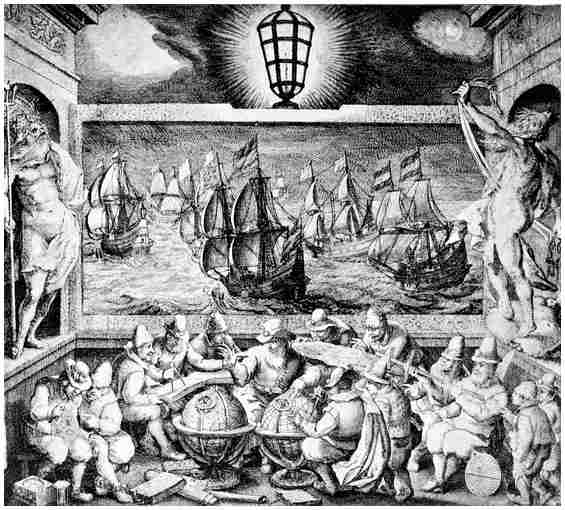
Sixteenth-Century Seamen Studying the Art of Navigation.
After a Contemporary Artist.
Notice the compass, the hour-glass, globes, cross-staff, charts, etc.
Few nautical words are so well known to us as “skipper.” Before the sixteenth century was ended the Dutch seamen had fraternised a good deal with207 the sailors of England. The Low Countries were fast becoming great shipbuilders and navigators, and not unnaturally some of their phrases began to be used by our men. The Dutch word to this day which is used to mean captain is still “schipper,” and among the English seamen at the end of the sixteenth century the equivalent “shipper” was employed to refer to the same personage. There were other slang phrases prevalent, such as a “light-horseman” to mean a fast-pulling gig. So also Davis speaks of a “trade” wind to mean regular and steady. “The wind blowing a trade,” he remarks. But some of these phrases employed by seamen of those days are a little less obvious. “Tressle-trees,” for example, might puzzle many a modern sailorman. “This night we perished our maine tressle-trees, so that wee could no more use our maine top-saile.” These trestle-trees were just a couple of strong pieces of wood, or of iron, and were fitted one on either side of the lower masthead so as to support the heel of the topmast. Such expressions as “ground-tackle” are as frequently employed to-day as then, but over and over again we find that a ship “came roome,” “bare roome with her,” to mean that the former came to leeward, put up her helm and bore away.
Anxious as he naturally was concerning a thousand matters, the life of the captain at sea was many degrees happier than that of his crew. At least he had a decent cabin and bed in which to sleep and take his meals and sip his punch, otherwise known as “Rosa Solis,” consisting of brandy, spices, and hot water. But the seamen’s comforts were disgracefully neglected, with the result that they died in dozens. Some more humane captains such as John Smith did their best for the men; but this was exceptional. And yet it was a thoroughly unsanitary age. Davis himself admits208 that many of his crew were “eaten with lice” as big as beans. Monson includes among the causes of the discouraging of seamen the inexperienced commanders who were put over them, the bad victuals which they had to endure, the dishonesty in serving them—the beef, for instance, given so that five men had to partake of four men’s allowance—and the delay which was made in paying their wages. Especially were these abuses noticeable during the early years of the seventeenth century. Men were impressed into the service even in those days, though there were volunteers as well. At the time of the Armada our sailors received as wages fourpence a day, but this was paid quarterly. In addition, of course, there was sometimes prize money in the proportions already mentioned. In Monson’s time complaint was made of the kind of foremast men who were pressed into the service “to pleasure friends.” Such men as “taylors, porters, and others of that rank, unworthy of the hatches to lie on,” were brought aboard and given no less than £1 11s. a month. And yet, when opportunity allowed, the captain used to send his crew ashore in the ship’s boats “to walk in the fields ... to take the air.” But among the officers there was too much “excessive banqueting on board” and a great waste of powder, as, for instance, when guns were fired at the drinking of a man’s health.
And the same authority has something very interesting to tell us concerning the ceremonial wearing of the flag on board ship. I have no intention of confusing our chronological sequence, but I must ask the reader for a moment to recall that incident which was one of the indirect if not the real causes of the first Anglo-Dutch wars. It will be remembered—which English schoolboy does not remember it well?—that when Captain Young, one May Day in 1652, was bound209 down Channel and met a convoy of Dutchmen coming up, he was angered to find the foreigner declined to salute, and an engagement immediately followed. Now, writing long before that incident had ever occurred, Monson definitely states that if a foreign fleet should pass on our seas and meet our admiral’s ship, the former were expected to acknowledge our sovereignty by coming under the lee of the admiral, by striking their topsails and taking in their flag. “And this hath never been questioned,” he adds, except out of ignorance, as in the case of Philip II, when he met the Lord Admiral of England when the former was sailing to England in order to marry Queen Mary. The custom was that if any foreign ship were to arrive in one of our ports or to pass a fort or castle, she must, as she entered, and before coming to anchor, take in her flag three times “and advance it again.” But should the English admiral be in the harbour, the foreigner was not to display his flag at all.
Prior to the reign of James I, all admirals wore the St. George’s flag at the topmast head. But when the Union of Scotland had been effected there was added the cross of St. Andrew. An admiral at anchor took in his flag in the evening and fired a gun and set the watch. “The flag carried under the poop of a ship,” he remarks, “shews a disgrace,” and is never used except when it is won or taken from an enemy.
Jealousy of Spain and greed of gold had as much to do with the impetus given to English seamanship and navigation during Elizabethan times as any inherent love of the sea. To meet this new zeal various writers, some of whom we have already mentioned, set to work to write treatises that would turn raw agricultural labourers and tavern-haunters into fighting sailors and navigators. William Bourne, from whom we have already quoted, in his “Regiment for the Sea” was the first to210 give a book on navigation written by an Englishman. This was in the year 1573, and a rare example of this little work is still preserved in the British Museum. In it he pointed out the various ways for finding the variation of the compass, exposed the errors of the plane charts, and advised mariners in sailing towards high latitudes to keep their reckoning by the globe, as in those regions the plane chart was most likely to land them into trouble.
In 1594 John Davis, the Arctic explorer, published his “The Seaman’s Secrets.” This book became very popular, and took the place of the Spanish Martin Cortes’ handbook, which had been used in the English translation. There is a vast amount of matter in Davis’ “Secrets” which is worth perusing even by the modern navigator. He speaks of “great Circle navigation,” and gives a whole host of valuable practical hints. “The Instruments necessarie for a skilfull seaman,” he explains, “are a Sea Compasse, a Cross staffe, a Quadrant, an Astrolabe, a Chart, an instrument magneticall49 for the finding of the variation of the Compasse, an Horizontall plaine Sphere, a Globe, and a paradoxall Compasse”50 ... “but the Sea Compasse, Chart and Crosse staffe are instruments sufficient for the seaman’s use, the astrolabie and quadrant being ... very uncertaine.” In this book he gives instruction as to tides, stars, and how to use the astrolabe. And it is worth noting that he speaks of the English Channel after the fashion of our Gallic neighbours, who still refer to “La manche.” “Our Channell,” he explains, “commonly called the Sleue” (sleeve).
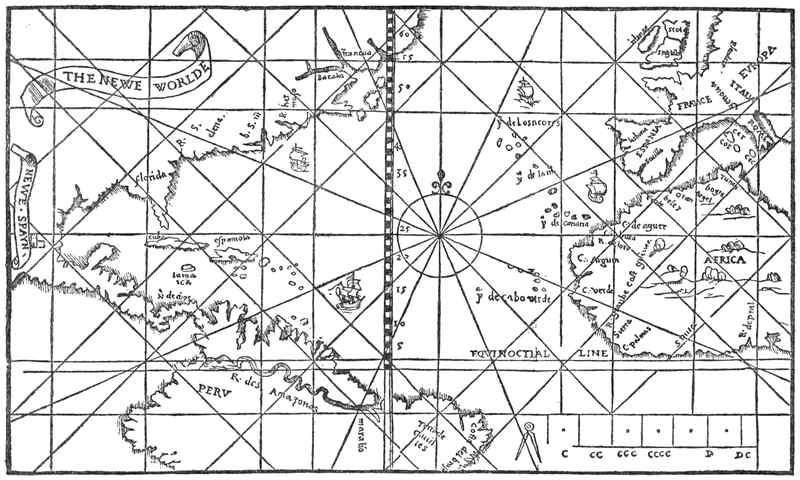
Chart of A.D. 1589.
Showing the dividing line between the Old World and the New.
It will be recollected that the Pope had drawn an imaginary line North and South, a hundred leagues west of the Azores, leaving all that lay east thereof to the Portuguese, and all that lay west to the Spanish.
Everyone knows that longitude is the distance east or211212 west of a given meridian. In those days Greenwich did not enter into the matter: the observatory there had still to be founded. When Davis wrote in the year 1594 there was no variation at St. Michael’s in the Azores, and so the longitude was reckoned from there. “Longitude,” he defines, “is that portion of the Equator contained betweene the Meridian of S. Michel’s, one of the Assores, and the Meridian of the place whose longitude is desired: the reason why the accompt of longitude doth begin at this Ile is, because that there the compasse hath no variety.”
Be it remembered, also, that it was Davis who improved the cross-staff and superseded the clumsy astrolabe for taking meridian altitudes at sea. It was commonly spoken of as Davis’s quadrant, and was afterwards improved by Flamstead with the addition of a glass lens. Subsequently it was further improved by Halley, and as such was used almost exclusively till the year 1731, when it was in turn superseded by Halley’s quadrant. When we read again the entrancing narratives given in Hakluyt and elsewhere of the Elizabethan voyages into the unknown, let us note that reposing somewhere in the high poop of these ships there were most probably all the following instruments for navigating the trackless seas. There was a calendar, an astrolabe, a cross-staff, a celestial globe, a terrestrial globe, a universal horloge for knowing the hour of the day in every latitude, a nocturne labe for telling the hour of the night, one or more compasses, a navigation chart, a general map, and a printed chart.
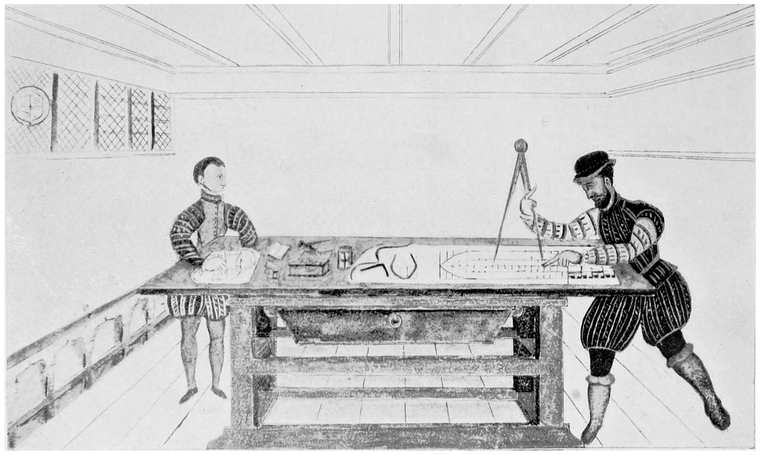
Ship Designer with his Assistant.
This illustration belongs to the latter half of the sixteenth century, or the beginning of the seventeenth, and is among the Pepysian MSS. in Magdalene College, Cambridge. Pepys’ own title for this is “Fragments of Ancient English Shipwrightry.”
It was in 1599 that Edward Wright published his “Haven-finding Art.” In his volume “Certaine Errors in Navigation,” he complains of the errors in the proportions of the existing charts. These consisted in wrongly showing the distances of places. He speaks213 also of sailing “by a great Circle, which is to bee drawne by those two places,” and asserts that this is a better method than sailing always at right angles to the meridian. In practically all the charts of this age the surface was ruled with rhumb-lines from the thirty-two points of the compass, as is still the case to-day on certain Dutch charts. The origin of the word “rhumb” was Portuguese, and doubtless these lines appeared on the earliest Portuguese charts. In the first of these two books, Wright also furnished a table of variations of the compass in different parts of the world.
As to the practical side of navigation, Bourne exhorted his mariners to remember that the earth is a globe and not a “platforme,” as “generally the most parte of the seamen make their account.” The meridians, he reminded them, grow narrower towards the two poles. If one had occasion to voyage northward it were better to sail by the globe, he suggested. Therefore you should keep a perfect account of the ship’s course. Then resort to your globe and consider what place and parallel you are in (by means of the sun at day and the stars at night). Knowing where you are, set your globe to the elevation of your pole, and then turn to the place of your zenith and seek the opposite of it in your parallel, for then you know that in the same parallel is your east and west line. Then the just quarter of that circle to the pole must be divided into the eight points of your compass, doing so likewise on the other side.
From the southern voyages the “plats or cardes for the sea” were recommended. Bourne strongly advised against painting their compasses with so many colours on these charts and so many flags on the land, but bade them use the vacant places left on the paper for better objects, such as the time of high water at certain states of the moon, and the elevation of the land, in214 order that the appearance of the latter might not be mistaken. The use of sea cardes for navigating during long voyages he regards as very necessary for three reasons: they show you (1) how one place bears from another; (2) the distances between the places; (3) in what latitude any place is. But the master or pilot of the ship is also to bear in mind the effect of tides, currents, the surging of the sea or scantiness of the wind, which might put the ship to leeward of her course. Also in long voyages the wind might shift ahead, so the mariner must keep a perfect account of his courses and mark each new course on the chart, and pay regard to the “swiftnesse” or “slownesse” of the ships. If the weather be clear he was to take the true altitude of the pole, which will correct the ship’s course and give “a very neare gesse” how the port of destination bears and how far.
The compass was variously known in the Elizabethan age as the “sea-directorie,” the “nauticall box,” and the “sea-compasse.” Lightbody describes the bittacles as “little wooden pins for nailing the compass-box withal.” The first atlas was published in Dutch at Leyden in 1585 by Wagenaer. In this are to be found excellent coloured charts of the Narrow Seas. It is evident from these that there was a system of buoyage even in those days. There are barrel buoys, for instance, and basket beacons such as you can still find in use to-day in different parts of Holland. The sands on the port hand of the Swin Middle at the entrance to the Thames Estuary are shown marked by staff-and-triangle marks. This excellent atlas was soon translated into English, so that the elaborate sailing directions and the admirable little contours of the coast—crude but useful—could be placed at the service of English mariners. This English version was known as Wagenaer’s “Mariner’s Mirrour,” and there was215 also “The Sea Mirrour,” translated from the Dutch of William Johnson Blaeu by Richard Hynmers in 1625, which was another of the numerous nautical books of this time, containing instruction in practical navigation, sailing directions, charts, and contours.
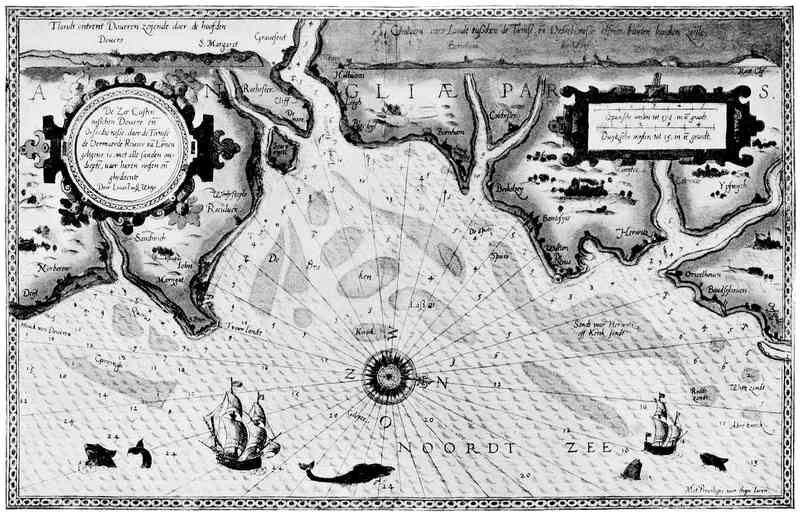
A Chart of the Thames Estuary.
(Dover to Orfordness.) This is taken from the first Atlas ever published, viz., in 1585.
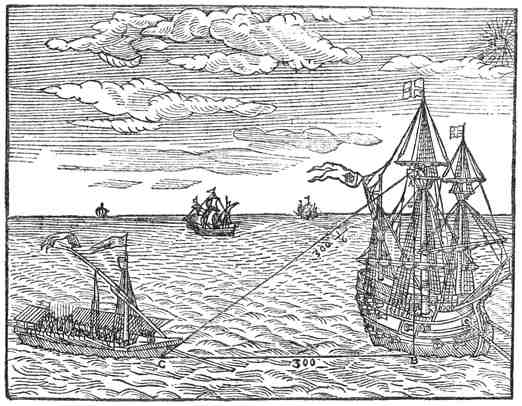
“How you may at one Station Measure uppon an Heigth with a Geometricall Square a Longitude uppon Plaine.”
This is from Lucar’s sixteenth-century treatise on gunnery, and illustrates the use of the “geometricall square” for finding the distance between the galley and the ship, viz. 300 yards. This instrument was made of metal or cypress, the quadrant being divided into 90 degrees. It was used for measuring “altitudes, latitudes and profundities,” and so very valuable for all gunnery work.
The hourly or half-hourly glasses used on board were turned by the sentry, who struck the ship’s bell at every half-hour just as on shipboard to-day. The only means216 of keeping correct time in those days was by observing the heavenly bodies, and this gave time at ship. But frequently the navigators were many miles out in their longitude, since the latter is found by comparing the exact time at ship with the time by a chronometer showing the time at the prime meridian.
Nicholas Tartaglia, in his “Three Bookes of Colloquies concerning the Arte of Shooting,” published in the year of the Armada, gives an interesting illustration to indicate how one could know by the help of a gunner’s circle the number of miles or feet any ship lying in the roadstead was distant; and also how to measure height with a geometrical square. And Bourne, in his “Treasure for Traueilers” (1578), had a method for ascertaining the “waight of any shyp swimmyng on the water.” The reader will remember that when we were discussing Columbus we pointed out the lack of that useful instrument, the log and line, for indicating the distance which a vessel sailed. It was William Bourne who first published an idea for overcoming this difficulty in a somewhat ingenious manner. In his “Inventions and Devices” (1578), he gives a method whereby “to know the way or going of a ship, for to knowe how fast or softly that any ship goeth.” The idea is too complicated to be given here in detail, but practically it amounted to towing astern a tiny boat containing a paddle-wheel which revolved, and so by a species of clockwork registered the speed. Excepting that the patent log of to-day is helicular, there is much resemblance between the old and the new in at least the bare idea. But a little later—in the year 1637—Richard Norwood published, in his “Seaman’s Practice,” a whole chapter on the subject “Of dividing the Log-line and reckoning the Ship’s way.” The log-line was to be used in conjunction with the glass, and this method217 was little altered until the nineteenth-century invention of the patent log had to be brought about owing to the great speed of steamships.

Sixteenth-Century Ship Before the Wind.
By a Contemporary Artist. Notice the square lids over the portholes.
Before we conclude this chapter we must not omit to say something of the improvement in naval strategy, tactics, and discipline during the Elizabethan period. You will remember that important campaign of 1587, when Drake took an expedition out to Cadiz, sunk and burnt an enormous quantity of the enemy’s tonnage, repulsed the attacks of the Mediterranean galleys—completely beating this type of craft at her own special game and in her own waters—captured large quantities of supplies intended for the Armada, and demonstrated himself to be no man of medieval conceptions, but a modern strategist by waiting at Cape St. Vincent, where he held the real key to the situation—able to prevent the fleets from Cartagena and Cadiz from reaching Lisbon. You will remember, too, that after terrorising the Spaniards and their galleys he set a course for the Azores, captured the mammoth San Felipe, homeward bound from the East Indies with a cargo that, reckoned in the money value of to-day, was worth over £1,000,000; and what was more, discovered from the ship’s papers the long-kept secrets of the East Indian trade. Finally, during that same historic voyage, when friction broke out between the modern strategist Drake and his medieval-minded vice-admiral William Borough, the latter was promptly court-martialled, tried on board the flagship by Drake, Fenner, and the other captains, and deposed from his command.
Now, what was the net result of all this? We may sum the matter up in the following statement. It gave the death-blow to the medieval methods of fighting and inaugurated the scientific idea of strategy. It demonstrated the fact that even in those circumstances when the big sailing ship was at her worst, viz. fighting in218 sheltered waters and in a flat calm, when the galley was certainly at her very best, yet the former could annihilate the latter. Contrariwise, the capture of the San Felipe showed that even the biggest ship afloat could be made a prisoner if only the captor went about the matter in the right way. And, finally, it inaugurated real naval discipline, even for the highest placed officer, and instituted the Court Martial.
And yet during the time of Elizabeth, though her admirals realised the value of strategy, yet they failed to understand fleet tactics. There was no regular order of battle. Howard’s fleet against the Armada in 1588 had been in action twice before it was organised into proper squadrons. During that nine days’ fighting the old idea of boarding, that had continued from the Greek and Roman days, through Viking and medieval times till the sixteenth century, was clearly giving way to the practice of broadside gunnery. But what is important to note is the fact that though the Elizabethan admirals were realising the superiority of the gun to the boarding pike, yet they had not become sufficiently logical to devise a battle order for enabling their guns to be used to the best advantage. Nevertheless, there was a partial appreciation of this important principle. The idea of fighting in line-ahead was certainly in their minds, and there was a tendency for the fleet to break up into groups, each group delivering its broadsides in succession on an exposed part of the enemy’s formation. A contemporary chart depicting the Armada and the English fleet at the different stages of fighting in the English Channel unquestionably shows the Queen’s ships standing out in line-ahead formation from Plymouth Sound, getting the weather gage of the enemy, and then firing into them from the windward side. Spanish evidence admits that the English were “in very fine order.” And it is quite219 curious to observe that though Spain and Portugal had led the way towards scientific seamanship and navigation, and England had followed, yet the Spaniards still looked upon gunnery as a dishonourable practice, still retained the medieval idea that gentlemen would fight only with swords; and therefore these South Europeans, unable to fight at a distance, used their best endeavours to close with our ships and carry on the contest after the manner of the tactics which Greek and Roman and Viking and Crusader had adopted.
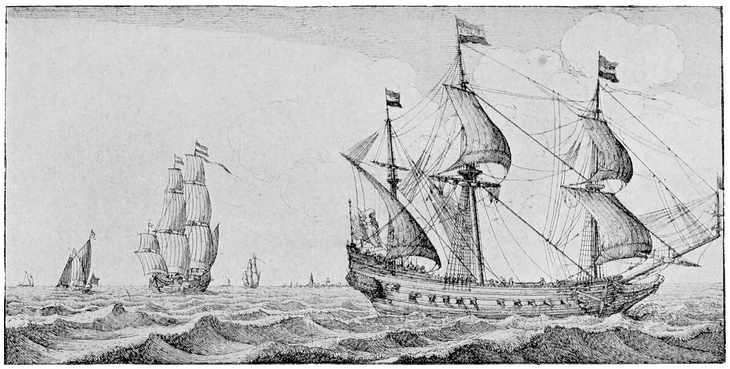
Early Seventeenth-Century Ship of War.
By a Contemporary Artist.
It is true, also, that the Portuguese showed no little courage and enterprise in their shipbuilding. Some of their fifteenth-century caracks were four-deckers, of fifteen hundred and two thousand tons, with forty guns and a thousand sailors, soldiers, and passengers. And, even if they were not by disposition and natural endowment great sailors, yet they were splendid navigators. But they were never great shipbuilders in the scientific sense, since they built by rule of thumb. The Portuguese had, indeed, done much for cartography, and yet until the Dutch Gerard Mercator introduced his “Mappemonde” in 1569, containing a new method of projecting a sphere upon a plane, the problem of how to sail in a straight line over a curved figure still lacked solution. The Dutch Wagenaer, of whom we spoke just now, historically certainly owed a great deal to the achievements of the Portuguese and Spanish, but already by the year 1577 he had written on navigation. His charts of Dutch harbours and of the Narrow Seas were, for their limited purpose, of more value than any charts which had come from the South of Europe.
It has been well said by a careful writer that British seamanship has been historically the cause of British supremacy, and that most British sea fights have been decided by bringing single ships to close action, laying220 ship against ship. If this statement is true, it is especially applicable to the Elizabethan period, when seamanship was our strong point and tactics our weakest. Never before had English sailors reached such a high degree of proficiency therein; never in so short a time had it done so much to mould national history, and to lay the foundations of an Empire.
221
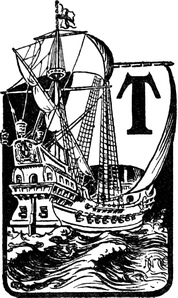
The only danger attaching to a fine achievement is lest the next may appear insignificant by its side. The dramatist who has created a splendid climax has little to fear except that his effect may be utterly spoiled by some anti-climax. Transfer the simile to the region of wars, and how often all through history do you not notice that part of the grandeur has been robbed by the number of ex-fighting men who, no longer needed for the safety of their country, find themselves at a loose end? There has scarcely been one recorded war that has not shown the soldier and sailor almost happier in fighting than in surviving.
So it was, then, that after all those years of fighting on sea, after all those expeditions towards the West Indies and Spain, after the Armada fights and lesser campaigns had at last brought settled peace to our land, there was no employment for those numerous crews which had fought with such zest and daring. And so they turned their minds to something else, according to their circumstances. “Those that were rich rested with that they had; those that were poore and had222 nothing but from hand to mouth, turned Pirats; some because they became sleighted of those for whom they had got much wealth; some for that they could not get their due; some that had lived bravely would not abase themselves to poverty; some vainly, only to get a name; others for revenge, covetousness, or as ill; and as they found themselves more and more oppressed, their passions increasing with discontent, made them turne Pirats.”
So wrote Captain John Smith in his “Travells and Observations.” “The men have been long unpaid and need relief,” wrote Hawkyns to Walsyngham on the last day of July, after they had succeeded in driving the Spanish Armada out of the English Channel, and his own gallant crew had fought like true sailormen. “I pray your Lordship that the money that should have gone to Plymouth may now be sent to Dover.” “The infection is grown very great in many ships,” wrote Howard, three weeks later to Elizabeth, “and is now very dangerous; and those that come in fresh are soonest infected; they sicken one day and die the next.” And so we can easily understand that after all these privations and disappointments the ill-treated bands of seamen drifted into piracy as the most profitable life and profession.
Even during Elizabeth’s time there were, of course, plenty of these rovers in the English Channel, the most notorious of whom was a man named Callis, who cruised about off the Welsh coast. For companions he had a man named Clinton and one whose surname was Pursser. These gained great notoriety until the Queen had them caught and hanged at Wapping. And there was a man named Flemming, who was as big a rascal and as much “wanted” as the others; but inasmuch as he performed a fine deed for his country and was a patriot more than a pirate, he received not only his223 pardon, but a good reward as well. For he was roving about in the Channel when he discovered the great Spanish Armada sailing up. Then, heedless of the fact that his own country was anxious to see him dead, he sailed of his own accord into Plymouth, hastened to the admiral, and warned him of the momentous sight which his own eyes had beheld.
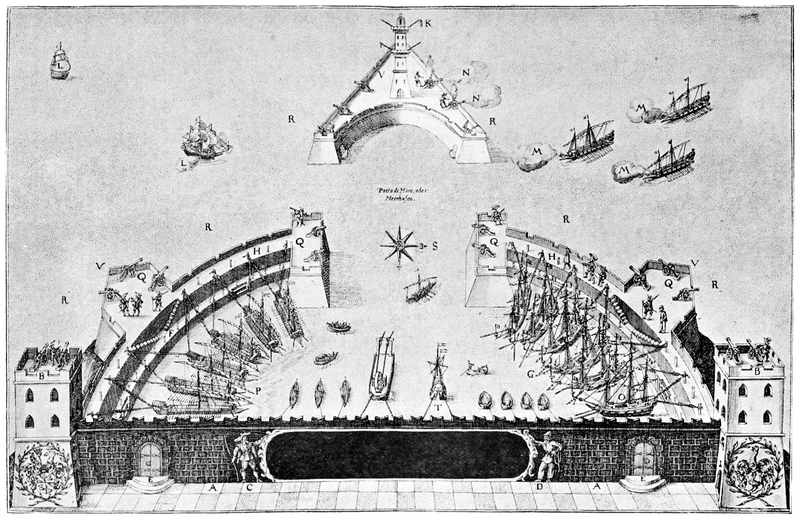
An Early Seventeenth-Century Fortified Harbour.
By a Contemporary Artist. Showing the galleys moored on one side, and the ships on the other.
Afterwards there still remained some few pirates, so that it was “incredible how many great and rich prizes the little barques of the West Country daily brought home.” But now, after peace had come and the men who had fought the Spaniards were not needed, they betook themselves to help the Moorish pirates of Tunis, Algiers, and the north coast of Africa, and many became their captains. There they were joined also by the scum of France and Holland, but very few Spaniards or Italians came with them. Some were captured off the Irish coast and hanged at Wapping: others were pardoned by James I. They wandered in their craft north and east; to the English Channel, Irish Sea, and the Mediterranean, causing panic everywhere; and this notwithstanding that they had against them warships sent out by the Pope, the Florentines, Genoese, Maltese, Dutch, and English. There were seldom more than half a dozen of these piratical craft together, and yet they would invade a seaside town, carry off property and persons, attack ships and confiscate their freights with the greatest impudence. But after a while factions grew, and “so riotous, quarrellous, treacherous, blasphemous, and villainous” a community became “so disjoynted, disordered, debawched, and miserable, that the Turks and Moores beganne to command them as slaves, and force them to instruct them in their best skill.” It was after these pirates had committed frightful atrocities as far north as Baltimore, carried away men, women, and children into slavery224 and been a terrible menace to shipping, that James I’s navy performed the only active service of his reign when it was sent in 1620 to the Mediterranean. However, though it contained six royal ships and a dozen merchantmen and was away from October to the following June, yet it did little good as a punitive expedition. It was not until 1655 that Blake settled the Tunisian pirates, set fire to all the nine ships of the enemy, and came out of the harbour again with but small loss. And though even in this twentieth century the north coast of Africa still possesses a few pirate ships which have been known to attack a sailing yacht when becalmed, yet ever since Admiral Lord Exmouth, in August, 1816, with a small fleet of British and Dutch warships, exterminated the pirates at Algiers, silenced their five hundred guns, captured the Dey of Algiers, and released twelve hundred Christians, this relic of medieval piracy has been practically non-existent in European waters.
If the sixteenth century forms the climax of English seamanship, it is the seventeenth century which unfortunately is the anti-climax. Abuses crept into the Navy, so that by the year 1618 a complete reorganisation had to be undertaken, and the bribery, embezzlement, and general corruption had to be stopped so far as was possible. And yet, for all that, there was still being made important progress both in navigation and in shipbuilding. John Napier, in the year 1614, provided his tables of logarithms, which simplified the intricate calculations of navigators. In 1678 was published “The Complete Ship-Wright,” by Edmund Bushnell, which I believe to be the earliest treatise on shipbuilding printed in English. The way the London shipwrights were wont to measure their ships was as follows: They multiplied the length of the keel “into the breadth of the ship, at the broadest place, taken225 from outside to outside, and the produce of that by the half breadth. This second product of the multiplication they divide by 94 or sometimes by 100, and according to that division, 60 the quotient thereof, they are paid for so many Tuns.”
For example, take the case of a ship 60 feet long and 20 feet broad:—
| 60 | |
| 20 | |
| —— | |
| 1200 | |
| 10 | |
| ——— | |
| 100)12000(120 | Ans. 120 tons. |
But, says this same writer, the true way to measure must be by measuring the body and bulk of the ship underwater. He also gives some of the rule of thumb standards to which they worked. For instance, the mainmast of small ships was three times as long as the breadth of the ship. Thus the ship just mentioned with a beam of 20 feet would have a mainmast 60 feet high. The topmast, in like manner, was two-thirds the length of the lower mast in all cases. The mainyard was two-thirds of the mainmast plus one-twelfth of the mainmast.
There is an illustration in “The Mariner’s Jewel,” by James Lightbody, published in London in the year 1695, that shows the method which was employed in launching a ship at that time. It is demonstrated that the vessel was allowed to rest her weight on a cradle and then hauled into the water by means of a crab winch. As there was a paucity of dry docks in those days it was usual, when any painting of, or repairs to, the bottom of a ship had to be carried out, to careen the ship. She was hove down on one side226 by a strong purchase attached to her masts, the latter having been properly supported for the occasion to prevent their breaking under so great a strain. This was in vogue until about the beginning of the nineteenth century, when the custom of sheathing ships with copper, and thereby keeping a clean bottom for several years, superseded careening.
There is many an item in Lightbody’s work which is worth our notice. He tells us that can buoys were employed in those days “for shewing of danger,” and stuns’ls were already in use on board ship. They still used the word “davids” for “davits,” and employed a drabler to lace below the bonnet of the squaresails. “Drift-sail” was the name still given to a species of sea-anchor, which was used for riding by in heavy weather. The “sail” was veered right ahead by sheets, he says, to keep her head right upon the sea. Old hawsers were made up into fend-offs. The heavy guns were hauled out by means of a guy from the foremast to the capstan. A ship’s bottom was graved with a mixture of tallow, soap, and brimstone, which preserved her caulking and made her fast. There was a rope called a horse which was made fast to the foremast shrouds and spritsail sheets to keep the latter clear of the anchor-flukes, for in those days, as one can see from old prints, the anchor was stowed at the side of the ship close to the foremast shrouds.
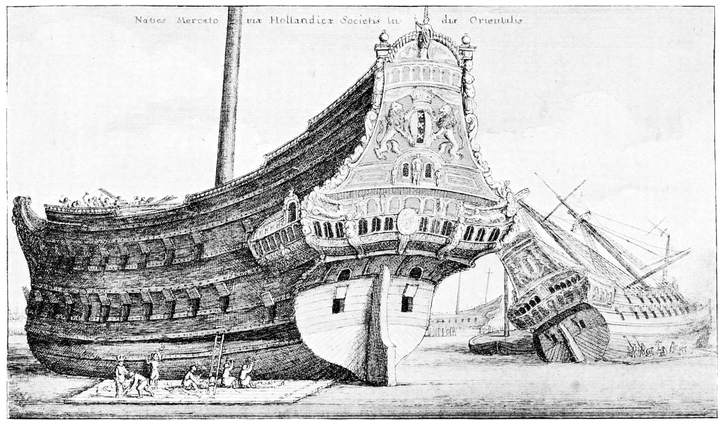
Early Seventeenth-Century Dutch East Indiamen.
By a Contemporary Artist. On the left of the picture the ship is still being built. Her hull is being caulked and her decks not yet finished. On the right a fully rigged ship has been careened so as to allow of her bottom being painted.
Monson’s “Naval Tracts” are full of information regarding the seaman’s life at the beginning of the seventeenth century. He tells us that there were shipyards in his time at Chatham, Deptford, Woolwich, and Portsmouth; and that every time a ship returned from sea the Surveyor’s duty was “to view and examine what defects happen’d in the hull or masts.” The Grand Pilot was “chosen for his long experience as a pilot on a coast, especially to carry the King’s great227 ships through the King’s channel, from Chatham to the narrow seas: as also for his knowledge to pass through the channel called the Black Deeps.” As to the life on shipboard, “first and above all things you are to take care that all the officers and company of ships do offer their best devotion unto God twice a day, according to the usual practice and liturgy of the Church of England.” During a fight, if a ship chanced to receive damage near her bilge the leak was to be stopped with salt hides, sheet lead, plugs, “or whatsoever may be fit.” To guard against the worm eating into the wood, one way was to sheathe the hull with an outer plank and then burn the upper plank “till it come to be like a very coal in every place, and after to pitch it.” Ships of 400 tons were built of 4-inch planking; ships of 300 tons had 3-inch; small ships had 2-inch, “but no less.”
The system of signalling in vogue during the first half of the seventeenth century was of three kinds. By day topsails were lowered and raised. By night lights were shown: while the shooting of ordnance was used both by night and day. At night, too, an admiral showed two lights on his poop, the vice-admiral and rear-admiral being some distance astern, and each with one light on the poop. Every morning and evening the vice- and rear-admirals manœuvred their ships so as to speak with the admiral and take their instructions, weather permitting, and then fell back into line again. If an admiral went about on the other tack at night, he fired a cannon and showed two lights, one above the other, and the rest of the fleet were to make answer. If he was forced to bear round, the admiral showed three lights on his poop, and the other ships replied with the same. If he shortened sail in the night for foul weather, he showed three lights on the poop one above the other. If in foul weather the ships of228 the fleet lost company and afterwards came in sight of each other, then “if in topsail gale, you shall strike your foretopsail twice; but if it be not topsail gale, you shall brail up your foresail and let it fall twice.” There were no fog-horns in use at this time on ships, but in thick weather they made a noise with a drum, trumpet, or would ring a bell and sometimes shoot off a musket. One man was kept continually on watch at the topmast head.
A gunner had to provide himself at sea with powder, shot, fire-pikes, cartridges, case-shot, crossbar-shot, etc., and a horn for powder, priming iron, linstocks, gunner’s quadrant, and a dark lantern. The types of guns now in use consisted—reckoning from the largest to the smallest—of the cannon royal, cannon, cannon serpentine, bastard cannon, demi-cannon, cannon petro, culverin, basilisk, demi-culverin, bastard culverin, saker, minion, falcon, falconet, serpentine, and rabanet. The cannon royal had a bore of 8½ inches, shot a 66-lb. shot a distance of 800 paces; whilst the rabanet had a 1-inch bore, shot a 1-lb. shot 120 paces.
A capital ship of the time of James I carried two guns in the gun-room astern and two in the upper gun-room, which was “commonly used for a store-room, lodgings, and other employments for a general or captain’s use, and his followers.” Above these two gun-rooms was the captain’s cabin, with the open galleries astern and on the sides. Fowlers and the smaller guns were thrust out from here.
The author of “The Light of Navigation,” published in 1612, remarks that among other things the “seafaring man or pilot” ought to know how to reckon tides, “that he may knowe everie where what Moone maketh an high water in that place, that when he would enter into any Haven or place, where he can not get in at lowe water, then he may stay till it be229 half flood.” He ought to know also the direction of the tide, and complains that some “upon pride and unwillingnes, because they would keepe the art and knowledge to themselves,” “will not suffer the common saylers to see their work.”
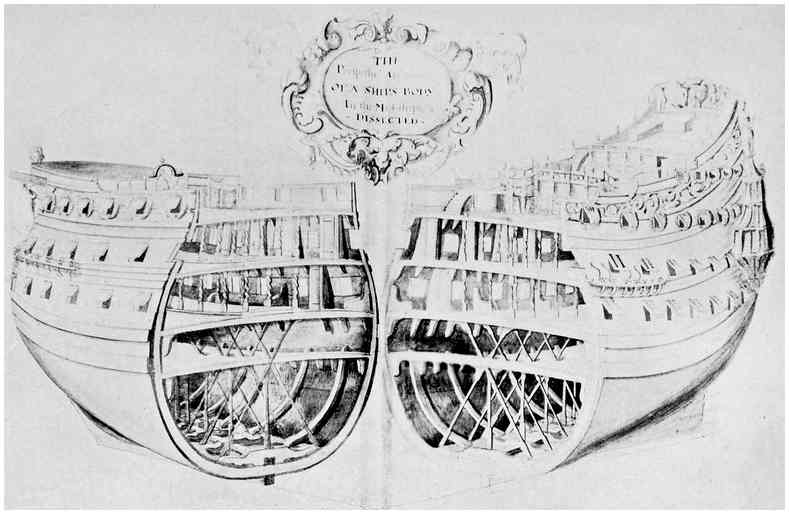
“The Perspective Appearance of a Ship’s Body, in the Midships Dissected.”
This ingenious drawing, which gives the reader a good idea of the interior of a seventeenth-century ship, is among the Pepysian MSS. in Magdalene College, Cambridge, and entitled “Mr. Dummer’s Draughts of the Body of an English Man of War.” Edward Dummer was assistant shipwright at Chatham. Pepys described him in 1686 as an “ingenious young man.”
In the seventeenth century the lieutenant was still not necessarily a seaman. He was a well-bred gentleman, knowing how to entertain ambassadors, gentlemen, and distinguished visitors received on board. He was capable of being sent as a responsible messenger to important personages, and was, in short, of far more use as a social instrument than as a naval officer. During the Commonwealth soldiers again became sea-commanders, and the names of Blake, Monck, and Popham will instantly leap to the mind. Up till the time of Charles II the sea service had not always enjoyed the dignity of being deemed a profession worthy of gentlemen. There were, of course, exceptions; but as a general rule this was the case. But, thanks to the example of the Duke of York, afterwards James II, the Navy during the time of his brother Charles II became fashionable—too fashionable, in fact; for numbers of gentlemen got themselves promoted to the rank of ship’s captain while knowing very little indeed about ships and their ways. One has only to read through some of Mr. Pepys’ remarks to appreciate this unfortunate condition of affairs.
The reign of James II gave a still greater impetus to the English naval service. There was an improvement in administration and organisation generally, thanks partly to the personal inclination of James towards maritime matters, and partly to the lessons which he and others had learned during the Anglo-Dutch sea fights. But as to placing naval education on a sound basis, there was no such thing in England till the end of the Stuart period, although across the Channel the French230 were seeing to it that their sailors obtained not only a thoroughly practical, but also an adequate theoretical training. The English midshipman came aboard for his first cruise a complete landsman with no training. He managed to learn the rudiments of seamanship from the boatswain, and to get a smattering of elementary navigation; yet it was anything but a satisfactory training. There was little enough science in the sailor’s work, and hundreds of ships were wrecked through lack of proper instruments, until, in the year 1676, the founding of Greenwich Observatory enabled nautical astronomy to be developed to the great advantage of ships and men. Thanks to the English overseas colonies and the Newcastle colliers, to which Boteler refers in his famous “Dialogues,” published in 1685; to the numbers of other coasters; and last, but most important of all, to the long protracted Dutch wars which had taught many a greenhorn how to use the sea, there was a large and growing body of seamen, many of whose descendants were to fight under Rodney, Hawke, Jervis, Nelson, and other famous admirals at a later date.
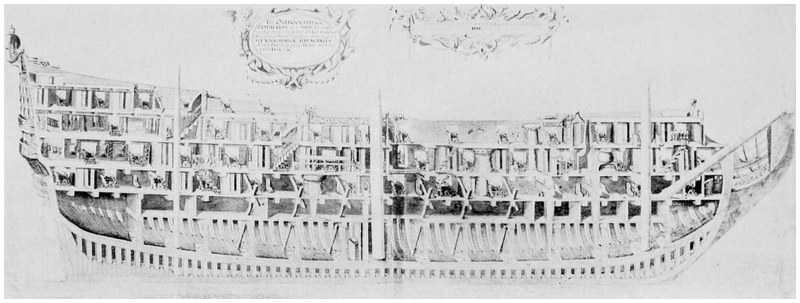
The “Orthographick Simmetrye” of a Seventeenth-Century Ship.
Being another of “Mr. Dummer’s Draughts.”
At the end of the seventeenth century, captains in the Navy were being paid £1 10s. a month during the time of peace, but during war this was raised to £3. The idea of a naval uniform originated in France in the year 1669, but the practice of all grades of naval officers wearing uniform did not become general until the time of the first Empire. During the reign of our Charles II, ships of the English Navy carried as officers, captains, lieutenants, masters, pursers, surgeons, and chaplains. The seventeenth-century French Navy owed a very considerable debt to the far-sighted enterprise of Colbert, but directly it owed a very great deal to the labours of its chaplains, who instructed the pilots in their work and taught naval aspirants the mysteries of astronomy and navigation. During the first part231 of the seventeenth century the finest shipbuilders had been the Dutch, for, thanks to their East Indian and other colonies, Holland had every reason for building big ocean-going ships. No one in Spain, England, or France could for a time build ships like theirs. And so it was but natural that the zealous French went to Holland, lived there for some time in order to learn shipbuilding, translated the best Dutch authorities on this subject into French, and returned home to build on even more scientific lines. Therefore in the eighteenth century the French could build vessels as no one else in the world. It was from the latter, in turn, that the English at last acquired so much skill that the old rule-of-thumb methods of ship construction were for ever banished and the era of scientific shipbuilding entered upon. In such scientific matters as the improvement of gunnery, the log, the stability and better under-water design of ships, France led the way for those vast reforms which were subsequently to follow.
In the whole history of shipbuilding there is no name which stands out so prominently as Pett. From the time of Henry VIII right down till that of William and Mary, one or more members of this family were busy building ships for the State. At the beginning of the seventeenth century the finest and largest ship which had ever been in the British Navy was the Prince Royal, of 1200 tons. She was designed and built by Sir Phineas Pett, and her keel was laid down in 1608, and the first attempt to launch her was made on the 24th of September in 1610. Among the Harleian manuscripts in the British Museum is a quaint volume of a hundred and thirteen pages, entitled “The Life of Phineas Pette, who was borne Nov. 1st, 1570,” and the account continues down to the year 1638. It is a curious record, in which the most intimate domestic matters are mixed up with the most interesting facts concerning the232 building of ships. For example: “In the beginning of August, I was summoned to Chatham with my fellow master shipwrites there to take a survey of the Navy according to the yearly Custom.... The 6th. of this Month of Augt. my wife was delivered of her 5th. son at Woolwich.”
However, this MS. attracts our attention, because it gives us a most interesting and detailed account of the way ships in England were launched only twenty-two years after the Armada was fought and vanquished. There is, I believe, in existence no such satisfactory a picture of the time-honoured ceremony of sending a ship for the first time into the water that is to be her abiding support. I will, therefore, ask the reader to be so good as to accompany me down to Woolwich a few days before the end of September in that year 1610. Here, at last, after two years’ worry, work, and anxiety, Pett has finished his master-work, the biggest craft which even a Pett had ever fashioned. Even to-day, as then, the shipbuilder feels never so much anxiety as the day on which the launching of a great ship is to take place. A hitch—a difficulty in persuading the ship and water to become acquainted—may spoil the labour of many a month, besides being a source of great depression to all concerned, from the builder downwards and upwards.
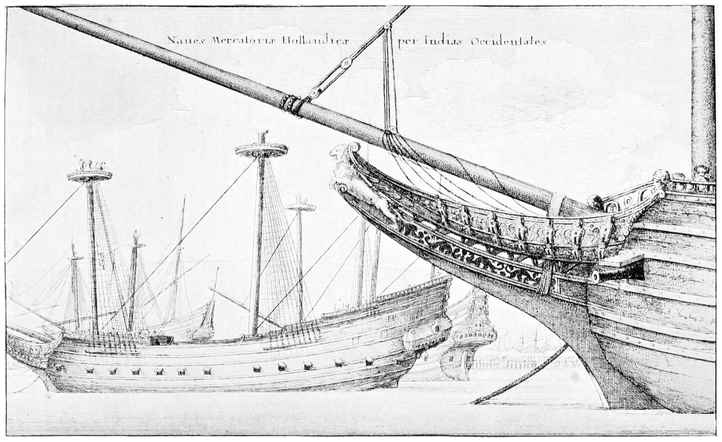
Early Seventeenth-Century Dutch West Indiamen.
By a Contemporary Artist. These were the merchant ships which used to bring back to Holland the rich cargoes from across the Atlantic. Notice the exquisite carving.
However, here we are arrived at the Woolwich yard, where the great Prince Royal is seen towering high above other craft, and the last touches are being given alike to the ship and to the arrangements, for Royalty are coming to grace the launching ceremony. There was a great “standing sett up,” Pett informs us, “in the most convenient place in the yard for his Majesty, the Queen and the Royal Children, and places fitted for the Ladies and Council all railed in and boarded.” All the rooms in Pett’s own lodgings had been “very233 handsomely hanged and furnished.” “Nothing was omitted that could be imagined anyways necessary both for ease and entertainment.” Pett had been round the dockyard on Sunday, September 23, and then in the evening came a messenger to him with a letter ordering him to be very careful and have the hold of the Prince Royal searched lest “some persons disaffected might have board some holes privilly an’ the ship to sink her after she should be launched.” Pett, however, was far too wide-awake not to have foreseen any such possibility.
On Monday morning, then, he and his brother and some of his assistants had the dock-gates opened. Everything was got ready for the approach of high tide and the time when the Prince Royal was to be floated. But matters were not going to be quite satisfactory. It was, of course, a spring tide, but unfortunately it was blowing very hard from the south-west, and this kept back the Thames flood so that the water failed to come up to its expected mark, and the tide was no better than at neaps. This was a great disappointment, for presently arrived the King and his retinue. Pett and the Lord Admiral and the chief naval officers received James as His Majesty landed from his barge, but it was with a heavy heart. The King was conducted to Mr. Lydiard’s house, where he dined. The drums and trumpets were placed on the poop and forecastle of the Prince Royal, and the wind instruments assigned their proper place beside them. But still the tide was behind-hand.
So Pett thought out a device. About the time of high water he had a great lighter made fast at the stern of the Prince Royal so as to help to float the latter. But it was of no avail, for the strong wind “overblew the tide, yett the shipp started, but yet the Dock gates pent her in so streight that she stuck fast between them234 by reason the ship was nothing lifted with the tide as we expected she should, and ye great lighter by unadvised counsel being cut of(f), the sterne of the ship settled so hard upon the ground that there was no possibility of launching that tide.” Furthermore, so many people had gone aboard the ship that one could hardly turn round. It was a terrible contretemps that the ship remained unyielding, for here were the distinguished visitors on board waiting. “The noble Prince himself accompany with ye Lord Admirall and other great Lords were upon the poope where the standing great guilt Cupp was ready filled with wine to name ye shipp so soon as she had been on floate according to ancient Custome and ceremoneys performed at such time by drinking part of the wine, giving the ship her name and heaving the standing cup overboard.”
But time and tide wait on no man, prince or shipbuilder. It was no use to expect a launch that day. “The King’s Majtie,” Pett adds sorrowfully, “was much grieved to be frustrate of his expectation comeing on purpose tho very ill at ease to have done me honour, but God saw it not so good for me, and therefore sent this Cross upon me both to humble me and make me to know that however we purposed He would dispose all things as He pleased.” Thus, at five that afternoon, the King and Queen departed. When the last guest had gone, Pett, pathetic but plucky, set to work with his assistants “to make way with the sides of the gates,” and, plenty of help being at hand, got everything ready before the next flood came up. The Lord Admiral had sat up all night in a chair in one of the rooms adjoining the yard till the tide “was come about the ship.” It was a little past full moon—when the tides, of course, are at their highest—and the weather was most unpropitious. It rained, it thundered and it lightened for half an hour, during which Prince235 Henry returned to the yard and went aboard the Prince Royal together with the Lord Admiral and Pett. It was now about 2 a.m., or an hour before high water. Another attempt was made to launch the great ship, and happily this time she sped into the water without any difficulty or the straining of screws or tackles. As she floated clear into the channel, the Prince drank from the cup and solemnly named the ship the Prince Royal. Thus, at length, this glorious ship that was to be so much admired presently with her fine carvings and decorations, with her elaborate figurehead at the bows representing her namesake on horseback, kissed the waters of the Thames. Soon, fitted with three lanterns at the poop and her yards and masts, her fifty-five guns and her spread of canvas, she would go forth to the open sea, the proudest ship flying the British ensign. But though this ship contained many of the improvements which had been made recently in the art of shipbuilding, yet there had been a scandalous excess of expense, for the Commissioners discovered that more than double the loads of timber had been used than had been estimated for.
It is undeniable that the Stuart seamanship was inferior to that of the Elizabethans. They could not handle their vessels with such dexterity as the contemporaries of Drake. The sailors who had not become pirates were not the equals of those who had fought against the Spaniards; and this for two reasons: firstly, the fisheries had become so bad as to discourage putting to sea; and, secondly, the voyages of discovery were now far fewer. As already stated, one of the happy results of the Anglo-Dutch wars was that they gave experience to inexperienced men. Often enough, too, as in the fleet that was sent in 1625 to Cadiz, the ships were leaky, cranky, and fitted with defective gear and the scantiest supply of victuals. Add to these drawbacks236 the incapacity of the officers and the diseases of the men, and you may rightly pity the lot of the sailor in those times. They were even put ashore at Cadiz fasting, so that they promptly filled their poor bellies with the wine of the country and became drunk.
Can you wonder, therefore, that during the Civil War, after there had been a series of mutinies during the reign of Charles I, the whole of the Navy, with the exception of one ship, deserted the royal cause as a protest against the bad food, the irregular pay, and the incapable officers? After that the victuals were improved, their wages were paid at a fair scale and with punctuality, and their affairs better regulated. But not even then were matters entirely satisfactory. As one reads through the correspondence of this period one can see that discipline was woefully lacking. Even Blake, keen disciplinarian that he was, found it necessary to write on the 1st of December, 1652, to the Admiralty Commissioners to the following effect soon after the encounter with the Dutch fleet off Dungeness: “I am bound to let your Honours know in general that there was much baseness of spirit, not among the merchantmen only, but many of the State’s ships, and therefore I make it my humble request that your Honours would be pleased to send down some gentlemen to take an impartial and strict examination of the deportment of several commanders, that you may know who are to be confined and who are not.” Captain Thomas Thorowgood—is not the surname suggestive of the Puritan period?—also wrote to complain that his crew had actually refused to accept their six months’ pay as being inadequate. “On Saturday night they were singing and roaring, and I sent my servant to bid the boatswain to be quiet and go to their cabins; but they told me they would not be under my command, so I struck one of them, and the rest put out the candle237 and took hold of me as though they would have torn me to pieces, so that I am almost beside myself, not knowing what to do.”
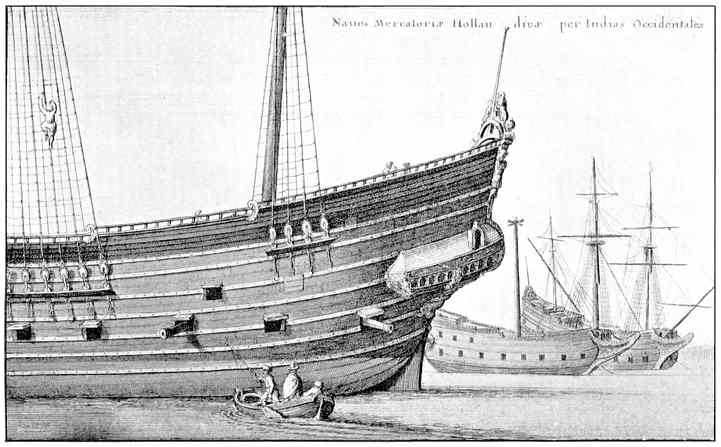
Fitting Out an Early Seventeenth-Century Dutch West Indian Merchantman.
By a Contemporary Artist. Observe the elaborate stern gallery.
When Blake wrote to Cromwell in August, 1655, from on board the George, he complained of various matters. When he had wished to blaze away at the Spanish fleet there was a little wind “and a great sea,” so that he could not make use of the lower tier of guns. This arose from the old mistake of having the gun-ports too near the water’s edge. Furthermore, “some of the ships had not beverage for above four days, and the whole not able to make above eight, and that a short allowance; and no small part both of our beverage and water was stinking.” ... “Our ships are extreme foul, winter drawing on, our victuals expiring, all stores failing, and our men falling sick through the badness of drink and through eating their victuals boiled in salt water for two months’ space. Even now the coming of the supply is uncertain (we received not one word from the Commissioners of the Admiralty and Navy by the last); and, though it come timely, yet if beer come not with it, we shall be undone that way.” Again he writes from the George, “at sea, off Lagos,” in 1657: “The Swiftsure, in which I was, is so foul and unwieldy through the defects of her sheathing laid on for the voyage of Jamaica, that I thought it needful to remove into the George.”
The importance of the Anglo-Dutch wars consists, inter alia, in the display of tactics that must now be mentioned, for this, if you please, represents the period of transition. We dealt some time back with the lack of tactics of the Elizabethan period, and saw that at least there was in existence a yearning after the line-ahead formation. The object of this is, of course, to enable each ship to fire into the enemy her very utmost, and give her opponent the benefit of a broadside. But238 it was not till the seventeenth century that this theory got a real foothold. Between 1648 and 1652 certain fighting instructions were issued for the English Navy, and may be summed up as follows: The fleet was not to engage the enemy if the latter should seem more numerous. On sighting the enemy, the vice-admiral and rear-admiral respectively were to form wings with their ships, to come up on either side of the admiral and to keep close to him. When the admiral gave the signal, each ship was to engage the hostile ship nearest to him, the admiral tackling the admiral of the enemy. Care must be taken not to leave any of their own ships in distress, and commanders of all small craft were to keep to windward of the fleet and to look out for fire-ships.
There was no instruction enjoining line-ahead as a battle formation, but it was understood, and when Blake had his first encounter with Marten Tromp the English ships formed into single-line ahead. So much for the moment with regard to tactics. What was the strategy displayed at the commencement of the Anglo-Dutch wars? Consider a moment what would most probably be that strategy employed by the British Navy to-day at the beginning of hostilities between ourselves and Germany. We should assuredly do three things: (1) We should close up the Straits of Dover and intercept German liners homeward bound. (2) That being so, the only possible chance of the enemy’s ships reaching their Fatherland would be to go round the north of Scotland: so we should have a squadron off the north-east coast of Scotland to thwart that intention. (3) And, lastly, we should send some of our warships across the North Sea to blockade German ports.
Now except for a comparatively slight coast erosion and the shifting of minor shoals, Great Britain in the239 twentieth century is geographically the same as in the seventeenth. Instead of a German enemy, imagine that Holland is the foe; instead of the German liners, substitute the Dutch Plate ships; instead of the modern steel steam warriors, substitute sail-propelled warships. Otherwise you have exactly similar conditions. The strategy is the same: only the century and the type of ships are different. For what happened? Ayscue with his squadron remained in the Downs to catch the Dutch Plate ships bound home to Holland. Blake was sent with sixty or seventy ships to the north-east of Scotland and captured a hundred of the Dutch fishing fleet, and then proceeded further north to intercept the Dutch merchantmen between the Orkneys and Shetlands. He then came in contact with the Dutch fleet and prepared for war, but a gale sprang up and dispersed Tromp’s ships. It was only the lack of good charts that made the English sea general reluctant to cross the North Sea into the shoal-strewn Dutch waters, though in fact they did cross later and blockade. Thus we may say that at any rate by the beginning of the first of these Anglo-Dutch wars there is the surest evidence that naval strategy was appreciated at its full value, and that it was modern and not medieval strategy.
And now let us pass to the year 1653, after the English fleet had come in from the English Channel to Stokes Bay for a refit. Important new orders were now issued which insisted that ships were to endeavour to keep in line with their chief so as to engage the enemy to the best advantage. When the windward line had been engaged, the English ships were to form in line-ahead “upon severest punishment.” Now please note two points: that this line-ahead tactic was not of foreign but English origin, and that following this order a general improvement in tactics followed. The second240 Dutch war showed the progress which had been made since the new type of Fighting Instructions had been issued. Earl Sandwich, the Lord High Admiral, had issued orders just a month before war was declared, to provide for the formation of line-abreast, and for forming from that order a line-ahead to port and starboard. The principle, too, of sailing close-hauled in single-line ahead is conspicuous after the Commonwealth period. During the first year of the third Dutch war still further progress was observed by the officers being instructed as to how they should keep the enemy to leeward and how to divide the enemy’s fleet if the latter were to windward; and the regulations once more insisted on the commanders maintaining their line-ahead and avoiding firing over their own ships. Two distinct schools of tactics arose: one purely formal, the other allowing room for personal initiative as occasion suggested. In the end the former won, and this continued till the end of the eighteenth century.

An Early Seventeenth-Century Dutch Shipbuilding Yard.
After a Contemporary Artist. Painting the hull of an ocean-going merchantman
There is among the seventeenth-century MSS. in the British Museum still to be found a great deal of interesting data which well illustrates the experiences of ships and men in these times. Notwithstanding the incompetency of some of the captains who owed their position less to their ability as seamen than to influence, yet there were others who had been at sea most of their lives and had had command of merchant ships for years. Such men as these were of the highest value to their country during the Anglo-Dutch wars. You will remember that battle off Portland in 1653, during the first Dutch war. Richard Gibson, who was purser on board the Assurance at the time, has left behind his reminiscences of this fight. In the beginning of February the English fleet was sailing from Dover down Channel with a fair easterly breeze. “Genrl Blake and Deane in the Tryumph, Sr John241 Lawson Vice Admll of the Redd in the Fairfax, Captn Houlding Rear Admll of ye Redd in the Ruby, Genrll Monck Admll of the White in ye Vanguard, Sr Wm Penn Admll of the Blew in the Speaker (now named the Mary), and the Whole Fleet about 52 Saile spread their Colours of Redd White and Blew, and their Flaggs Ensignes and Pendants (as now) according to their Division of Squadrons, and Sayled to meet the Dutch Fleet.... Upon our first Sight of the Dutch all the English had their Starbord tacks aboard; Genrll Blake Espying the Dutch Fleet to bare down before the Winde upon him got his Shipp ready, haled his Main Sayle up the Brailes, and braced his foretopsaile to the Mast.... The Dutch Fleet in a Boddy bore downe upon the Generalls, and pressed upon the Tryumph with as many Shipps as could well lay about her. Upon which Sr Wm Penn Tacked and his Division with their larboard Tacks (as soon as they could) stood thorow the Dutch fleet one way: as Sr Jon Lawson (with his division) did the other.... Upon which such of the English Friggotts as Sailed well Stered out of Gunn Shot of the Dutch Fleet to Windward on the larbord side, untill they had got a head of severall Dutch Shipps of Warr: then set their Starbord Tacks and stand right with them, and boarded the first Dutch Shipp they could.”
It seems strange to us in these modern days, when excellent and reliable charts can be had for a few shillings, to read in the official dispatch signed by Monck and Blake to Cromwell that they supposed they would have destroyed the Dutch fleet off the Lowland coast, “but that it grew dark, and being off of Ostend among the sandes, we durst not be to bold, especially with the greate ships; soe that it was thought fitt we should anchor all night, which we accordingly did about 10 of the clock.” The way these ships manœuvred242 in battle so as to get to windward of their enemy was as pretty a sight as a fleet of racing yachts to-day manœuvring for the same ambition at the starting-line. At the battle of Lowestoft in June, 1665, at sunrise, the Dutch fleet “bore up to V(ice) A(dmiral) Minnes, and gave him a broadside, who received them accordingly, and so,” says a Harleian MS. of that date, “their whole Fleet passed by ours, firing at every Ship as they went, and receiving returnes from them, not one of either side being out of play at their first encounter: immediately upon which his R(oyal) H(ighness) made his Signe of the Tacking, that we might still keep the wind of them, which was as happily executed, notwithstanding that the Ennemy also strove for it.”
Yet again we have proof of the importance which the English Navy attached to falling into line of battle. The occasion was the four days’ battle off the North Foreland in June, 1666. When de Ruyter’s fleet had been sighted to leeward, our “General calld immediately a Council of Flag officers: which being done, ye signe was put out to fall into ye ligne of batle ... about 1 of ye clock ye fight began, Sir G. Askue with ye white squadron leading ye van.” In the official report of the battle of Solebay (May, 1672), Captain Haddock, in command of Lord Sandwich’s flagship the Royal James, shows that orders during battle were sent by means of the ship’s boats. “I had sent our Barge by my Lord’s command ahead to Sir Joseph Jordaine to tack, and with his division to weather the Dutch that were upon us, and beat down to Leeward of us, and come to our Assistance. Our Pinnace I sent likewise astern (both Coxswains living) to command our ships to come to our Assistance, which never returned.” And there are other instances of falling into line, as, for instance, at the battle on the 11th of August, 1673. “His H(ighnes)s Pr. Rupert seeing us come with that243 faire wind,” says the Stowe MS., “gave us the Signall to beare into his wake.” And again in the evidence of the Dutch Rear-Admiral Schey at the court-martial on Torrington after the battle of Beachy Head: “On the 10th, being Munday morning, ye Admirall Torrington made a signe for ye ranging ourselves in a line, and our fleete being got into a line, ye signe for engaging by a bloody flag from ye Admirall’s foretopmast head being putt up.”
We spoke just now of the absence of good charts. It was Charles II who, being himself greatly interested in navigation and finding that there were no sea charts of the British Isles except such as were Dutch or copies of the Dutch—and very erroneous at that—gave a man named Greenville Collins command of a yacht for the purpose of making a sea survey, “in which service,” says Collins, “I spent seven years’ time.” James II, himself a great admiral, encouraged this work till its completion, and so good and accurate were the charts that they were in active use at any rate till the end of the eighteenth century. As to the lighting of the coast, this was still in a very primitive condition. The first navigation light in this country was that of the Roman Pharos at Dover, a day-mark which mariners still see to-day as they come bound up Channel. In monastic times probably St. Aldhelm’s (better known as St. Albans) Head showed a light to warn ships from the land, and it is also thought that there was a light at Flamborough51 and in Flintshire. In 1685, Lowestoft, Dungeness, the North and South Forelands, Orfordness, Flamborough, Portland, Harwich, and the Isle of Man were all lighted by beacon fires of wood and coal. These coal fires continued in some of the lighthouses round our coast even till well into the reign of William IV. But the244 Argand lamp, which was invented during the reign of James II, gradually and surely took the place of the older-fashioned beacon. And if we may, whilst we are on the subject, anticipate a few years, we may add that though in William IV’s time lights were more numerous and the system of buoys was well established, yet lightships were practically non-existent. The first lightship dates from 1732, when Robert Hamblyn and David Avery established such a ship at the Nore.
We may pass now to consider the conditions which regulated the work of Stuart seamen on board one of the ships such as fought against the Dutch. We have to think of a type of warship that was nothing else than a slightly developed specimen of the Elizabethan period. The difference between the Tudor and Stuart ships at their fullest development is merely that the latter had become much bigger and carried additional sails and guns and crew. As a broad statement, this sums the matter up in the fewest words. Had you passed one of the biggest of the Stuart ships at sea you would have seen a three- and sometimes a four-masted craft with topsails and t’gallants above her courses. On such a ship as the Sovereign of the Seas, if we are to judge by a perfectly authentic engraving, royals were also set sometimes. On the mizzen you would have observed the lateen sail still in existence. What especially would have struck you would have been not merely the elongated beak, but the very long bowsprit. The sailors had to creep out along this spar, keeping themselves, by hanging on to a stay or spreader, from slipping into the ocean every time the vessel rose or fell to the motion of the waves. It was a pretty wet job to lay out along there in a breeze of wind when the beak-head was dipping well down into the sea every time she pitched and hurling a veritable cascade over them. There was one squaresail bent to a yard underneath245 the bowsprit, and this water-sail had a couple of round holes—one at either side low down near the foot—the object being to permit the water, which this low sail scooped up, to escape. The sheets of this sail led aft and came on board abaft the fore shrouds. In fine weather a bonnet was sometimes laced to this spritsail. But in these Stuart ships there was also a square spritsail hoisted on a sprit-topmast. To hoist this sail the men had, of course, to go right out to the extreme forward end of the bowsprit. Above this topmast flew the Union Jack.
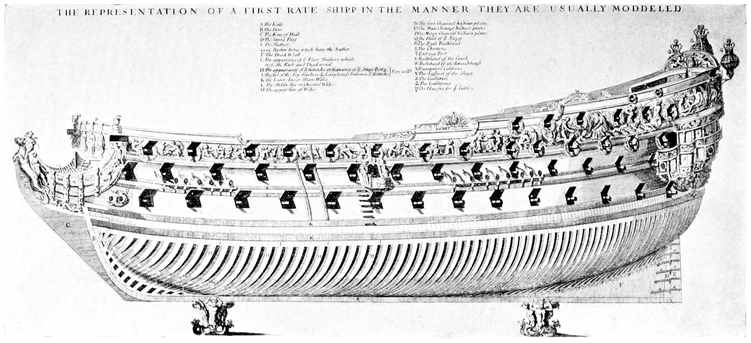
A Seventeenth-Century First-Rate Ship.
Embarkation was made by means of the “Entring Port,” which is clearly shown amidships.
Had you gone aboard such a vessel you would have found she had three decks and a forecastle, a quarter-deck, and a “round-house.” The lowest tier had thirty square-ports for demi-cannon and cannon. There were thirty ports also on the middle tier for demi-culverin and culverin. But her upper tier had twenty-six ports for lighter ordnance. Her forecastle and her half-deck had twelve and fourteen ports respectively, and there were thirteen or fourteen more ports “within board for murdering pieces,” as well as a good many holes for firing muskets out of the cabins. Right forward and right aft respectively she carried ten pieces of chase-ordnance.
As you paced her spacious decks you would have realised that you were on board some better finished article than belonged to Elizabethan days. The workmanship and decoration would have struck you as of a higher class. From her great ensign flying over the poop to the smaller Union Jack on the sprit-topmast; from her royal standard, flying at the main, to her keel, she would have appeared a massive, substantial creature of wood and able to withstand a good deal of battering even from the Dutch ordnance. You would have noted, too, the many carved emblems pertaining to land and sea which decorated her—the angelic figures holding246 up devices, the cupids, and “symbols of navigation,” all done in gold and black. You would have wondered at the elaborate figurehead representing a royal personage on horseback prancing over the waves. And finally, when you came round to the stern, you would have remarked the elaborate allegorical picture of Victory, or some other suitable subject, and the five great poop-lanterns—one of them so big that “ten people could stand upright in it”—crowning the whole thing. Seventy-five feet, you would have been told, as you looked over the side, she measured from the keel to her lanterns.
The poop-deck ended some distance abaft the mizzen-mast: the quarter-deck came just as far forward as the mainmast. Below the quarter-deck was the upper deck, which ran the whole length of the ship. Next below came the main deck, where the heaviest guns were kept. The forecastle was really a substantial fortress which rose from the upper deck, and, by the aid of its guns already mentioned, could look after itself even when the enemy had boarded the ship and obtained possession of the rest of the decks. Sometimes a light topgallant forecastle was erected above the forecastle. Additional to the guns already mentioned, swivels were also mounted on quarter-deck and poop, and would be very useful in case one of the enemy’s ships came alongside for boarding. The cable of such a ship would be about a hundred fathoms long of 21-inch hemp, her anchors being respectively of 430 lbs., 150 lbs., and 74 lbs. weight. Davis’ quadrant or backstaff was still used, and the log-line was an appreciable assistance.
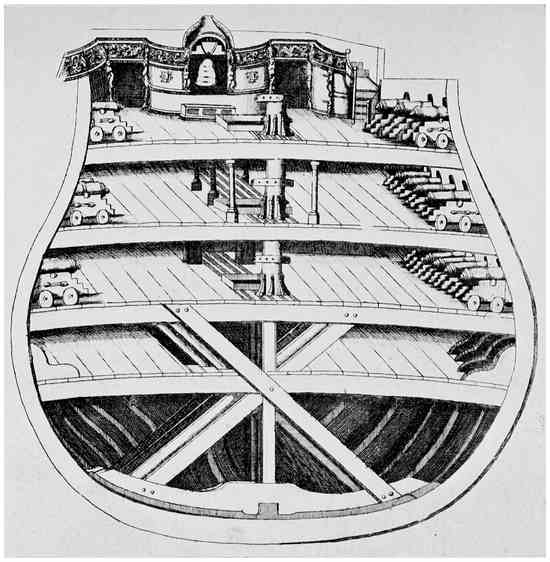
Section of a Three-Decker.
Showing construction and gun tiers.
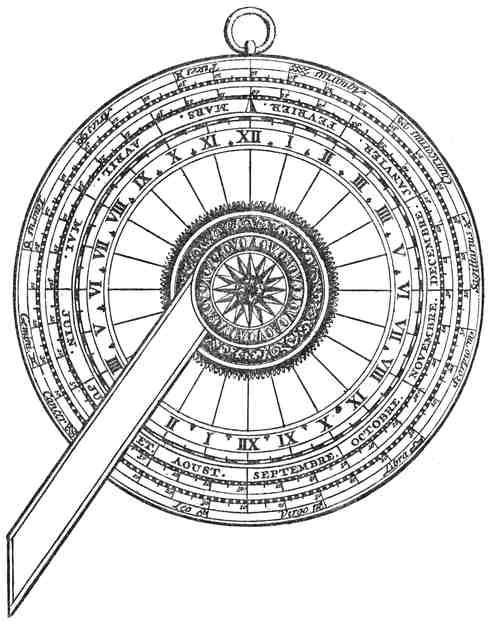
Nocturnal.
Employed at sea for finding the hour of the night by the North Star.
Below you might have found the dull red everywhere a monotonous colour. But there was a reason: it prevented the human blood spilt in an engagement from being too conspicuous. So also the gun-carriage247 was painted the same hue. All the ports were square except on the upper and quarter-decks, where the ports were circular, and surrounded with gilt wreaths. Externally the upper works of the hull above the line of the upper decks were painted dark blue with gilt decorations.248 Below this the ship was painted yellow down to the lower deck ports, with a broad band of black along the water-line. Her bottom was painted white, with the anti-fouling composition. Various experiments were tried for sheathing the ships with lead, but eventually a fixed method was adopted for about a century, which consisted of hammering numerous broad-headed nails close together along the ship’s bottom, and then paying thereon a composition of tallow and resin.
The nocturnal was still used for finding the hour of the night by the North Star, and the moon-dial for finding the time of high water. Spherical and plane trigonometry, the use of charts and globes, the application of Gunter’s scale and Briggs’ logarithms, the use of Mercator’s chart—these were the subjects which a seventeenth-century navigator was expected to learn if he were a genuine “tarpaulin,” and not an ignorant, swaggering land-lubber promoted by influence only.
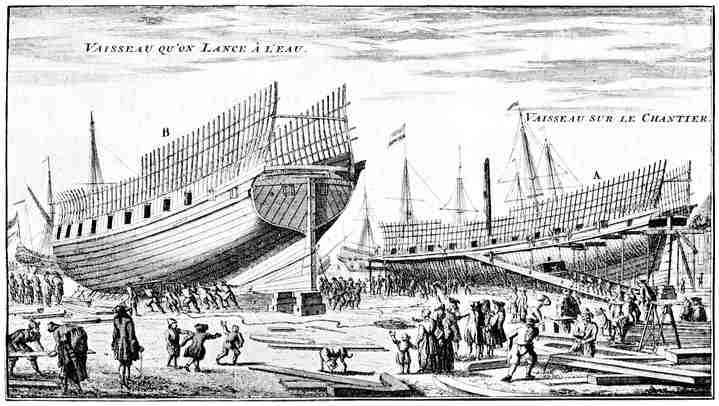
Building and Launching Ships in the Eighteenth Century.
The vessel on the left is in process of being launched into the water. The ship on the right is still on the stocks.
249
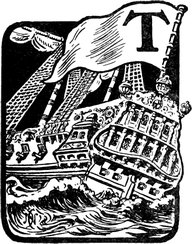
The lot of the modern seaman is of a vastly different order of things from that of the eighteenth-century sailor. Hardships though there may be in this twentieth century, yet they are not to be mentioned when we remember the hard-swearing, bullying days of Queen Anne. Morals, both ashore and afloat, were at a particularly low ebb; irreligion and blasphemy were rampant. On board ship there was very rarely Divine worship, even on the large East Indiamen, although this neglect was certainly contrary to orders. But the managers themselves, in order to save the expense of having to carry a chaplain, used to rate their big ships as of only 499 tons, and so keep themselves within the law.
One of the most interesting personalities of this period was William Hutchinson, who for some time was a famous privateer. As an instance of the kind of tyrannical captains of his day, he mentions one whom he remembered in the Jamaica trade. The latter used to make his ship a veritable floating hell for all concerned. He was an excessive drinker, he was a notorious gambler, always seeking a quarrel, and much addicted to heavy swearing. He never got the best out of his250 people, for the reason that when he was not maltreating his men he was damning his officers. If during a heavy squall the officer of the watch offered to take in sail or to bear away, this virulent skipper would regard such a suggestion as an act of piracy. And yet he himself was so heedless of what was prudent, that he would sometimes run his ship before the wind and carry on till she was overpressed and could not be controlled by the helm. And there came a time when this skipper and his ship put forth to sea and never came back at all.
Hutchinson wrote one of the most interesting books on seamanship which it has ever been my pleasure to read. His complaint was that too many men were so devoted to the methods which they had been accustomed to, that they could not be prevailed upon to try others which were better. There certainly was a good deal of ignorance about in this eighteenth century. Some men, he says, endeavour to make ships perform impossibilities, as, for instance, backing their craft astern to clear a single anchor when the wind is right aft against the windward tide; or trying to back a ship with sails so set as to prevent her shooting ahead towards a danger when laid-to; or driving broadside with the wind against tide, not knowing that a ship driving on either tack will always shoot forward the way her head lies, in spite of any sail set aback. He complained, too, of the neglect of sea officers’ education. One may add that the only training which naval officers received at this time was by going to sea. They came from the shore to the quarter-deck and picked up what knowledge they could. It is true that, in 1727, George II established a Naval Academy at Portsmouth. But it was a very exclusive institution, and open to only a few of the sons of the nobility and gentry. Therefore it languished through neglect before very251 long, but in 1806 was raised to the dignity of a Royal Naval College.
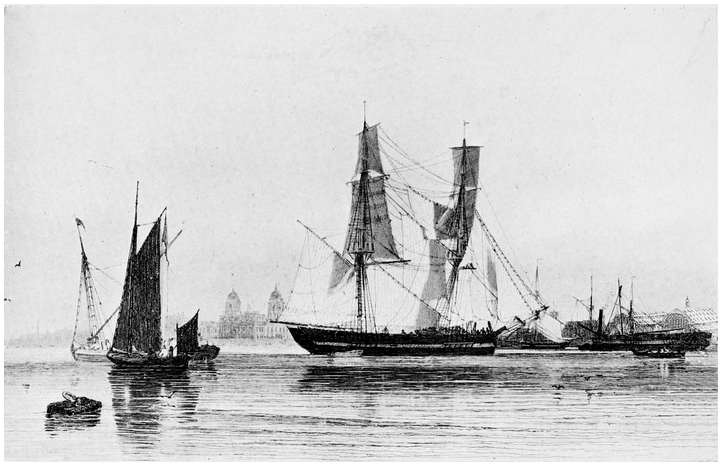
Collier Brig.
As seen by E. W. Cooke at the beginning of the nineteenth century. In the time of Hutchinson these collier brigs were slightly different and carried spritsails. But on the whole the brigs of both periods were very similar.
The eighteenth-century midshipman of the Royal Navy was a man of low social standing. His age varied from ten to forty-five, the older men having been promoted from before the mast. Mere boys, who knew but little about the ways of a ship, and in any case had had but little training, were given the rank of lieutenant. The country had so much fighting on hand that it badly needed men. Forty thousand men were voted in 1705, justices of the peace being authorised to seek out seamen and deliver them to the press-gangs. Whilst penalties were threatening for those who concealed seamen, rewards were held out to those who should discover and help to arrest them. Landsmen being eligible, it was not surprising that a raw, incompetent lot of gaol-birds had to do service for their country on the seas. But they were not even healthy of body. One has only to read Anson’s “Voyage Round the World.” Among the men that were sent to him by the authorities, thirty-two out of one batch of 170 were straight from the hospital and sick-quarters. Of the soldiery he was to carry, all the land forces that were to be allowed him were 500 Chelsea pensioners, consisting of men invalided for age, wounds, or other infirmities.
But there were some very fine fellows in two branches of the merchant service. Hutchinson calls attention to these: “Those seamen in the coal and coasting trade to the city of London, are the most perfect in working and managing their ships in narrow, intricate, and difficult channels, and in tide ways; and the seamen in the East India trade are so in the open seas.” “The best lessons for tacking and working to windward in little room,” he remarks elsewhere, “are in the colliers bound to London, where many great ships are constantly252 employed, and where wages are paid by the voyage, so that interest makes them dexterous.” The mainmast of such craft stood further aft than was customary. Therefore they had a strong tendency to gripe, and so they often used their spritsail and all head sail for going to windward and making them manageable. In narrow channels, when the wind was blowing so strongly that all hands could not haul aft the fore sheet, this had to be done by the capstan. These little brigs had no lifts to the lower yards, no foretop bowlines, but short main bowlines, and snatch-blocks for the main and fore sheets. The main braces led forward so that the main and maintop bowlines were hauled and belayed to the same pin. “We have ships,” he says, “that will sail from six to nine miles an hour, upon a wind, when it blows fresh and the water is smooth, and will make their way good within six points of the wind, in still water, a third of what they run by the logg.”
The accompanying illustration shows the well-known manœuvre of boxhauling, which Hutchinson was most anxious to teach his brother seamen. For the benefit of the non-nautical reader, I may explain that this is a method of veering a ship when the sea is so bad that she cannot tack, and is dangerously near the lee shore. Boxhauling, insisted Hutchinson, is the surest and best method of getting a ship under command of helm and sails in a limited space. “There is a saying amongst seamen,” he adds, “if a ship will not stay you must ware her; and if she will not ware, you must box-haul her; and if you cannot box-haul her, you must club-haul her—that is, let go the anchor to get her about on the other tacks.” Every maritime officer to-day has written across his mind in imperishable letters the five L’s—“log, lead, look-out, latitude, and longitude.” In Hutchinson’s day the sailor had only three of these,253 and he quotes the great Halley as emphasising the importance of the three L’s—lead, latitude, and look-out. For the difficulty of the longitude was still unsolved.
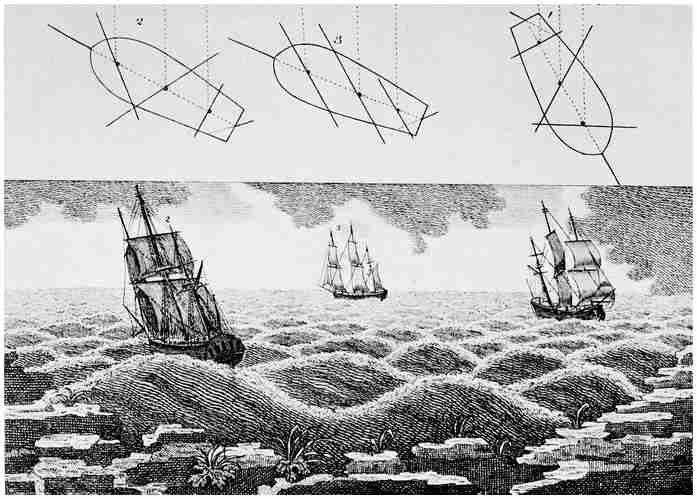
Boxhauling.
Hutchinson relates that on one occasion he saved his ship from foundering in Mount’s Bay only by boxhauling, as here indicated. Fig. 2 shows that as soon as the ship ceased coming round in stays, the foresheet was hauled aft, the headsails trimmed flat, whilst the sails were slacking, and the helm put hard alee. She then made a stern board. Thus gathering way, she turned short on her heel till she filled main and maintopsails the right way. The helm was then put hard aweather, so that the ship got headway with the sails trimmed, as in Fig. 1. Later on she was able to turn to windward, as in Fig. 3, far enough off the lee shore so as to weather the Lizard.
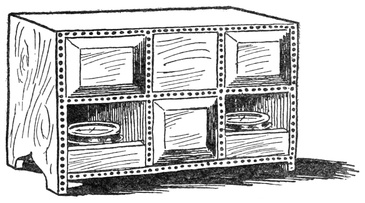
Eighteenth-Century “Bittacle.”
There was a compass on either side, and the lamp was placed in between.
Briefly, the history of this problem is as follows. Longitude is, of course, the distance which a ship makes east or west. These eighteenth-century navigators had their quadrant for finding their latitude, and they used the log-line, log-ship, reel, and half-minute glass to tell them roughly and inaccurately the distance sailed by the ship. These, by the way, were kept stowed in the “bittacle” (binnacle), which in those days was a wooden box arrangement containing a compass on each side with lights in between. There were usually two of these “bittacles” on board, viz. one for the steersman and one for the “person who superintends and directs the steerage,” says Moore, “whose office is called conning.” The accompanying illustration will indicate quite clearly the appearance of an eighteenth-century “bittacle.” Throughout history all sorts of efforts had been made to do for longitude what the quadrant and cross-staff had done for latitude. The great voyages of discovery in the early sixteenth century254 had especially given this research an impetus. In 1530 and again in 1598 a means had been sought. Philip III of Spain offered a thousand crowns to him who should discover the instrument for finding longitude. All sorts of prizes were offered by different Governments at different dates. The States of Holland held out an offer of 10,000 florins. The melancholy wreck of Sir Cloudesley Shovel on the Scillies with his squadron caused the English Parliament, in 1714, to offer £20,000 for any method which could determine the longitude. Two years later the French Government offered 100,000 livres, and so the impetus continued without avail. The whole civilised world was crying out for something which no scientist could give.
And then, in 1765, the English prize was at last won by John and William Harrison, who were able to make instruments most suitable for this purpose, and received the £20,000. This was that invaluable little article the chronometer, which means so much to the modern mammoth steamships. Dr. Maskelyne, the Astronomer Royal, had, in 1754, discovered the method of finding longitude by lunar observations on shore. After navigators at last began to employ chronometers the dawn of modern methods had already occurred. In 1767 came the first publication of the “Nautical Almanac,” Hadley’s quadrant was made known in 1731, and the sextant in 1761. Perhaps, as the sailing masters in the Navy had to provide their own nautical instruments, there was not such an incentive to accustom themselves to new methods as might otherwise have been the case.


Interior of an Eighteenth-Century Man-of-War.
Showing decks, cabins, holds, etc.
Till the time when Hadley’s quadrant was adopted, masters had always stuck to Davis’. The ship’s time was still kept by half-hour glass. The quartermaster, when the sand had run down, capsized the glass again and struck the ship’s bell—on eight occasions during the255256 watch. All the different courses sailed during a watch of four hours were marked by the quartermaster on a circular disc of hard wood. This was called a traverse board, and thereon were marked the different points of the compass. On the line of each point radiating from the centre were eight little holes, just as one sees in a cribbage-board. One at a time, pegs were placed into these holes to register the various courses sailed in every watch. And then, later on, the courses were entered on a log-book or slate, and the course and distance made good reckoned out.
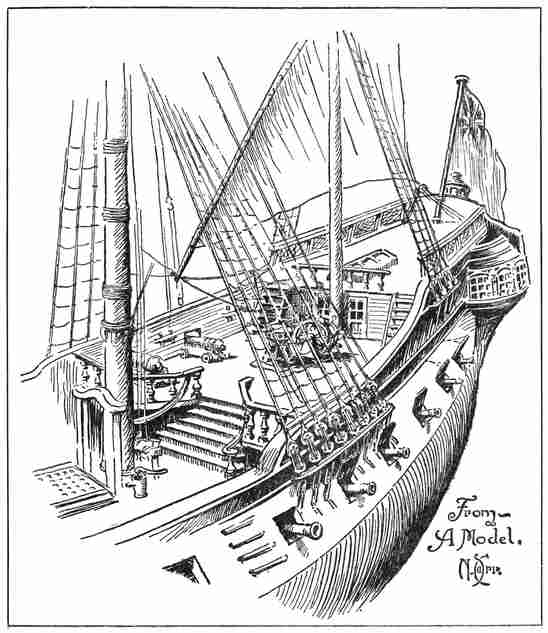
Quarter-Deck of an Eighteenth-Century Frigate.
Showing the steering wheels in use.
I have not been able to find any authority which would settle the date when wheels for steering a ship were first invented; but I am convinced that it was somewhere about the middle of the eighteenth century. Hutchinson, whose “Practical Seamanship” was published in 1777, speaks of the steering wheel in the following terms: “The great advantages experienced from steering a ship with this excellent machine has occasioned it to become more and more in use; even small ships that have their tillers upon deck frequently now steer with a wheel.” And he states that most of these wheels have eight spokes, though large ships have a ten-spoked wheel.
The Newcastle colliers, of which we were speaking just now, had anything but good charts to guide them, and their methods of coasting are certainly worth noting. About two-thirds of their voyage from Newcastle-on-Tyne to the Pool of London will be found to have consisted of navigating in the region of dangerous shoals. And yet in that eighteenth century, even though they had not a really reliable chart between them, hundreds of these little brigs used to sail backwards and forwards between the metropolis and the north with scarcely ever a shipwreck. Indeed, so few were the losses that the owners very rarely had their257 craft insured. That meant that they could afford to carry their coal, iron, timber, hemp, flax, or whatever it might be, at low freights. There was keen competition to get their goods first to market, and some very sportive passages were made. The last of these interesting old craft, so cleverly handled, so fascinating as they must have been to watch, I believe ended her days in a North Sea gale not very long since.
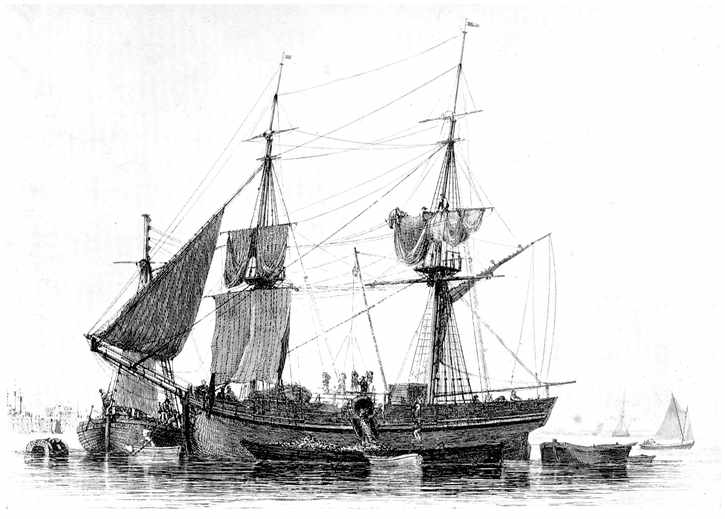
Collier Brig Discharging Her Cargo.
After E. W. Cooke.
Hutchinson’s enthusiasm for these is infectious. He has no literary power of expression, but in the plain, staccato language of a hard merchant sailor and privateer he makes one jealous of the sights which he saw with his own eyes and can never be seen again. There is not to-day—certainly as regards British waters—any such craft as a brig, unless there is one small training ship still cruising about Plymouth Sound. But in his day one sometimes saw a fleet of 300 of them all turning to windward, having every one of them come out of the Tyne on the same tide. The sight of so many fine little ships crossing and recrossing each other’s bows so quickly, and with such little room, made a distinguished Frenchman hold up his hands, and remark “that it was there France was conquered.”
In going through such shallow and narrow channels as Yarmouth Roads the fleet collected themselves for mutual safety. In the absence of good charts and efficient buoyage—it was not till 1830 that the singular distinction of producing the worst charts passed away from England—it was essential to use great caution in such strong tideways. The procedure was, therefore, as follows: The fleet being now together, each ship had a man in the chains heaving his lead. He sung out the soundings loud enough for his neighbours to hear. This happened in every ship; so that those vessels announcing shoal water would be recognised as getting too near the sands; that other bunch of craft declaring consistently258 deeper water would be in the channel, and the rest could follow their lead. In this manner the best water was always found.
Anyone who has navigated up or down the Swin Channel at the entrance to the Thames Estuary knows that the region is full of shoals, made still more dangerous by the strong tides which set athwart them. In clear weather the excellent modern buoyage makes the passage easy. But in the eighteenth century, and in thick weather, when the fleet from Newcastle came to the Swin, they hoped to have a head wind, and not to be able to lie their course. Why? Well, they smelt their way by continuous soundings, and if they were beating to windward they would find as they prolonged each tack the water began to shoal; it was then time to ’bout ship, and they stood on the other tack till the shallow water warned them once more. But if they had had a fair wind and been able to keep straight on, they ran the risk, they said, of getting piled up on the wrong side of the sand-spits in some swatch-way. Therefore the fleet adopted clever tactics. The lesser draught ships endeavoured to wait till the bigger vessels passed ahead. The former would then follow close behind, knowing that if the largest craft could float, so also could they. But when the bigger ships found the water shoaling, they, too, would let go anchor and let the smaller ships go ahead. Then the tide having flooded still more, and the small fry having been observed to be all right, up came the cables and the procession went on its way. It was just because these vessels had to experience such a great deal of anchor work that they held the record of any ships afloat for breaking out their hooks with their windlass in the shortest time. Whenever an ex-collier’s crew shipped aboard another vessel, it was found that the windlass needed half the men to do the work.
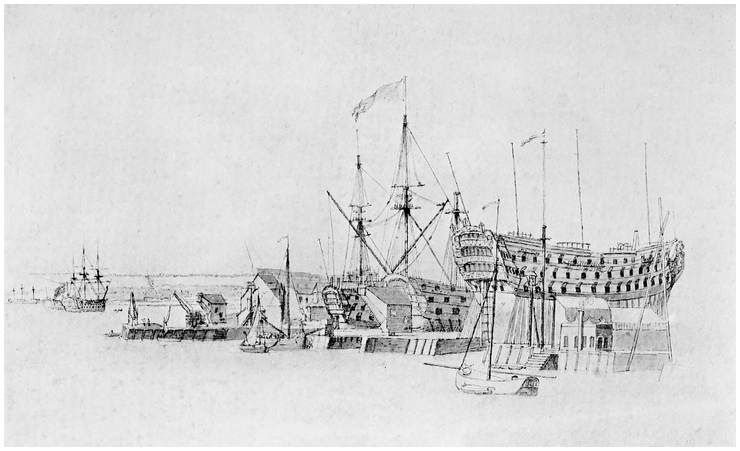
An Eighteenth-Century Man-of-War.
The illustration shows a three-decker in a shipbuilder’s yard ready for launching.
259

Those were the days of real seamanship of all kinds and sorts, so we can afford in these modern times to admire a lost art. “Nice managers of sloop-rigged vessels,” says this fine old skipper, “turning to windward in narrow channels, when they want but little to weather a point, rather than make another tack, have a practice of running up in the wind till the headway ceases, then they fill again upon the same tack; this they call making a half board.” But Hutchinson had no great faith in “weather-glasses,” and even doubts “their being of any great service to seafaring people.” However, he does admit that on one occasion he had warning of an approaching storm in the English Channel from Tampion’s portable barometer. About seventy sailing ships had got under way from the Downs with a moderate south-east breeze. In the morning the quicksilver fell from 29½ inches to 28½. He had all his small sails up, and ordered all hands to260 set to work and take in the small sails and lower the t’gallant yards. About eight in the evening the storm came on, the ship being now abreast of the Lizard, the wind having shifted to south-south-east. Suddenly it flew round to north-north-west, blew very strongly, and though he had no canvas aloft except the foresail in brails, yet it laid the ship more down on her broadside than ever he had known her. Later on they passed a ship bottom upwards, which had obviously foundered in the same squall.
Hutchinson, who himself preferred squaresails cut deep and narrow rather than shallow and broad, alleging that thus they stood better on a wind, opined that because of this superior shape the colliers and timber-carriers already mentioned sailed so well and required so few hands. And we get just a brief reference to the hardy Liverpool pilots of those days. Perhaps the reader is aware of the heavy sea which gets up among the sands at the mouth of the Mersey, and that in those waters it was and is often a most difficult undertaking to put a pilot on board an incoming ship. In such weather that it was impossible for the pilot-sloop to get alongside the incoming ship the two craft would get as near to each other as they dared, and then the bigger craft would throw a small line aboard the sloop, which the pilot would quickly hitch round his body, leap overboard, and so be pulled on board—more drowned than alive, one would have thought. Sometimes the incoming craft would veer out a rope astern which the sloop would pick up, and the same business followed as before. But even the Liverpool pilots were not so brilliant as those whose duty it was to take ships out from the Tyne across the treacherous bar, when sometimes they were compelled to let the ship lie almost on her beam ends so as to float out into the North Sea without hitting the shoals at the river’s mouth.
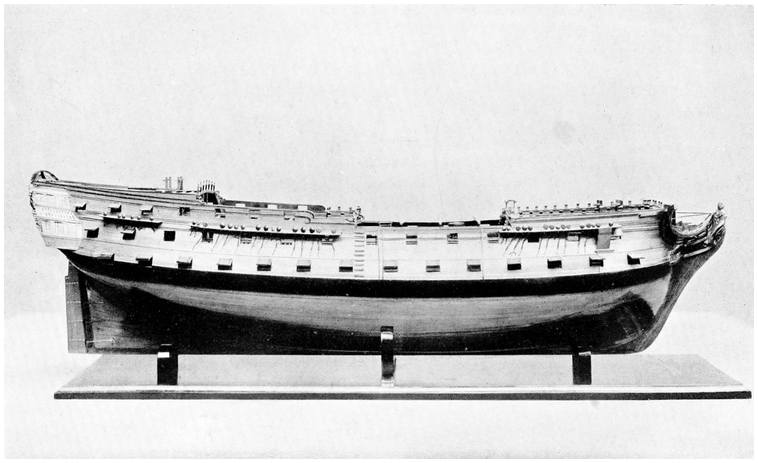
Model of H.M.S. “Triumph.”
A two-deck, 74-gun line-of-battle ship. Launched 1764, having been designed on the lines of the Invincible, captured from the French by Lord Anson in 1747.
261
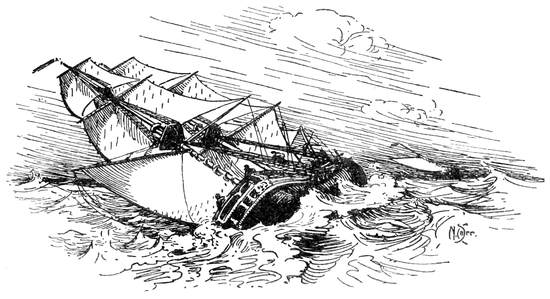
We have not much room to deal with the glorious fights of the privateers of those days. Those who are interested in the subject will find what they require in Captain Statham’s “Privateers and Privateering.” But we cannot pass on without at least a reference to these adventurous craft. Handsome enough were the prizes which sometimes they gained; but many were the times they failed for the reason that, after some years of peace, their crews were undisciplined and untrained. But about the middle of the eighteenth century improvements had been made in the metal, the casting and the boring of the cannon, which were now made not quite so heavy, and therefore of less inconvenience to a ship. Bags of horsehair were employed for protection against musket shot, whilst a rail, breast high, was affixed each side with light iron crutches and arms and netting to hold the men’s hammocks and bedding long-ways. Rope shakings and cork shakings, too, were262 also employed as a further protection from the enemy’s fire. But the powder that was served out in those scandalous days was often enough disgustingly weak and lacking in velocity.
In the golden days of the privateer, so soon as she had got out to sea all hands would be called to quarters and officers sent to their stations; there would be a general exercise of guns and small arms, everything made ready for action, and the general working of the ship thoroughly well drilled. Chasing and fighting had been brought down to the condition of a fine art, and there were recognised tactics according as to whether your opponent were as big, bigger, or smaller than yourself. If your enemy were your superior, it was better not to bring your ship right alongside, but, before the attack opened, get on his weather quarter, luff your ship into the wind with the helm alee, until your after lee gun, which you fired first, could be pointed on to the enemy’s stern. Then batter away with your lee broadside. They endeavoured also to rake the enemy fore and aft with their biggest guns as they passed, their object being, if possible, to smash the rudder head, the tiller, tiller ropes and blocks—in fact, to destroy any of the steerage tackle so that the ship might become unmanageable, and thus readily fall into the hands of the privateer.
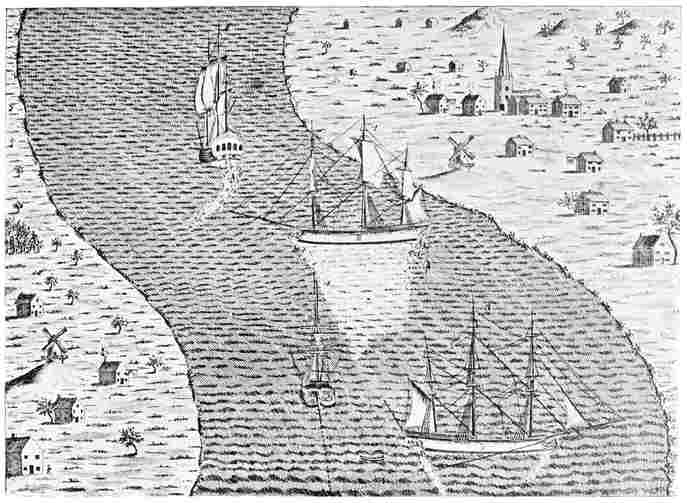
An Interesting Bit of Seamanship.
Hutchinson remarks that it often happens there is no room to turn a vessel to windward through a crowd of ships, so she has to let the tide drive her through stern first. In Fig. 1 below, the yards are braced sharp up, and she is driving astern to windward. In Fig. 2 the ship is being put on the other tack so as to clear the shore in the bend of the river. In Fig. 3, the tide having slacked, the ship has come to anchor with wind against tide.
One or two devices which have since passed away, but were in use during the eighteenth century, may be mentioned before we pass on. I wonder how many “seamen” now serving on steamships would know what “fothering” meant? It was a device that in the days of the old wooden sailing ships saved both lives and ship on more than one occasion. This was an ingenious means of stopping a leak below the vessel’s water-line when at sea and unable to beach or dry-dock. It was employed at least once during Captain263 Cook’s voyages at a critical time after the ship had struck on a rock, and the sea was pouring in so fast that the pumps were of little avail. Moore, in his “Midshipman’s Vocabulary,” published in 1805, describes the method as performed by fastening a sail at the four corners, letting it down under the ship’s bottom, and then putting a quantity of chopped rope-yarns, oakum, wool, cotton, etc., between it and the ship’s side. By repeating this operation several times the leak sucks up a portion of the loose stuff, and so the water ceases for the most part to pour into the ship. Hutchinson also mentions that once when cruising the step of their foremast carried away in a gale of wind, and made so great a leak that pumping was little good. They were far from the nearest land, and matters were critical; so they unbent the spritsail, stitched it over one side with oakum, then with ropes to the clews and ear-rings they applied it to the leak, and so effectually stopped the hole that before long the pumps had freed the ship of water.
There is nothing new, apparently, even in sea-sayings. Probably there is not an officer to-day in the Merchant Service who has never heard the maxim, “Better to break owners than orders.” Well, Hutchinson knew this phrase, and used it not for trading, but for privateering. The owners’ orders were usually “to proceed with all possible expedition to the designed station to take prizes.” And he had a very ingenious device, which, if I mistake not, was actually resurrected and tried with modifications in Southampton Water three or four years ago. Hutchinson’s idea was to scrub ships’ bottoms while at sea instead of having to bring them to dock or careen them. He had himself used this new method, which could easily be performed while at anchor or on the ocean in a calm. The device consisted of a frame of elm-boards enclosing a couple of 10-gallon264 casks with square spaces each side filled with birch-broom stuff that projected and was to come in contact with the ship’s bottom. To use this a block was lashed under the bowsprit, and another at the stern on the driver boom. A single rope was rove through these blocks just long enough to haul the scrubber, which did its work fore-and-aftwise underneath the ship.
The accompanying illustration may seem to the reader a fanciful picture, but it is nothing of the kind, and was made from a sketch done on the spot. In this will be noticed a ship with no fewer than thirty different sails. Hutchinson declares that in a light air—when he needed all the canvas he could spread—he turned to windward with all the sail drawing. As an ingenious piece of seamanship it is worthy of note, and surpasses the achievements of the clippers with their reputation for skysails and moonrakers. He speaks of the sail on the aftermost mast as the mizzen, and that curious-looking canvas right at the stern as a large driver with a light boom to make it set properly. There were two tail blocks at the outer end thereof, lashed to the rail; and in order that it might set better a bowline was attached. Below this will be observed the strange sight of a water-sail aft as well as forward. It was really a foretopmast stuns’l, and was hauled out to the end of the boom of the driver. As an example of what an ingenious skipper could do to get way on his ship in light airs, I think this illustration will be impossible to beat.
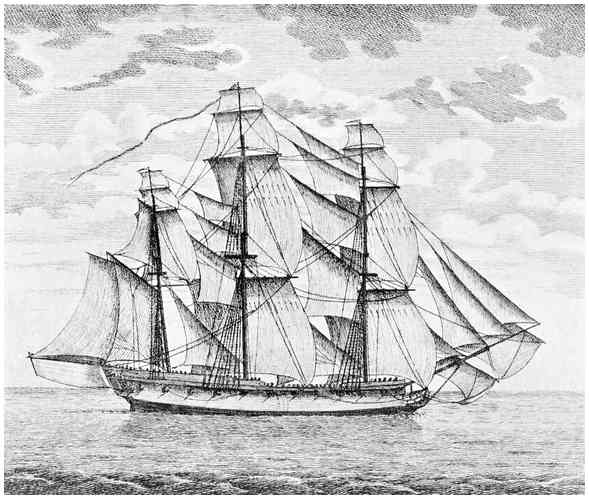
An Ingenious Sail-Spread.
Every one of these thirty sails was actually drawing. (See text.)
There is an interesting volume entitled “A Mariner of England,” which gives an account of the career of a William Richardson, who from cabin boy rose to the rank of warrant officer between the years 1780 and 1819, a record that gives one a real insight into the life of a seaman at that time. When he joined H.M.S. Minerva, in 1793, as a bluejacket, there were no slop-chests,265 but the purser at stated periods served out as many yards of dungaree as were required to each man for jackets, shirts, and trousers. Needles and thread were also served out, and then the men made the garments for themselves. He gives you, also, some idea of the mismanagement that went on; the crews made up of raw, ignorant, and stupid men, commanded by a young post-captain who only three or four years ago had been midshipman. In tacking and wearing, however, the strictest discipline was enforced. Not a word was allowed to be spoken; only the voice of the commanding officer was to be heard on those occasions, and the boatswain’s pipe was just loud enough to be heard. Swearing was checked by putting down the names of the delinquents on a list, and these men were subsequently punished with seven or eight lashes at the most. The launch was stowed on the main deck under the booms; and on certain nights a lantern was hung up on deck, and a fiddler seated on the topsail-sheet bitts, and there would be dancing for those who cared.
The reader will remember we called attention some time back to those spritsails which seem so curious to us moderns. They were also known as “water sails” and as “Jimmy Greens,” both appellations being due, obviously, to the unhappy knack they possessed of scooping up the sea. They are now long since obsolete, but they were retained for a long time for veering the ship’s head round to leeward in the event of her foremast being shot away. But they were also used even when the foremast was standing—both on a wind and off. If on a wind the yard could be topped, and the sail could also be reefed diagonally.
When Hood sent his dispatch to the Controller of the Navy announcing the victory of the British fleet at the Battle of the Saints in 1782, he made266 reference to some of Rodney’s signals, e.g. for a general chase; to steer more to starboard or port; to shorten sail; to set more canvas; and if the admiral should wish to order his ships to cease firing, “the white flag at the fore topgallant masthead, before dark, calls every ship in.” There were also night signals in use in the Royal Navy about this time. Thus, for instance, when the admiral wished to order his fleet to unmoor and ride short he hung out three lights, one above another, in the main topmast shrouds above the “constant” light in the maintop, and fired two guns, which were answered by the flagships, each private ship hanging out a light in her mizzen shrouds. So also when the signal was being given to weigh anchor, the admiral hung out some light on the maintopmast shrouds and fired a gun, which was answered by the flagships and private ships as before.
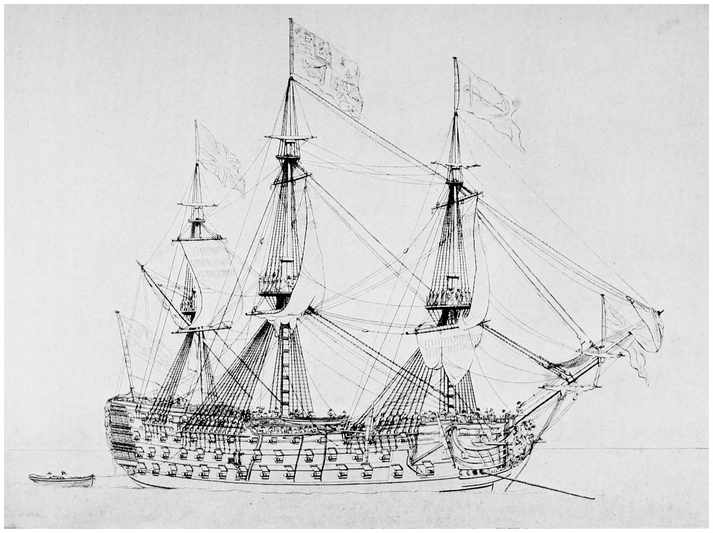
Apart altogether from the unsatisfactory kind of seamen which often made up the crews of the English Navy, matters were far from ideal among their officers. There was a spirit of decadence even here. When Benbow was sent to the Spanish Main to seize Cartagena, and fell in with the French, his own captains disobeyed orders, kept out of action, and allowed Benbow to fight the enemy practically single-handed. Similarly, when Matthews was in the Mediterranean attacking the combined Spanish-French fleets, he was basely betrayed by Lestock, who kept astern out of action. As the result of an inquiry, not only was Lestock not punished, but Matthews, who happened to sit in Parliament on the side of the Opposition, had his name struck off the Navy List. There are, unfortunately, too many instances of this kind of thing on record during this century. Some were loyal and straightforward, but none the less inefficient. The captains, wrote Admiral Keppel to Lord Hawke in August, 1778, “are indeed fine officers,267 and the ships are fine. Some of them, indeed, want more experience in discipline to do all that can be expected from them, but a complete fleet cannot be formed in a day. Our greatest want is petty officers, and that deficiency is general.” And then, you will remember, all the discontent among the seamen culminated in the year 1797, when a series of mutinies broke out. The first was at Spithead, when Lord Bridport was about to take his fleet to sea. He had made the signal to unmoor, when suddenly every ship’s company gave three cheers and refused to go until their pay was increased. They made one exception, however; if the French fleet were out then they would put to sea to fight them, otherwise they declined to go. Lieutenant Philip Beaver, who was serving on the Monarch, writing to his sister two days after this event, admits that with one exception all the crews behaved “with great prudence, decency, and moderation ... and obey their officers as before in the regular routine of ship’s duty—saying that they are not dissatisfied with their officers or the service, but are determined to have an increase of pay, because it has not been increased since the time of Charles the First, and that everything since that period has risen 50 per cent, that no attention had been paid to their petitions.” Eventually the statements of the men were found to be well substantiated, and they were pardoned. But there was another mutiny on May 7; six days later another broke out at the Nore, and in the same month among the men of Admiral Duncan’s fleet off the Texel, and even in Jervis’ fleet off Cadiz.
In no respect is the canker of the eighteenth century better shown than in the condition of tactics displayed by the admirals of this time. During the Anglo-Dutch wars, many a valuable and wholesome lesson had been learned by the English Navy, but the Battle of Malaga268 in 1704 showed that instead of tactical progress being made, the age had become—to quote an apt expression of Admiral Mahan—“the epoch of mere seamanship.” As soon as inspiration deserts art, we all know how valueless becomes mere technique. It was much the same with eighteenth-century tactics. There was not a breath of inspiration; it was a period of formality, of stiff insincerity both ashore and afloat. The curse of our policy in fighting naval battles was the fetish of the cast-iron tactics which no officer dared to modify. It was not till Hawke came swooping down that these lifeless, formal affairs began to improve. Till his time there was far greater respect for the letter than the spirit of tactics, so that a naval battle between the English and her enemy was just this: the English fleet came along in line-ahead, and then each ship laid herself alongside the corresponding ship of the enemy’s line, with the result that there was a series of duels.
Hawke’s idea was not that, but to concentrate his whole force against a part of the enemy’s fleet, and this idea was carried out by Rodney, when he defeated the French at the Battle of the Saints in 1782. It is true that the signal book then in use in the Royal Navy, plus the inefficient state of the service generally, caused Rodney’s signal to be misunderstood. But it turned out better than it might have done. In medieval times, the great idea was to lay your ship aboard the other ship and fight her to a finish. Then, the reader will remember, came the Cromwellian period, which altered all this. But instead of continuing this progress, the eighteenth century actually reverted to the medieval method, and this was the practice against which Hawke and Rodney set their faces determinedly.

The “Invincible” and “Glorioso.”
Showing the highly decorated sterns and poop-lanterns of the eighteenth century.
In the matter of tactics, as in shipbuilding, the French were decidedly our superiors. And our officers—or, at any rate, those who were keen and zealous for269 the service—recognised this. “I believe you will, with me, think it something surprising,” wrote Captain Kempenfelt to the Comptroller of the Navy, “that we, who have been so long a famous maritime power, should not yet have established any regular rules for the orderly and expeditious performance of the several evolutions necessary to be made in a fleet. The French have long since set us the example.... Oh, but ’tis said by several, our men are better seamen than the French. But the management of a private ship and a fleet are as different from each other as the exercising of a firelock and the conducting of an army.... The men who are best disciplined, of whatever country they are, will always fight the best.... In fine, if you will neither give an internal discipline for your ships, nor a system of tactics for the evolutions of your fleet, I don’t know from what you are to expect success.... We should, therefore, immediately and in earnest set about a reform; endeavours should be used to find out proper persons, and encouragement offered for such to write on naval tactics, as also to translate what the French have published on that subject. They should also enter into the plan of education at our marine academies.” The date of this letter was January 18, 1780, and in saying what he did Captain Kempenfelt was placing his finger on the real point of the matter.
It was two years after this that John Clerk published his “Essay on Naval Tactics.” British officers of this period had a supreme contempt for book learning, just as the simpler sort of seaman has to-day. But it was not till Clerk published the above book that officers began to change their mind. Up till now works on tactics had been French. Clerk’s was the first volume on this subject in the English tongue. It is not too much to assert that this completely revolutionised British naval tactics, and that to its teaching270 were largely due the victories of Rodney, Howe, Duncan, and St. Vincent. And the interesting fact was that it was written not by an officer, but by a layman; not by a seaman, but by a Scotch laird. Those who are attracted by the subject of tactics will find much in this book that is instructive, even though steam and steel ships and our present-day weapons never entered into Clerk’s contemplation. And the numerous plans criticising actual contemporary sea fights will be found most helpful to a complete understanding of the nautical events of this period.
One of the most memorable battles in the whole of our naval history was that which is known as the “Glorious First of June,” 1794. The tactics which Howe employed on this occasion are interesting, because, although he formed his fleet in line-abreast, and was able to disable the enemy’s rear, forcing their van and centre to break away to support their rear, yet there was such a ship-to-ship mode of attack that it may seem to have been a reversion to the olden days of medievalism. But the reason for this was that Howe was well aware that, crew for crew, the English were superior to the French. The result proved that his belief was well grounded, for at this time the crisis in the British Navy had just passed, the improvement in tactics had taken place, and the decadent ebb had already run its course.

Model of an English Frigate, 1750.
She carried 24 nine-pound guns, and had a crew of 160. She was of 511 tons, and measured 113 feet on the gun-deck.
The kind of fighting instructions which had been issued by Russel in 1691 and continued till after the Battle of the Saints in 1782, was superseded very shortly after the latter date. It was Lord Howe who made this change, so that the basis of the new tactical code was no longer the Fighting Instructions, but the Signal Book. Instead of the signals being secondary to the instructions, the position was now exactly reversed. In 1790 these fighting instructions took a271 second form, in the shape of a new code of signals, and upon this tactical system were based all the great actions of the Nelson period. The code continued until the year 1816, when an entirely new signal book appeared, which was based on Sir Home Popham’s code, the latter having been in use for a number of years for “telegraphing.” It was Popham’s code that was used for making Nelson’s famous signal at Trafalgar.
Howe’s tactics at the Glorious First of June were illustrative of the ideas which were then rooted in the minds of British admirals. By sailing in line-abreast instead of adhering rigidly to the eternal line-ahead, Howe showed that he was conscious of the modern progress in tactics. But there his appreciation ended. For, as you peruse the events of this battle, you find that the rest of the contest became confused and haphazard, the British admirals throwing over the lessons of Clerk and employing just their own ideas and initiative. The credit of the Battle of St. Vincent belongs to the daring of Nelson in taking upon himself a heavy responsibility when he saw that Jervis had made a tactical mistake. We have no room to deal with this here; but I wish to remind the reader that the line-head formation was that adopted by Jervis. Just before the battle, when he perceived how the Spaniards were disposed in two divisions, he resolved to pass between them in single line-ahead, separate them thoroughly, and then concentrate on the one division which was much larger than the other. Thus, clearly, he belonged to the same school of tacticians as Rodney and Howe.
It was in the middle of the reign of George II that a regular uniform was first adopted for the officers of the English Navy. Hitherto they had worn the same kind of clothes which their contemporaries wore in the272 streets ashore. Every man dressed in the manner he preferred. But in the year 1747 the question of a uniform colour and pattern was being discussed when the King himself settled the point. It happened on this wise. A certain admiral had been sent to the Admiralty on an entirely different matter by the Duke of Bedford, who was then First Lord. He was ushered into an apartment surrounded by various dresses, and was asked to state which of these he considered the most appropriate; to which the admiral answered that he thought blue or red, or red and blue, since these were our national colours. “No,” replied the Duke, “the King has determined otherwise; for having seen my Duchess riding in the Park a few days ago, in a habit of blue, faced with white, the dress took the fancy of His Majesty, who has appointed it for the uniform of the Royal Navy.”52 Since that time, as the reader is aware, these two colours, blue and white, have remained the colours of our Navy, although the cut of the clothes has altered from time to time.
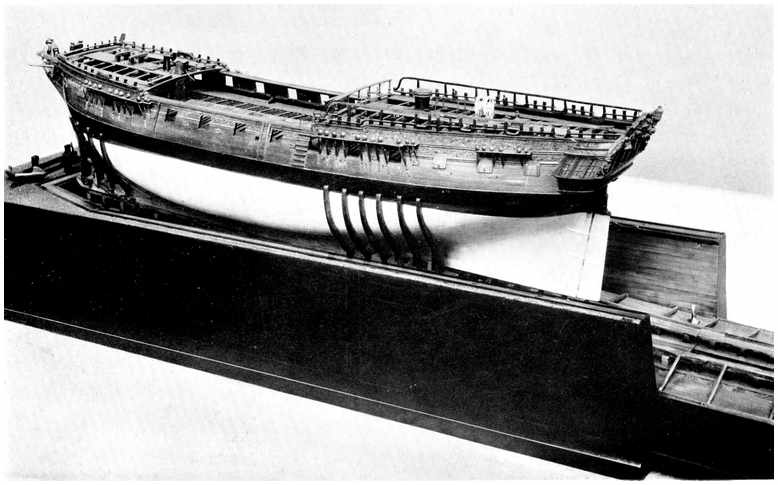
A 32-Gun Frigate Ready for Launching.
This shows H.M.S. Cleopatra (built in 1779) in her cradle, ready to go down the ways. She measured 126·4 feet on gun-deck, 35·2 feet wide, depth 12·1 feet, and was of 689 tons.
We alluded just now to the introduction of wheels on board sailing ships, and endeavoured to fix the date as approximately the middle of this century. The following account of the Great Storm on November 27, 1703 (in which no fewer than thirteen men-o’-war were lost, many more seriously damaged, and the Eddystone lighthouse destroyed), shows that tillers, as in Elizabethan days, were still used, and the wheel not yet invented. The following is the autograph report by Admiral Sir Cloudesley Shovel, commanding a squadron of eight ships in the Downs. The fact that the ships drifted all the way from the Downs to the Galloper (in the North Sea) gives some indication of the fury of that autumn hurricane. This dispatch is among the MSS. preserved in the British Museum:—
273
“On Saturday last soone in the morning wee had a most miserable Storme of Wind, which drove us to some Streights, for after wee had veerrd out more than three Cables of our best bower that Anchor broke, soon after our Tillar broke, and before we could secure our Rudder it broke from our Sterne, and has shaken our Stern Post that we prove very leakey, and had our four Chaine Pumps and a hand Pump goeing to keep us free. We lett go our Sheete Anchor, and veered out all the Cables to it, butt that did not ride us, butt wee drove near a sand called the Galloper, of which we saw the breach; I directed the Maine Mast to be cutt by the Board, after which we ridd fast. Of eight Ships that came out of the Downes four are missing, the Association, Russell, Revenge, and Dorsettshire; pray God they drove cleare of the sand....
“P.S. I doubt it has farr’d worse with the four Ships that have drove away than it has done with us: I have some hopes that some of them have drove to Sea; but if so they are without Anchors or Cables and may be without Masts: I judge it will be of Service if some Friggt were sent out to looke for them.”
And yet there was at least one ship which had the wheel invention in the year 1747. In Hawke’s dispatch to the Secretary to the Admiralty, recording the action off Rochelle, in August, 1747, after relating that he kept his wind as close as possible so as to help the Eagle and Edinburgh, which had lost her foretopmast, he relates that “this attempt of ours was frustrated by the Eagle’s falling twice on board us, having had her wheel shot to pieces.” We may, therefore, fix the date of the first steering wheel as not earlier than 1703, and not later than 1747.
274
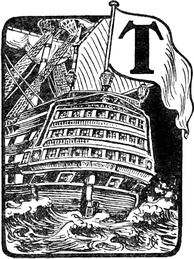
The first sixty or seventy years of the nineteenth century saw the art of the seaman at its highest state of perfection. There was never anything to equal it either before or since in the achievements rendered by the sailors who manned the famous “wooden walls” of Nelson’s time, who took the stately East Indiaman backwards and forwards with so much ceremony and safety, or hurried along the tea clipper at a continuous rate which has never since been surpassed by any fleet of sail-propelled ships.
At the beginning of the nineteenth century there were royal dockyards at Chatham, Portsmouth, Plymouth, Deptford, Woolwich, and Sheerness; and here His Majesty’s ships were generally moored in the piping times of peace. The first three of these yards were governed by a resident commissioner, who superintended all the musters of the officers, artificers, and labourers employed in the dockyard. He controlled the payments, examined the accounts, contracts, etc., and generally regulated the dockyard. Large ships, such as those mighty wooden walls which could carry a hundred guns, were usually built in dry dock, with275 strong flood gates to prevent the tide from coming in. When the time came for launching, and it was spring tides, the gates were opened and the ship floated out. But small craft, such as frigates and corvettes, were built on the slips, and then launched by means of a cradle which sped down the ways, the latter having been previously greased with soap or tallow.
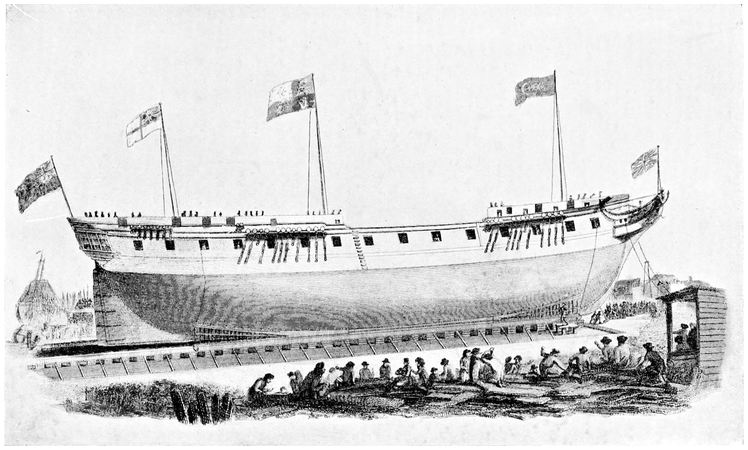
The oak of which these craft were built usually came from the Forest of Dean, Gloucestershire, and the New Forest, Hants. But as ships were built out in the open, the weather got into the wood and rotted it, so that sometimes a ship was condemned before she was ever put in commission; and, in any case, the life of some wooden walls was under ten years. Others lasted for a long period, as, for instance, Nelson’s Victory, which was built in the year 1765. The method of building was curiously medieval, and almost Viking-like in its simplicity. The timbers were secured by treenails to the planking. They were preferred to spike-nails or bolts, as the latter were liable to rust with the sea water and get loose. The thickness of the treenail was proportioned to the length of the ship, one inch being allowed to every hundred feet. In the Royal Navy and in the East India Service ships were always sheathed with copper to protect the hull against worms. The copper was quite thin, brown paper being inserted between the sheathing and the oak. Other ships than these two classes had thin deal boards nailed over the outside of the bottom for the same purpose.
After the new ship had been floated out of her dock she was taken alongside a sheer-hulk. The latter was an old man-o’-war, which had been dismantled and refitted with one very high mast, strengthened with shrouds and stays to secure the sheers which served as the arm of a crane for hoisting ships’ masts in or out,276 and getting the yards on to the new vessel. Her sails were bent, her guns and ammunition taken aboard, and away she went for her first commission. Not one of these “wooden walls” carried any canvas above royals. They could not travel fast through the water even on a wind, for they were bulky, clumsy, and cumbrous. Their lines were not sweet, they had a huge, heavy body to drive through the water; they were slow in stays, and they were not easy to handle. They rolled so badly, that in heavy weather they sometimes rolled their masts out.
With a hundred guns aboard and most of a thousand men, a three-decker was certainly an interesting sight. Her guns were arranged in rows along her decks. The lower gun-deck was little above the water-line. A 100-gun ship in Nelson’s time cost over £67,000, and these three decks ran from stem to stern, besides a forecastle and a quarter-deck, the former of which extended aft from the stem to the belfry, where the ship’s bell was suspended under a shelter. The quarter-deck extended from aft to the mainmast. There was also a poop-deck, and another deck below the lower gun-deck, called the orlop, where the cables were coiled and the sails stowed. The gun-room was on the after end of the lower gun-deck, and partly used by the gunner; but in frigates and smaller vessels, where it was below, it was used by the lieutenants as a mess-room. The ward-room was over the gun-room, where the superior officers messed and slept.
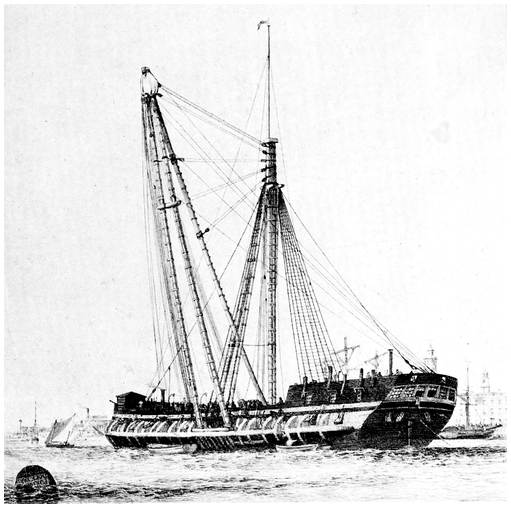
Sheer-Hulk.
After the etching by E. W. Cooke.
In action the guns were run out, by means of side tackles, till their muzzles were well outside the port, so that the flash of the gun might not set the ship’s side on fire. These ports were fitted with heavy square lids. In bad weather it was impossible to open the lower-deck ports lest the sea should swamp the ship. There was a kind of shutter also, called a half-port,277 with a circular hole in the centre large enough to go over the muzzle of the gun, and furnished with a piece of canvas nailed round its edge to tie on the gun and prevent the water entering the port, although the gun remained run out. These were used chiefly on the main deck. Ropes were made fast to the outside of the lids attached to a tackle within, by which the port-lids could be drawn up.
There was but little light ’tween decks in these ships even by day, and the glimmer of a purser’s dip was the only illumination. The magazines, however, were lighted through what was termed a “light-room.” The latter was a small apartment with double-glass windows towards the magazine. No candle could, of course, be taken into the latter, so the gunner and his assistants filled their cartridges with powder by the candles shining through the windows. In the bigger men-o’-war there were two light-rooms; one attached to the after magazine, and the other which gave light to the fore or great magazine. The after magazine contained just enough supply of cartridges for the after guns during action, but the great magazine had enough powder for the ship for a long period.
The cables were usually of 120 fathoms and made of hemp, bass, or Indian grass, though the biggest ships used hemp exclusively for their heavy anchors. The change from hemp to chain cables came in 1812, and these were much appreciated as saving a great deal of valuable space below. For the hemp cables when coiled down in a frigate’s cable-tier filled nearly a quarter of her hold, and when it is remembered that a 1000-ton ship had a cable measuring over 8 inches in diameter, and that a 2⅛-inch chain was just as strong—the breaking strain exceeded 65 tons—but took up less space, we can well understand that hemp was not altogether an advantage, notwithstanding that in bad278 weather these heavy, bluff ships would ride far easier to the rope than the chain. The largest anchor used weighed five tons. It had a wooden stock and broad palms.
Because these hemp cables were so thick there must needs be very large hawse-pipes. Now these ships not only rolled; they pitched in a sea-way, and consequently they took in a great deal of water through these pipes. In order to prevent the water getting adrift all over the ship, there was a large compartment fitted up just abaft the hawse-pipes and called the manger. This stretched athwart the deck, separated on the after part by the manger-board, which was a strong bulkhead, the water being allowed to return to the sea through scuppers. Leather pipes were nailed round the outside of the lower-deck scuppers, which, by hanging down, prevented the water from entering when the ship heeled under a press of canvas.
The cables led in through the hawse-pipes below deck to the bitts. To bitt the cable was to put it round the bitts, which were frames of strong timbers fixed perpendicularly into the ship. The “bitter end” was that part of the cable which was abaft the bitts, and not allowed to run out. Hence the common expression “to the bitter end” has no reference to the other meaning of the word spelt in a similar way. These cables were in lengths of 40 fathoms, and then spliced to make the 120 fathoms. Naturally a heavy ship such as a 100-gun first-rate carried a great deal of way. When, therefore, the anchor was let go, the friction of the cable passing through the hawse-pipe was something enormous, and the hemp became so hot that the tar on its surface often took fire, therefore men were always stationed to stand by with buckets of water. Likewise, the bitts and timbers round the heated hawse-pipes had to be attended to. Another drawback279 to a rope cable was that it chafed a great deal. In coral-bottomed waters it was customary to arm with chains that part which was likely to be worn; and the cable was also sometimes buoyed with casks lashed at intervals, so as to float safely above the rough bottom of the sea-bed.
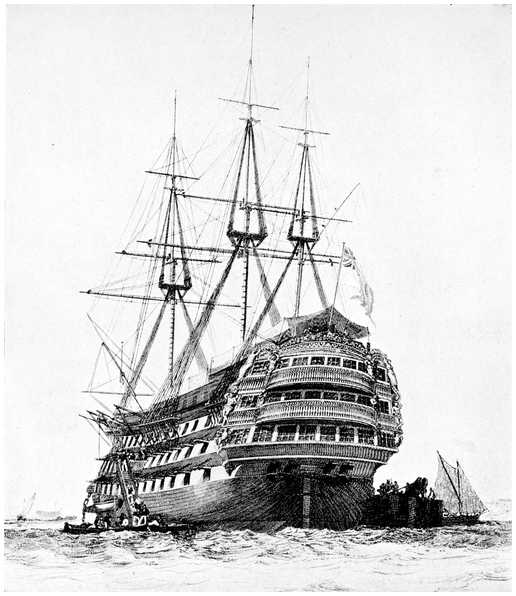
H.M.S. “Prince.”
A first-rate of 110 guns, showing the stern balconies as built before the close sterns were introduced.
There is an interesting passage in a letter written by Captain Duff of H.M.S. Mars, in 1805, to his wife, in which the following words occur: “October 10th. I am sorry the rain has begun to-night, as it will spoil my fine work, having been employed for this week past to paint the ship à la Nelson, which most of the fleet are doing.” That, of course, was just a few days before Trafalgar. And there is a phrase in a letter written by a young midshipman to his father, in 1794, telling him all about the Glorious First of June battle. “The French ... called us the little devil, and the little black ribband, as we have a black streak painted on our side.” The explanation of these two passages is as follows. Up to the beginning of the nineteenth century it was left to a captain’s own taste to paint his ship whatever colours he liked. There was no uniformity as to-day, but generally a ship was painted with a wide black streak along the water-line just above the copper sheathing. This streak ran right round the ship, and in depth reached to the lower gun-deck. Above this the hull was painted a brownish yellow, but sometimes it was more a lemon-colour. The after upper works above the gun-decks and the outer sides of the poop above the quarter-deck guns were painted a vivid red or blue.
This bright band of colour gradually faded until, by the time Trafalgar was fought, it became a dull, deep blue—almost black. Round the forecastle ran a band of scarlet or pale blue edged with gold, and continued down the beak to the figurehead. The outsides of the280 port-lids were a brownish yellow like the sides, and the stern walks were decorated with elaborate gilt carvings, cherubs and dolphins and mermaids, the royal arms, and wreaths, etc. Round the stern of each ship, outside the glazed windows of the cabin, ran a quarter gallery for the captain, while at the bows a figurehead was seen which was regarded with a sentimental interest and kept in good condition. But Nelson had his ships painted black, with a yellow streak along each tier of ports, and the port-lids were painted black. This chequer painting, then, was the method “à la Nelson” to which Captain Duff was referring.
Internally the sides of the ships were still painted a blood-red, for the reason already given in an earlier century. So also were the inner sides of the port-lids. But after Trafalgar the interiors were sometimes painted in other colours, such as green or yellow or even brown, until, after the year 1840, white became uniform. Many internal fittings such as the gun-carriages, and even the guns themselves, were painted red or chocolate during the Nelson period. The lower masts were painted a dull yellow, the topmasts and upper spars varnished a dark brown, and the lower yards and gaffs painted black. The blocks, the chains, the dead-eyes, the wooden and iron fittings for the rigging were all tarred black, just as one often finds them to-day on some old coaster or fishing smack. The masts of the British warships were painted white usually before any engagement with the French, so as to distinguish them from the Gallic masts, which were black.
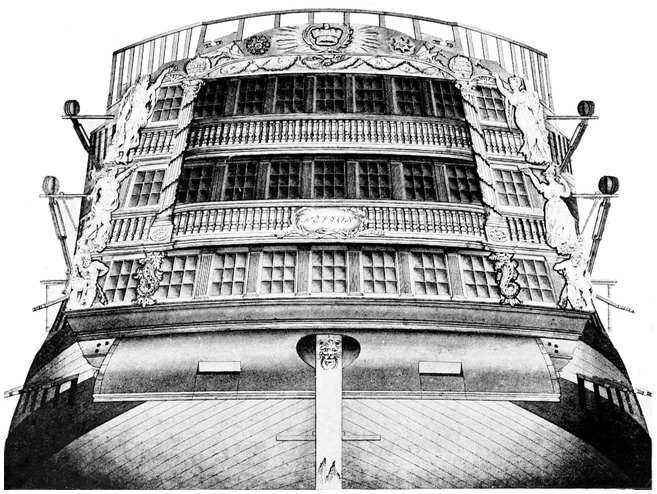
It was the superiority of the British gunnery which won most of our battles against the French, even when the latter had better ships and faster. The British directed their fire chiefly against the hull, whereas the French aimed at the rigging. The cartridges were filled281282 in the magazines and handed up to the fighting decks above by the powder-monkeys. Along the decks were arranged, at intervals, match-tubs to receive the slow-matches used in firing the guns, whilst in the cockpit of the ship the surgeon and his mates were busy attending to the wounded. The ’tween decks were very cramped, and there was not much air, and there was still a good deal of disease rampant among the seamen. The surgeon’s mate messed in a space only six feet square in the cockpit, “screened off with canvas, and shut in by chests, dark as a dungeon, and smelling intolerably of putrefied cheese and rancid butter.”
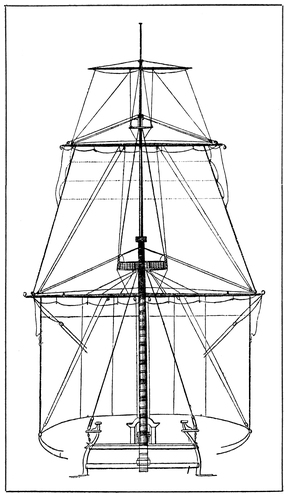
After the end of the eighteenth century, the salutary practice of building ships under cover became general. Nowadays, of course, most ships are constructed in the open air. But in the time we are speaking of the ship—men built with wood and not steel. And when the weather was not allowed to get inside and rot the wood, it was found that the vessels lasted much longer than before. Furthermore, the method of uniting two pieces of timber together by “scarfing” was introduced. It was done either by letting the end of one piece of wood into the end of the other, or by laying the two ends together and fastening a third piece to them both. Thus, curved timbers could be made with pieces of straight timber. This may seem quite a small matter to some, but when it is stated that until this device was employed ships ready for launching were sometimes detained on the stocks for a considerable period until natural bent timbers could be found, it will be seen that Sir Robert Seppings, the inventor, was performing an excellent service to the Admiralty.
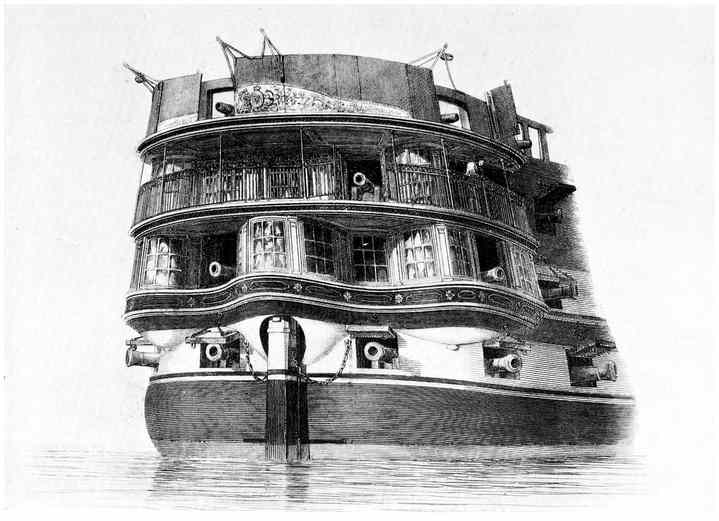
The Circular-Shaped Stern of H.M.S. “Asia.”
This 84-gun ship was in the engagement at the Battle of Navarino.
And there were other improvements which were only justified. That effusive gilt decoration—the scrolls, the allegorical figures, the wreaths (which had come in during Caroline times), the heavy brackets for283 the poop-lanterns were all to come under the chastening hand of simplicity. The stern galleries became simpler in character and fewer in number, the spritmast disappeared and the spritsail, though the spritsail yard remained for some time. In the Merchant Service the “Jimmy Green” continued till well into the nineteenth century; and the yard of the lateen mizzen had long since been lopped off to become a gaff, as also the triangular mizzen sail had become quadrilateral and a boom had been added. Masts were made taller, but the bowsprit was no longer a quasi-mast, as it had been since medieval days. Staysails had come into use from Dutch origin, and royals—or, as Hutchinson called them, “topgallant royals”—and studding-sails were already well established during the latter part of the eighteenth century. The triangular headsails were relied upon for getting the ship’s head round, and consequently the foremast was no longer placed so far forward as it had been in Tudor and Stuart times.
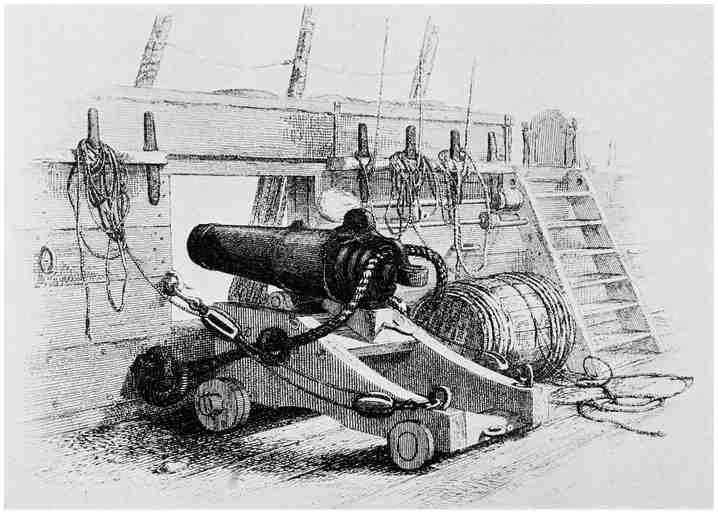
During the reign of George III, a three-decker carried either 32- or 42-pounders on her lower gun-deck, 24-pounders on her middle deck, and either 12- or 6-pounders on her upper deck. On the forecastle and quarter-deck 6-pounders were fired. It was the 32-pounders which began to be recognised as the largest satisfactory gun for the first-rates, and so continued till about 1840. In place of the old Elizabethan powder-horn and linstock, gun-locks and firing-tubes were introduced, and the system of ventilating ships, introduced during the eighteenth century by Dr. Hales, made for the improved health of both ships and crews.
Many of those who emigrated from these shores to the United States of America can still remember the sailing ships which carried them through gales with safety. That was the time when the ship’s deck was like a veritable farmyard. There were no condensed284 foods, no patent refrigerating arrangements, no water-condensers; so the ship’s long-boat, stowed securely on deck, became filled with pens of sheep and pigs, while cackling ducks and quacking geese reminded the agricultural emigrants of the homes they had just left. There was a cow-house on deck, and on some ships there was even a small kitchen-garden in boxes filled with earth, which reposed in the jolly-boat. In those smaller ships carrying no passengers, the pigs and poultry had practically the whole run of the ship. Milk was obtained from the goats and cows, but occasionally, when the wild Atlantic made a clean sweep of the deck, this article of food was impossible till the next port was reached.
The eighteenth-century transatlantic ships used to make only two trips a year, taking four months for the round voyage and back. The quickest trip was the homeward one to England, for there was a favourable westerly wind to run before. But even with a head wind, these old packets made good their 40 knots a day. And so matters went on till the volume of trade and the number of emigrants had so much increased as to create a demand for the bigger ships of about 800 tons that came in 1840.
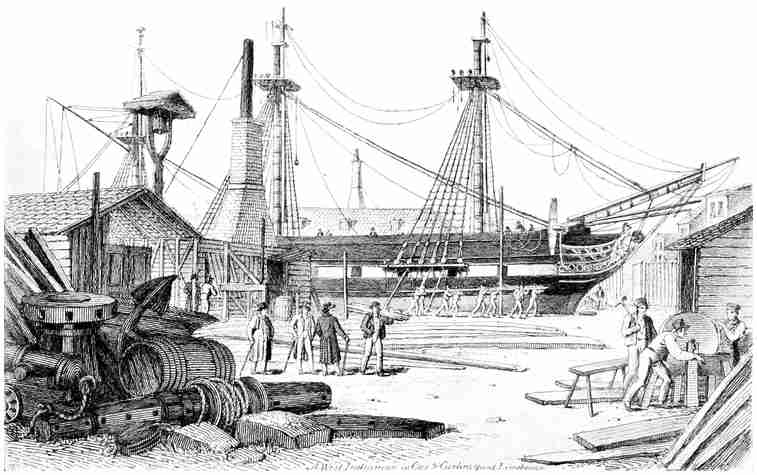
I hope on another occasion to tell at greater length the story of that fine class of ship known as the East Indiaman, which has long since disappeared from the sea. I have but little space left here to deal with a species of ship that was scarcely inferior to many of those in His Majesty’s service. Although nominally merchantmen, yet they so much enjoyed the patronage of the Government, that to be officer in the East India Company’s service was almost the equivalent of a commission in the Royal Navy. So well paid were the East India captains and their staff, and so many handsome emoluments besides were there attached to their285 posts, that you are not altogether surprised to find, as you look down the names of these officers, men of title and the younger sons of some of the best English families.
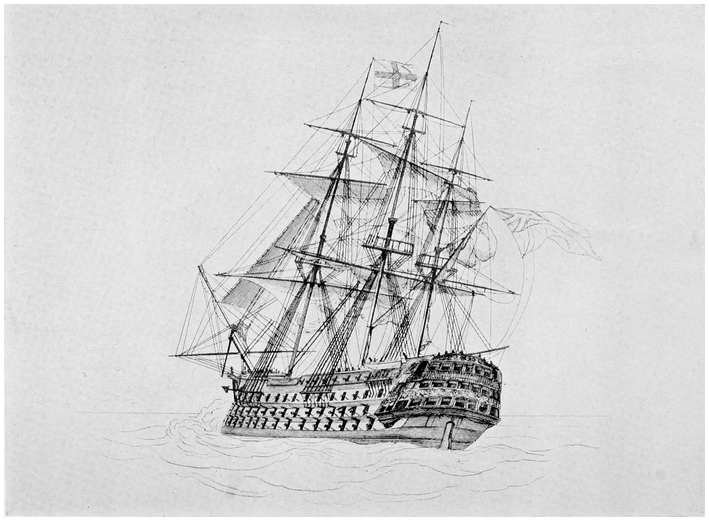
Promotion was made by seniority, and a captain was assigned to his ship even before she was launched, so that he had an opportunity of knowing every timber and every plank in her hull. He superintended her fitting out, and when she was at last complete with her spars and sails, her complement of passengers, her cargo and her crew, she put to sea, but she was in no tremendous hurry to get to the Orient. Her voyaging was to be safe and sure, like her captain’s remuneration. For he was allowed by the directors 56½ tons of space for carrying cargo on his own account, the rates of freights then varying from £35 to £40 a ton. Captains did their own chartering, and in one way and another accumulated very large perquisites. A conservative estimate places the income of some of these skippers as from £6000 to £10,000 a year; and the mates and petty officers managed to feather their own nests very amply as well.
The discipline of these ships was founded on the prevailing custom in the Royal Navy. They flew the Navy’s long pendant. They were built like some of the Admiralty frigates, they were fitted out on similar lines, and they were handled in like manner. But they were slightly fuller-bodied than the Admiralty ships in order to carry plenty of cargo. The accommodation for passengers was, considering the times, luxurious. At the end of each homeward voyage these ships were entirely dismantled and given a complete refit, the passengers selling their state-room furniture by auction on board before going ashore. The directors looked well after the men as well as holding out encouragement to the officers. Seamen of eight years’ service286 were permitted pensions. The crews were divided into two watches, the officers having three watches—four hours on and eight hours off. The men messed in batches of eight, their allotted space being between the guns in the ’tween decks. Here also were their mess-utensils and their sea-chests, and here were slung their hammocks. Every Sunday morning after the crew had been inspected they were, by the regulations of the Company, to attend Divine service, the captain acting as chaplain. If a commander’s log-book was found to have omitted this duty he was liable to a fine of two guineas. He wore a uniform consisting of a blue coat having black velvet lapels with cuffs and collar. There was plenty of gold embroidery and gilt buttons with the Company’s device thereon. The breeches were buff, he wore a black stock or neckcloth, and a cocked hat and side-arms completed the picture.
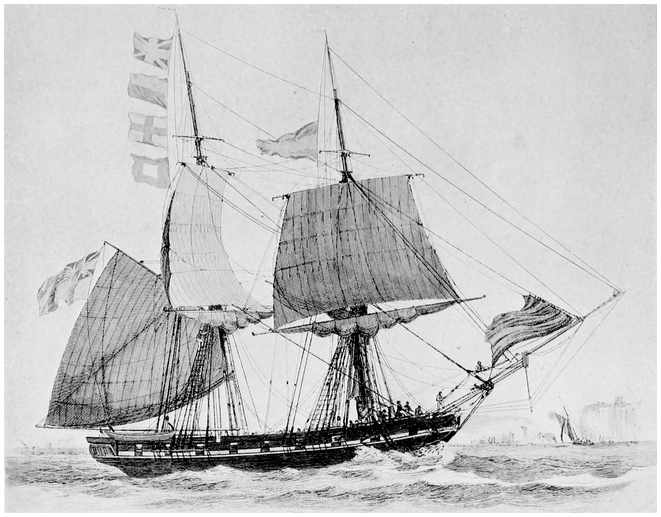
The Brig “Wolf,”
Formerly in the Royal Navy, hove-to off Dover waiting for the pilot to come out.
So also the crews were constantly drilled at their guns and trained to handle cutlass, musket, and boarding pike. There were two men to every job, there was plenty of food, and there was no cause for grumbling at overwork. There was plenty of rum, there were good quarters and good prospects. And yet for all that there were reckless fellows who could not realise their good fortune. When they had offended they were brought before the ship’s court-martial in true naval fashion and sentenced to the cat-o’-nine-tails. And no man could complain that the commander was “driving” his ship; for every evening, no matter how fine the weather looked, the royals and all light sails such as studding-sails were stowed, and the royal yards sent down on deck. No risks were run unnecessarily, and if the weather looked at all threatening the t’gallant sails and mainsail were stowed and a single reef tucked into the topsails. The aim was to combine safety with comfort, and so they snugged down every287 night, and by day whenever there was the least temptation. But the East India was a fine service and a splendid school for British seamanship, a calling that has so considerably died out during the last forty years. In the year 1832 the valuable monopoly which the East India Company had enjoyed for so long a time was put an end to. Commerce was thrown open, competition288 entirely altered the previous conditions, and at last this fine fleet was sold and disbanded.
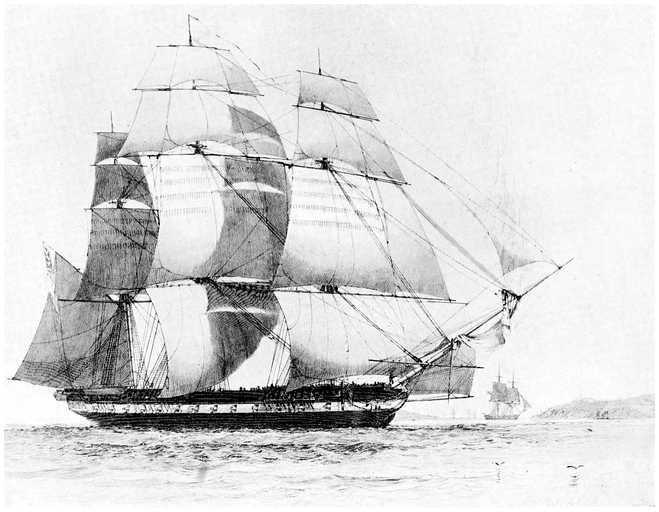
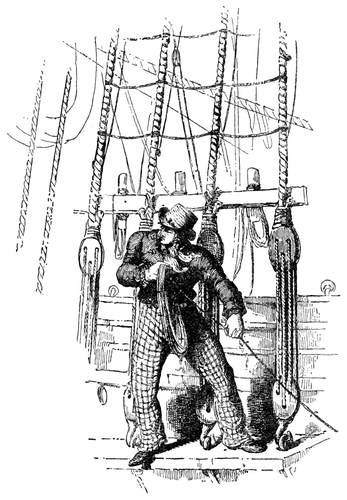
Man in the Chains Heaving the Lead on an Old Wooden Sailing Ship.
(From a contemporary lithograph.)
But it was the period of the clipper which simultaneously brought seamanship to unheard-of attainment, and chanted its swan-song. The period is covered roughly by the years 1840 to 1870. It was introduced owing to a demand for the more rapid delivery of goods, especially tea, which does not improve by remaining in a ship’s hold. It was given a strong impetus by the discovery of gold in California, and the eager rush of prospectors to reach that part quickly. The rush to Australia in like manner was a still further impetus to the development of the clipper ship at the middle of the nineteenth century. The China tea trade in the ’fifties and ’sixties caused these ships to be improved and developed and handled to the utmost limits, until the opening of the Suez Canal in 1869 gave it its death-blow. For a time it lingered, yet the collateral encouragement of the steamship made it impossible for the sailing ship to pay her way across the ocean. But there never have been such smart ocean passages so continuously maintained as by the China clippers of the ’sixties. There never were better sailing ships built of wood, and there never were captains who “cracked on” or crews who could work such big canvas-propelled craft with such distinction. This was the period when a ship was not content with t’gallants and royals, but must needs set sky sails and moonrakers.
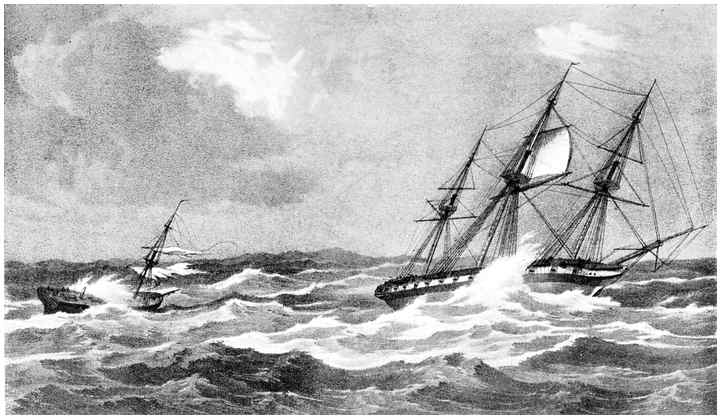
H.M.S. “Cleopatra” Endeavouring to Save the Crew of the Brig “Fisher,” 200 Tons, on October 26, 1835.
This incident occurred 82 miles N. ¼ W. off Flamborough Head in a strong S. W. gale with heavy squalls. The brig had lost her mainmast, and hailed the Cleopatra for assistance. A boat was therefore lowered on the Cleopatra’s lee quarter, but stove in and lost. A buoy was veered astern, but the brig could not pick it up. During the night the brig foundered with all hands. Liardet in his book on seamanship suggested that in such an incident as this the best thing would be to get to windward of the wreck, let down ropes from the lee side, then signal to the wreck your intention of drifting down to her. The men could then rescue themselves by the ropes.
A very fine type of clipper was built in 1859 by Messrs. Robert Steel and Son, at Greenock, to which class belonged such famous ships as the Falcon and Fiery Cross. They were beautifully designed craft and splendidly built, with ample deck space for working the ship and small deck-houses, and were kept up almost as smartly as a modern sailing yacht with polished brass-work, holystoned decks, and well-found gear. The289 clipper Seaforth, which was built in 1863, brought about quite a revolution in the sailing ship’s equipment, for she was the first sailing vessel to have steel spars and wire rigging. Her lower masts, her topmasts, and her topsail yards and bowsprit were all steel likewise.
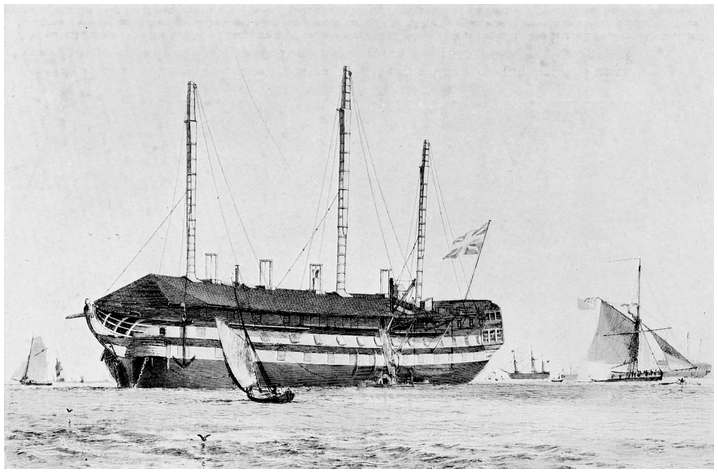
H.M.S. “Hastings,” 74 Guns.
Lying “in Ordinary” in the Medway.
In one respect these old tea clippers were curiously medieval, though the practice continued also in the ships of the Royal Navy till well on into the nineteenth century. This was in the matter of loose ballast. These tea clippers carried about 300 tons of shingle ballast laid evenly along the bottom of the ship, and upon this shingle were laid the chests of tea, and considerable dunnage was put in as well. These ships had a registered tonnage of about 700 tons, and could carry about 1000 tons of tea. They were worked by a crew of about thirty; they were captained by skippers of the utmost ability and prudence, who, unlike the East Indiaman captains, did not worry about snugging down at nightfall, but first and foremost were bent on getting the cargo to the London river in the least possible time. They “cracked on” and undertook risks in gales of wind which would have terrified many another commander. But it was to their interests to make smart passages. Some of them were part-owners, and there was a premium of ten shillings a ton to the skipper who landed the first cargo of a season’s tea. Thus, in addition to his other emoluments, there was a chance of making an extra £500 after a quick voyage. Many of the crews had served their time in sailing ships of the Royal Navy, so a captain could rely on getting the best out of his fine ship. Some of these skippers retired with large fortunes; but the premium system led to a great deal of jealousy and unpleasantness. For it might happen—it did, in fact, occur—that one ship might make the fastest sailing passage to Dungeness and yet get her package of tea ashore some time after the290 second vessel, simply because the latter had been fortunate in picking up a more powerful tug to tow her from Dungeness to London. So, eventually, this premium method had to be abandoned.
When we remember that such vessels as the Taeping and other clippers have been known to maintain for long periods an average of 13 knots an hour, we may well regret that the coming of the steamship was not delayed a century later, to give these ships a complete epoch of their own. Perhaps in the course of events time will wreak its revenge, and give us back once more a period of true seamanship and a recurrence of the most interesting ways of a ship.
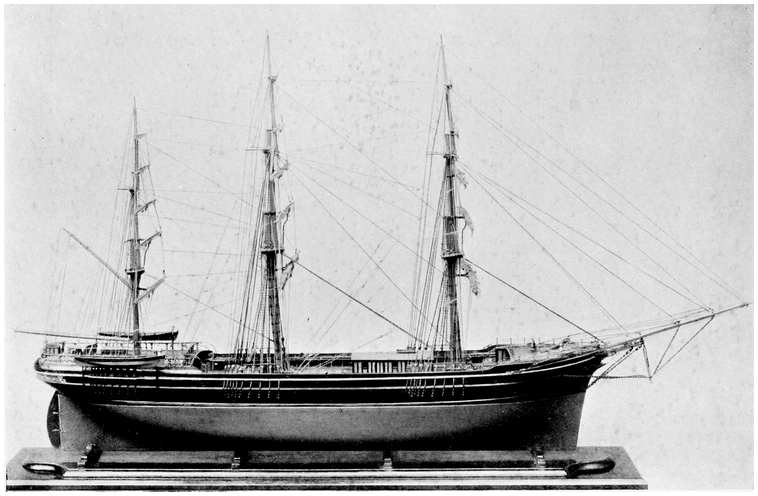
Model of Full-Rigged Ship “Carmarthenshire.”
Built of wood, with iron beams, in the year 1865. The double topsail yards and stuns’l booms are discernible. She was of 812 tons register; length, 174·6 ft.; beam, 32·7 ft.; depth, 20·5 ft.
291
| Bittacle (Binnacle). | See pp. 214 and 253. |
| Bitts. | Posts on a deck to which cables, etc., could be fastened. |
| Bolt-ropes. | Ropes round the edge of a sail to prevent tearing. |
| Bonnets. | See p. 158. |
| Boxhauling. | See p. 252. |
| Brails. | Small ropes used for the purpose of shortening a ship’s canvas. |
| Careen. | To lay a ship over on to her side for the purpose of cleaning, caulking, etc. |
| Catheads. | Short projecting beams serving as a bracket to suspend the anchor clear of the bows. |
| Drabler. | Canvas laced on the bonnet of a sail to give it more drop. |
| Driver. | A large squaresail set occasionally upon the mizzen-yard or gaff. |
| Dunnage. | Loose wood or other material packed in the hold with the cargo to prevent it from shifting. |
| Fothering. | See p. 262. |
| Gaff. | A spar used for extending the upper edge of a fore-and-aft rectangular sail. |
| Gripe, to. | To come up into the wind in spite of the helm. |
| Gripe of a ship. | 1. The sharpness of her stern under the water. 2. A projection added to the keel. |
| Gripes. | Lashings securing a boat in its place. |
| Ground-tackle. | Ropes and tackle used in connection with anchors and mooring apparatus generally. |
| Hawse-pipes. | The metal linings to the hawse-holes or holes in a ship’s bows through which the cable passes. |
| Hog, to. | To scrub a ship with flat scrubbing brooms called hogs.292 |
| Manger. | A small apartment made in the ship’s bows to catch the water flowing through the hawse-holes. |
| Mizzen. | The aftermost mast of a vessel with two or more masts. Sometimes called a jigger. In medieval four-masters the aftermost mast was called the bonaventure mizzen, and the one immediately forward of this the main mizzen. |
| Moonrakers. | Sails above the sky-sails. |
| Parral. | A band for keeping the end of a yard to the mast. |
| Pinch, to. | To sail close-hauled. |
| Quant, to. | To propel a craft along shallow water-ways by means of a long pole. |
| Rhumb-line. | The line (cutting all the meridians at the same angle) which is followed by a ship sailing on one course. |
| Scarfing. | See p. 282. |
| Scuppers. | Gutters or channels along the outer edge of a deck by which water runs off. |
| Snatch-blocks. | Iron-bound blocks with an opening in which the bight of a rope may be laid without threading the end of the rope through. |
| Stringer. | A strip of timber running round a ship internally in line with the deck. |
| Swatch-way. | A narrow sound or channel of water among sand-banks. |
| Tabernacle. | The socket or hinged post for a mast that can be lowered at will to pass under bridges, etc. |
| Trestle-trees. | See p. 207. |
| Tumble-home. | The incline inwards of a ship’s sides above the level of its extreme breadth. |
| Ware. | To veer. |
293
WILLIAM BRENDON AND SON, LTD.
PRINTERS, PLYMOUTH
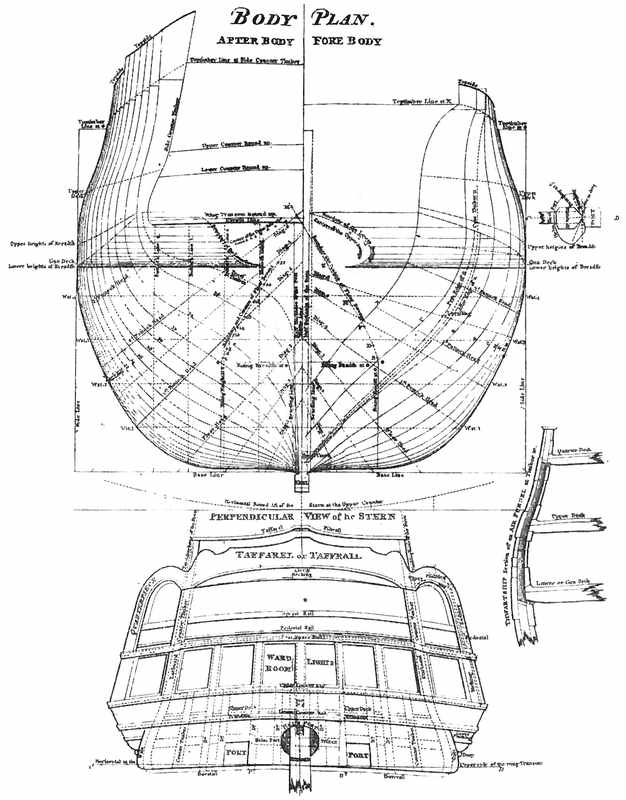
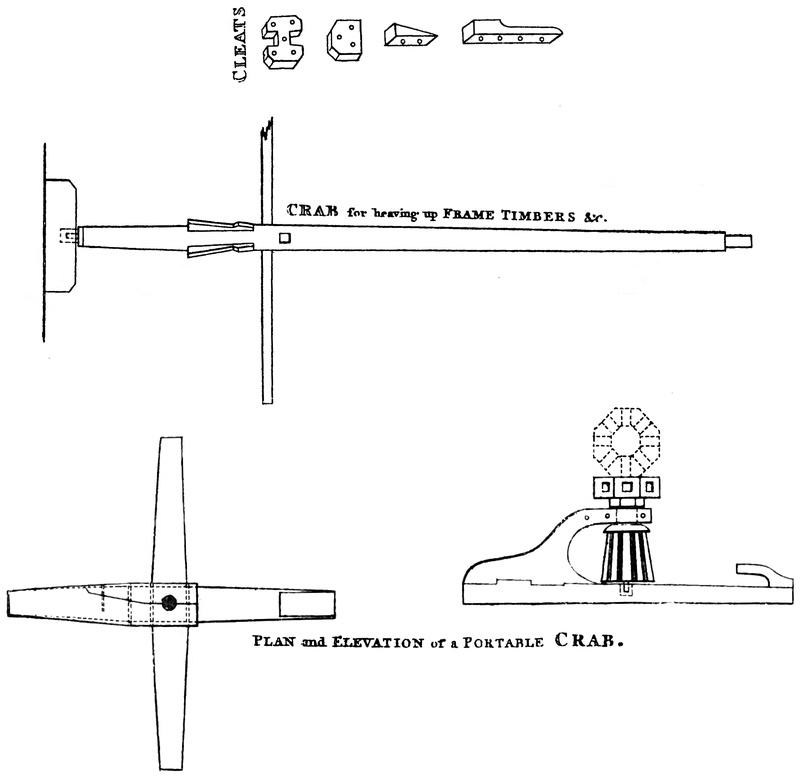
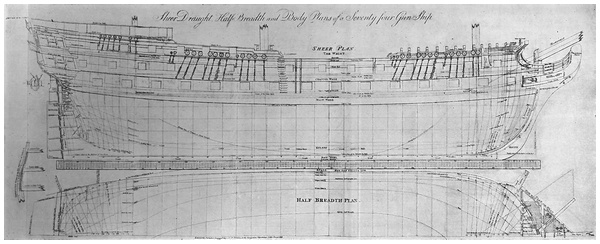
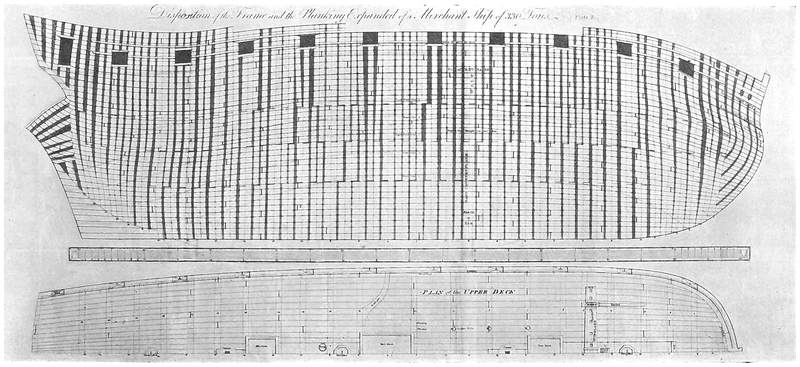
IV. A 330-Ton Merchant Ship of the Early Nineteenth Century.
Upper illustration shows method of framing. Lower illustration gives plan of upper deck, indicating positions of windlass, masts, hatches, capstan, pump, etc. (See Chapter X.)


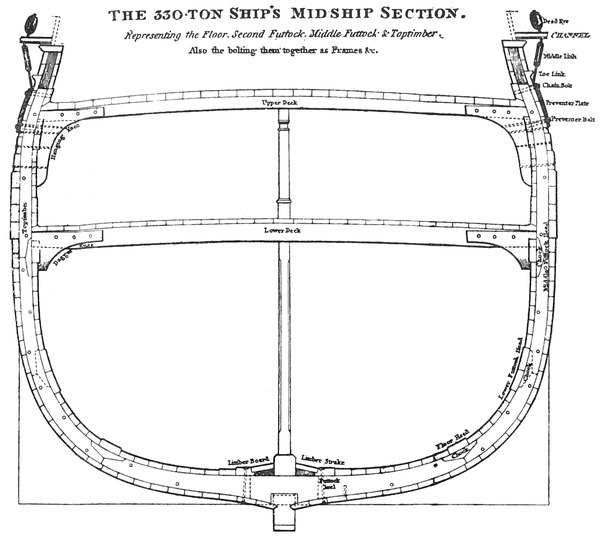
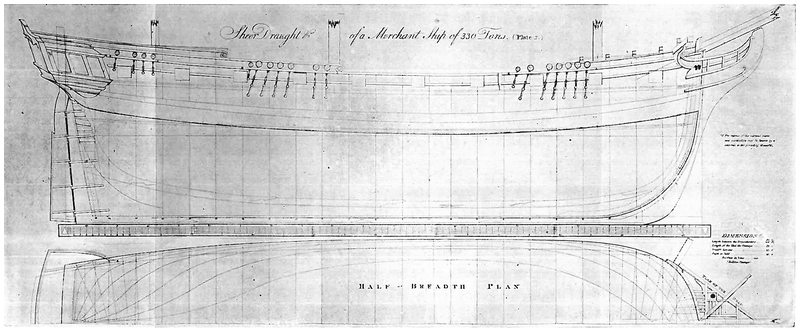
VIII. Longitudinal Plan of an Early Nineteenth-Century 330-Ton Merchantman.
Length between perpendiculars, 108 ft. 3¼ in. Extreme breadth, 27 ft. 6 in. Depth, 12 ft. Length on keel, 82 ft.
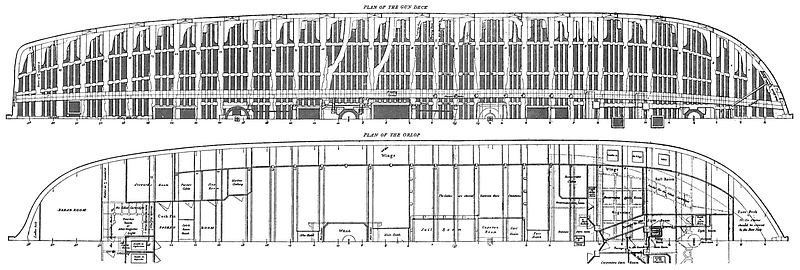

X. Iron Clipper Sailing Ship “Lord of the Isles.”
Length between perpendiculars, 185 ft. Extreme breadth, 29 ft. 1000 tons displacement.

XI. The Wooden Clipper Ship “Schomberg.”
Length between perpendiculars, 262 ft. 6 in. Extreme breadth, 45 ft. 2600 tons burthen.
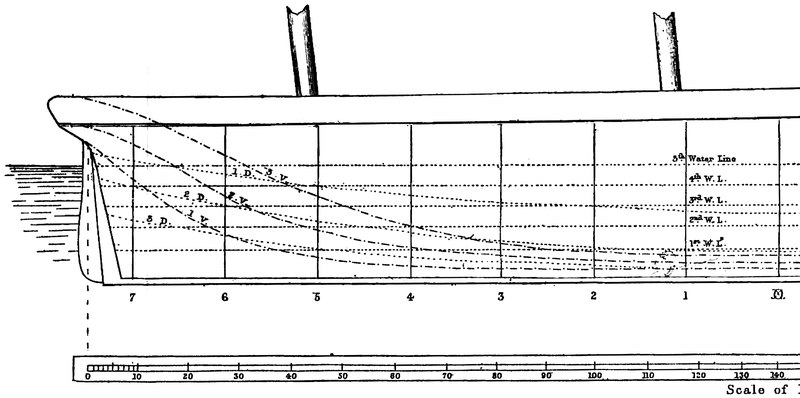
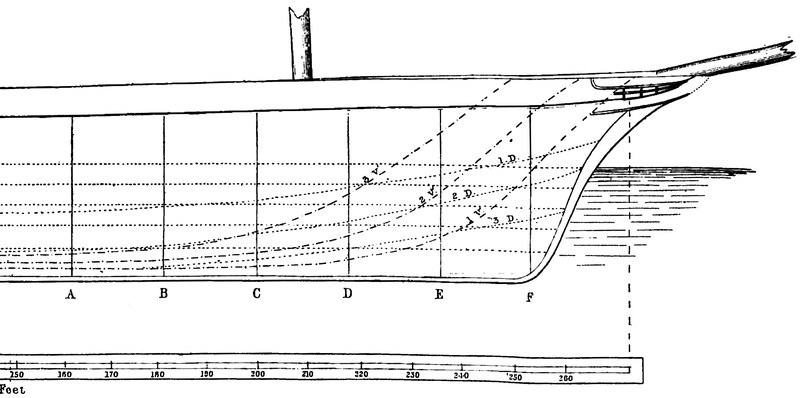
1 “Phœnicia,” by George Rawlinson. London, 1889.
2 I have availed myself of Mr. H. G. Dakyns’ excellent translation of “The Works of Xenophon,” Vol. III, Part I. London, 1897.
3 Given in “Select Epigrams from the Greek Anthology,” by J. W. Mackail. London, 1911.
4 Ibid.
5 Ibid.
6 “A Dictionary of Classical Antiquities.” London, 1902.
7 See Fig. 24 of “Sailing Ships and their Story.”
8 Given on page 212 of Mackail, ut supra.
9 Taken from Plate LII in “Peintures Antiques de Vases Grecs de la Collection de Sir John Coghill, Bart.,” par James Millingen. Rome, 1817.
10 “Journal of Hellenic Studies,” Vol. XII, p. 203.
11 “Journal of Hellenic Studies,” Vol. XI, p. 193.
12 “Rhodes in Ancient Times,” by Cecil Torr. Cambridge, 1885.
13 “Six Dialogues of Lucian,” translated into English by S. T. Irwin. London, 1894.
14 “The Remains of Ancient Rome,” by J. H. Middleton. London, 1892.
15 “Cæsar’s Conquest of Gaul,” by T. Rice Holmes. Oxford, 1911.
16 “Sailing Ships and their Story.”
17 See article in “The Yachting Monthly,” Vol. XII, p. 81, “The Shipwrights of Rome.”
18 “Northern Mists: Arctic Exploration in Early Times,” by Fridtjof Nansen, 2 vols. London, 1911.
19 That is to say they were still existing about A.D. 1180.
20 That is to say 148 feet: grass-lying means straight.
21 See “The Saga Library,” edited by William Morris and Eirikr Magnusson. London, 1905. I am indebted to this edition for the extracts which I here make from the Sagas, and also for some valuable matter given in the notes to that edition.
22 “The Story of the British Navy.” London, 1911.
23 Grieves.
24 Haste.
25 Arrange.
26 “You’re standing too close beside your mate so that he cannot haul.”
27 Shout.
28 Go aloft.
29 Taylia = “tally aft the sheet”—“haul aft,” etc.
30 Stow.
31 “No nearer”—“don’t come any nearer to the wind.”
32 “Thou failest”—“you’re slacking.”
33 “Wartake” may mean “war-tackle,” but what exactly that signifies no one to-day has been able to suggest.
34 i.e. lay the cloth.
35 “Pery” means “squall.”
36 “Thow canst no whery” = “you mustn’t complain”—“you know nothing about these matters.”
37 Malmsey.
38 Boiled nor roast.
39 “My head will be cleft in three”—“my head is splitting.”
40 “Gere” means “tools.” Lightly constructed cabins were knocked together on these Viking-like ships by the ship’s carpenter to accommodate passengers.
41 Lie.
42 Evidently some of the passengers had to sleep in the hold, whence the stench of the bilge-water and the accumulation of filth made their life very trying.
43 “Dawn of Navigation,” in “Proceedings of the United States Naval Institute,” Vol. XXXII. Annapolis, 1906.
44 Far from having been expressly built for exploration, the Santa Maria had been constructed for the well-known trading voyages to Flanders. The Pinta and Nina had been built for the Mediterranean trade.
45 Sir Clements Markham states that the bonnet was usually cut one-third the size of the mizzen, or one-quarter of the mainsail, being secured to the leach by eyelet holes.
46 The italics are mine.
47 i.e. “lie at hull”—the Elizabethan word for “heave to.”
48 i.e. lie to a drift-sail or sea-anchor.
49 i.e. an azimuth compass.
50 This is thought to have been some instrument showing how the line of the course cuts the several meridians, those meridians being drawn upon their proper inclination.
51 The derivation of the word Flame-borough or Flamborough at once suggests a burning beacon.
52 “Greenwich Royal Hospital,” by Edward Fraser.
Punctuation, hyphenation, and spelling were made consistent when a predominant preference was found in the original book; otherwise they were not changed.
Simple typographical errors were corrected; unbalanced quotation marks were remedied when the change was obvious, and otherwise left unbalanced.
Illustrations in this eBook have been positioned between paragraphs and outside quotations. In versions of this eBook that support hyperlinks, the page references in the List of Illustrations lead to the corresponding illustrations.
The first illustration in each chapter was used as the first letter of the first word (an "illustrated drop-cap") in the original book, but are shown separately in the eReader versions of this eBook. The HTML version of this eBook shows them as they appeared in the original printed book.
In some of the original illustrations, details, particularly words, were unreadable, and the image quality of a few originals was significantly worse than the others.
The HTML version of this eBook can display larger versions of some of the “Plan” diagrams found at the end of the book, but, when this eBook was prepared, the .mobi and .epub versions did not support those larger sizes.
The index was not checked for proper alphabetization or correct page references.
Text uses both “lodestone” and “loadstone”, “a side” and “aside”.